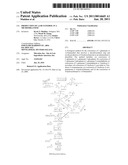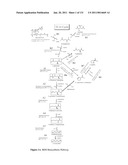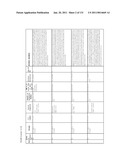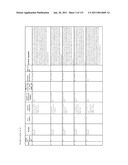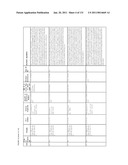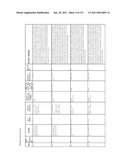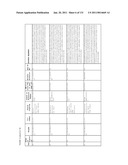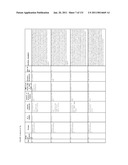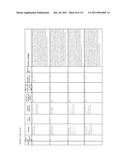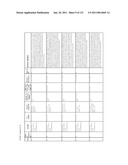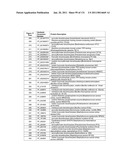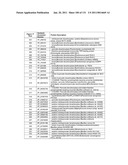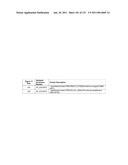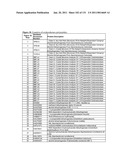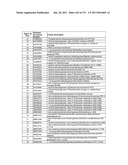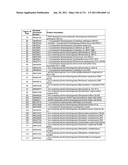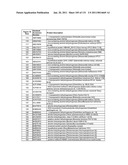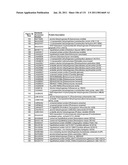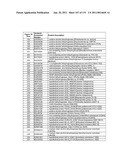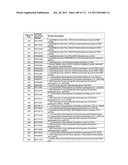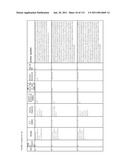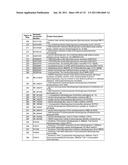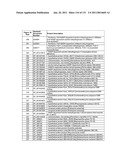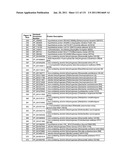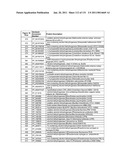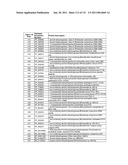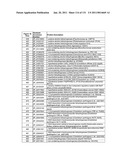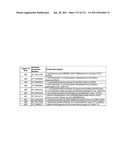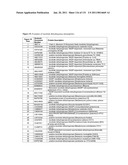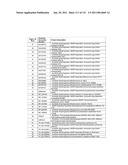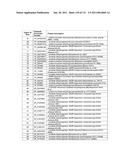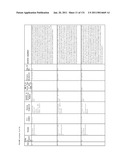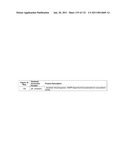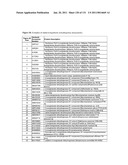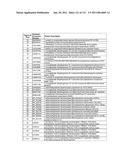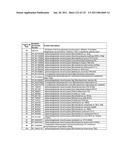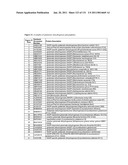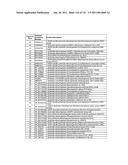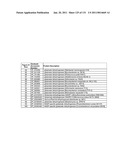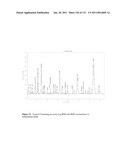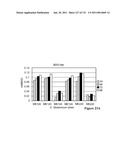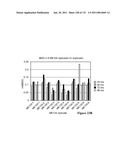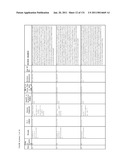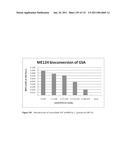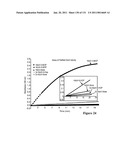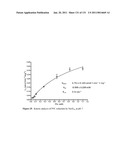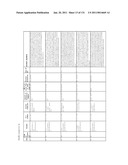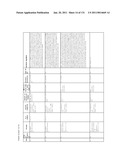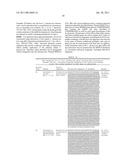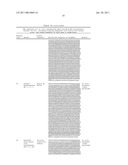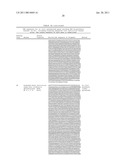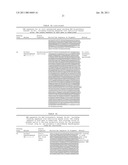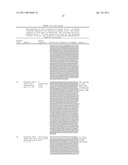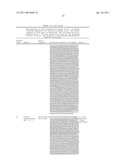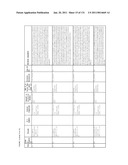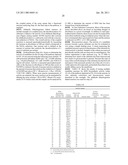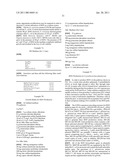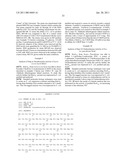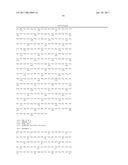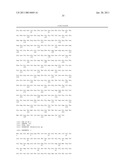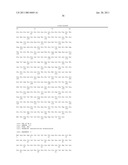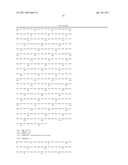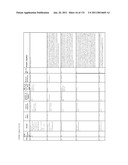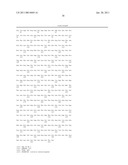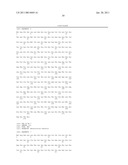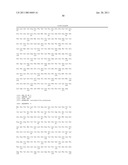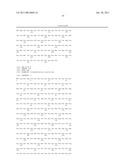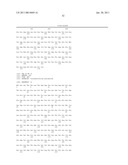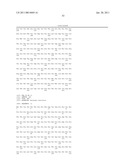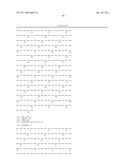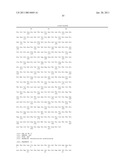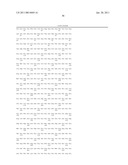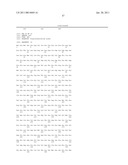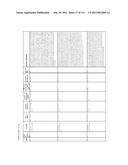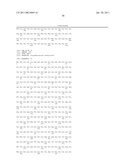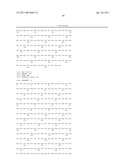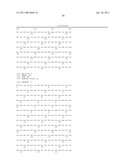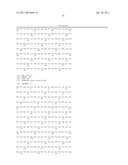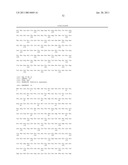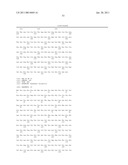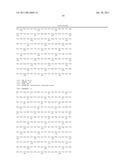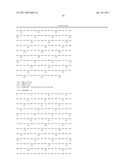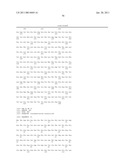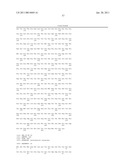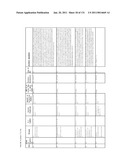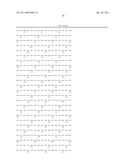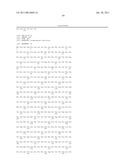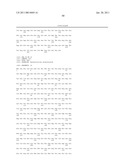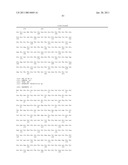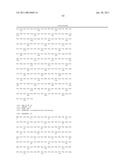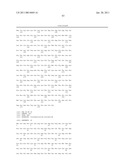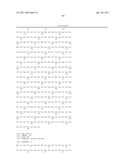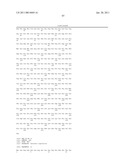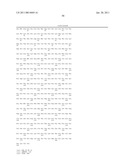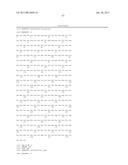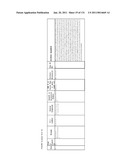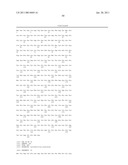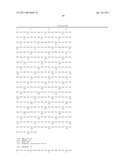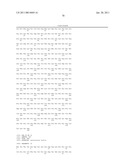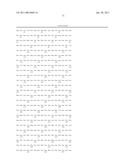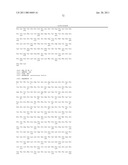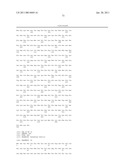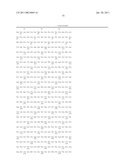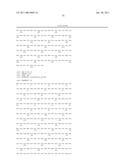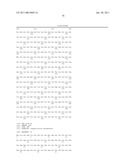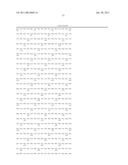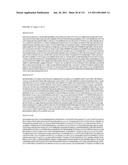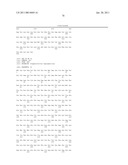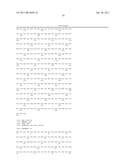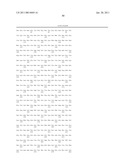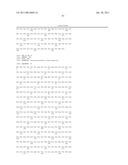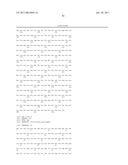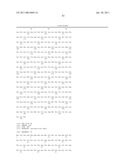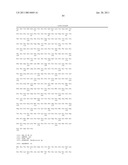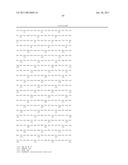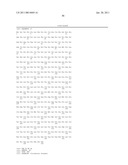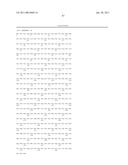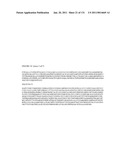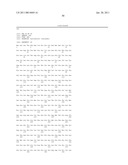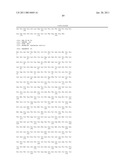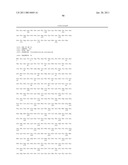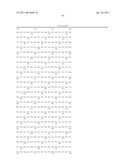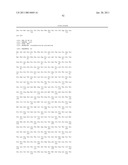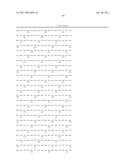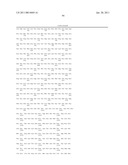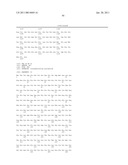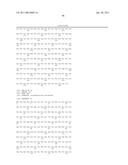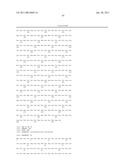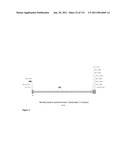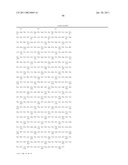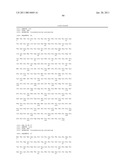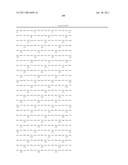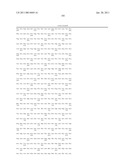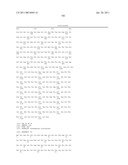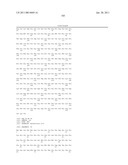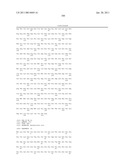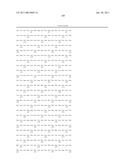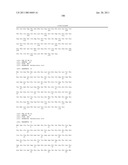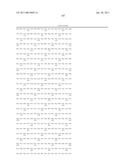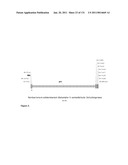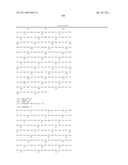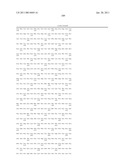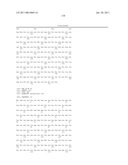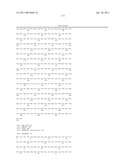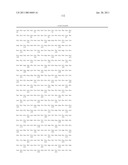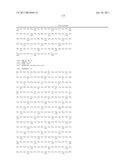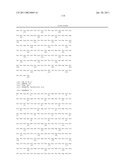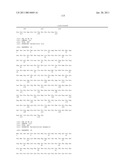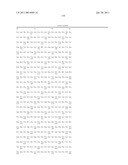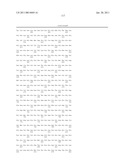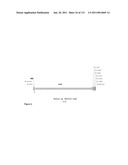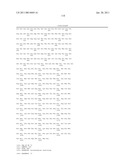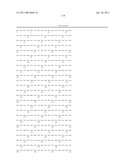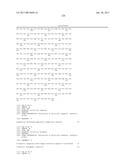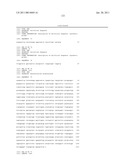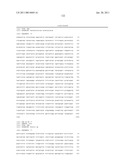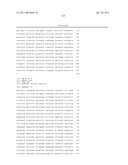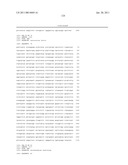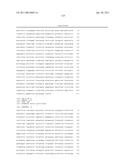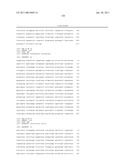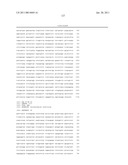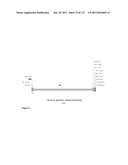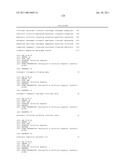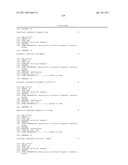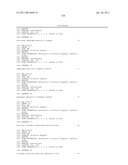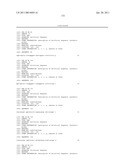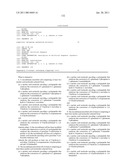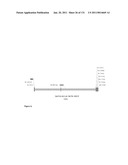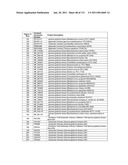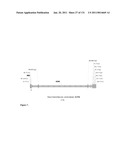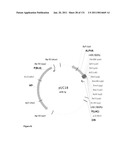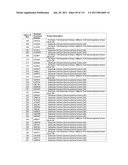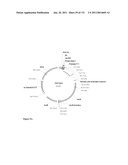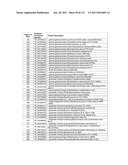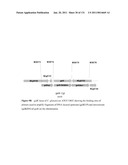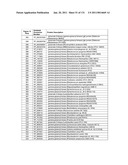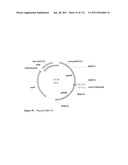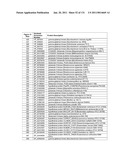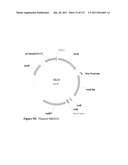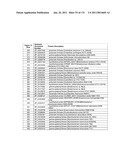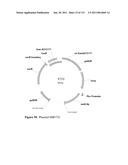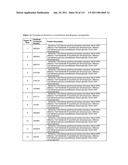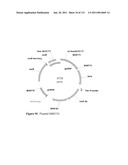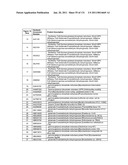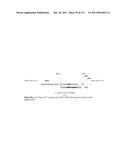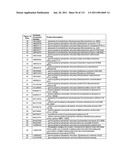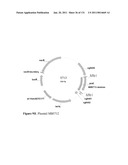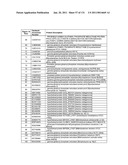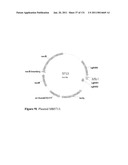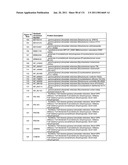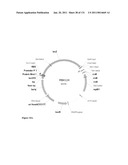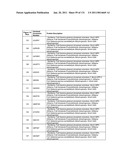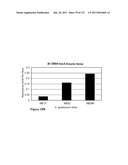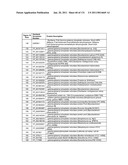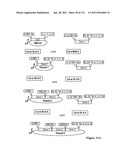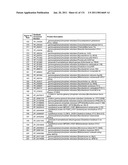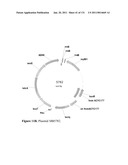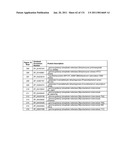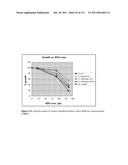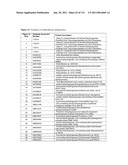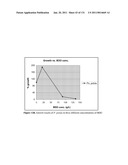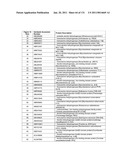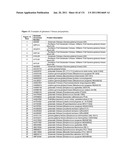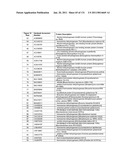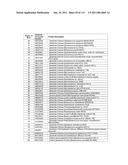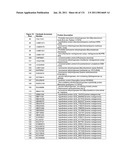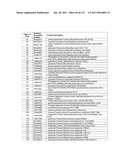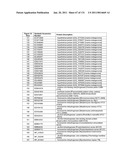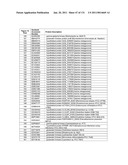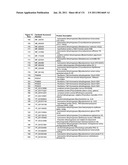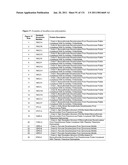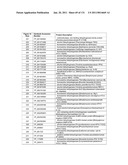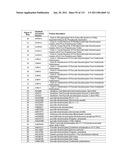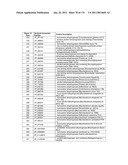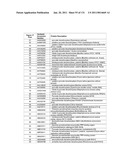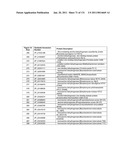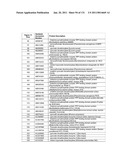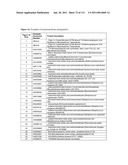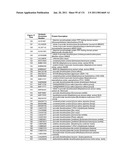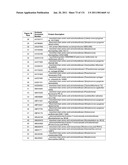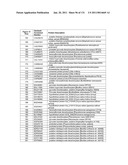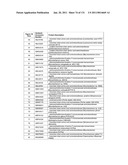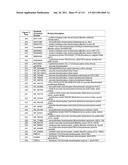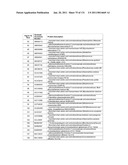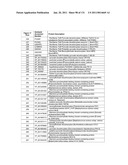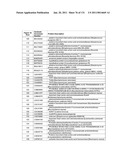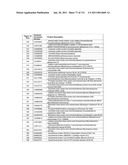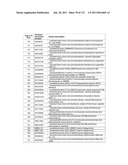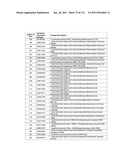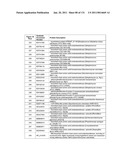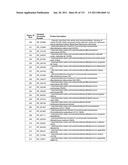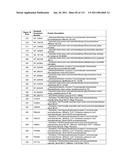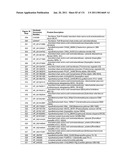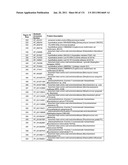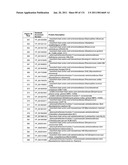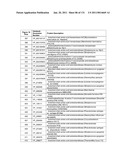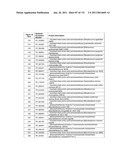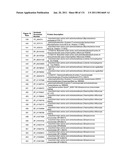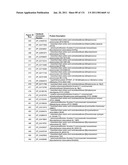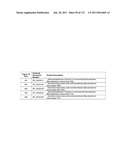Patent application title: Production of 1,4 Butanediol in a Microorganism
Inventors:
Kevin T. Madden (Arlington, MA, US)
Kevin T. Madden (Arlington, MA, US)
David M. Young (Newtonville, MA, US)
Stanley Bower (La Jolla, CA, US)
Chi-Li Liu (Decatur, IL, US)
Assignees:
MICROBIA, INC.
Tate & Lyle Ingredients Americas, Inc.
IPC8 Class: AC12P718FI
USPC Class:
435158
Class name: Containing hydroxy group acyclic polyhydric
Publication date: 2011-01-20
Patent application number: 20110014669
Claims:
1. A recombinant microbial cell comprising at least two nucleic acid
molecules selected from:(a) a nucleic acid molecule encoding a
polypeptide that catalyzes the conversion of L-glutamate to L-glutamate
5-phosphate;(b) a nucleic acid molecule encoding a polypeptide that
catalyzes the conversion of L-glutamate 5-phosphate to L-glutamate
5-semialdehyde;(c) a nucleic acid molecule encoding a polypeptide that
catalyzes the conversion of L-glutamate 5-semialdehyde to
5-hydroxy-L-norvaline;(d) a nucleic acid molecule encoding a polypeptide
that catalyzes the conversion of 5-hydroxy-L-norvaline to
5-hydroxy-2-oxopentanoate;(e) a nucleic acid molecule encoding a
polypeptide that catalyzes the conversion of 5-hydroxy-2-oxopentanoate to
4-hydroxybutanal;and(f) a nucleic acid molecule encoding a polypeptide
that catalyzes the conversion of 4-hydroxybutanal to
1,4-butanediol,wherein either: (i) the recombinant cell has been modified
to reduce the expression or activity of a polypeptide that catalyzes the
conversion of pyrroline 5-carboxylate to proline or (ii) the recombinant
cell does not comprise a nucleic acid molecule encoding active pyrroline
5-carboxylate reductase; andwherein the cell produces at least one of
5-hydroxy-L-norvaline, 5-hydroxy-2-oxopentanoate, 4-hydroxybutanal and
1,4-butanediol.
2. The recombinant microbial cell of claim 1 comprising at least three nucleic acid molecules selected from:(a) a nucleic acid molecule encoding a polypeptide that catalyzes the conversion of L-glutamate to L-glutamate 5-phosphate;(b) a nucleic acid molecule encoding a polypeptide that catalyzes the conversion of L-glutamate 5-phosphate to L-glutamate 5-semialdehyde;(c) a nucleic acid molecule encoding a polypeptide that catalyzes the conversion of L-glutamate 5-semialdehyde to 5-hydroxy-L-norvaline;(d) a nucleic acid molecule encoding a polypeptide that catalyzes the conversion of 5-hydroxy-L-norvaline to 5-hydroxy-2-oxopentanoate;(e) a nucleic acid molecule encoding a polypeptide that catalyzes the conversion of 5-hydroxy-2-oxopentanoate to 4-hydroxybutanal;and(f) a nucleic acid molecule encoding a polypeptide that catalyzes the conversion of 4-hydroxybutanal to 1,4-butanediol.
3. The recombinant microbial cell of claim 1 comprising at least four nucleic acid molecules selected from:(a) a nucleic acid molecule encoding a polypeptide that catalyzes the conversion of L-glutamate to L-glutamate 5-phosphate;(b) a nucleic acid molecule encoding a polypeptide that catalyzes the conversion of L-glutamate 5-phosphate to L-glutamate 5-semialdehyde;(c) a nucleic acid molecule encoding a polypeptide that catalyzes the conversion of L-glutamate 5-semialdehyde to 5-hydroxy-L-norvaline;(d) a nucleic acid molecule encoding a polypeptide that catalyzes the conversion of 5-hydroxy-L-norvaline to 5-hydroxy-2-oxopentanoate;(e) a nucleic acid molecule encoding a polypeptide that catalyzes the conversion of 5-hydroxy-2-oxopentanoate to 4-hydroxybutanal;and(f) a nucleic acid molecule encoding a polypeptide that catalyzes the conversion of 4-hydroxybutanal to 1,4-butanediol.
4. The recombinant microbial cell of claim 1 comprising at least five nucleic acid molecules selected from:(a) a nucleic acid molecule encoding a polypeptide that catalyzes the conversion of L-glutamate to L-glutamate 5-phosphate;(b) a nucleic acid molecule encoding a polypeptide that catalyzes the conversion of L-glutamate 5-phosphate to L-glutamate 5-semialdehyde;(c) a nucleic acid molecule encoding a polypeptide that catalyzes the conversion of L-glutamate 5-semialdehyde to 5-hydroxy-L-norvaline;(d) a nucleic acid molecule encoding a polypeptide that catalyzes the conversion of 5-hydroxy-L-norvaline to 5-hydroxy-2-oxopentanoate;(e) a nucleic acid molecule encoding a polypeptide that catalyzes the conversion of 5-hydroxy-2-oxopentanoate to 4-hydroxybutanal;and(f) a nucleic acid molecule encoding a polypeptide that catalyzes the conversion of 4-hydroxybutanal to 1,4-butanediol.
5. The recombinant microbial cell of claim 1 comprising:(a) a nucleic acid molecule encoding a polypeptide that catalyzes the conversion of L-glutamate to L-glutamate 5-phosphate;(b) a nucleic acid molecule encoding a polypeptide that catalyzes the conversion of L-glutamate 5-phosphate to L-glutamate 5-semialdehyde;(c) a nucleic acid molecule encoding a polypeptide that catalyzes the conversion of L-glutamate 5-semialdehyde to 5-hydroxy-L-norvaline;(d) a nucleic acid molecule encoding a polypeptide that catalyzes the conversion of 5-hydroxy-L-norvaline to 5-hydroxy-2-oxopentanoate;(e) a nucleic acid molecule encoding a polypeptide that catalyzes the conversion of 5-hydroxy-2-oxopentanoate to 4-hydroxybutanal;and(f) a nucleic acid molecule encoding a polypeptide that catalyzes the conversion of 4-hydroxybutanal to 1,4-butanediol.
6. A recombinant microbial cell comprising at least two nucleic acid molecules selected from:(a) a nucleic acid molecule encoding a polypeptide that catalyzes the conversion of L-glutamate 5-semialdehyde to 5-hydroxy-L-norvaline;(b) a nucleic acid molecule encoding a polypeptide that catalyzes the conversion of 5-hydroxy-L-norvaline to 5-hydroxy-2-oxopentanoate;(c) a nucleic acid molecule encoding a polypeptide that catalyzes the conversion of 5-hydroxy-2-oxopentanoate to 4-hydroxybutanal;and(d) a nucleic acid molecule encoding a polypeptide that catalyzes the conversion of 4-hydroxybutanal to 1,4-butanediolwherein either: (i) the recombinant cell has been modified to reduce the expression or activity of a polypeptide that catalyzes the conversion of pyrroline 5-carboxylate to proline or (ii) the recombinant cell does not comprise a nucleic acid molecule encoding active pyrroline 5-carboxylate reductase; andwherein the cell produces at least one of 5-hydroxy-L-norvaline, 5-hydroxy-2-oxopentanoate, 4-hydroxybutanal and 1,4-butanediol.
7. The recombinant microbial cell of claim 6 comprising at least three nucleic acid molecules selected from:(a) a nucleic acid molecule encoding a polypeptide that catalyzes the conversion of L-glutamate 5-semialdehyde to 5-hydroxy-L-norvaline;(b) a nucleic acid molecule encoding a polypeptide that catalyzes the conversion of 5-hydroxy-L-norvaline to 5-hydroxy-2-oxopentanoate;(c) a nucleic acid molecule encoding a polypeptide that catalyzes the conversion of 5-hydroxy-2-oxopentanoate to 4-hydroxybutanal;and(d) a nucleic acid molecule encoding a polypeptide that catalyzes the conversion of 4-hydroxybutanal to 1,4-butanediol.
8. The recombinant microbial cell of claim 6 comprising(a) a nucleic acid molecule encoding a polypeptide that catalyzes the conversion of L-glutamate 5-semialdehyde to 5-hydroxy-L-norvaline;(b) a nucleic acid molecule encoding a polypeptide that catalyzes the conversion of 5-hydroxy-L-norvaline to 5-hydroxy-2-oxopentanoate;(c) a nucleic acid molecule encoding a polypeptide that catalyzes the conversion of 5-hydroxy-2-oxopentanoate to 4-hydroxybutanal;and(d) a nucleic acid molecule encoding a polypeptide that catalyzes the conversion of 4-hydroxybutanal to 1,4-butanediol.
9.-42. (canceled)
43. The recombinant microbial cell of claim 1 wherein:(a) the polypeptide that catalyzes the conversion of L-glutamate to L-glutamate 5-phosphate is at least 80% identical to any of SEQ ID NOs:1-9 or any of the sequences represented by the Genbank Accession numbers in FIG. 13;(b) the polypeptide that catalyzes the conversion of L-glutamate 5-phosphate to L-glutamate 5-semialdehyde is at least 80% identical to any of SEQ ID NOs:10-15 or any of the sequences represented by the Genbank Accession numbers in FIG. 14;(c) the polypeptide that catalyzes the conversion of L-glutamate 5-semialdehyde to 5-hydroxy-L-norvaline is at least 80% identical to any of SEQ ID NOs:16-27 or any of the sequences represented by the Genbank Accession numbers in FIG. 15;(d) the polypeptide that catalyzes the conversion of 5-hydroxy-L-norvaline to 5-hydroxy-2-oxopentanoate is at least 80% identical to any of SEQ ID NOs:28-35, 58 or any of the sequences represented by the Genbank Accession numbers in FIG. 16;(e) the polypeptide catalyzes the conversion of 5-hydroxy-2-oxopentanoate to 4-hydroxybutanal is at least 80% identical to any of SEQ ID NOs:36-43, 59-70 or any of the sequences represented by the Genbank Accession numbers in FIG. 17;and(f) the polypeptide that catalyzes the conversion of 4-hydroxybutanal to 1,4-butanediol is at least 80% identical to any of SEQ ID NOs:44-50 or any of the sequences represented by the Genbank Accession numbers in FIG. 18.
44. The recombinant microbial cell of claim 6 wherein:(a) the polypeptide that catalyzes the conversion of L-glutamate 5-semialdehyde to 5-hydroxy-L-norvaline is at least 80% identical to any of SEQ ID NOs:16-27 or any of the sequences represented by the Genbank Accession numbers in FIG. 15;(b) the polypeptide that catalyzes the conversion of 5-hydroxy-L-norvaline to 5-hydroxy-2-oxopentanoate is at least 80% identical to any of SEQ ID NOs:28-35, 58 or any of the sequences represented by the Genbank Accession numbers in FIG. 16;(c) the polypeptide catalyzes the conversion of 5-hydroxy-2-oxopentanoate to 4-hydroxybutanal is at least 80% identical to any of SEQ ID NOs:36-43, 59-70 or any of the sequences represented by the Genbank Accession numbers in FIG. 17;and(d) the polypeptide that catalyzes the conversion of 4-hydroxybutanal to 1,4-butanediol is at least 80% identical to any of SEQ ID NOs:44-50 or any of the sequences represented by the Genbank Accession numbers in FIG. 18.
45.-68. (canceled)
69. The recombinant cell of claim 1 wherein the polypeptide that catalyzes the conversion of L-glutamate to L-glutamate 5-phosphate is a variant having one or more amino acid changes that confer reduced inhibition compared to an otherwise identical polypeptide lacking the one or more amino acid changes.
70.-72. (canceled)
73. The recombinant microbial cell of claim 1 wherein the microbial cell is a bacterium of species Corynebacterium glutamicum, Corynebacterium acetoglutamicum, Corynebacterium melassecola, Corynebacterium thermoaminogenes, Brevibacterium lactofermentum, Brevibacterium lactis, Brevibacterium ketoglutamicum, Brevibacterium saccharolyticum or Brevibacterium flavum bacterium.
74.-76. (canceled)
77. The recombinant microbial cell of claim 1 wherein at least two, three, four or five of the polypeptides are heterologous to the cell.
78. The recombinant microbial cell of claim 6 wherein at least two, three or four of the polypeptides are heterologous to the cell.
79. The recombinant microbial cell of claim 1 or claim 6 wherein at least four of the polypeptides are heterologous to the cell.
80. The recombinant microbial cell of claim 1 or claim 6 wherein at least five of the polypeptides are heterologous to the cell.
81.-99. (canceled)
100. A method for the production of 1,4-butanediol comprising:providing a host cell according to claim 1; andculturing the host cell under conditions whereby 1,4-butanediol is produced.
101. The method of claim 100 further comprising isolating the produced 1,4-butanediol.
102. The method of claim 100 wherein the cell is cultured in glucose.
103. The method of claim 100 wherein the cell produces 1 mM of 1,4-butanediol per mole of glucose.
104.-106. (canceled)
107. The recombinant microbial cell of claim 1 wherein the expression of at least one of the nucleic acids of (a) through (f) is under the control of an inducible promoter.
108. The recombinant microbial cell of claim 6 wherein the expression of at least one of the nucleic acids of (a) through (f) is under the control of an inducible promoter.
109. The recombinant cell of claim 6 wherein the polypeptide that catalyzes the conversion of L-glutamate to L-glutamate 5-phosphate is a variant having one or more amino acid changes that confer reduced inhibition compared to an otherwise identical polypeptide lacking the one or more amino acid changes.
110. The recombinant microbial cell of claim 6 wherein the microbial cell is a bacterium of species Corynebacterium glutamicum, Corynebacterium acetoglutamicum, Corynebacterium melassecola, Corynebacterium thermoaminogenes, Brevibacterium lactofermentum, Brevibacterium lactis, Brevibacterium ketoglutamicum, Brevibacterium saccharolyticum or Brevibacterium flavum bacterium.
Description:
[0001]This application claims the benefit of priority of U.S. Ser. No.
61/146,979, filed Jan. 23, 2009, the entire content of which is hereby
incorporated by reference.
BACKGROUND
[0002]Approximately 1.4 million metric tons of 1,4-butanediol (BDO) are produced annually from fossil fuel-based chemical building blocks such as butane, butadiene, acetylene and formaldehyde. BDO is a chemical intermediate used in the manufacture of a variety of polymers, solvents and fine chemicals. Representative chemicals that can be derived from BDO include gamma-butyrolactone (GBL), pyrrolidones and tetrahydrofuran (THF). BDO and chemicals made through further processing of BDO include: thermoplastics, spandex fibers, cements, inks and cleaning agents.
[0003]A need exists for developing alternative strategies for producing the aforementioned chemical building blocks through processes that substitute renewable for fossil fuel-based feedstocks. Biological production routes present the further possible advantages of reduced energy utilization, lower CO2 emissions and decreased capital expenditures.
[0004]The fermentative production of four-carbon dicarboxylic acids, such as succinate, has been explored as a means to provide a bio-based feedstock for the production of BDO and related chemicals. In these approaches hydrogenation technologies are employed to further process succinic acid to BDO. Despite the high, demonstrated efficiency of these fermentation processes (e.g., yields in excess of 1.5 moles succinic acid per mole of dextrose), their economic competitiveness has been challenged by costs associated with complex media components, purification of the dicarboxylic acid, waste disposal, and the integration of biological and hydrogenation processes.
[0005]More recently, multiple groups have demonstrated the potential for directly producing BDO through fermentation using bacteria that were constructed using metabolic engineering approaches (see, for example, WO 2008/115840). Natural isolates have never been shown to produce BDO, although a wide variety of organisms are capable of catabolizing this chemical. In principle, BDO produced through fermentation can be purified using methods such as micro- and nano-filtration or liquid-liquid extraction of the broth with a water immiscible solvent and subsequent distillation to isolate the BDO. This process simplicity, relative to the integrated fermentation and chemical modification process described above, offers the potential for a dramatic reduction in capital expenditures as well as utility and fixed costs. The theoretical efficiency (e.g., moles of BDO per mole of substrate) of a direct BDO process is much lower than that attained via fermentation to a dicarboxylic acid due to the increased metabolic energy and reducing equivalents required in the biosynthesis of BDO. Therefore, maximal fermentation yield and productivity are essential for the attainment of an economical BDO manufacturing process through direct fermentation.
[0006]The theoretical efficiency of producing BDO from dextrose is approximately one mole BDO per mole dextrose; the precise value will vary depending on specific pathway of choice and other assumptions. Many of the proposed metabolic engineering strategies for BDO production entail construction of a pathway in which carbon flows through the 4-hydroxybutyrate (4HB) intermediate. As examples, succinate, -ketoglutarate and glutamate are key central metabolites that have been identified as substrates to be utilized for further biosynthesis to BDO via 4HB. Regardless of the elected pathway and production organism, metabolic engineering strategies are likely to involve manipulations that employ both native and heterologous genes required to produce both 4HB and BDO. In principle, non-4HB pathways to produce BDO can be identified, and these pathways may be advantageous in that the engineered strains are likely to be subject to different metabolic and physiological constraints.
SUMMARY
[0007]The present disclosure provides a recombinant microorganism having a novel BDO biosynthetic pathway. Activities required for this novel BDO biosynthetic pathway can include, but are not limited to: a glutamate-5-kinase, a glutamate-5-semialdehyde dehydrogenase (glutamyl phosphate reductase), an oxidoreductase activity, a transaminase (aminotransferase), a keto-acid decarboxylase, and a second oxidoreductase activity. Construction of this pathway enables the biosynthesis of BDO from z,33 - ketoglutarate and glutamate. Additional modifications can be performed to optimize flux to these central metabolites, to reduce drain of these central metabolites and pathway intermediates to competing pathways, and to overcome other limitations that interfere with the efficient production of BDO. Preferred microorganisms to be modified to enable the biological production of BDO include bacteria that possess a high intrinsic ability to produce glutamate.
[0008]Described herein is a recombinant microbial cell comprising at least two (three, four, five or six) nucleic acid molecules selected from: [0009](a) a nucleic acid molecule encoding a polypeptide that catalyzes the conversion of L-glutamate to L-glutamate 5-phosphate; [0010](b) a nucleic acid molecule encoding a polypeptide that catalyzes the conversion of L-glutamate 5-phosphate to L-glutamate 5-semialdehyde; [0011](c) a nucleic acid molecule encoding a polypeptide that catalyzes the conversion of L-glutamate 5-semialdehyde to 5-hydroxy-L-norvaline; [0012](d) a nucleic acid molecule encoding a polypeptide that catalyzes the conversion of 5-hydroxy-L-norvaline to 5-hydroxy-2-oxopentanoate; [0013](e) a nucleic acid molecule encoding a polypeptide that catalyzes the conversion of 5-hydroxy-2-oxopentanoate to 4-hydroxybutanal; [0014]and [0015](f) a nucleic acid molecule encoding a polypeptide that catalyzes the conversion of 4-hydroxybutanal to 1,4-butanediol, [0016]wherein the cell produces at least one of 5-hydroxy-L-norvaline, 5-hydroxy-2-oxopentanoate, 4-hydroxybutanal and 1,4-butanediol.
[0017]Also described is a recombinant microbial cell comprising at least two (three or four) nucleic acid molecules selected from: [0018](a) a nucleic acid molecule encoding a polypeptide that catalyzes the conversion of L-glutamate 5-semialdehyde to 5-hydroxy-L-norvaline; [0019](b) a nucleic acid molecule encoding a polypeptide that catalyzes the conversion of 5-hydroxy-L-norvaline to 5-hydroxy-2-oxopentanoate; [0020](c) a nucleic acid molecule encoding a polypeptide that catalyzes the conversion of 5-hydroxy-2-oxopentanoate to 4-hydroxybutanal; [0021]and [0022](d) a nucleic acid molecule encoding a polypeptide that catalyzes the conversion of 4-hydroxybutanal to 1,4-butanediol, [0023]wherein the cell produces at least one of 5-hydroxy-L-norvaline, 5-hydroxy-2-oxopentanoate, 4-hydroxybutanal and 1,4-butanediol.
[0024]Described herein is a recombinant microbial cell comprising a nucleic acid molecule encoding a polypeptide that catalyzes the conversion of 5-hydroxy-2-oxopentanoate to 4-hydroxybutanal, wherein the cell produces 4-hydroxybutanal. In some cases the recombinant microbial cell further comprises at least one (two, three four or five nucleic acid molecule selected from: [0025](a) a nucleic acid molecule encoding a polypeptide that catalyzes the conversion of L-glutamate to L-glutamate 5-phosphate; [0026](b) a nucleic acid molecule encoding a polypeptide that catalyzes the conversion of L-glutamate 5-phosphate to L-glutamate 5-semialdehyde; [0027](c) a nucleic acid molecule encoding a polypeptide that catalyzes the conversion of L-glutamate 5-semialdehyde to 5-hydroxy-L-norvaline; [0028](d) a nucleic acid molecule encoding a polypeptide that catalyzes the conversion of 5-hydroxy-L-norvaline to 5-hydroxy-2-oxopentanoate; [0029]and [0030](e) a nucleic acid molecule encoding a polypeptide that catalyzes the conversion of 4-hydroxybutanal to 1,4-butanediol.
[0031]In some cases the microbial cell comprises at least one (two, or three) nucleic acid molecule selected from the group consisting of: [0032](a) a nucleic acid molecule encoding a polypeptide that catalyzes the conversion of L-glutamate 5-semialdehyde to 5-hydroxy-L-norvaline; [0033](b) a nucleic acid molecule encoding a polypeptide that catalyzes the conversion of 5-hydroxy-L-norvaline to 5-hydroxy-2-oxopentanoate; [0034]and [0035](c) a nucleic acid molecule encoding a polypeptide that catalyzes the conversion of 4-hydroxybutanal to 1,4-butanediol.
[0036]Described herein is a recombinant microbial cell comprising one or both of: [0037](a) a nucleic acid molecule encoding a polypeptide that catalyzes the conversion of L-glutamate 5-semialdehyde to 5-hydroxy-L-norvaline; and [0038](b) a nucleic acid molecule encoding a polypeptide that catalyzes the conversion of 5-hydroxy-2-oxopentanoate to 4-hydroxybutanal, [0039]wherein the cell produces at least one of 5-hydroxy-L-norvaline, 5-hydroxy-2-oxopentanoate, 4-hydroxybutanal and 1,4-butanediol.
[0040]In some cases: the cell comprises both: (a) a nucleic acid molecule encoding a polypeptide that catalyzes the conversion of L-glutamate 5-semialdehyde to 5-hydroxy-L-norvaline; and (b) a nucleic acid molecule encoding a polypeptide that catalyzes the conversion of 5-hydroxy-2-oxopentanoate to 4-hydroxybutanal; the cell further comprises one or both of: (c) a nucleic acid molecule encoding a polypeptide that catalyzes the conversion of 5-hydroxy-L-norvaline to 5-hydroxy-2-oxopentanoate; and (d) a nucleic acid molecule encoding a polypeptide that catalyzes the conversion of 4-hydroxybutanal to 1,4-butanediol; the cell further comprises both: (c) a nucleic acid molecule encoding a polypeptide that catalyzes the conversion of 5-hydroxy-L-norvaline to 5-hydroxy-2-oxopentanoate; and (d) a nucleic acid molecule encoding a polypeptide that catalyzes the conversion of 4-hydroxybutanal to 1,4-butanediol; the cell further comprising one or both of: (e) a heterologous nucleic acid molecule encoding a polypeptide that catalyzes the conversion of L-glutamate to L-glutamate 5-phosphate; and (f) a heterologous nucleic acid molecule encoding a polypeptide that catalyzes the conversion of L-glutamate 5-phosphate to L-glutamate 5-semialdehyde; the cell further comprises both of: (e) a heterologous nucleic acid molecule encoding a polypeptide that catalyzes the conversion of L-glutamate to L-glutamate 5-phosphate; and (f) a heterologous nucleic acid molecule encoding a polypeptide that catalyzes the conversion of L-glutamate 5-phosphate to L-glutamate 5-semialdehyde.
[0041]In some cases: the cell produces 5-hydroxy-L-norvaline, the cell produces 5-hydroxy-2-oxopentanoate; the cell produces 4-hydroxybutanal; the cell produces 1,4-butanediol; the cell produces 5-hydroxy-L-norvaline, 5-hydroxy-2-oxopentanoate, 4-hydroxybutanal and 1,4-butanediol.
[0042]In some cases, the recombinant microbial cell comprises at least one of: [0043](a) a nucleic acid molecule encoding a polypeptide that catalyzes the conversion of L-glutamate to L-glutamate 5-phosphate, wherein expression of the nucleic acid molecule is under the control of an inducible promoter; [0044](b) a nucleic acid molecule encoding a polypeptide that catalyzes the conversion of L-glutamate 5-phosphate to L-glutamate 5-semialdehyde, wherein expression of the nucleic acid molecule is under the control of an inducible promoter; [0045](c) a nucleic acid molecule encoding a polypeptide that catalyzes the conversion of L-glutamate 5-semialdehyde to 5-hydroxy-L-norvaline, wherein expression of the nucleic acid molecule is under the control of an inducible promoter; [0046](d) a nucleic acid molecule encoding a polypeptide that catalyzes the conversion of 5-hydroxy-L-norvaline to 5-hydroxy-2-oxopentanoate, wherein expression of the nucleic acid molecule is under the control of an inducible promoter; [0047](e) a nucleic acid molecule encoding a polypeptide that catalyzes the conversion of 5-hydroxy-2-oxopentanoate to 4-hydroxybutanal, wherein expression of the nucleic acid molecule is under the control of an inducible promoter; [0048]and [0049](f) a nucleic acid molecule encoding a polypeptide that catalyzes the conversion of 4-hydroxybutanal to 1,4-butanediol, wherein expression of the nucleic acid molecule is under the control of an inducible promoter.
[0050]In some cases recombinant microbial cell comprises an endogenous nucleic acid molecule encoding a polypeptide that catalyzes the conversion of L-glutamate to L-glutamate 5-phosphate, wherein expression of the nucleic acid molecule is under the control of an inducible promoter.
[0051]In some cases recombinant microbial cell comprises an endogenous nucleic acid molecule encoding a polypeptide that catalyzes the conversion of L-glutamate 5-phosphate to L-glutamate 5-semialdehyde, wherein expression of the nucleic acid molecule is under the control of an inducible promoter.
[0052]Also described is: a recombinant microbial comprising: [0053](a) a nucleic acid molecule encoding a polypeptide that catalyzes the conversion of L-glutamate 5-semialdehyde to 5-hydroxy-L-norvaline; [0054](b) a nucleic acid molecule encoding a polypeptide that catalyzes the conversion of 5-hydroxy-L-norvaline to 5-hydroxy-2-oxopentanoate; [0055]and [0056](c) a nucleic acid molecule encoding a polypeptide that catalyzes the conversion of 4-hydroxybutanal to 1,4-butanediol, [0057]wherein the cell has been modified to reduce the expression or activity of an endogenous polypeptide that catalyzes the conversion of pyrroline 5-carboxylate to proline. [0058]In some cases: the polypeptide that catalyzes the conversion of pyrroline 5-carboxylate to proline is pyrroline 5-carboxylate reductase; the cell does not comprise a nucleic acid molecule encoding active pyrroline 5-carboxylate reductase; the microbial cell further comprises a nucleic acid molecule encoding a polypeptide that catalyzes the conversion of L-glutamate to L-glutamate 5-phosphate, wherein expression of the nucleic acid molecule is under the control of an inducible promoter; the cell further comprises a nucleic acid molecule encoding a polypeptide that catalyzes the conversion of L-glutamate 5-phosphate to L-glutamate 5-semialdehyde.
[0059]In some cases the microbial cells described herein comprise one or both of: [0060](a) a nucleic acid molecule encoding a polypeptide that catalyzes the conversion of L-glutamate to L-glutamate 5-phosphate, wherein expression of the nucleic acid molecule is under the control of an inducible promoter; and [0061](b) a nucleic acid molecule encoding a polypeptide that catalyzes the conversion of L-glutamate 5-phosphate to L-glutamate 5-semialdehyde, wherein expression of the nucleic acid molecule is under the control of an inducible promoter.
[0062]In various embodiments: the recombinant microbial cell comprises a nucleic acid molecule encoding a polypeptide that catalyzes the conversion of 4-hydroxybutanal to 1,4-butanediol; the cell has been modified to reduce the expression or activity of a polypeptide that catalyzes the conversion of pyrroline 5-carboxylate to proline; the polypeptide that catalyzes the conversion of pyrroline 5-carboxylate to proline is pyrroline 5-carboxylate reductase; the cell does not comprise a nucleic acid molecule encoding active pyrroline 5-carboxylate reductase; the polypeptide that catalyzes the conversion of 5-hydroxy-2-oxopentanoate to 4-hydroxybutanal is at least 80% identical to any of SEQ ID NOs:36-43, 59-70 or any of the sequences represented by the Genbank Accession numbers in FIG. 17.
[0063]In some cases: (a) the polypeptide that catalyzes the conversion of L-glutamate to L-glutamate 5-phosphate is at least 80% identical to any of SEQ ID NOs:1-9 or any of the sequences represented by the Genbank Accession numbers in FIG. 13; (b) the polypeptide that catalyzes the conversion of L-glutamate 5-phosphate to L-glutamate 5-semialdehyde is at least 80% identical to any of SEQ ID NOs:10-15 or any of the sequences represented by the Genbank Accession numbers in FIG. 14; (c) the polypeptide that catalyzes the conversion of L-glutamate 5-semialdehyde to 5-hydroxy-L-norvaline is at least 80% identical to any of SEQ ID NOs:16-27 or any of the sequences represented by the Genbank Accession numbers in FIG. 15; [0064](d) the polypeptide that catalyzes the conversion of 5-hydroxy-L-norvaline to 5-hydroxy-2-oxopentanoate is at least 80% identical to any of SEQ ID NOs:28-35, 58 or any of the sequences represented by the Genbank Accession numbers in FIG. 16; (e) the polypeptide catalyzes the conversion of 5-hydroxy-2-oxopentanoate to 4-hydroxybutanal is at least 80% identical to any of SEQ ID NOs:36-43, 59-70 or any of the sequences represented by the Genbank Accession numbers in FIG. 17; and (f) the polypeptide that catalyzes the conversion of 4-hydroxybutanal to 1,4-butanediol is at least 80% identical to any of SEQ ID NOs:44-50 or any of the sequences represented by the Genbank Accession numbers in FIG. 18.
[0065]In some cases: (a) the polypeptide that catalyzes the conversion of L-glutamate 5-semialdehyde to 5-hydroxy-L-norvaline is at least 80% identical to any of SEQ ID NOs:16-27 or any of the sequences represented by the Genbank Accession numbers in FIG. 15; (b) the polypeptide that catalyzes the conversion of 5-hydroxy-L-norvaline to 5-hydroxy-2-oxopentanoate is at least 80% identical to any of SEQ ID NOs:28-35, 58 or any of the sequences represented by the Genbank Accession numbers in FIG. 16; (c) the polypeptide catalyzes the conversion of 5-hydroxy-2-oxopentanoate to 4-hydroxybutanal is at least 80% identical to any of SEQ ID NOs:36-43, 59-70 or any of the sequences represented by the Genbank Accession numbers in FIG. 17; and (d) the polypeptide that catalyzes the conversion of 4-hydroxybutanal to 1,4-butanediol is at least 80% identical to any of SEQ ID NOs:44-50 or any of the sequences represented by the Genbank Accession numbers in FIG. 18.
[0066]In some cases: the polypeptide that catalyzes the conversion of L-glutamate to L-glutamate 5-phosphate is a variant having one or more amino acid changes that confer reduced inhibition compared to an otherwise identical polypeptide lacking the one or more amino acid changes; and the polypeptide that catalyzes the conversion of L-glutamate 5-semialdehyde to 5-hydroxy-L-norvaline is a variant having one or more amino acid changes that confer reduced inhibition compared to an otherwise identical polypeptide lacking the one or more amino acid changes.
[0067]In some cases: the microbial cell is a bacterium; the bacterium is a coryneform bacterium or a bacterium of the genus Arthrobacter, Bacillus, Escherichia, Pseudomonas or Rhodococcus; the bacterium is a Corynebacterium glutamicum, Corynebacterium acetoglutamicum, Corynebacterium melassecola, Corynebacterium thermoaminogenes, Brevibacterium lactofermentum, Brevibacterium lactis, Brevibacterium ketoglutamicum, Brevibacterium saccharolyticum or Brevibacterium flavum bacterium; the bacterium is a Corynebacterium glutamicum bacterium; the recombinant microbial cell is produced by genetic modification of a cell selected from the group consisting of: ATCC 13032, ATCC 21157, ATCC 21158, ATCC 21159, ATCC 21355, NRRL B-11423, NRRL B-11294, ATCC 10798, ATCC 25208, ATCC 25377 and ATCC 25378; at least one of the polypeptides is heterologous to the cell; at least two of the polypeptides are heterologous to the cell; at least three of the polypeptides are heterologous to the cell; at least four of the polypeptides are heterologous to the cell; and at least five of the polypeptides are heterologous to the cell.
[0068]In some cases the nucleic acid molecule is an isolated nucleic acid molecule.
[0069]In some cases: the polypeptide that catalyzes the conversion of L-glutamate to L-glutamate 5-phosphate is a glutamate 5-kinase; the polypeptide that catalyzes the conversion of L-glutamate to L-glutamate 5-phosphate comprises an amino acid sequence that is at least 80% identical to any of SEQ ID NOs:1-9 or any of the sequences represented by the Genbank Accession numbers in FIG. 13; the polypeptide that catalyzes the conversion of L-glutamate 5-phosphate to L-glutamate 5-semialdehyde is a glutamate-5-semialdehyde dehydrogenase; the polypeptide that catalyzes the conversion of L-glutamate 5-phosphate to L-glutamate 5-semialdehyde comprises an amino acid sequence that is at least 80% identical to any of SEQ ID NOs:10-15 or any of the sequences represented by the Genbank Accession numbers in FIG. 14; the polypeptide that catalyzes the conversion of L-glutamate 5-semialdehyde to 5-hydroxy-L-norvaline is a long chain alcohol NAD+ oxidoreductase, L-iditol 2-dehydrogenase, or a zinc-containing alcohol dehydrogenase; the polypeptide that catalyzes the conversion of L-glutamate 5-semialdehyde to 5-hydroxy-L-norvaline comprises an amino acid sequence that is at least 80% identical to any of SEQ ID NOs:16-27 or any of the sequences represented by the Genbank Accession numbers in FIG. 15; the polypeptide that catalyzes the conversion of 5-hydroxy-L-norvaline to 5-hydroxy-2-oxopentanoate is a branched-chain-amino-acid transaminase; the polypeptide that catalyzes the conversion of 5-hydroxy-L-norvaline to 5-hydroxy-2-oxopentanoate uses alpha-ketoglutarate as an amino acceptor; the polypeptide that catalyzes the conversion of 5-hydroxy-L-norvaline to 5-hydroxy-2-oxopentanoate comprises an amino acid sequence that is at least 80% identical to any of SEQ ID NOs:28-35, 58 or any of the sequences represented by the Genbank Accession numbers in FIG. 16; the polypeptide that catalyzes the conversion of 5-hydroxy-2-oxopentanoate to 4-hydroxybutanal is a decarboxylase.
[0070]Also described is a recombinant microbial host wherein the polypeptide that catalyzes the conversion of 5-hydroxy-2-oxopentanoate to 4-hydroxybutanal is a branched chain alpha-keto decarboxylase, a pyruvate decarboxylase or a benzoylformate decarboxylase; the polypeptide that catalyzes the conversion of 5-hydroxy-2-oxopentanoate to 4-hydroxybutanal comprises an amino acid sequence that is at least 80% identical to any of SEQ ID NOs:36-43, 59-70 or any of the sequences represented by the Genbank Accession numbers in FIG. 17; the polypeptide that catalyzes the conversion of 4-hydroxybutanal to 1,4-butanediol is a 4-hydroxybutyrate dehydrogenase, a 1,3 propanediol dehydrogenase, cinnamyl-alcohol dehydrogenase, or an alcohol dehydrogenase; the polypeptide that catalyzes the conversion of 4-hydroxybutanal to 1,4-butanediol comprises an amino acid sequence that is at least 80% identical to any of SEQ ID NOs:44-50 or any of the sequences represented by the Genbank Accession numbers in FIG. 18.
[0071]In some cases the recombinant microbial cell comprises a polypeptide that catalyzes the conversion of L-glutamate 5-semialdehyde to 5-hydroxy-L-norvaline and is at least 80%, 85%, 90%, 95%, 98% or 100% identical to SEQ ID NO:18.
[0072]In some cases the recombinant microbial cell comprises a polypeptide that catalyzes the conversion of 5-hydroxy-L-norvaline to 5-hydroxy-2-oxopentanoate and is at least 80%, 85%, 90%, 95%, 98% or 100% identical to SEQ ID NO:58.
[0073]In some cases the recombinant microbial cell comprises a polypeptide that catalyzes the conversion of 5-hydroxy-2-oxopentanoate to 4-hydroxybutanal and is at least 80%, 85%, 90%, 95%, 98% or 100% identical to SEQ ID NO:36.
[0074]In some cases the recombinant microbial cell comprises a polypeptide that catalyzes the conversion of 4-hydroxybutanal to 1,4-butanediol is at least 80%, 85%, 90%, 95%, 98% or 100% identical to SEQ ID NO:47.
[0075]In some cases the polypeptide has 1, 2, 3, 4, 5, 6, 7, 8, 9, 10 or fewer amino acid changes compared to a polypeptide sequence disclosed herein. In some cases the amino acid changes are conservative changes within the following groups: polar (S, T, N, and Q); positively charged (R, H and K); negatively charged (D and E); and hydrophobic (A, I, L, M, F, W, Y and V).
[0076]In some cases: the recombinant microbial host has a genetic modification that decreases the activity or expression of one or more enzymes selected from [0077](a) an enzyme that catalyzes the conversion of alpha-ketoglutarate to isocitrate; [0078](b) an enzyme that catalyzes the conversion of alpha-ketoglutarate to succinyl-CoA; [0079](c) an enzyme that catalyzes the conversion of L-glutamate to alpha-ketoglutarate; [0080](d) an enzyme that catalyzes the conversion of L-glutamate to L-glutamine; [0081](e) an enzyme that catalyzes the conversion of L-glutamate to L-1-pyrroline 5-carboxylate; [0082](f) an enzyme that catalyzes the conversion of L-proline to L-1-pyrroline 5-carboxylate; [0083]and [0084](g) an enzyme that catalyzes the conversion of L-1-pyrroline 5-carboxylate to L-proline.
[0085]In some cases: the recombinant microbial host has a genetic modification that increases the activity or expression of one or more enzymes selected from:
(a) an enzyme that catalyzes the conversion of alpha-ketoglutarate to isocitrate;(b) an enzyme that catalyzes the conversion of alpha-ketoglutarate to succinyl CoA;and(c) an enzyme that catalyzes the conversion of L-glutamate to alpha-ketoglutarate.
[0086]In some cases: the recombinant microbial host further comprises a nucleic acid molecule encoding one or more polypeptides selected from the group consisting of:
(a) succinyl-CoA synthetase;(b) CoA-independent succinic semialdehyde dehydrogenase;(c) α-ketoglutarate dehydrogenase complex;(d) 4-aminobutyrate aminotransferase;(e) glutamate decarboxylase;(f) CoA-dependent succinic semialdehyde dehydrogenase;(g) 4-hydroxybutyrate dehydrogenase;(h) α-ketoglutarate decarboxylase;(i) 4-hydroxybutyryl-CoA transferase;(j) butyrate kinase;(k) phosphotransbutyrylase; and(l) alcohol/aldehyde dehydrogenase.
[0087]In some cases: the recombinant microbial host further comprises nucleic acid molecules encoding at least two polypeptides selected from the group consisting of:
(a) succinyl-CoA synthetase;(b) CoA-independent succinic semialdehyde dehydrogenase;(c) α-ketoglutarate dehydrogenase complex;(d) 4-aminobutyrate aminotransferase;(e) glutamate decarboxylase;(f) CoA-dependent succinic semialdehyde dehydrogenase;(g) 4-hydroxybutyrate dehydrogenase;(h) α-ketoglutarate decarboxylase;(i) 4-hydroxybutyryl-CoA transferase;(j) butyrate kinase;(k) phosphotransbutyrylase; and(l) alcohol/aldehyde dehydrogenase.
[0088]In some cases the recombinant microbial cell does not produce 4-hydroxybutyrate.
[0089]In various cases the polypeptide encoded by the nucleic acid molecule is operably linked to expression control sequences that permit the expression of the polypeptide.
[0090]In various cases the cell produces at least one of 5-hydroxy-L-norvaline, 5-hydroxy-2-oxopentanoate, 4-hydroxybutanal and 1,4-butanediol, e.g., when cultured on an appropriate carbon source such as glucose or
[0091]Also disclosed is a method for the production of 1,4-butanediol comprising: providing a recombinant microbial cell as described herein; and culturing the host cell under conditions whereby 1,4-butanediol is produced. The method can also include isolating the produced 1,4-butanediol.
[0092]Also disclosed is a method for the production gamma-butyrolactone comprising: providing a recombinant microbial cell as described herein; and culturing the host cell under conditions whereby 1,4-butanediol is produced; and oxidizing the 1,4-butanediol to produce gamma-butyrolactone.
[0093]Also disclosed is a method for preparing tetrahydrofuran (THF) comprising: providing a recombinant microbial cell as described herein; culturing the host cell under conditions whereby 1,4-butanediol is produced; isolating the produced 1,4-butanediol; and hydrogenolysis of the produced 1,4-butanediol to produce THF.
[0094]Also disclosed is a method for preparing pyrrolidone or N-methyl-pyrrolidone comprising: providing a recombinant microbial cell as described herein; culturing the host cell under conditions whereby 1,4-butanediol is produced; isolating the produced 1,4-butanediol; and further processing the produced 1,4-butanediol to produce pyrrolidone or N-methyl-pyrrolidone.
[0095]Also described is: a polypeptide comprising the amino acid sequence of SEQ ID NO: 36 having an amino acid change selected from the group consisting of: (a) Gln changed to Lys, Arg or His at position 362; and (b) Phe changed to Trp or Tyr at position 382; a branched-chain alpha-keto acid decarboxylase (e.g., Lactotococcus lactis branched-chain alpha-keto acid decarboxylase (KdcA)) having an amino acid change selected from the group consisting of: (a) Gln changed to Lys, Arg or His at position 362; and (b) Phe changed to Trp or Tyr at position 382; a polypeptide comprising the amino acid sequence of SEQ ID NO: 36 having (a) Gln changed to Lys, Arg or His at position 362; and (b) Phe changed to Trp or Tyr at position 382; a branched-chain alpha-keto acid decarboxylase (e.g., Lactotococcus lactis branched-chain alpha-keto acid decarboxylase (KdcA)) having: (a) Gln changed to Lys, Arg or His at position 362; and Phe changed to Trp or Tyr at position 382. In some cases the Gln at position 362 is changed to Lys. In some cases the Phe at position 382 is changed to Trp. Also described is a branched-chain alpha-keto acid decarboxylase polypeptide having one or two amino acid changes selected from the group consisting of: (a) Gln changed to Lys, Arg or His at the position corresponding to position 362 in SEQ ID NO: 36; and (b) Phe changed to Trp or Tyr at the position corresponding to position 382 in SEQ ID NO: 36. Also described is a polypeptide comprising the amino acid sequence of SEQ ID NO: 36 having an amino acid change selected from the group consisting of: (a) Gln changed to Lys, Arg or His at position 362; and (b) Phe changed to Ala, Ile, Leu, Met, Val, Trp or Tyr at position 382; a branched-chain alpha-keto acid decarboxylase (e.g., Lactotococcus lactis branched-chain alpha-keto acid decarboxylase (KdcA)) having an amino acid change selected from the group consisting of: (a) Gln changed to Lys, Arg or His at position 362; and (b) Phe changed to Ala, Ile, Leu, Met, Val, Trp or Tyr at position 382; a polypeptide comprising the amino acid sequence of SEQ ID NO: 36 having (a) Gln changed to Lys, Arg or His at position 362; and (b) Phe changed to Ala, Ile, Leu, Met, Val, Trp or Tyr at position 382; a branched-chain alpha-keto acid decarboxylase (e.g., Lactotococcus lactis branched-chain alpha-keto acid decarboxylase (KdcA)) having: (a) Gln changed to Lys, Arg or His at position 362; and Phe changed to Ala, Ile, Leu, Met, Val, Trp or Tyr at position 382. In some cases the Gln at position 362 is changed to Lys. Also described is a branched-chain alpha-keto acid decarboxylase polypeptide having one or two amino acid changes selected from the group consisting of: (a) Gln changed to Lys, Arg or His at the position corresponding to position 362 in SEQ ID NO: 36; and (b) Phe changed to Ala, Ile, Leu, Met, Val, Trp or Tyr at the position corresponding to position 382 in SEQ ID NO: 36. Also disclosed are isolated nucleic acid molecules encoding such polypeptides, vectors (including expression vectors comprising such nucleic acid molecules and cells (including microbial cells) comprising such nucleic acid molecules or vectors. These nucleic acid molecules are useful in embodiments entailing the use of a nucleic acid molecule encoding a polypeptide that catalyzes the conversion of 5-hydroxy-2-oxopentanoate to 4-hydroxybutanal.
DEFINITIONS
[0096]Corresponding: An amino acid that is "corresponding" to an amino acid in a reference sequence occupies a site that is homologous to the site in the reference sequence. Corresponding amino acids can be identified by alignment of related sequences. Amino acid sequences can be compared to protein sequences available in public databases using algorithms such as BLAST, FASTA, ClustalW, which are well known to those skilled in the art.
[0097]Expression: The term "expression" refers to the production of a gene product (i.e., RNA or protein). For example, "expression" includes transcription of a gene to produce a corresponding mRNA, and/or translation of such an mRNA to produce the corresponding peptide, polypeptide, or protein.
[0098]Functionally linked: The phrase "functionally linked" or "operably linked" refers to a promoter or promoter region and a coding or structural sequence in such an orientation and distance that transcription of the coding or structural sequence may be directed by the promoter or promoter region.
[0099]Functionally transformed: As used herein, the term "functionally transformed" refers to a host cell that has been caused to express one or more polypeptides as described herein, such that the expressed polypeptide is functional and is active at a level higher than is observed with an otherwise identical cell (i.e., a parental cell) that has not been so transformed. In many embodiments, functional transformation involves introduction of a nucleic acid encoding the polypeptide(s) such that the polypeptide(s) is/are produced in an active form and/or appropriate location. Alternatively or additionally, in some embodiments, functional transformation involves introduction of a nucleic acid that regulates expression of such an encoding nucleic acid. Functional transformation may comprise introduction of one or more nucleic acid sequences by, for example, mating, transduction, conjugation or transformation of naturally-, chemically-, or electro-competent cells.
[0100]Gene: The term "gene", as used herein, generally refers to a nucleic acid encoding a polypeptide, optionally including certain regulatory elements that may affect expression of one or more gene products (i.e., RNA or protein). A gene may be in chromosomal DNA, plasmid DNA, cDNA, synthetic DNA, or other DNA that encodes a peptide, polypeptide, protein, or RNA molecule, and may include regions flanking the coding sequence involved in the regulation of expression.
[0101]Heterologous: The term "heterologous", means from a source organism other than the host cell. For example, "heterologous" as used herein refers to genetic material or a polypeptide(s) that does not naturally occur in the species in which it is present and/or being expressed. It will be understood that, in general, when heterologous genetic material or a polypeptide is selected for introduction into and/or expression by a host cell, the particular source organism from which the heterologous genetic material or polypeptide may be selected is not critical to the practice of the present disclosure. Relevant considerations may include, for example, how closely related the potential source and host organisms are in evolution, or how related the source organism is with other source organisms from which sequences of other relevant polypeptides have been selected. Where a plurality of different heterologous polypeptides and/or nucleic acids are to be introduced into and/or expressed by a host cell, different polypeptides or nucleic acids may be from different source organisms, or from the same source organism. To give but one example, in some cases, individual polypeptides may represent individual subunits of a complex protein activity and/or may be required to work in concert with other polypeptides in order to achieve the goals of the present disclosure. In some embodiments, it will often be desirable for such polypeptides to be from the same source organism, and/or to be sufficiently related to function appropriately when expressed together in a host cell. In some embodiments, such polypeptides may be from different, even unrelated source organisms. It will further be understood that, where a heterologous polypeptide is to be expressed in a host cell, it will often be desirable to utilize nucleic acids whose sequences encode the polypeptide that have been adjusted to accommodate codon preferences of the host cell and/or to link the encoding sequences with regulatory elements active in the host cell.
[0102]Homologous: The term "homologous", as used herein, means from the same source organism as the host cell. For example, as used here to refer to genetic material or to polypeptides, the term "homologous" refers to genetic material or a polypeptide(s) that naturally occurs in the organism in which it is present and/or being expressed, although optionally at different activity levels and/or in different amounts.
[0103]Host cell: As used herein, the "host cell" is a cell that is manipulated according to the present disclosure to produce BDO as described herein. A "modified host cell", as used herein, is any host cell which has been modified, engineered, or manipulated in accordance with the present disclosure as compared with a parental cell. In some embodiments, the parental cell is a naturally occurring parental cell. Typically, the host cell is a microbial cell such as a bacterial, fungal cell or a yeast cell.
[0104]Hybridization: "Hybridization" refers to the ability of a strand of nucleic acid to join with a complementary strand via base pairing. Hybridization occurs when complementary sequences in the two nucleic acid strands bind to one another.
[0105]Isolated: The term "isolated", as used herein, means that the isolated entity has been separated from at least one component with which it was previously associated. When most other components have been removed, the isolated entity is "purified" or "concentrated". Isolation and/or purification and/or concentration may be performed using any techniques known in the art including, for example, fractionation, extraction, precipitation, or other separation.
[0106]Modified: The term "modified", as used herein, refers to a host cell that has been modified to increase or otherwise improve the production of BDO or a BDO intermediate, as compared with an otherwise identical host organism that has not been so modified. In principle, such "modification" in accordance with the present disclosure may comprise any chemical, physiological, genetic, or other modification that appropriately alters production of BDO in a host organism as compared with such production in an otherwise identical cell not subject to the same modification. In most embodiments, however, the modification will comprise a genetic modification. For example, a genetic modification can entail: the addition of all or a portion of gene that is not naturally present in the host cell, the addition of all or a portion of a gene that is already present in the host cell, the deletion of all or a portion of a gene that is naturally in the host cell, an alteration (e.g., a sequence change in) of a gene that is naturally present in the host cell (e.g., a sequence change that increases expression, a sequence change that decreases expression, a sequence change that increases enzymatic, transport or other activity of a polypeptide, a sequence change that decreases enzymatic, transport or other activity of a polypeptide) and combinations thereof. In some cases, a modification comprises at least one chemical, physiological, genetic, or other modification; in other cases, a modification comprises more than one chemical, physiological, genetic, or other modification. In certain aspects where more than one modification is utilized, such modifications can comprise any combination of chemical, physiological, genetic, or other modifications (e.g., one or more genetic, chemical and/or physiological modification(s)).
[0107]Promoter: As is known in the art, the term "promoter" or "promoter region" refers to a DNA sequence, usually found upstream (5') to a coding sequence, that controls expression of the coding sequence by controlling production of messenger RNA (mRNA) by providing the recognition site for RNA polymerase and/or other factors necessary for start of transcription at the correct site.
[0108]Recombinant: A "recombinant" host cell, as that term is used herein, is a host cell that has been genetically modified. For example, a "recombinant cell" can be a cell that contains a nucleic acid sequence not naturally occurring in the cell, or an additional copy or copies of an endogenous nucleic acid sequence, wherein the nucleic acid sequence is introduced into the cell or an ancestor thereof by human action. A recombinant cell includes, but is not limited to: a cell which has been genetically modified by deletion of all or a portion of a gene, a cell that has had a mutation introduced into a gene, a cell that has had a nucleic acid sequence inserted, for example, to add or disrupt a functional gene or modify its regulation, and a cell that has a gene that has been modified by both removing and adding a nucleic acid sequence. A "recombinant vector" or "recombinant DNA or RNA construct" refers to any nucleic acid molecule generated by the hand of man. For example, a recombinant construct may be a vector such as a plasmid, cosmid, virus, autonomously replicating sequence, phage, or linear or circular single-stranded or double-stranded DNA or RNA molecule. A recombinant nucleic acid may be derived from any source and/or capable of genomic integration or autonomous replication where it includes two or more sequences that have been linked together by the hand of man. Recombinant constructs may, for example, be capable of introducing a 5' regulatory sequence or promoter region and a DNA sequence for a selected gene product into a cell in such a manner that the DNA sequence is transcribed into a functional mRNA, which may or may not be translated and therefore expressed.
[0109]Reduced inhibition. A polypeptide with "reduced inhibition" includes a polypeptide that is less inhibited by the presence of an inhibitory factor as compared to a wild-type form of the polypeptide or a polypeptide that is less inhibited by the presence of an inhibitory factor as compared to the corresponding endogenous polypeptide expressed in the organism into which the polypeptide has been introduced. In certain cases, the inhibitory factor is an allosteric inhibitor. In certain cases, the inhibitory factor may be a product or an intermediate of a BDO biosynthetic pathway, e.g., a product produced by the polypeptide that is inhibited or a product that inhibits an earlier step in the pathway. This type of inhibition is commonly referred to as feedback inhibition, and reduced inhibition includes reduced feedback inhibition. For example, a wild-type glutamate kinase from E. coli may have 10-fold less activity in the presence of a given concentration of proline, or proline plus ADP, respectively. A glutamate kinase with reduced inhibition may have, for example, 5-fold less, 2-fold less, or wild-type levels of activity in the presence of the same concentration of proline or proline plus ADP. Once a variant enzyme having one or more amino acid changes which result in reduced inhibition has been identified, it can be used as a model by those skilled in the art to create variants of a heterologous enzyme by making the same or a similar amino acid change(s) at the corresponding position(s) in the heterologous enzyme. The amino acid change in the heterologous enzyme need not be identical to the change in the model enzyme. For example, if the amino acid change in the model enzyme changes a basic amino acid to a neutral amino acid, e.g., Ala, the change in the heterologous enzyme can change a basic amino acid to a different neutral amino acid, e.g., Gly.
[0110]Selectable: The term "selectable" is used to refer to a marker whose expression confers a phenotype facilitating identification, and specifically facilitating survival or death, of cells containing the marker. A selectable marker can be a nucleotide sequence that confers antibiotic resistance in a host. These selectable markers include ampicillin, cefazolin, augmentin, cefoxitin, ceftazidime, ceftiofur, cephalothin, enrofloxicin, kanamycin, spectinomycin, streptomycin, tetracycline, ticarcillin, tilmicosin, or chloramphenicol resistance genes. Additional selectable markers include genes that can complement nutritional auxotrophies present in a particular host strain (e.g., leucine, tryptophan, or homoserine auxotrophies). Alternatively, strategies exist to identify cells that do or do not contain a particular marker. An example of a negative selection marker is the sacB gene, encoding the levansucrase gene from Bacillus subtilis. Modified cells that contain an active sacB gene can be identified by a lack of growth on medium containing sucrose. The sacB gene product acts to polymerize sucrose to form levan that is toxic to many bacteria including C. glutamicum. (see Jager, W., et al. J. Bacteriol. 174:5462-5465, 1992).
[0111]Sequence Identity: As used herein, the term "sequence identity" refers to a comparison between two sequences (e.g., two nucleic acid sequences or two amino acid sequences) and assessment of the degree to which they contain the same residue at the same position. As is known to those of ordinary skill in the art, an assessment of sequence identity includes an assessment of which positions in different sequences should be considered to be corresponding positions; adjustment for gaps, etc. is permitted. Furthermore, an assessment of residue identity can include an assessment of degree of identity such that consideration can be given to positions in which the identical residue (e.g., nucleotide or amino acid) is not observed, but a residue sharing one or more structural, chemical, or functional features is found. Identity can be determined by sequence alignment. The percent identity between the two sequences is a function of the number of identical positions shared by the sequences, taking into account the number of gaps, and the length of each gap, which needs to be introduced for optimal alignment of the two sequences. Any of a variety of algorithms or approaches may be utilized to calculate sequence identity. For example, in some embodiments, the Needleman and Wunsch (1970) J. Mol. Biol. 48:444-453 algorithm can be utilized. This algorithm has been incorporated into the GAP program in the GCG software package (available at http://www.gcg.com). In some such embodiments, the Needleman and Wunsch algorithm is employed using either a Blosum 62 matrix or a PAM250 matrix, and a gap weight of 16, 14, 12, 10, 8, 6, or 4 and a length weight of 1, 2, 3, 4, 5, or 6. In some embodiments, sequence alignment is performed using the GAP program in the GCG software package (available at http://www.gcg.com), using a NWSgapdna.CMP matrix and a gap weight of 40, 50, 60, 70, or 80 and a length weight of 1, 2, 3, 4, 5, or 6. A default set of parameters (and the one that can be used if the practitioner is uncertain about what parameters should be applied to determine if a molecule is within a sequence identity or homology limitation of the disclosure) are a Blosum 62 scoring matrix with a gap penalty of 12, a gap extend penalty of 4, and a frameshift gap penalty of 5. In some embodiments, a sequence alignment is performed using the algorithm of Meyers and Miller ((1989) CABIOS, 4:11-17). This algorithm has been incorporated into the ALIGN program (version 2.0). In some such embodiments, this algorithm is employed using a PAM 120 weight residue table, a gap length penalty of 12 and a gap penalty of 4. In some embodiments, a sequence alignment is performed using the ClustalW program. In some such embodiments, default values, namely: DNA Gap Open Penalty=15.0, DNA Gap Extension Penalty=6.66, DNA Matrix=Identity, Protein Gap Open Penalty=10.0, Protein Gap Extension Penalty=0.2, and Protein matrix=Gonnet, are employed. Identity can be calculated according to the procedure described by the ClustalW documentation. A pairwise score is calculated for every pair of sequences that are to be aligned. These scores are presented in a table in the results. Pairwise scores are calculated as the number of identities in the best alignment divided by the number of residues compared (gap positions are excluded). Both of these scores are initially calculated as percent identity scores and are converted to distances by dividing by 100 and subtracting from 1.0 to give number of differences per site. In certain embodiments, the length of a sequence aligned for comparison purposes is at least 30%, at least 40%, at least 50%, at least 60%, at least 70%, at least 80%, at least 90%, at least 95% or 100% of the length of the reference sequence. The comparison of sequences and determination of percent identity between two sequences can be accomplished using a mathematical algorithm. In certain cases, useful enzymes (polypeptides) have at least 50%, 60%, 70%, 75%, 80%, 85%, 90%, 95%, or 98% identity to a selected enzyme (polypeptide) and retain the ability to carry out the same enzymatic reaction as the selected enzyme (polypeptide).
[0112]Transformation: The term "transformation", as used herein, typically refers to a process of introducing a nucleic acid molecule into a host cell. Transformation typically achieves a genetic modification of the cell. The introduced nucleic acid may integrate into a chromosome of a cell, or may replicate autonomously. A cell that has undergone transformation, or a descendant of such a cell, is "transformed" and is a "recombinant" cell. Recombinant cells are modified cells as described herein. If the nucleic acid that is introduced into the cell comprises a coding region encoding a desired protein, and the desired protein is produced in the transformed microorganism and is substantially functional, such a transformed microorganism is "functionally transformed." Cells herein may be transformed with, for example, one or more of a vector, a plasmid or a linear piece (e.g., a linear piece of DNA created by linearizing a circular vector) of DNA to become functionally transformed.
[0113]Yield: The term "yield", as used herein, refers to the amount of a desired product (e.g., BDO or BDO intermediate) produced (molar or weight/volume) divided by the amount of carbon source (e.g., dextrose) consumed (molar or weight/volume) multiplied by 100.
[0114]Vector: The term "vector" as used herein refers to a DNA or RNA molecule (such as a plasmid, linear piece of DNA, cosmid, bacteriophage, yeast artificial chromosome, or virus, among others) that carries nucleic acid sequences into a host cell. The vector or a portion of it can be permanently or transiently inserted into the genome of the host cell.
FIGURES
[0115]FIG. 1A depicts a biological pathway for the conversion of L-glutamate to 1,4-butanediol. There are six primary conversions in the pathway: (a) conversion of L-glutamate to L-glutamate 5-phosphate; (b) conversion of L-glutamate 5-phosphate to L-glutamate 5-semialdehyde; (c) conversion of L-glutamate 5-semialdehyde to 5-hydroxy-L-norvaline; (d) conversion of 5-hydroxy-L-norvaline to 5-hydroxy-2-oxopentanoate; (e) conversion of 5-hydroxy-2-oxopentanoate to 4-hydroxybutanal; and (f) the conversion of 4-hydroxybutanal to 1,4-butanediol. These conversions are labeled A1-A6 respectively. In addition to the primary conversions, FIG. 1A also depicts seven other conversion steps which may be useful to either perform and/or inhibit when converting L-glutamate to 1,4-butanediol. These conversions are labeled B1-B7.
[0116]FIG. 1B is a table providing information about polypeptides useful in the production BDO. DNA sequences are not provided for each protein, but any suitable degenerate sequences, including codon optimized sequences, can be used to encode the disclosed polypeptides.
[0117]FIG. 1C provides SEQ ID NO: 52, SEQ ID NO: 57, SEQ ID NO: 69 and SEQ ID NO: 70 from the table in FIG. 1B.
[0118]FIG. 2 is a restriction map of PCR amplicon containing the wild type version of the Renibacterium salmoninarum gene encoding glutamate 5-kinase. The fragment contains the gene, preceded by an upstream C. glutamicum RBS sequence, flanked by a number of restriction sites that can be used in the cloning and subcloning of the gene in E. coli and C. glutamicum. Several of the restriction sites are specific for blunt-cutter enzymes which are used to clone the genes into polycistronic operons.
[0119]FIG. 3 is a restriction map of synthesized DNA fragment containing the Renibacterium salmoninarum gene for glutamate-5-semialdehyde dehydrogenase. The nucleotide sequence of the gene is nearly identical to that of the wild type allele except for 17 silent nucleotide substitutions which were introduced in order to remove several restriction sites which may be required for downstream cloning procedures. The fragment contains the gene, preceded by an upstream C. glutamicum ribosomal binding sequence (RBS), flanked by a number of restriction sites that may be used in the cloning and subcloning of the gene in E. coli and/or C glutamicum. Several of the restriction sites are specific for blunt-cutter enzymes which can be used to clone the gene into polycistronic operons.
[0120]FIG. 4 is a restriction map of synthesized DNA fragment containing a codon optimized nosE allele encoding a zinc-containing alcohol dehydrogenase from Nostoc sp. strain GSV224. The fragment contains the gene, preceded by an upstream C. glutamicum RBS sequence, flanked by a number of restriction sites that may be used in the cloning and subcloning of the gene in E. coli and C. glutamicum. Several of the restriction sites are specific for blunt-cutter enzymes which can be used to clone the genes into polycistronic operons.
[0121]FIG. 5 is a restriction map of synthesized DNA fragment containing a codon optimized YALI0D01265g allele encoding a branch-chained aminotransferase from Yarrowia lipolytica. The fragment contains the gene, preceded by an upstream C. glutamicum RBS sequence, flanked by a number of restriction sites that are used in the cloning and subcloning of the gene in E. coli and C. glutamicum. Several of the restriction sites are specific for blunt-cutter enzymes which can be used to clone the genes into polycistronic operons.
[0122]FIG. 6 is a restriction map of synthesized DNA fragment containing a codon optimized kdcA allele encoding a branch-chained α-keto acid decarboxylase from Lactococcus lactis NIZO B 1157. The fragment contains the gene, preceded by an upstream C. glutamicum RBS sequence, flanked by a number of restriction sites that can be used in the cloning and subcloning of the gene in E. coli and C. glutamicum. Several of the restriction sites are specific for blunt-cutter enzymes which can be used to clone the genes into polycistronic operons.
[0123]FIG. 7 is a restriction map of synthesized DNA fragment containing a codon optimized ADH6 allele encoding an alcohol dehydrogenase from Saccharomyces cerevisiae. The fragment contains the gene, preceded by an upstream C. glutamicum RBS sequence, flanked by a number of restriction sites that can be used in the cloning and subcloning of the gene in E. coli and C. glutamicum. Several of the restriction sites are specific for blunt-cutters enzyme which can be used to clone the genes into polycistronic operons.
[0124]FIG. 8 is a restriction map of E. coli cloning vector, pUC18.
[0125]FIG. 9A is a restriction map of C. glutamicum deletion/insertion vector MB3965.
[0126]FIG. 9B is a graphic depiction of the galK locus of C. glutamicum ATCC 13032.
[0127]FIG. 9C is a restriction map of plasmid MB5718.
[0128]FIG. 9D is a restriction map of plasmid MB5628.
[0129]FIG. 9E is a restriction map of plasmid MB5733.
[0130]FIG. 9F is a restriction map of plasmid MB5735.
[0131]FIG. 9G is a graphic depiction showing the deletion of the proC locus of C. glutamicum ATCC 13032.
[0132]FIG. 9H is a restriction map of plasmid MB5712.
[0133]FIG. 9I is a restriction map of plasmid MB5713.
[0134]FIG. 10A is a restriction map of C. glutamicum episomal vector MB4124.
[0135]FIG. 10B is a graph showing in vitro KdcA enzyme activity.
[0136]FIG. 11A is a cloning strategy which can be used to construct multi-gene operons.
[0137]FIG. 11B is a restriction map of plasmid MB5782.
[0138]FIGS. 12A and 12B are schematics depicting growth results of various microbial strains in three different concentrations of BDO.
[0139]FIGS. 13-21 are tables disclosing a list of some of the candidate genes that may be applicable to the 1,4-butanediol (BDO) biosynthetic pathway described herein. FIGS. 13-21 are referenced throughout the description. Each reference and information designated by each of the Genbank Accession numbers are hereby incorporated by reference in their entirety. The order of Genbank Accession numbers, genes, polypeptides and sequences presented in the tables is not indicative of their relative importance and/or suitability to any of the embodiments disclosed herein.
[0140]FIG. 22 is a schematic of an expected typical chromatogram analyzing BDO and BDO intermediates.
[0141]FIG. 23A is a graph showing BDO production of certain C. glutamicum strains.
[0142]FIG. 23B is a graph showing BDO production of C. glutamicum strain ME124 replicates.
[0143]FIG. 23C is a graph showing the bioconversion of extracellular P5C to BDO by C. glutamicum strain ME124.
[0144]FIG. 24 is a graph showing enzymatic activity of KdcAL1.
[0145]FIG. 25 is a graph showing enzymatic activity of NosENp.
DETAILED DESCRIPTION
[0146]A biological method for the conversion of L-glutamate to 1,4-butanediol is described herein. Among other things, the pathway involves a decarboxylation step and does not involve production of 4-hydroxybutyrate as an intermediate. There are six primary conversions in the pathway: (a) conversion of L-glutamate to L-glutamate 5-phosphate; (b) conversion of L-glutamate 5-phosphate to L-glutamate 5-semialdehyde; (c) conversion of L-glutamate 5-semialdehyde to 5-hydroxy-L-norvaline; (d) conversion of 5-hydroxy-L-norvaline to 5-hydroxy-2-oxopentanoate; (e) conversion of 5-hydroxy-2-oxopentanoate to 4-hydroxybutanal; and (f) the conversion of 4-hydroxybutanal to 1,4-butanediol. These conversions are labeled A1-A6 respectively in FIG. 1A and can be catalyzed by enzymes described in greater detail below.
[0147]Described herein are cells that have been genetically modified so that they can carry out all of these conversions. In some cases the genetic modification entails providing the cell with one or more nucleic acid molecules that collectively encode six enzymes, each of which catalyzes of the conversions A1-A6. In some cases, the unmodified cell can already carry out one or more of the conversions and it is not necessary to modify the cell by providing the cell with nucleic acid molecules encoding all six enzymes. In some cases it can be useful to increase the expression or activity of an enzyme already expressed by the unmodified cell. Since the pathway outlined above begins with glutamate, the cell selected for modification desirably produces a relatively high level of glutamate, produces a high level of a product derived from glutamate, and/or one of the intermediates in such pathways. In certain cases, the pathway can begin with proline. Of course, while the cells can be genetically modified to increase (or provide) expression or activity of enzymes catalyzing some or all of conversions A1-A6, the cells can be modified in other ways as well. For example, the cells can be modified to increase production of glutamate and/or proline. Methods for increasing proline production are described in U.S. Pat. No. 3,650,899 and U.S. Pat. No. 4,444,885.
[0148]In certain cases, depending on the availability of certain intermediates in the pathway, only conversions A3-A6 (steps (c)-(f), above) are utilized to produce the end product. In some cases it may be desirable to produce one or more intermediates in addition to or instead of the end product, and in such circumstances only a subset of the conversions are utilized.
[0149]Glutamate 5-kinase [EC 2.7.2.11] is an example of an enzyme capable of catalyzing conversion A1 in FIG. 1A. This enzyme catalyzes the ATP-dependent conversion of L-glutamate to L-glutamate 5-phosphate. Examples of glutamate 5-kinases are represented by the Genbank GI numbers in FIG. 1B and the corresponding amino acid sequences (SEQ ID NOs:1-9) as well as the polypeptides represented by the Genbank Accession numbers in FIG. 13. Some glutamate 5-kinases are inhibited by proline and/or ADP. In certain cases it would be advantageous to use a glutamate 5-kinase protein that exhibits reduced inhibition to proline and/or ADP. Examples of such reduced inhibited glutamate 5-kinase alleles which may be useful herein are disclosed in, for example, Krishna and Leisinger (1979) Biochemical Journal 181(1):215-22; Rushlow et al. (1985) Gene 39(1):109-12 (for example, the E428A allele); Wadano et al. (1986) Biochemistry & Molecular Biology 83B (4):757-61; and Csonka et al. (1988) Gene 64(2):199-205 (for example, the D107N allele). One skilled in the art can generate reduced inhibition variants of other glutamate 5-kinases by first aligning the amino acid sequence of an identified reduced inhibition glutamate 5-kinase variant (e.g., one of the variants noted above) with the amino acid sequence of a glutamate 5-kinase that is inhibition sensitive. Next, the amino acid modifications in the reduced inhibition glutamate 5-kinase variant are used to identify the position and type (e.g., Gln to Pro) of potential amino acid modifications in the inhibition sensitive glutamate 5-kinase. The amino acid change(s) can be introduced and the newly created variant can be tested to determine whether it exhibits reduced inhibition. In selecting a reduced inhibition glutamate 5-kinase variant to guide the creation of additional variants, it can be useful to choose a variant that has a relatively high degree of sequence homology to the glutamate 5-kinase that is to be modified. Of course, similar methods can be used to create reduced inhibition variants of other enzymes. Certain polypeptides capable of catalyzing conversion A1 in FIG. 1A have an amino acid sequence that is at least about 75%, 85%, 90%, 95% or 100% identical to that of any of SEQ ID NOs:1-9 or the polypeptides represented by the Genbank Accession numbers in FIG. 13.
[0150]Glutamate-5-semialdehyde dehydrogenase [EC:1.2.1.41] is an example of an enzyme capable of catalyzing conversion A2 in FIG. 1A. Examples of enzymes that catalyze the NADP/NADPH dependent conversion of L-glutamate 5-phosphate to L-glutamate 5-semialdehyde are glutamate-5-semialdehyde dehydrogenases [EC:1.2.1.41] represented by the Genbank GI numbers in FIG. 1B and the corresponding amino acid sequences (SEQ ID NOs:10-15) as well as the polypeptides represented by the Genbank Accession numbers in FIG. 14. Certain polypeptides capable of catalyzing conversion A2 in FIG. 1A have an amino acid sequence that is at least about 75%, 85%, 90%, 95% or 100% identical to that of any of SEQ ID NOs:10-15 or the polypeptides represented by the Genbank Accession numbers in FIG. 14.
[0151]In certain cases, the enzymes which catalyze conversions A1 and A2 function together in a multi-subunit protein complex. This may be advantageous because it allows the A2 conversion to occur by preventing cyclization of the A1 product, L-glutamate 5-phosphate, to (S)-5-oxopyrrolidine-2-carboxylic acid. In certain cases, the A1 and A2 conversions are catalyzed by a single bifunctional polypeptide. For example, NCBI-GeneID: 824727 represents the Arabidopsis thaliana (thale cress) delta 1-pyrroline-5-carboxylate synthase 2 which encodes both activities.
[0152]Oxidoreductases [EC 1.1.1.X] are enzymes that carry out oxidation/reduction reactions on alcohols or aldehydes using NAD/NADH or NADP/NADPH as a cofactor. Certain of these enzymes are capable of catalyzing conversion A3 in FIG. 1A. Examples of enzymes that may catalyze the NAD(P)/NAD(P)H dependent conversion of L-glutamate 5-semialdehyde to 5-hydroxy-L-norvaline are certain oxidoreductases [EC 1.1.1.X], including certain homoserine dehydrogenases [EC 1.1.1.3] represented by the Genbank GI numbers in FIG. 1B and the corresponding amino acid sequences (SEQ ID NOs:16-27) as well as the polypeptides represented by the Genbank Accession numbers in FIG. 15. Certain polypeptides capable of catalyzing conversion A3 in FIG. 1A have an amino acid sequence that is at least about 75%, 85%, 90%, 95% or 100% identical to that of any of SEQ ID NOs:16-27 or the polypeptides represented by the Genbank Accession numbers in FIG. 15. In certain cases where the oxidoreductase is a wild-type homoserine dehydrogenase negatively regulated by threonine or another structurally related inhibitor, an allele with reduced inhibition may be employed. For example, the following homoserine dehydrogenase reduced inhibited alleles may be useful in the present disclosure: C. glutamicum G378E, C. urealyticum G378E, A. aurescens G365E, R. salmoninarum G356E, Rhodococcus sp. G368E, S. coelicolor G362E, or, if another homoserine dehydrogenase source species is used, one having the glycine to glutamic acid change at the corresponding amino acid.
[0153]Aminotransferases [EC 2.6.1.X] are enzymes that transfer nitrogenous groups. Certain of these enzymes are capable of catalyzing conversion A4 in FIG. 1A. An aminotransferase useful in the present disclosure may use -ketoglutarate as an amino acceptor. Examples of enzymes that may catalyze the conversion of 5-hydroxy-L-norvaline to 5-hydroxy-2-oxopentanoate include certain branched-chain-amino-acid aminotransferase/transaminases [EC 2.6.1.42] and certain adenosylmethionine-8-amino-7-oxononanoate transaminases [EC 2.6.1.62] represented by the Genbank GI numbers in FIG. 1B and the corresponding amino acid sequences (SEQ ID NOs:28-35 and 58) as well as the polypeptides represented by the Genbank Accession numbers in FIG. 16. Certain polypeptides capable of catalyzing conversion A4 in FIG. 1A have an amino acid sequence that is at least about 75%, 85%, 90%, 95% or 100% identical to that of any of SEQ ID NOs:28-35 and 58 or the polypeptides represented by the Genbank Accession numbers in FIG. 16.
[0154]Decarboxylases [EC 4.1.1.X] are enzymes that remove carboxyl groups. Certain of these enzymes are capable of catalyzing conversion AS in FIG. 1A. Examples of enzymes that may catalyze the conversion of 5-hydroxy-2-oxopentanoate to 4-hydroxybutanal include certain branched chain alpha-keto decarboxylases [EC 4.1.1.72], certain pyruvate decarboxylases [EC 4.1.1.1], certain benzoylformate dehydrogenases [EC:4.1.1.7] and certain indole-3-pyruvate decarboxylases [EC 4.1.1.74] represented by the Genbank GI numbers in FIG. 1B and the corresponding amino acid sequences (SEQ ID NOs:36-43 and 59-70) as well as the polypeptides represented by the Genbank Accession numbers in FIG. 17. Certain polypeptides capable of catalyzing conversion AS in FIG. 1A have an amino acid sequence that is at least about 75%, 85%, 90%, 95% or 100% identical to that of any of SEQ ID NOs:36-43, 59-70 or the polypeptides represented by the Genbank Accession numbers in FIG. 17. In certain cases, the decarboxylase is not membrane bound.
[0155]Oxidoreductases [EC 1.1.1.X] are enzymes that carry out oxidation/reduction reactions on alcohols or aldehydes using NAD/NADH or NADP/NADPH as a cofactor. Certain of these enzymes are capable of catalyzing conversion A6 in FIG. 1A. Examples of enzymes that may catalyze the conversion of 4-hydroxybutanal to butane-1,4-diol include certain 4-hydroxybutyrate dehydrogenases [EC 1.1.1.61], certain 1,3 propanediol dehydrogenases [EC 1.1.1.202], certain cinnamyl-alcohol dehydrogenases [EC:1.1.1.195], and certain alcohol dehydrogenases [EC 1.1.1.1] represented by the Genbank GI numbers in FIG. 1B and the corresponding amino acid sequences (SEQ ID NOs:44-50) as well as the polypeptides represented by the Genbank Accession numbers in FIG. 18. In some cases a useful oxidoreductase has an amino acid sequence that is at least about 75%, 85%, 90%, 95% or 100% identical to that of any of SEQ ID NOs:44-50 or the polypeptides represented by the Genbank Accession numbers in FIG. 18.
[0156]In some cases it is desirable to modify the recombinant cell to increase the production of one of the substrates used by reactions A1-A6 in addition to making one or more of the modifications that increase the activity or expression of polypeptides that catalyze reactions A1-A6. For example, a suitable modification can increase production of glutamate and/or proline. As another example, a modification can reduce the conversion of L-glutamate 5-semialdehyde to proline. Thus, the recombinant microbial cell can have a modification that decreases the activity or expression of one or more enzymes selected from: (a) an enzyme that catalyzes the conversion of alpha-ketoglutarate to isocitrate; (b) an enzyme that catalyzes the conversion of alpha-ketoglutarate to succinyl-CoA; (c) an enzyme that catalyzes the conversion of L-glutamate to alpha-ketoglutarate; (d) an enzyme that catalyzes the conversion of L-glutamate to L-glutamine; (e) an enzyme that catalyzes the conversion of L-glutamate to L-1-pyrroline 5-carboxylate; (f) an enzyme that catalyzes the conversion of L-proline to L-1-pyrroline 5-carboxylate (also called 1-pyrroline 5-carboxylate); and (g) an enzyme that catalyzes the conversion of L-1-pyrroline 5-carboxylate to L-proline. Another potentially useful modification is one that increases the activity or expression an enzyme that catalyzes the conversion of alpha-ketoglutarate to succinyl-CoA Other useful modifications include: a modification that increases the activity or expression of one or more enzymes selected from: (a) an enzyme that catalyzes the conversion of alpha-ketoglutarate to isocitrate; (b) an enzyme that catalyzes the conversion of alpha-ketoglutarate to succinyl CoA; and (c) an enzyme that catalyzes the conversion of L-glutamate to alpha-ketoglutarate. It can also be useful to modify the recombinant cell to increase expression or activity of one or more enzymes having at least about 75%, 85%, 90%, 95% or 100% identity to an enzyme represented by the Genbank Accession numbers in any of FIGS. 19-21.
Engineering BDO Production
[0157]In most cases a host microorganism will need to be genetically modified to introduce one or more of: (a) a nucleic acid molecule encoding a polypeptide that catalyzes the conversion of L-glutamate to L-glutamate 5-phosphate; (b) a nucleic acid molecule encoding a polypeptide that catalyzes the conversion of L-glutamate 5-phosphate to L-glutamate 5-semialdehyde; (c) a nucleic acid molecule encoding a polypeptide that catalyzes the conversion of L-glutamate 5-semialdehyde to 5-hydroxy-L-norvaline; (d) a nucleic acid molecule encoding a polypeptide that catalyzes the conversion of 5-hydroxy-L-norvaline to 5-hydroxy-2-oxopentanoate; (e) a nucleic acid molecule encoding a polypeptide that catalyzes the conversion of 5-hydroxy-2-oxopentanoate to 4-hydroxybutanal; and (f) a nucleic acid molecule encoding a polypeptide that catalyzes the conversion of 4-hydroxybutanal to 1,4-butanediol. Thus, all of the nucleic acid molecules may be heterologous to the host. However, some host microorganisms may naturally harbor one or more such nucleic acid molecules, so that activity need not be introduced. In other such cases it may be desirable to modify the host nucleic acid sequence to increase expression or activity of the polypeptide. In other cases, the host organism may naturally harbor a nucleic acid molecule which, after nucleic acid sequence modification to alter the amino acid sequence, can catalyze the conversion of one or more of (a) L-glutamate to L-glutamate 5-phosphate; (b) L-glutamate 5-phosphate to L-glutamate 5-semialdehyde; (c) L-glutamate 5-semialdehyde to 5-hydroxy-L-norvaline; (d) 5-hydroxy-L-norvaline to 5-hydroxy-2-oxopentanoate; (e) 5-hydroxy-2-oxopentanoate to 4-hydroxybutanal; and (f) 4-hydroxybutanal to 1,4-butanediol. In yet other cases, a source organism may naturally harbor a nucleic acid molecule which, after nucleic acid sequence modification that alters the amino acid sequence, can catalyze the conversion of one or more of (a) L-glutamate to L-glutamate 5-phosphate; (b) L-glutamate 5-phosphate to L-glutamate 5-semialdehyde; (c) L-glutamate 5-semialdehyde to 5-hydroxy-L-norvaline; (d) 5-hydroxy-L-norvaline to 5-hydroxy-2-oxopentanoate; (e) 5-hydroxy-2-oxopentanoate to 4-hydroxybutanal; and (f) 4-hydroxybutanal to 1,4-butanediol. In these cases, the modified nucleic acid sequence can be introduced into the host organism to create an organism harboring a variant homologous nucleic acid molecule having the desired activity.
[0158]In general, any modification may be applied to a host cell to increase or impart production and/or accumulation of BDO or an intermediate in the production of BDO. In many cases, the modification comprises a genetic modification. In most cases, this will entail introducing into the host a nucleic acid molecule encoding a heterologous polypeptide that catalyzes one of conversions A1-A6 as shown in FIG. 1A. In general, genetic modifications may be introduced into cells by any available means of introducing nucleic acids (e.g., via transformation, transduction, mating, or conjugation). A nucleic acid to be introduced into a cell according to the present disclosure may be prepared by any available means. For example, it may be extracted from an organism's nucleic acids or synthesized by chemical means. Nucleic acids to be introduced into a cell may be, but need not be, in the context of a vector.
[0159]It is possible that a host cell will be modified to increase the activity or expression of a native polypeptide that catalyzes one or more of the conversions A1-A6 as shown in FIG. 1A.
[0160]Genetic modifications that increase activity of a polypeptide include, but are not limited to: introducing one or more copies of a gene encoding the polypeptide (which may differ from any gene already present in the host cell encoding a polypeptide having the same activity); altering a gene present in the cell to increase transcription or translation of the gene (e.g., altering, adding additional sequence to, deleting sequence from, replacement of one or more nucleotides, or swapping for example, a promoter, regulatory or other sequence); and altering the sequence (e.g. coding or non-coding) of a gene encoding the polypeptide to increase activity (e.g., by increasing catalytic activity, reducing inhibition, targeting a specific subcellular location, increasing mRNA stability, increasing protein stability, altering specificity, enhancing sensitivity to small molecule or other modulators of polypeptide activity).
[0161]Genetic modifications that decrease activity of a polypeptide include, but are not limited to: deleting all or a portion of a gene (e.g., all or a portion of the coding sequence or all or a portion of a regulatory sequence) encoding the polypeptide; inserting a nucleic acid sequence that disrupts a gene (e.g., disrupts the coding sequence of the gene or disrupts the regulatory sequence) encoding the polypeptide; altering a gene present in the cell to decrease transcription or translation of the gene or stability of the mRNA or polypeptide encoded by the gene (for example, by altering, adding additional sequence to, deleting sequence from, replacement of one or more nucleotides, or swapping for example, a promoter, regulatory or other sequence).
[0162]A vector for use in accordance with the present methods can be a plasmid, linear piece of DNA, a cosmid, or a yeast artificial chromosome, among others known in the art to be appropriate for use in microorganisms. A vector can comprise an origin of replication, which allows the vector to be passed on to progeny cells of a parent cell comprising the vector. As examples of episomal vectors, vectors can be constructed using derivatives of the cryptic Corynebacterium glutamicum low-copy pBL1 plasmid (see Santamaria et al. J. Gen. Microbiol. 130:2237-2246, 1984). These episomal plasmids contain sequences that encode a replicase and sequences corresponding to an origin of replication, which enable replication of the plasmid within C. glutamicum; therefore, these plasmids can be propagated without integration into the chromosome. Alternatively, if integration of the vector into the host cell genome is desired, the vector can comprise sequences that direct such integration (e.g., specific sequences or regions of homology, etc.). For example, vectors can be designed to inactivate native C. glutamicum genes by gene deletion. In some instances, these constructs both delete native genes and insert heterologous genes into the host chromosome at the locus of the deletion event. Deletion plasmids contain nucleotide sequences homologous to regions upstream and downstream of the gene that is the target for the deletion event; in some instances these sequences include small amounts of coding sequence of the gene that is to be inactivated. These flanking sequences are used to facilitate homologous recombination. Single cross-over events target the plasmid into the host chromosome at sites upstream or downstream of the gene to be deleted. Deletion plasmids also contain the sacB gene, encoding the levansucrase gene from Bacillus subtilis. During growth of transformants upon medium containing sucrose, sacB allows for positive selection for recombination events, resulting in either the restoration of the native locus or the desired deletion event which retains the cassette that directs the expression of a particular gene of interest (see Jager, W., et al. J. Bacteriol. 174:5462-5465, 1992).
[0163]Nucleic acids to be introduced into a cell may be so introduced together with at least one detectable marker (e.g., a screenable or selectable marker). In some embodiments, a single nucleic acid molecule to be introduced may include both a sequence of interest (e.g., a gene encoding a polypeptide of interest as described herein) and a detectable marker. In general, a detectable marker allows cells that have received an introduced nucleic acid to be distinguished from those that have not. For example, a selectable marker may allow transformed cells to survive on a medium comprising an antibiotic lethal to an untransformed microorganism, or may allow transformed cells to metabolize a component of the medium into a product not produced by untransformed cells, among other phenotypes.
[0164]As will be appreciated, nucleic acids can be introduced into cells by any available means including, for example, chemical-mediated transformation, particle bombardment, electroporation, etc.
[0165]Nucleic acids to be expressed in a cell are typically in operative association with one or more expression sequences such as, for example, promoters, terminators, and/or other regulatory sequences. Any such regulatory sequences that are active in the host cell (including, for example, homologous or heterologous host sequences, constitutive, inducible, or repressible host sequences, etc.) can be used.
[0166]A promoter, as is known, is a DNA sequence that can direct the transcription of a nearby coding region. A promoter can be constitutive, inducible or repressible. Constitutive promoters continually direct the transcription of a nearby coding region. Some inducible promoters can be induced by the addition to the medium of an appropriate inducer molecule, which will be determined by the identity of the promoter. Some repressible promoters can be repressed by the addition to the medium of an appropriate repressor molecule, which will be determined by the identity of the promoter. In some cases, a promoter can be induced or repressed by culturing the cells at a certain temperature (e.g., heat or cold regulated promoters) or by the exhaustion of a component of the medium. In some cases, a promoter can be induced or repressed by culturing when the cell culture reaches a certain growth phase (e.g., growth phase dependent promoters).
[0167]When the host cell is a fungus, representative useful promoters include, for example, the constitutive S. cerevisiae triosephosphate isomerase (TPI) promoter, the S. cerevisiae glyceraldehyde-3-phosphate dehydrogenase (isozyme 3) TDH3 promoter, the S. cerevisiae TEE1 promoter and the S. cerevisiae ADH1 promoter. Representative terminators for use in accordance with the present disclosure include, for example, S. cerevisiae CYC1.
[0168]When the host cell is a bacterium, representative useful promoters include, for example, the lac, trc, trcRBS, phoA, tac, or lambda PL/lambda PR promoter from E. coli (or derivatives thereof) or the phoA, gpd, rplM, or rpsJ promoter from a coryneform bacteria.
[0169]As noted above, a host cell can be engineered to harbor nucleic acid molecules encoding heterologous polypeptides. Any organism ("source organism") that naturally contains a relevant polypeptide or genetic sequences may be used as source for the heterologous polypeptide. Representative source organisms include, for example, mammalian, insect, amphibian, plant, fungal, yeast, algal, bacterial, archaebacterial, cyanobacterial, and protozoan source organisms.
[0170]For example a source organism may be a fungus, including but not limited to of the genus Aspergillus, Aureobasidium, Brettanomyces, Candida, Cryptococcus, Debaromyces, Hansenula, Kloeckera, Kluyveromyces, Lipomyces, Nadsonia, Phaffia, Pichia, Rhodotorula, Saccharomyces, Schizosaccharomyces, Schwanniomyces, Torulopsis, Trichosporon, Trigonopsis, Yarrowia or Zygosaccharomyces. In certain embodiments, the source organism may be of the species Aspergillus niger, Aspergillus oryzae, Candida albicans, Candida albicans SC5314, Candida sphaerica, Hansenula anomala, Kluyveromyces lactis, Saccharomyces boulardii, Saccharomyces cerevisiae, Saccharomyces cerevisiae var bayanus (e.g. Lalvin DV10), Schizosaccharomyces malidevorans, Schizosaccharomyces pombe, Yarrowia lipolytica or Yarrowia lipolytica CLIB122.
[0171]For example a source organism may be a bacterium, including a gram positive, gram negative or archaebacterium, of the genus Achromobacter, Acinetobacter, Actinobacillus, Alcaligenes, Anabaena, Ancylobacter, Arthrobacter, Azotobacter, Bacillus, Brevibacterium, Cellulomonas, Clostridium, Corynebacterium, Deinococcus, Enterococcus, Erwinia, Escherichia, Klebsiella, Lactobacillus, Lactococcus, Methanomonas, Methanothermobacter, Methylobacterium, Microbacterium, Micrococcus, Nocardia, Nocardioides, Nostoc, Paenibacillus, Propionibacterium, Pseudomonas, Ralstonia, Renibacterium, Rhodococcus, Salmonella, Streptococcus, Streptomyces, Thermus, (Thermo)synechococcus or Zymomonas. In certain embodiments, the source organism may be of the species Achromobacter methanolophila, Achromobacter pestifer, Acinetobacter baumannii, Acinetobacter baumannii ACICU, Actinobacillus pleuropneumoniae, Actinobacillus succinogenes, Alcaligenes eutrophus, Anabaena variabilis, Anabaena variabilis (ATCC 29413), Arthrobacter aurescens, Arthrobacter aurescens TC1 (ATCC BAA-1386), Arthrobacter chlorophenolicus, Arthrobacter chlorophenolicus A6 (DSM 402-4171), Arthrobacter hydrocarboglutamicus, Arthrobacter paraffineus, Arthrobacter protophormiae, Arthrobacter roseoparaffinus, Azotobacter vinelandii, Azotobacter vinelandii AvOP, Azotobacter vinelandii AvOP (ATCC BAA-1303), Bacillus cereus, Bacillus cereus (ATCC 14579), Bacillus circulans, Bacillus licheniformis, Bacillus megaterium, Bacillus subtilis, Brevibacterium album, Brevibacterium cerinum, Brevibacterium immariophilium, Brevibacterium ketoglutamicum, Brevibacterium roseum, Brevibacterium saccharolyticum, Brevibacterium thiogenitalis, Citrobacter freundii, Citrobacter freundii (DSM 30040), Clostridium perfringens, Clostridium perfringens SM101, Corynebacterium acetoacidophilum, Corynebacterium acetoglutamicum, Corynebacterium alkanolyticum, Corynebacterium callunae, Corynebacterium glutamicum, Corynebacterium glutamicum (ATCC 13032), Corynebacterium herculis, Corynebacterium melassecola, Corynebacterium petrophilum, Corynebacterium urealyticum, Corynebacterium urealyticum (DSM 7109) (ATCC 43042), Deinococcus geothermalis, Deinococcus geothermalis DSM 11300, Enterococcus faecalis, Enterococcus faecalis V583, Enterococcus faecium, Enterococcus gallinarium, Erwinia carotovora, Erwinia chrysanthemi, Escherichia coli, Gluconacetobacter diazotrophicus, Gluconacetobacter diazotrophicus PAl 5, Lactobacillus casei, Lactobacillus casei (ATCC 334), Lactobacillus plantarum, Lactobacillus plantarum WCFS1 (ATCC BAA-793), Lactobacillus sakei, Lactobacillus sakei subsp. sakei 23K, Lactococcus lactis, Lactococcus lactis cremoris MG1363, Lactococcus lactis NIZO B 1157, Lactococcus lactis subsp. Lactis strain, Lactococcus lactis subsp. lactis strain IFPL730, Listeria monocytogenes EGD-e, Methanomonas methylovora, Methanothermobacter thermautotrophicus, Methanothermobacter thermautotrophicus str. Delta H, Microbacterium ammoniaphilum, Micrococcus luteus, Nocardia farcinica, Nocardia farcinica IFM 10152, Nocardia globerula, Nocardia sp. JS614, Nocardioides simplex, Nodularia spumigena, Nodularia spumigena CCY 9414, Nostoc punctiforme, Nostoc punctiforme PCC 73102 (ATCC 29133), Nostoc sp. (ATCC 53789), Nostoc sp. GSV224, Paenibacillus macerans, Propionibacterium acnes, Propionibacterium acnes KPA171202 (DSM 16379), Pseudomonas dacunhae, Pseudomonas fluorescens PfO-1, Pseudomonas insueta, Pseudomonas methanolica, Pseudomonas putida, Pseudomonas putida ATCC 12633, Pseudomonas sp., Ralstonia pickettii, Ralstonia pickettii 12J, Renibacterium salmoninarum, Renibacterium salmoninarum ATCC 33209, Rhodococcus equi, Rhodococcus erythropolis, Rhodococcus sp. RHA1, Staphylococcus epidermidis RP62A, Staphylococcus saprophyticus subsp. saprophyticus (ATCC 15305), Streptococcus bovis, Streptomyces coelicolor A3(2), Streptomyces tanashiensis, (Thermo)synechococcus vulcanus, Thermosinus carboxydivorans Nor1 (DSM 14886), Thermus thermophilus, Thermus thermophilus HB27, Zymomonas mobilis subsp. mobilis ZM4 (ATCC 31821) or Zymomonas mobilis.
[0172]For example a source organism may be a plant of the genus Arabidopsis, Brassica or Triticum. In certain embodiments, the source organism may be of the species Arabidopsis thaliana, Brassica napus or Triticum secale.
[0173]For example a source organism may be a mammal of the genus Rattus, Mus or Homo. In certain embodiments, the source organism may be of the species Rattus norvegicus, Mus musculus or Homo sapiens.
[0174]In some cases, where nucleic acid sequences originating from a source heterologous to the host cell are utilized, such sequences may be modified, for example, to adjust for codon preferences and/or other expression-related aspects (e.g., linkage to promoters and/or other regulatory sequences active in the host cell, removing or inserting specific restriction enzyme sites for more convenient cloning, etc.) of the host cell system.
[0175]Any of a variety of host cells that do not naturally produce BDO may be engineered to produce BDO. It will often be desirable to utilize cells that are amenable to manipulation, particularly genetic manipulation, as well as to growth on large scale and under a variety of conditions. In many cases, it will be desirable to utilize host cells that are amenable to growth under anaerobic conditions, microaerobic conditions, and/or under conditions of relatively low pH. In many cases, it will be desirable to utilize bacterial, yeast or fungal host cells. Bacterial cells that are glutamate producers, particularly those having high glutamate flux, are useful. It is also desirable for the host be tolerant to relatively high levels of BDO and/or one or more of: L-glutamate, L-glutamate 5-phosphate, 5-oxopyrrolidine-2-carboxylate, L-glutamate 5-semialdehyde, pyrroline-5-carboxylate, 5-hydroxy-L-norvaline, 5-hydroxy-2-oxopentanoate, and 4-hydroxybutanal. Particularly useful host organisms include C. glutamicum and E. coli.
[0176]Bacteria, for example, gram positive, gram negative or archaebacteria, can be used as a host organism, e.g., the genus can be Achromobacter, Acinetobacter, Actinobacillus, Alcaligenes, Anabaena, Ancylobacter, Arthrobacter, Azotobacter, Bacillus, Brevibacterium, Cellulomonas, Citrobacter, Clostridium, Corynebacterium, Deinococcus, Enterococcus, Erwinia, Escherichia, Gluconacetobacter, Klebsiella, Lactobacillus, Lactococcus, Listeria, Methanomonas, Methanothermobacter, Methylobacterium, Microbacterium, Micrococcus, Nocardia, Nocardioides, Nodularia, Nostoc, Paenibacillus, Propionibacterium, Pseudomonas, Ralstonia, Renibacterium, Rhodococcus, Salmonella, Staphylococcus, Streptococcus, Streptomyces, (Thermo)synechococcus, Thermosinus, Thermus, or Zymomonas. In certain embodiments, the host organism may be of the species Achromobacter methanolophila, Achromobacter pestifer, Acinetobacter baumannii, Acinetobacter baumannii ACICU, Actinobacillus pleuropneumoniae, Actinobacillus succinogenes, Alcaligenes eutrophus, Anabaena variabilis, Anabaena variabilis (ATCC 29413), Arthrobacter aurescens, Arthrobacter aurescens TC1 (ATCC BAA-1386), Arthrobacter chlorophenolicus, Arthrobacter chlorophenolicus A6 (DSM 402-4171), Arthrobacter hydrocarboglutamicus, Arthrobacter paraffineus, Arthrobacter protophormiae, Arthrobacter roseoparaffinus, Azotobacter vinelandii, Azotobacter vinelandii AvOP, Azotobacter vinelandii AvOP (ATCC BAA-1303), Bacillus cereus, Bacillus cereus (ATCC 14579), Bacillus circulans, Bacillus licheniformis, Bacillus megaterium, Bacillus subtilis, Brevibacterium album, Brevibacterium cerinum, Brevibacterium immariophilium, Brevibacterium ketoglutamicum, Brevibacterium roseum, Brevibacterium saccharolyticum, Brevibacterium thiogenitalis, Citrobacter freundii, Citrobacter freundii (DSM 30040), Clostridium perfringens, Clostridium perfringens SM101, Corynebacterium acetoacidophilum, Corynebacterium acetoglutamicum, Corynebacterium alkanolyticum, Corynebacterium callunae, Corynebacterium glutamicum, Corynebacterium glutamicum (ATCC 13032), Corynebacterium herculis, Corynebacterium melassecola, Corynebacterium petrophilum, Corynebacterium urealyticum, Corynebacterium urealyticum (DSM 7109) (ATCC 43042), Deinococcus geothermalis, Deinococcus geothermalis DSM 11300, Enterococcus faecalis, Enterococcus faecalis V583, Enterococcus faecium, Enterococcus gallinarium, Erwinia carotovora, Erwinia chrysanthemi, Escherichia coli (for example, including but not limited to E. coli K12 (ATCC 10798), E. coli 55-25 (ATCC 25208), E. coli W6 (ATCC25377) and E. coli W157 (ATCC 25378), Gluconacetobacter diazotrophicus, Gluconacetobacter diazotrophicus PAl 5, Lactobacillus casei, Lactobacillus casei (ATCC 334), Lactobacillus plantarum, Lactobacillus plantarum WCFS1 (ATCC BAA-793), Lactobacillus sakei, Lactobacillus sakei subsp. sakei 23K, Lactococcus lactis, Lactococcus lactis cremoris MG1363, Lactococcus lactis NIZO B1157, Lactococcus lactis subsp. Lactis strain, Lactococcus lactis subsp. lactis strain IFPL730, Listeria monocytogenes EGD-e, Methanomonas methylovora, Methanothermobacter thermautotrophicus, Methanothermobacter thermautotrophicus str. Delta H, Microbacterium ammoniaphilum, Micrococcus luteus, Nocardia farcinica, Nocardia farcinica IFM 10152, Nocardia globerula, Nocardia sp. JS614, Nocardioides simplex, Nodularia spumigena, Nodularia spumigena CCY 9414, Nostoc punctiforme, Nostoc punctiforme PCC 73102 (ATCC 29133), Nostoc sp. (ATCC 53789), Nostoc sp. GSV224, Paenibacillus macerans, Propionibacterium acnes, Propionibacterium acnes KPA171202 (DSM 16379), Pseudomonas dacunhae, Pseudomonas fluorescens PfO-1, Pseudomonas insueta, Pseudomonas methanolica, Pseudomonas putida, Pseudomonas putida ATCC 12633, Pseudomonas sp., Ralstonia pickettii, Ralstonia pickettii 12J, Renibacterium salmoninarum, Renibacterium salmoninarum ATCC 33209, Rhodococcus equi, Rhodococcus erythropolis, Rhodococcus sp. RHA1, Staphylococcus epidermidis RP62A, Staphylococcus saprophyticus subsp. saprophyticus (ATCC 15305), Streptococcus bovis, Streptomyces coelicolor A3(2), Streptomyces tanashiensis, (Thermo)synechococcus vulcanus, Thermosinus carboxydivorans Nor1 (DSM 14886), Thermus thermophilus, Thermus thermophilus HB27, Zymomonas mobilis subsp. mobilis ZM4 (ATCC 31821) or Zymomonas mobilis.
[0177]Fungi can be used as a host organism, e.g., the genus can be Aspergillus, Aureobasidium, Brettanomyces, Candida, Cryptococcus, Debaromyces, Hansenula, Kloeckera, Kluyveromyces, Lipomyces, Nadsonia, Phaffia, Pichia, Rhodotorula, Saccharomyces, Schizosaccharomyces, Schwanniomyces, Torulopsis, Trichosporon, Trigonopsis, Yarrowia or Zygosaccharomyces. In certain embodiments, the host organism may be of the species Aspergillus niger, Aspergillus oryzae, Candida albicans, Candida albicans SC5314, Candida sphaerica, Hansenula anomala, Kluyveromyces lactis, Saccharomyces boulardii, Saccharomyces cerevisiae, Saccharomyces cerevisiae var bayanus (e.g. Lalvin DV10), Schizosaccharomyces malidevorans, Schizosaccharomyces pombe, Yarrowia lipolytica or Yarrowia lipolytica CLIB122.
[0178]In certain cases, the host organism is Corynebacterium glutamicum, Corynebacterium glutamicum ATCC 13032, or is a glutamate or proline producing strain from TABLE 1. In other cases, the host organism is an E. coli strain, for example an E. coli strain from TABLE 1. In certain cases, the host organism can be further modified to have increased glutamate flux and/or increased tolerance to one or more of BDO, L-glutamate, L-glutamate 5-phosphate, 5-oxopyrrolidine-2-carboxylate, L-glutamate 5-semialdehyde, pyrroline-5-carboxylate, 5-hydroxy-L-norvaline, 5-hydroxy-2-oxopentanoate, and 4-hydroxybutanal.
TABLE-US-00001 TABLE 1 Potential Host Organisms available at the ATCC ® or NRRL Row Strain organism 1 ATCC 21275 Achromobacter methanolophila 2 ATCC 15445 Achromobacter pestifer 3 ATCC 15446 Alcaligenes sp. 4 ATCC 21373 Ancylobacter sp. 5 ATCC 15583 Arthrobacter hydrocarboglutamicus 6 ATCC 15591 Arthrobacter paraffineus 7 ATCC 19064 Arthrobacter paraffineus 8 ATCC 19065 Arthrobacter paraffineus 9 ATCC 21535 Arthrobacter paraffineus 10 ATCC 17775 Arthrobacter protophormiae 11 ATCC 15584 Arthrobacter roseoparaffinus 12 ATCC 13403 Bacillus circulans 13 ATCC 13402 Bacillus megaterium 14 ATCC 15177 Bacillus megaterium 15 ATCC 15781 Bacillus megaterium 16 ATCC 13062 Bacillus sp. 17 ATCC 15111 Brevibacterium album 18 ATCC 15112 Brevibacterium cerinum 19 ATCC 14068 Brevibacterium immariophilium 20 ATCC 15587 Brevibacterium ketoglutamicum 21 ATCC 15588 Brevibacterium ketoglutamicum 22 ATCC 21533 Brevibacterium ketoglutamicum 23 ATCC 13825 Brevibacterium roseum 24 ATCC 14066 Brevibacterium saccharolyticum 25 ATCC 19240 Brevibacterium thiogenitalis 26 ATCC 31230 Cellulomonas sp. 27 ATCC 31231 Cellulomonas sp. 28 ATCC 31232 Cellulomonas sp. 29 ATCC 13870 Corynebacterium acetoacidophilum 30 ATCC 15806 Corynebacterium acetoglutamicum 31 ATCC 21511 Corynebacterium alkanolyticum 32 ATCC 15991 Corynebacterium callunae 33 ATCC 13032 Corynebacterium glutamicum 34 ATCC 13058 Corynebacterium glutamicum 35 ATCC 13059 Corynebacterium glutamicum 36 ATCC 13060 Corynebacterium glutamicum 37 ATCC 13655 Corynebacterium glutamicum 38 ATCC 13761 Corynebacterium glutamicum 39 ATCC 13869 Corynebacterium glutamicum 40 ATCC 14020 Corynebacterium glutamicum 41 ATCC 15990 Corynebacterium glutamicum 42 ATCC 21157 Corynebacterium glutamicum 43 ATCC 21158 Corynebacterium glutamicum 44 ATCC 21159 Corynebacterium glutamicum 45 ATCC 21355 Corynebacterium glutamicum 46 NRRL B-11294 Corynebacterium glutamicum 47 NRRL B-11423 Corynebacterium glutamicum 48 ATCC 13868 Corynebacterium herculis 49 ATCC 17965 Corynebacterium melassecola 50 ATCC 17966 Corynebacterium melassecola 51 ATCC 19080 Corynebacterium petrophilum 52 ATCC 12932 Escherichia coli 53 ATCC 10798 Escherichia coli K12 54 ATCC 25208 Escherichia coli 55-25 55 ATCC 25377 Escherichia coli W6 56 ATCC 25378 Escherichia coli W157 57 ATCC 21369 Methanomonas methylovora 58 ATCC 21370 Methanomonas methylovora 59 ATCC 21371 Methylobacterium 60 ATCC 21372 Methylobacterium 61 ATCC 21969 Methylobacterium 62 ATCC 15354 Microbacterium ammoniaphilum 63 ATCC 15176 Micrococcus luteus 64 ATCC 15076 Nocardia globerula 65 ATCC 15799 Nocardioides simplex 66 ATCC 21192 Pseudomonas dacunhae 67 ATCC 21276 Pseudomonas insueta 68 ATCC 21966 Pseudomonas insueta 69 ATCC 21967 Pseudomonas insueta 70 ATCC 21968 Pseudomonas methanolica 71 ATCC 15175 Pseudomonas putida 72 ATCC 15447 Pseudomonas sp. 73 ATCC 15779 Pseudomonas sp. 74 ATCC 15780 Pseudomonas sp. 75 ATCC 15113 Rhodococcus equi 76 ATCC 15592 Rhodococcus sp. 77 ATCC 15968 Rhodococcus sp. 78 ATCC 15108 Rhodococcus sp. 79 ATCC 15109 Rhodococcus sp. 80 ATCC 15110 Rhodococcus sp. 81 ATCC 15582 Rhodococcus sp. 82 ATCC 15589 Rhodococcus sp. 83 ATCC 15960 Rhodococcus sp. 84 ATCC 15961 Rhodococcus sp. 85 ATCC 15962 Rhodococcus sp. 86 ATCC 15963 Rhodococcus sp. 87 ATCC 21402 Rhodococcus sp. 88 ATCC 21403 Rhodococcus sp. 89 ATCC 21512 Rhodococcus sp. 90 ATCC 21534 Rhodococcus sp. 91 ATCC 15238 Streptomyces tanashiensis
Intermediates
[0179]The strains and methods described herein can be used to produce intermediates in the pathway to production of BDO as described in FIG. 1A. Thus, the strains can be used to produce: L-glutamate 5-phosphate; L-glutamate 5-semialdehyde; 5-hydroxy-L-norvaline; 5-hydroxy-2-oxopentanoate; and 4-hydroxybutanal, as well as cyclized forms of any of these intermediates. Strains producing an intermediate can contain nucleic acid molecules encoding the polypeptides capable of carrying out all or a subset of conversions A1-A6. In some cases, conversions beyond those required to make the selected intermediate are not carried out. For example, a strain producing 4-hydroxybutanal might carry out only conversions A1-A5. The intermediates can be isolated and partially or wholly purified.
Additional Enzymes
[0180]There are other pathways for BDO production in microorganisms and enzymes carrying out conversions in these alternative pathways can also be expressed in recombinant microbes, including those described herein. One alternative pathway is described in WO 2008/115840. Useful additional enzymes can include: (1) succinyl-CoA synthetase; (2) CoA-independent succinic semialdehyde dehydrogenase; (3) [alpha]-ketoglutarate dehydrogenase; (4) glutamate: succinate semialdehyde transaminase; (5) glutamate decarboxylase; (6) CoA-dependent succinic semialdehyde dehydrogenase; (7) 4-hydroxybutanoate dehydrogenase; (8) [alpha]-ketoglutarate decarboxylase; (9) 4-hydroxybutyryl CoA: acetyl-CoA transferase; (10) butyrate kinase; (11) phosphotransbutyrylase; (12) aldehyde dehydrogenase; and (13) alcohol dehydrogenase. These enzymes and the nucleic acid molecules encoding them are known in the art.
Production and Isolation of BDO
[0181]After a modified (e.g., recombinant) microorganism is obtained, it can be cultured in a medium. Culturing techniques and media are well known in the art. In one embodiment, culturing can be performed by aqueous fermentation in an appropriate vessel. The medium can comprise one or more carbon sources such as glucose, sucrose, fructose, high fructose syrup, invert sugar, lactose, galactose, starch, molasses, starch hydrolysate, or hydrolysates of vegetable matter, among others. In some cases, the medium can also comprise a nitrogen source as either an organic or an inorganic molecule. Alternatively or additionally, the medium can comprise components such as amino acids; purines; pyrimidines; corn steep liquor; yeast extract; protein hydrolysates; water-soluble vitamins, such as B complex vitamins; inorganic salts such as chlorides, hydrochlorides, phosphates, or sulfates of Ca, Mg, Na, K, Fe, Ni, Co, Cu, Mn, Mo, or Zn, among others. Further components known to one of ordinary skill in the art to be useful in microbe (e.g., fungus, yeast, bacteria) culturing or fermentation can also be included. The pH of the medium can be buffered but need not be. Considerations for selection of medium components include but are not limited to productivity, cost, and impact on the ability to recover desired products (e.g., BDO and/or BDO intermediates).
[0182]The modified cell can be cultured under conditions and for a time sufficient to convert all or a portion of a selected substrate to BDO. Thus, production of BDO can be assessed relative to a selected substrate, e.g., a carbon source. In certain cases, the carbon source used as a measure of BDO production is dextrose. For example, the BDO may accumulate to at least about 0.001 moles of BDO per mole of substrate, 0.01 moles of BDO per mole of substrate, 0.1 moles of BDO per mole of substrate, 0.5 moles of BDO per mole of substrate, at least about 0.6 moles of BDO per mole of substrate, at least about 0.7 moles of BDO per mole of substrate, at least about 0.8 moles of BDO per mole of substrate, at least about 0.9 moles of BDO per mole of substrate, or at least about 1.0 mole of BDO per mole of substrate.
[0183]The modified cell can be cultured under conditions and for a time sufficient to convert all or a portion of a selected substrate to a BDO intermediate. In certain cases the substrate is a carbon source. In certain cases, the carbon source is dextrose. For example, the BDO intermediate may accumulate to at least about 0.5 moles of BDO intermediate per mole of substrate, at least about 0.6 moles of BDO intermediate per mole of substrate, at least about 0.7 moles of BDO intermediate per mole of substrate, at least about 0.8 moles of BDO intermediate per mole of substrate, at least about 0.9 moles of BDO intermediate per mole of substrate, or at least about 1.0 mole of BDO intermediate per mole of substrate.
[0184]In certain cases, the BDO accumulates in the medium to at least about 20 g/L, at least about 30 g/L, at least about 40 g/L, at least about 50 g/L, at least about 60 g/L, at least about 70 g/L, at least about 80 g/L, at least about 90 g/L, at least about 100 g/L, at least about 110 g/L, at least about 120 g/L, at least about 130 g/L, at least about 140 g/L, at least about 150 g/L, at least about 160 g/L, at least about 170 g/L, at least about 180 g/L, at least about 190 g/L, at least about 200 g/L.
[0185]In certain cases, the BDO intermediate accumulates in the medium to at least about 20 g/L, at least about 30 g/L, at least about 40 g/L, at least about 50 g/L, at least about 60 g/L, at least about 70 g/L, at least about 80 g/L, at least about 90 g/L, at least about 100 g/L, at least about 110 g/L, at least about 120 g/L, at least about 130 g/L, at least about 140 g/L, at least about 150 g/L, at least about 160 g/L, at least about 170 g/L, at least about 180 g/L, at least about 190 g/L, at least about 200 g/L.
[0186]After culturing has progressed for a sufficient length of time to produce a desired concentration of BDO, the BDO can be isolated. Specifically, the BDO can be brought to a state of greater purity by separation of the BDO from at least one other component of the cell or the medium. In some cases, the BDO is at least about 50%, 55%, 60%, 65%, 70%, 75%, 80%, 85%, 90%, 95%, 96%, 97%, 98%, 99%, 99.95% pure or more. In some cases, the isolated BDO is at least about 95% pure, such as at least about 99% pure.
[0187]Any available technique can be utilized to isolate the accumulated BDO. For example, the isolation can comprise purifying the BDO from the medium by micro- and/or nano-filtration or liquid-liquid extraction of the broth using a water immiscible organic solvent. The BDO (boiling point 228-229° C.) can be isolated from the organic solvent by subsequent distillation.
EXEMPLIFICATION
[0188]All basic molecular biology and DNA manipulation procedures described herein are generally performed according to Sambrook et al., or Ausubel et al., (Sambrook J, Fritsch EF, Maniatis T (ed.) 1989, Molecular Cloning: A Laboratory Manual, Cold Spring Harbor Laboratory Press: New York; Ausubel F M, Brent R, Kingston R E, Moore D D, Seidman J G, Smith J A, Struhl K (ed.) 1998 Current Protocols in Molecular Biology, Wiley: New York).
[0189]A list of some of the candidate genes that may be applicable to the 1,4-butanediol (BDO) biosynthetic pathway described herein (depicted in FIG. 1A) is given in FIG. 1B and FIGS. 13 through 21. One or more genes encoding enzymes possessing the desired catalytic activity and substrate specificity (or characteristics similar to those required for a particular step in the pathway) were identified using literature resources as well as several public databases.
[0190]Each individual candidate gene is cloned and can be initially expressed in E. coli. The nucleotide sequence is subsequently confirmed, and enzyme activity and substrate specificity are analyzed. Each candidate enzyme is assessed by in vitro enzyme assay(s) as well as phenotypic screens or selections (when available). In cases where an enzyme lacks the desired activity, e.g. due to improper substrate specificity, the candidate gene is mutagenized and re-expressed in E. coli to identify variants that possess the desired BDO biosynthetic activity. Once confirmed in E. coli, candidate genes are subcloned into host strain expression vectors, if necessary. These constructs are then introduced into the desired host strain where their expression and activity is confirmed in the new strain environment. As an alternative approach, enzyme activities may be assessed after expression in the host strain. Thus, when C. glutamicum is used as the host strain, enzyme activities may be assessed after expression in C. glutamicum.
[0191]The final step in the strain construction process is to combine a complete set of BDO biosynthetic genes in the desired host strain to generate a production strain. For this process, individual genes may be combined into one or more operons which may be located chromosomally and/or on plasmids. Candidate production strains are compared to identify the gene combinations and genetic organization that result in the highest level of BDO or BDO intermediate production.
[0192]In this exemplification, C. glutamicum is used as an example host strain. However, one of skill in the art will recognize that a number of other microorganisms, including but not limited to those described herein, may also be used as host strains. One of skill in the art will also recognize that different host strains may require different molecular biology (for example transformation and expression vector construction protocols) and codon optimization techniques other than those that are described herein and which are known to those of skill in the art.
Example 1A
Isolation and Cloning of 1,4-Butanediol Pathway Gene Candidates in E. coli
[0193]Isolation of candidate genes and cloning in E. coli. DNA fragments containing individual BDO pathway candidate genes are obtained either by PCR cloning or in vitro DNA synthesis.
[0194]In some instances, candidate genes are isolated as PCR amplicons. The amplicons are generated using chromosomal DNA from a source organism (for example listed in FIG. 1B) as template and oligonucleotide PCR primers that hybridize to the 5'- and 3'-ends of the candidate gene. The primers have 5'-sequence tails containing a number of restriction sites that facilitate cloning of the amplicon into plasmid expression vectors. One example of the PCR cloning method is the cloning of the Renibacterium salmoninarum wild type gene for glutamate 5-kinase. Using PCR primers G5K-fw and G5K-rv (TABLE 2), the gene is PCR amplified using proofreading polymerase Pfu under reaction conditions specified by the manufacturer (Stratagene, La Jolla, Calif.). The resulting PCR fragment (FIG. 2) is gel purified and digested with EcoRI and HindIII. The digested fragment is gel purified again and ligated with pUC18 (FIG. 8) which has been digested with EcoRI and HindIII and gel purified. The Nostoc puntiforme nosE gene which encodes SEQ ID NO: 18 can be cloned using a similar strategy. Using PCR primers MO6578 and MO6579 (TABLE 2) the gene is PCR amplified with proofreading polymerase Pfu. The resulting PCR fragment is gel purified and digested with EcoRI and KpnI and ligated with a plasmid vector such as pUC18 (FIG. 8) or MB4124 which has also been digested with EcoRI and KpnI. One skilled in the art will appreciate that similar strategies and methods can be used to clone other genes as desired.
TABLE-US-00002 TABLE 2 PCR Primers Primer Sequence * Restriction Sites in Tails G5K-fw 5'-AAAGAATTCGTATACAAAGGAGGACAATCATGAGGTCTGA EcoRI, Bst1107I, BspHI TAGCGTCG-3' (SEQ ID NO. ) G5K-rv 5'-TTTAAGCTTCCGCGGCCGCAGATCCCCGGGTACCATATAAT ScaI, PmeI, StuI, KpnI, AGGCCTTTTGTTTAAACGTTTAGTACTTCAAATGAGAACTA SmaI, NotI, HindIII AGTCATC-3' (SEQ ID NO. ) MO6578 5'-AAAGAATTCGTATACAAAGGAGGACAATCATGCCCTTAGC EcoRI, Bst1107I CGCTGTG-3' (SEQ ID NO. ) MO6579 5'-TTTGGTACCAGGCCTGTTTAAACAGTACTTCAAGACAGATT ScaI, KpnI, AGGTTG-3' (SEQ ID NO. ) * Nucleotides comprising 5'-primer tails are underlined.
[0195]In other instances, candidate genes are generated by in vitro DNA synthesis (for example using the services of Blue Heron Biotechnology, Bothell, Wash.). This strategy is particularly useful for obtaining genes from sources in which the codon usage is vastly different relative to C. glutamicum because it allows for codon optimization (Malumbres et al., Gene 134:15-24. (1993)). DNA synthesis is also useful when a candidate gene contains restriction sites that are required for a given cloning strategy. In addition to containing a candidate gene, DNA fragments synthesized in vitro (FIGS. 3 through 7, TABLE 3A (steps A1-A6) and TABLE 3B (steps A5-A6) are designed to contain flanking restriction sites that facilitate their cloning into E. coli expression vectors (e.g., pUC18 (FIG. 8), MB4124 (FIG. 10)) and subsequently into C. glutamicum expression constructs as multigene operons (for example, as described in Example 5).
[0196]TABLE 3A lists six in vitro synthesized DNA fragments that constitute a complete complement of BDO biosynthetic genes, i.e., they encompass BDO pathway steps A1-A6. These genes are useful in one embodiment of the recombinant cells and methods described herein. TABLE 3B lists four DNA fragments that constitute BDO pathway steps A3-A6. These genes are useful one embodiment of the recombinant cells and methods described herein. This embodiment makes use of glutamate 5-kinase (step A1) and glutamate-5-semialdehyde dehydrogenase (step A2) activities that are native to certain host organisms. For example, when either C. glutamicum or E. coli is the production strain, their respective proB (step A1; see FIG. 1B, row 1) and proA (step A2, see FIG. 1B, row 10) genes can be employed. In some cases, these genes are genetically modified, for example by increasing or modifying expression for example, by altering the coding and/or regulatory sequences. In one case, the endogenous promoters of one or both of these genes can be replaced with an inducible promoter, for example, the trc promoter. In other cases, there is no modification of these endogenous genes or their regulatory sequences. TABLE 3A BDO pathway steps A3-A6 (FIGS. 4 through 7) and TABLE 3B BDO pathway steps A5-A6 are codon-optimized using the Optimizer application (Puigbo et al., Nuc. Acids Res.; 35(Web Server issue):W126-31. 2007) based on the codon usage frequencies calculated from the complete genome sequence of C. glutamicum ATCC 13032. In addition, the gene sequences for BDO pathway steps A1 and A2 in TABLE 3A are codon-altered to remove certain restriction enzyme digestion sites. For both TABLES 3A and 3B, the amino acid sequences encoded by the codon-altered and codon-optimized nucleotide sequences are identical to those encoded by the wild type genes.
[0197]Once a DNA fragment containing a candidate gene is generated, it is ligated into an E. coli expression vector such as pUC18 (FIG. 8) or a shuttle vector such as MB4124 (FIG. 10) and the resulting ligation is transformed into E. coli recipient cells (e.g., E. coli Turbo® which possess laclq, the gene encoding the lac operon repressor [New England Biolabs, Beverly, Mass.] or E. coli ElectroMax® DH5α[Invitrogen, Carlsbad, Calif.]). Plasmid-containing clones are selected on media containing ampicillin (Amp), IPTG and Xgal. Transformants harboring plasmids containing an insert can be identified on the basis of blue/white screening. Positive clones are purified and their plasmids are isolated using Qiagen plasmid isolation technology (Qiagen, Valencia, Calif.). In cases where white colonies do not arise or are present only in very low numbers, an aliquot of the transformation culture is re-plated on selective medium containing Amp only. Once colonies arise they are replica plated to medium containing Amp plus IPTG and Xgal to identify clones that contain a vector insert. In this way, constructs in which expression of the cloned gene is toxic to the host are allowed to arise in the absence of candidate gene expression before they are screened on the inducer/indicator medium. The relatively large inoculum that is transferred to the inducer/indicator plate via replica plating usually allows strains containing toxic products to grow enough to allow blue/white screening.
[0198]The nucleotide sequences of several isolates for each candidate construct are confirmed by DNA sequencing. One isolate for each candidate is then selected for further characterization.
[0199]Plasmid shuttle vectors for cloning candidate genes episomally in C. glutamicum. Plasmid vectors for expression of genes relevant to the production of 1,4-butanediol are described in US20070026505. These plasmids, which may either replicate autonomously or integrate (as described in Example 1B herein) into the host C. glutamicum chromosome, can be introduced into corynebacteria by electroporation as described (see Follettie, M. T., et al. J. Bacteriol. 167:695-702, 1993). All plasmids contain the kanR gene that confers resistance to the antibiotic kanamycin. Transformants are selected on media containing kanamycin (25 mg/L).
[0200]For expression from episomal plasmids, vectors are constructed using derivatives of the cryptic C. glutamicum low-copy pBL1 plasmid (see Santamaria et al. J. Gen. Microbiol. 130:2237-2246, 1984). Episomal plasmids contain sequences that encode a replicase and origin of replication, which enables replication of the plasmid within C. glutamicum. Therefore, these plasmids can be propagated without integration into the chromosome. Plasmid MB4124 (FIG. 10) is the vector backbone used to construct episomal expression plasmids described herein. Plasmid MB4124 is a derivative of vector MB4094 (described in US20070026505) that contains the trcRBS site (also described in US20070026505) as well as a lacZ gene downstream of the trc promoter. The presence of lacZ allows blue/white screening when candidate genes are used to replace lacZ. Genes of interest are inserted as fragments containing NcoI-NotI compatible overhangs, with the NcoI site adjacent to the start site of the gene of interest (additional polylinker sites such as KpnI can also be used instead of the NotI site). In addition, useful promoters such as the C. glutamicum gpd, rplM, and rpsJ promoters may be inserted into the MB4124 backbone on convenient restriction fragments, including NheI-NcoI fragments.
TABLE-US-00003 TABLE 3A DNA sequences for in vitro synthesized genes encoding BDO biosynthetic enzymes (A1-A6), including flanking sequences with restriction enzyme sites. The coding sequence of each gene is underlined. Pathway Source Step: Enzyme Organism Nucleotide Sequence of Fragment Method A1 glutamate 5- Renibacterium AAAGAATTCGTATACAAAGGAGGACAATCATGAGAT In vitro kinase salmoninarum CTGATAGCGTCGTCGTCGGCGGTCGCGAGCTCCTGA synthesis [EC:2.7.2.11] ATCC 33209 AAACTGCCTCTCGCATCGTCGTTAAAGTCGGCTCTTC (codon CTCACTCACCTCCGTATCCGGCGGCATCTCTGAGCAG altered) GCGCTTTCCCAGCTTGTCGATGTATTGGCGGCTCGCA AGAAGCAAGGCGCCGAGATTATTCTGGTCTCCTCAG GTGCGATCGCGGCCGGCCTGGCCCCTTTGGGCTTGGC CCGCCGTCCTAAGGATCTAGCGACCCAGCAGTCCGC TGCGAGCGTGGGCCAGAGCCTGTTGATGGCCCGCTA CGGTGCCGCTTTTGGTAGCCACAATGTCACCGTTTCC CAGGTGCTGCTCACCGCAGAAGATCTCACCCGCCGC ACCCAATATGCCAATGTGTACCGCGCATTGGAGCGC CTACTTAATCTCGGTGTACTTCCCATCGTGAATGAAA ATGACACCGTGGCAACCCACGAGATTCGCTTTGGTG ACAACGATCGCCTGGCAGCTCTGGTGGCGCACCTCG TCAAGGCCGACGCAATGGTGCTGCTTTCCGACGTCG ATGCGGTCTACGACGGCCCGCCAAACACCGGAGCCC GCCGCATTGAGCAGATCAGCAGCCCTGAGGATCTTG CCGGAATCAAGATTGGCTCCGTCGGTTCCGCTGGAG TGGGTACTGGCGGAATGGCGACCAAAGTCCAAGCTG CGTCCATCGCGGCAGGCTTTGGCACCCCAGCTCTGGT TACTTCAGCAGCGAATGCCGAGGCGGCTTTGGCCGG TGCCGATGTGGGCACCTGGTTTTCCTTGCATGGCGAA CGCCGTCCGATTCGCTTGCTATGGCTGGCACATCTGG CTAGCACCCACGGAAAGCTGACTCTGGACGACGGCG CCGTTGCTGCCATCCGCGAACGCCATAAATCCCTGTT GCCAGCCGGAATCAAAGCAGTGTCCGGCGAGTTCGA AGCGGGCGACGCCGTTGAACTGGTTGACCTGGCGGG CCGCACCTTTGCGCACGGCTTGGTCAATTATGACGCC GCGGAATTGCCAACCATGCTGGGCAAGAAAACTAAG GATCTAGCCGGAGAATTGGGCCGCGACTACGTCCGC GCCGTCGTCCATGTGGATGACCTGGTTCTCATTTGAA GTACTAAACGTTTAAACAAAAGGCCTATTATATGGT ACCCGGGGATCTGCGGCCGCGGAAGCTTAAA A2 glutamate-5- Renibacterium AAAGAATTCGTATACAAAGGAGGACAATCATGACAG In vitro semialdehyde salmoninarum AGCTCATCAGTTCAGCGACCGCCTCCACGGCAGATG synthesis dehydrogenase ATCC ACGCCAAGCAGGACGGCGTGCAAAACTCTTCTCCGG (codon [EC:1.2.1.41] 33209 CGGATAACGTGCCGGTCGAAGCTGCGGTCTTTGCGA altered) TCGCGGACCGATCAAGGACTGCAGCCCGCAAACTTA GTCGCGCTAATCGAGCCTGGAAAGACCGTGCCCTGT TAGCTATTGCCCACGAGCTGTTGGCCCGCCAAGACA ATGTGCTGTCAGCGAATGCGGCTGATATCGCGGCGG CCAAGGAATCCGGCACTTCGGACGCATTGCTGGATC GGATGTCGCTGAATCAGGAGCGGATAAAGAAACTTG CGGTGGCATTGGAAAACCTTGCCGCACTGCCTGATC CAGTGGGCACAGTTGTTCGCGGGCAGACCCTGCCAA ACGGACTTCGGCTGCAACAGGTCAACGTGCCGATGG GCGTAATAGCCGCGATTTACGAAGCGCGGCCCAACG TCACGATAGATATTGCCGGTTTGGCGCTCAAGAGCG GCAATGCCGTGATTTTGCGTGGCGGTAGCGCGGTGG CGCAAACGAACACGGCATTACTGAATGTCATGCGGG ATGCCTTGGAGAAGGTGGGGCTATCGGTTGACGCGG TCCAAAGCGTCGATTCCTTTGGACGCGAGGGTGCTG CTGCCTTGATGCGAGCTCGTGGACGAGTGGATGTGC TGATTCCACGTGGTGGCCATGAGTTGATTCAGACGGT CGTTGACAATTCGTCGGTGCCGGTGATCGAAACCGG TGAGGGTAATGTGCACATTTTCATCGACGAATCTGCC GCCGTCGAGTCTTCGGTCGAAATCTTATTAAACTCTA AAACACAGCGGCCCAGTGTTTGCAACACGGTAGAGA CACTTTTGGTGCACGAAGGCTCCAAGGCACTTGGGC CAGTCCTGTCCGCTTTGGCCGCTGCTGGCGTGCGATT GCACGTCGATGAGCGCATCATGGCAAAGCTCCCAGC CGGGGTAGTGGCGGTGCTGGCTGACGACCACGACTG GGCCACTGAATATATGGATCTTGATCTGGCCGTGGC GATGGTCGATTCGCTTGATCAGGCCATCAAGCACATT CGTCGCTGGACCACAGGTCATACCGAAGCAATCTTG TCGAATAATCTGCTCAACACCGAGAAGTTCGTCGCT GAGATTGATTCGGCGGCAGTAATCGTGAATGCGTCG ACCAGATTTACCGACGGCGGTGAGTTTGGACTTGGC GCCGAAGTGGGTATTTCTACCCAAAAGTTGCATGCC CGCGGGCCTATGGGTTTGGCCGAATTGACCACAACC AAGTGGATTGTGCATGGCGAGGGCCAAGTTCGCGGC TAAAGTACTAAACGTTTAAACAAAAGGCCTATTATA TGGTACCCGGGGATCTGCGGCCGCGGAAGCTTAAA A3 Alcohol Nostoc sp. GAATTCGTATACAAAGGAGGACAATCATGCCTCTGG In vitro Dehydrogenase GSV224 CTGCAGTGATGACCGCCCCTAACCAGCCTGTCGAAG synthesis [EC 1.1.1.-] TTCAGCAACTCCCAGACCCAATCCTGGAGAAGGGCG (codon GCATCATCCTGGAAACCCTGTACTCCGAGGTCTGTGG optimized) CACTGACGTTCACCTTCTACACGGACGCCTCGAAGGT GTTCCTTATCCAATCATCCCAGGTCACTTCTCCGTGG GCCGCGTTGTTGAGACCGGTGGCGCTGTTTCCGATGT AAACGGTAAGCTAATCCAGCCAGGCGCAATCGCGAC TTTCCTTGATGTCCACGAAACTTGCTACAATTGCTGG TACTGTCTTGTTGCCAAGGCTTCCACCCGCTGTCCTC AGCGTAAGGTTTATGGCGTGACATACTCCGCAAAGG ACGGCCTGTTGGGCGGCTGGTCCGAGCTTATTTACCT GAAGCCGGGTGTCAAGGTTCTGACCCTGCCAGAAGA AGTCTCTCCTAAGCAGTTCATCGCTGGTGGTTGCGCA CTCCCAACCGCCCTGCACGCTATCGACCGTGCACAA ATCCAGATCGGTGACGTCGTCGTCGTCCAGGGTTGTG GACCAGTCGGTCTCTCCGCAGCAATTCTCGCTCTGCT CTCCGGAGCTGGCAAGGTTATTGTGATCGATAAGTTC GAGTCCCGCCTGGTCGTCGCAAAGAGCTTCGGCGTT GACGAAACCCTTGCAATCAAGGCAGACGACCCACGT CAGCACATCGAACGCGTGCTCGAGCTCACCAACGGA CACGGTGCAGACGTTACCATCGAGGCCACCGGTATC CCAATCGCAGTTAAGGAAGGTCTTAACATGACCCGC AACGGTGGTCGCTACGTCATCGTTGGTCACTACACCA ACACCGGTGAGATCCTTATCAACCCACACCTGGAAA TCAACCTTAAGCACATCGACATCCGCGGCACCTGGG GTATCGACTTCAGCCACTTCTACCGTATGATTGAGCT ACTGAAGCGTCACTCCGACTCCTCCAAGAACATCGC CTGGAGCTCCATTATCAGCCGTTCTTACACCCTGAAG GAGATCAACCAGGCCCTCGCAGACGTTGAACAGGGC TCCGTGCTTAAGGCTGTTATCCAGCCAAACCTGTCCT GAAGTACTAAACGTTTAAACAAAAGGCCTATTATAT GGTACCCGGGGATCTGCGGCCGCGGAAGCTTAAA A4 Branched- Yarrowia GAATTCGTATACAAAGGAGGACAATCATGATTCGCA In vitro chain-amino- lipolytica ACAACTTGCGCTCCCTTTCCCGCGCCTTCAGCACCTC synthesis acid CLIB122 CTCCATGCGTCTGGGCGCCGGAATGGACGCCTCCAA (codon transaminase GCTCCAGATCACCAAGACCAAGTCCCCAAAGGAAAA optimized) [EC:2.6.1.42] GCAGGCCCCAAAGGATCTCATTTTCGGCCATACCTTC ACCGACCACATGCTGACTGTCGAGTGGACTGCCAAG GACGGCTGGGCTGCTCCACAGATCACCCCATACGGT CCTCTTGAGTTAGACCCTTCCGCCGTCGTCCTGCACT ACGCCTTTGAGTGTTTCGAGGGCCTCAAGGCTTACAA GGACGAGTCTGGAAACGTGCGTCTGTTCCGCGTTGA TAAGAACATGCACCGCATGAACACCTCCGCCGAGCG CATCTGCCTGCCAGAGTTTGATGGCGCCGAGGCTGC CAAGCTGATTGGCCAATTGGCCAAATTAGATTCCGCT ATTCCTGAGGGACGCGGCTACTCCATGTACCTCCGCC CTTCTCTGATTGGAACCACCGCCGCTCTCGGCGTCGG AACCCCAGATAAGGCGCTCTTTTACGTCATTGCATCC CCAGTCGGCCCATACTACCCTACCGGATTCAAGGCC GTCAAGCTGGAGGCTACTGACTACGCTGTCCGCGCC TGGCCTGGAGGAGTCGGAAACAAGAAGCTGGGAGC CAACTACGCTCCATGTATCAAGCCTCAGCAGCAGGC CGCTTCTCGCGGCTACCAGCAGAACCTGTGGCTGTTT GGCGACGAGGGCAACATCACCGAGGTCGGGACCATG AACGCCTTCTTTGTGTTTGAGCGCAACGGCAAGAAG GAGCTTGTCACTGCTCCTTTGGACGGTACTATTTTAG AAGGTGTCACTCGCGACTCCATTCTGGAGCTGGCTCG CGAACGCTTGCCTTCTGCTGACTGGATCGTTTCCGAG CGCTACTGCACTATTAAGGAGGTCGCGGAGGCTGCC GAGAAGGGCGAGCTTGTTGAAGCCTTTGGAGCTGGT ACTGCCGCTGTTGTCTCCCCTATCAAGGAGATTGGAT GGGGAGAGAAGACTATTAACATTCCTCTCCAGCCTG GCAAGGAGGCCGGTAAGCTGACTGAGACTGTTAATG AGTGGATTGGAGATATCCAGTACGGTAAGGATGAAT ACAAGGGATGGTCTAAGGTGGTCTAAAGTACTAAAC GTTTAAACAAAAGGCCTATTATATGGTACCCGGGGA TCTGCGGCCGCGGAAGCTTAAA A5 branched-chain Lactococcus GAATTCGTATACAAAGGAGGACAATCATGTACACCG In vitro alpha-keto acid lactis TTGGTGATTACCTCCTGGACCGCTTGCACGAACTAGG synthesis decarboxylase NIZO CATCGAGGAGATCTTCGGCGTCCCAGGTGACTACAA (codon EC 4.1.1.72 B1157 CCTGCAGTTCCTCGACCAAATCATCTCTCGCGAGGAC optimized) ATGAAGTGGATCGGCAACGCAAACGAACTTAACGCA AGCTACATGGCTGACGGCTACGCTCGCACCAAGAAG GCCGCTGCATTCCTGACAACCTTCGGCGTCGGTGAGC TTTCAGCTATCAATGGCCTTGCGGGATCCTACGCAGA AAACCTGCCTGTCGTTGAGATTGTTGGTTCCCCTACT TCCAAGGTTCAGAACGATGGTAAGTTCGTCCACCAC ACCCTCGCTGACGGTGACTTCAAGCACTTTATGAAG ATGCACGAACCAGTTACCGCGGCCCGCACCCTCTTG ACCGCAGAAAACGCTACCTACGAAATCGACCGCGTT CTTTCCCAGCTGCTGAAGGAACGCAAGCCAGTTTAC ATCAACCTGCCCGTCGATGTTGCGGCAGCAAAGGCT GAAAAGCCTGCTCTCTCACTCGAGAAGGAATCTTCT ACCACCAACACCACCGAGCAAGTCATCCTGAGCAAG ATTGAAGAATCTCTGAAGAACGCTCAGAAGCCAGTC GTTATTGCAGGCCACGAGGTAATCTCCTTCGGTCTCG AAAAGACCGTTACTCAGTTCGTTTCTGAGACCAAGCT TCCAATCACCACACTGAACTTCGGTAAGAGCGCCGT CGACGAAAGCCTTCCATCCTTCCTGGGTATCTACAAC GGCAAATTGTCCGAAATTTCCCTGAAGAATTTCGTTG AGTCTGCCGATTTTATCCTGATGCTGGGCGTGAAGCT GACTGACTCTTCCACCGGTGCTTTCACTCACCACCTT GACGAAAACAAGATGATTTCCCTTAACATCGATGAA GGTATCATCTTCAACAAGGTGGTTGAGGACTTCGACT TCCGCGCTGTTGTCTCCTCCCTTTCCGAGCTGAAGGG AATTGAATACGAGGGCCAGTATATCGATAAGCAGTA CGAGGAGTTCATCCCAAGCTCCGCCCCTCTGAGCCA GGATCGTCTGTGGCAGGCGGTGGAATCCCTCACCCA GTCCAACGAGACCATCGTGGCAGAGCAGGGAACCTC CTTTTTCGGCGCTAGCACCATCTTTCTGAAGAGCAAC TCTCGCTTCATCGGTCAGCCACTATGGGGATCTATCG GATACACTTTCCCAGCAGCACTGGGCTCCCAGATCG CTGATAAGGAATCCCGCCACCTCCTGTTCATCGGCGA CGGTTCCCTGCAACTCACCGTGCAGGAGCTCGGCCTT TCTATCCGCGAGAAGCTGAACCCAATCTGCTTCATCA TCAACAACGACGGTTACACCGTTGAACGCGAAATCC ACGGTCCAACCCAGTCCTACAACGATATCCCTATGTG GAACTACTCTAAGCTCCCAGAAACCTTCGGCGCAAC CGAGGATCGCGTTGTTTCCAAGATCGTTCGTACCGAG AACGAGTTCGTTTCTGTGATGAAGGAAGCACAGGCA GATGTGAACCGTATGTACTGGATCGAACTTGTCCTGG AGAAGGAAGACGCTCCAAAGCTCCTCAAGAAGATGG GTAAGCTCTTCGCAGAGCAGAATAAGTAGAGTACTA AACGTTTAAACAAAAGGCCTATTATATGGTACCCGG GGATCTGCGGCCGCGGGCATGCAAA A6 Alcohol Saccharomyces GAATTCGTATACAAAGGAGGACAATCATGAGCTACC In vitro Dehydrogenase cerevisiae CAGAGAAGTTCGAGGGTATTGCCATCCAGTCCCACG synthesis [EC 1.1.1.-] AAGACTGGAAGAACCCAAAGAAGACCAAGTACGAC (codon CCTAAGCCATTCTACGACCACGACATTGACATCAAG optimized) ATCGAAGCTTGCGGAGTATGTGGTTCTGATATCCACT GCGCTGCCGGCCACTGGGGCAATATGAAGATGCCTC TCGTCGTCGGCCACGAGATTGTTGGTAAGGTTGTTAA GCTCGGTCCTAAGTCTAACAGCGGTCTGAAGGTTGG CCAGCGTGTGGGTGTTGGTGCACAGGTGTTTTCCTGC CTTGAGTGTGACCGTTGTAAGAACGACAACGAGCCA TACTGCACCAAGTTCGTGACCACCTACTCCCAGCCTT ACGAGGATGGCTACGTCTCCCAGGGCGGCTACGCCA ACTACGTACGCGTTCACGAGCACTTCGTCGTACCAAT CCCTGAGAACATCCCAAGTCACCTCGCTGCTCCTCTG CTCTGCGGAGGTTTGACCGTGTACTCTCCTCTGGTCC GTAACGGATGTGGCCCAGGCAAGAAGGTCGGCATTG TCGGTCTAGGCGGCATCGGTTCAATGGGAACCCTCA TCTCCAAGGCAATGGGCGCTGAAACCTACGTTATCA GCCGTTCTTCCCGCAAGCGCGAAGACGCTATGAAGA TGGGCGCTGATCACTACATCGCCACCCTGGAGGAGG GCGATTGGGGAGAGAAATACTTCGACACCTTCGATC TTATCGTTGTTTGCGCTTCCTCTCTGACCGATATCGAT TTCAACATCATGCCTAAGGCCATGAAGGTTGGAGGC CGCATCGTTTCCATCTCCATCCCAGAGCAGCACGAG ATGCTGTCCCTGAAGCCATACGGTCTGAAGGCTGTTT CCATCTCCTACTCAGCACTGGGCAGCATCAAGGAAC TTAACCAGCTGCTGAAGCTGGTGTCCGAAAAGGACA TCAAGATCTGGGTTGAGACCCTGCCAGTCGGCGAAG CGGGCGTGCACGAAGCTTTTGAACGTATGGAAAAGG GTGACGTGCGCTACCGCTTCACCCTGGTCGGATACG ACAAGGAGTTCTCCGACTAGAGTACTAAACGTTTAA ACAAAAGGCCTATTATATGGTACCCGGGGATCTGCG GCCGCGGGCATGCAAA
TABLE-US-00004 TABLE 3B DNA sequences for BDO biosynthetic enzymes (A3-A6), including flanking sequences with restriction enzyme sites. The coding sequence of each gene is underlined. This strategy relies on enzymes native to the host production strain for the glutamate 5-kinase (step A1) and glutamate-5-semialdehyde dehydrogenase (step A2) activities. Pathway Source Step: Enzyme Organism Nucleotide Sequence of Fragment Method A3 Alcohol Nostoc ATGCCCTTAGCCGCTGTGATGACTGCACCTAAT PCR cloning Dehydrogenase punctiforme CAACCAGTTGAAGTGCAACAATTACCAGAGCC of nosE [EC 1.1.1.-] PCC 73102 GATTCTGGAAAAGGGTGGAATCATTATTGAAAC gene from (ATCC CTTATATTCTGAGGTTTGTGGAACTGATGTACA Nostoc 29133) TTTATTACATGGGCGTTTAGAGGGAGTACCATA punctiforme TCCTATCATCCCTGGACACTTCTCAGTTGGTCG genomic DNA TGTGGTGGAAACAGGTGGAGCAGTTAGTGATGT CAATGGTAAATTAATTCAGCCTGGAGCGATCGC TACTTTTTTAGATGTCCACGAAACCTGTTACAA CTGCTGGTATTGTCTAGTAGCCAAAGCATCCAC TCGCTGTCCAAAACGTAAAGTTTATGGTGTCAC CTACTCAGCCAAAGATGGGTTGCTGGGTGGGTG GTCTGAATTAATTTACCTCAAACCAGGGGTTAA AGTTCTCACTTTACCCGAAGAAGTCTCACCAAA GCAATTCATTGCTGGAGGATGTGCTTTACCAAC TGCACTACACGCTATTGATCGAGCGCAGATTCA AATTGGTGATGTCGTCGTGGTGCAGGGTTGCGG ACCTGTGGGTTTGAGTGCGGCAATTCTAGCTTT GCTCTCAGGTGCGGGCAAAGTAATTGTAATTGA TAAATTTGAGAGCCGATTAGTAGTTGCAAAATC TTTCGGTGTAGATGAAACCCTTGCAATTAGGGC TGATGATCCACGACAACATATTGAGCGAGTTTT GGAATTAACCAACGGACACGGCGCTGATGTCA CTATTGAAGCTACAGGCATTCCTATTGCTGTCA AAGAGGGCTTAAATATGACCAGAAATGGAGGT CGCTATGTTATTGTCGGGCATTACACAAACACG GGTGAGATTCTCATCAATCCACACTTAGAGATT AATCTAAAGCATATTGATATTCGCGGAACTTGG GGAATTGATTTCAGCCATTTTTATAGAATGATT GAATTACTAAAACGTCATAGCGATTCCAGTAAA AATATTGCTTGGTCAAGCATAATTAGTCGTTCA TATACACTAAAAGAAATTAATCAAGCACTCGTA GATGTAGAGCAAGGCTCTGTATTAAAAGCTGTG ATTCAACCTAATCTGTCTTGA A4 Branched-chain- P. ATGGGTAACGAAAGCATCAACTGGGACAAGCT PCR cloning amino-acid fluorescens GGGTTTTGACTACATCAAGACCGACAAGCGGTT of bcaT transaminase (ATCC TCTCCAGGTCTGGAAAAACGGCGAATGGCAAG gene from [EC:2.6.1.42] 17634) AAGGCACCCTGACCGACGACAACGTGCTGCAC Pseudomonas ATCAGCGAGGGCTCCACCGCCCTGCACTACGGC fluorescens CAGCAATGCTTTGAAGGCCTCAAGGCTTACCGC genomic DNA TGCAAGGACGGTTCGATCAACCTGTTCCGCCCG GACCAGAACGCCGCCCGCATGCAACGCAGCTG CGCGCGCCTGCTGATGCCGCATGTGCCGACCGA CGTGTTCATCGACGCCTGCAAACAAGTGGTCAA GGCCAACGAACATTTCATCCCGCCGTACGGCAG CGGCGGCGCGCTGTACCTGCGCCCGTTCGTGAT CGGCACCGGTGACAACATCGGCGTGCGCACCG CGCCGGAGTTCATCTTCTCCGTGTTCTGCATCCC GGTCGGCGCCTACTTCAAAGGCGGCCTGGTGCC ACACAACTTCCAGATCTCCACCTTCGACCGCGC CGCGCCACAAGGCACCGGTGCCGCCAAGGTCG GTGGCAACTACGCCGCCAGCCTGATGCCAGGTT CCGAAGCGAAGAAAGCCGGTTTTGCCGACGCG ATCTACCTGGACCCGATGACCCACTCGAAAATC GAAGAAGTCGGCTCGGCCAACTTCTTCGGGATC ACCCACGACAACCAGTTCATCACGCCGAAGTCG CCTTCGGTGCTGCCAGGCATCACCCGCCTGTCG CTGATCGAACTGGCCAAGACCCGCCTGGGTCTG GACGTGGTCGAGGGCGAAGTGTTCATCGACAA ACTGGACCAGTTCAAGGAAGCCGGCGCCTGCG GTACGGCTGCGGTGATCTCGCCGATCGGCGGCA TCCAGTACAACGGCAAGCTGCACGTGTTCCACA GCGAGACCGAAGTCGGCCCGATCACCCAGAAG CTCTACAAAGAGCTGACCGGTGTGCAGACTGGT GACGTTGAAGCGCCGCAAGGCTGGATCGTCAA GGTTTGA A5 branched-chain Lactococcus GAATTCGTATACAAAGGAGGACAATCATGTAC In vitro alpha-keto acid lactis NIZO ACCGTTGGTGATTACCTCCTGGACCGCTTGCAC synthesis decarboxylase EC B1157 GAACTAGGCATCGAGGAGATCTTCGGCGTCCCA (codon 4.1.1.72 GGTGACTACAACCTGCAGTTCCTCGACCAAATC optimized) ATCTCTCGCGAGGACATGAAGTGGATCGGCAAC GCAAACGAACTTAACGCAAGCTACATGGCTGA CGGCTACGCTCGCACCAAGAAGGCCGCTGCATT CCTGACAACCTTCGGCGTCGGTGAGCTTTCAGC TATCAATGGCCTTGCGGGATCCTACGCAGAAAA CCTGCCTGTCGTTGAGATTGTTGGTTCCCCTACT TCCAAGGTTCAGAACGATGGTAAGTTCGTCCAC CACACCCTCGCTGACGGTGACTTCAAGCACTTT ATGAAGATGCACGAACCAGTTACCGCGGCCCG CACCCTCTTGACCGCAGAAAACGCTACCTACGA AATCGACCGCGTTCTTTCCCAGCTGCTGAAGGA ACGCAAGCCAGTTTACATCAACCTGCCCGTCGA TGTTGCGGCAGCAAAGGCTGAAAAGCCTGCTCT CTCACTCGAGAAGGAATCTTCTACCACCAACAC CACCGAGCAAGTCATCCTGAGCAAGATTGAAG AATCTCTGAAGAACGCTCAGAAGCCAGTCGTTA TTGCAGGCCACGAGGTAATCTCCTTCGGTCTCG AAAAGACCGTTACTCAGTTCGTTTCTGAGACCA AGCTTCCAATCACCACACTGAACTTCGGTAAGA GCGCCGTCGACGAAAGCCTTCCATCCTTCCTGG GTATCTACAACGGCAAATTGTCCGAAATTTCCC TGAAGAATTTCGTTGAGTCTGCCGATTTTATCCT GATGCTGGGCGTGAAGCTGACTGACTCTTCCAC CGGTGCTTTCACTCACCACCTTGACGAAAACAA GATGATTTCCCTTAACATCGATGAAGGTATCAT CTTCAACAAGGTGGTTGAGGACTTCGACTTCCG CGCTGTTGTCTCCTCCCTTTCCGAGCTGAAGGG AATTGAATACGAGGGCCAGTATATCGATAAGC AGTACGAGGAGTTCATCCCAAGCTCCGCCCCTC TGAGCCAGGATCGTCTGTGGCAGGCGGTGGAAT CCCTCACCCAGTCCAACGAGACCATCGTGGCAG AGCAGGGAACCTCCTTTTTCGGCGCTAGCACCA TCTTTCTGAAGAGCAACTCTCGCTTCATCGGTC AGCCACTATGGGGATCTATCGGATACACTTTCC CAGCAGCACTGGGCTCCCAGATCGCTGATAAGG AATCCCGCCACCTCCTGTTCATCGGCGACGGTT CCCTGCAACTCACCGTGCAGGAGCTCGGCCTTT CTATCCGCGAGAAGCTGAACCCAATCTGCTTCA TCATCAACAACGACGGTTACACCGTTGAACGCG AAATCCACGGTCCAACCCAGTCCTACAACGATA TCCCTATGTGGAACTACTCTAAGCTCCCAGAAA CCTTCGGCGCAACCGAGGATCGCGTTGTTTCCA AGATCGTTCGTACCGAGAACGAGTTCGTTTCTG TGATGAAGGAAGCACAGGCAGATGTGAACCGT ATGTACTGGATCGAACTTGTCCTGGAGAAGGAA GACGCTCCAAAGCTCCTCAAGAAGATGGGTAA GCTCTTCGCAGAGCAGAATAAGTAGAGTACTAA ACGTTTAAACAAAAGGCCTATTATATGGTACCC GGGGATCTGCGGCCGCGGGCATGCAAA A6 Alcohol Saccharomyces GAATTCGTATACAAAGGAGGACAATCATGAGC In vitro Dehydrogenase cerevisiae TACCCAGAGAAGTTCGAGGGTATTGCCATCCAG synthesis [EC 1.1.1.-] TCCCACGAAGACTGGAAGAACCCAAAGAAGAC (codon CAAGTACGACCCTAAGCCATTCTACGACCACGA optimized) CATTGACATCAAGATCGAAGCTTGCGGAGTATG TGGTTCTGATATCCACTGCGCTGCCGGCCACTG GGGCAATATGAAGATGCCTCTCGTCGTCGGCCA CGAGATTGTTGGTAAGGTTGTTAAGCTCGGTCC TAAGTCTAACAGCGGTCTGAAGGTTGGCCAGCG TGTGGGTGTTGGTGCACAGGTGTTTTCCTGCCTT GAGTGTGACCGTTGTAAGAACGACAACGAGCC ATACTGCACCAAGTTCGTGACCACCTACTCCCA GCCTTACGAGGATGGCTACGTCTCCCAGGGCGG CTACGCCAACTACGTACGCGTTCACGAGCACTT CGTCGTACCAATCCCTGAGAACATCCCAAGTCA CCTCGCTGCTCCTCTGCTCTGCGGAGGTTTGACC GTGTACTCTCCTCTGGTCCGTAACGGATGTGGC CCAGGCAAGAAGGTCGGCATTGTCGGTCTAGGC GGCATCGGTTCAATGGGAACCCTCATCTCCAAG GCAATGGGCGCTGAAACCTACGTTATCAGCCGT TCTTCCCGCAAGCGCGAAGACGCTATGAAGATG GGCGCTGATCACTACATCGCCACCCTGGAGGAG GGCGATTGGGGAGAGAAATACTTCGACACCTTC GATCTTATCGTTGTTTGCGCTTCCTCTCTGACCG ATATCGATTTCAACATCATGCCTAAGGCCATGA AGGTTGGAGGCCGCATCGTTTCCATCTCCATCC CAGAGCAGCACGAGATGCTGTCCCTGAAGCCAT ACGGTCTGAAGGCTGTTTCCATCTCCTACTCAG CACTGGGCAGCATCAAGGAACTTAACCAGCTGC TGAAGCTGGTGTCCGAAAAGGACATCAAGATCT GGGTTGAGACCCTGCCAGTCGGCGAAGCGGGC GTGCACGAAGCTTTTGAACGTATGGAAAAGGGT GACGTGCGCTACCGCTTCACCCTGGTCGGATAC GACAAGGAGTTCTCCGACTAGAGTACTAAACGT TTAAACAAAAGGCCTATTATATGGTACCCGGGG ATCTGCGGCCGCGGGCATGCAAA
Example 1B
Generation of Chromosomal Deletions and Insertions in the C. Glutamicum Chromosome
[0201]Vector MB3965 (FIG. 9A) is an example of a plasmid backbone useful for generating deletion/integration constructs. MB3965 contains an antibiotic resistance gene (KanR) and an origin of replication that allows it to replicate in E. coli but not in C. glutamicum. Fragments of C. glutamicum chromosomal DNA are cloned into MB3965 and the resulting plasmid is transformed into a C. glutamicum recipient. Since the plasmid is unable to replicate episomally in C. glutamicum, selecting for kanamycin resistant colonies allows the isolation of recombinant strains in which the circular plasmid has integrated into the recipient's chromosome via recombination between the chromosome and the homologous DNA insert on the plasmid. MB3965 also contains the sacB gene, encoding the levansucrase gene from Bacillus subtilis. The sacB gene allows for positive selection of recombinants in which the vector sequence has been lost. Transformants containing integrated plasmids are streaked to Brain Heart Infusion (BHI) (BD-Diagnostics, Franklin Lakes, N.J. USA 07417) medium lacking kanamycin. After 1 day, colonies are streaked onto BHI medium containing 10% sucrose. This protocol selects for strains in which the sacB gene has been excised, since it polymerizes sucrose to form levan, which is toxic to C. glutamicum (see Jager, W., et al. J. Bacteriol. 174:5462-5465, 1992). During growth of transformants upon medium containing sucrose, sacB allows for positive selection for recombination events, resulting in either the restoration of the native locus or the desired deletion event which retains the cassette that regulates the inducible expression of a particular gene of interest (see Jager, W., et al. J. Bacteriol. 174:5462-5465, 1992). PCR, together with growth on diagnostic media (if available), is used to verify that expected recombination events have occurred in sucrose-resistant colonies.
[0202]In some instances, constructs can be generated which will both delete native genes and insert heterologous genes into the host chromosome at the deletion event locus. Such plasmids contain nucleotide sequences homologous to regions upstream and downstream of the target deletion sequence and have convenient restriction sites for cloning heterologous genes between the homologous upstream and downstream regions. An example of such an integration vector is based on the galK gene of C. glutamicum (FIG. 9B). The vector was constructed by amplifying DNA sequences located upstream and downstream of galK using PCR primer pairs MO6773 (5'-cacacggtctccctaggacgctctcgatgaggag-3')/MO6774 (5'-cacacggtctcaagagacactagtcagacccactctagccgttg-3') and MO6775 (5'-cacaccgtctcactctacagatctgcacgcctacttaaccagcct-3')/MO6776 (5'-cacaccgtctcagatctcctgcacatgcccttt-3') respectively. The two DNA fragments generated using these PCR primer pairs were ligated together into MB3965 using engineered tails that resulted in a vector, MB5718 (FIG. 9C), in which heterologous genes could be cloned in between the two fragments using SpeI (compatible with NheI overhangs) and BglII (compatible with BamHI overhangs) restriction sites. Genes cloned into MB5718 can be inserted into the chromosome at the galK locus allowing them to be stably expressed without the requirement for antibiotic selection. Those skilled in the art will recognize that the same cloning strategy can be used to generate similar integration/deletion vectors at other sites in the C. glutamicum chromosome.
[0203]Construction of ΔgalK integration plasmids. The galK integration vector (MB5718) was used to construct a galK:: nosENp integration plasmid. First, MB5718 was digested with SpeI and BglII which cut in between the galKUP (upstream) and galkDN (downstream) portions of the vector. Next, plasmid MB5628 (FIG. 9D) was digested with NheI and BamHI to release a 3061-bp DNA fragment containing nosENp (see SEQ ID NO:18, the amino acid sequence for nosE from Nostoc punctiforme), expressed from the trc promoter. This fragment, which also contained trc repressor gene, laclq, was gel purified and ligated with the SpeI and BglII-digested MB5718 fragment to create galK::nosENp plasmid MB5733 (FIG. 9E).
[0204]A second galK integration plasmid was constructed by digesting MB5733 with PmeI and BamHI and inserting a 1567-bp fragment containing ADH6sc, the gene for step A6 of the pathway (FIG. 1A; TABLE 3A, step A6). The resulting plasmid was designated MB5735 (FIG. 9F). MB5735 allows one to generate C. glutamicum strains in which the genes for steps A3 and A6 of the BDO pathway (FIG. 1A) are inducibly expressed from a chromosomal locus.
[0205]Construction of a C. glutamicum proC deletion strain. C. glutamicum BDO production strains will likely require genetic alterations that prevent or reduce the flux of GSA (L-glutamate 5-semialdehyde)/P5C (L-1-pyrroline 5-carboxylate) into the final step of the proline biosynthetic pathway (see FIG. 1A). One such alteration would be the deletion of proC, the gene encoding pyrroline 5-corboxylate reductase (FIG. 1A, step B5).
[0206]A 2296 bp fragment of the C. glutamicum proC locus (FIG. 9G) is PCR amplified using primers MO6658 (5'AAAACTTAAGCCAGGATCGACAAAGGACTCGAG-3') and MO6659 (5'AAAAGAGCTCCAAAATCATCATGCCGGGCG-3'). MO6658 and MO6659 have tails which include the restriction sites AflI and SacI respectively (restriction sites are underlined). The PCR fragment is digested with those enzymes and ligated into plasmid MB3965 (FIG. 9A), cut with the same enzymes. The resulting plasmid, MB5712 (FIG. 9H), is digested with MfeI and a 944 bp fragment of DNA containing all but the first 7 nucleotides of the proC gene and 144 bp of the downstream intergenic region is separated from the rest of the plasmid by gel electrophoresis. The remaining 5576 bp fragment, which includes the vector and the DNA sequences that flank proC on the C. glutamicum chromosome is recircularized by ligation resulting in plasmid MB5713 (FIG. 9I). MB5713 is made up of the integration vector (MB3965) containing an insert consisting of 937 bp of chromosomal DNA that flanks proC upstream on the C. glutamicum chromosome and 409 bp of the downstream flanking DNA.
[0207]Plasmid MB5713 cannot replicate in C. glutamicum. Therefore, by transforming the plasmid into the bacterium and selecting for kanamycin resistant colonies, one can isolate integrant strains in which the plasmid has undergone recombination between the plasmid insert DNA and its identical chromosomal counterpart located upstream or downstream of the recipient cells' proC allele. Integrant strains are then subjected to the sacB counter-selection as described above to generate strains in which the integrated sequence containing the sacB gene is excised from the chromosome via homologous recombination between the plasmid insert sequence and the chromosomal DNA flanking proC. The resulting strains are then screened to identify proline auxotrophs in which the excision event removed the chromosomal proC allele.
[0208]Pyrroline-5-carboxylate production was observed to be an unstable phenotype in some ΔproC strains generated as described above, so an alternative method for generating ΔproC C. glutamicum strains was carried out. Strain ATCC 13032 was first rendered pro- by introduction of a point mutation (K220S) in the wildtype sequence of proB which rendered the protein inactive. The resulting strain, ME222 was subsequently transformed with MB5713 and treated as described above to remove the chromosomal proC allele. A successful deletion was identified by failure to grow on minimal medium supplemented with pyrroline-5-carboxylate and denoted ME241. ProB activity was reintroduced to this strain by transformation with the integrating plasmid MB5858 which harbors the proB gene under control of the trc promoter, KanR, sacB, and laclq.
Example 2A
Bioanalytical Methods for Measuring 1,4-Butanediol and Metabolic Precursors
[0209]This Example describes methods and protocols used to measure BDO pathway metabolites intracellularly and in culture supernatants.
[0210]Samples are prepared for HPLC analysis by centrifuging (30,000×g) harvested shake flask cultures and then transferring supernatant to a fresh Eppendorf tube. Samples are diluted 50-fold into mobile phase in a 1 mL 96 well plate and the resulting preparations are loaded onto a Gilson auto sampler, which is maintained at ambient temperature. 10 μL of diluted sample is used for instrument injection.
[0211]1,4-butanediol, 1,4-butanediol intermediates (including cyclized intermediates) and glucose levels are quantified from broth samples using HPLC analysis. A Gilson 215 auto sampler fronting either a Waters 515 pump or a Waters 1525 pump is used for detection. Both the pump and auto sampler are coupled to a Waters 2487 UV detector and a Waters 2414 refractive index (RI) detector (in series). An Aminex HPX-87H Ion Exclusion Column (300 mm×7.8 mm, Bio-Rad) with an Aminex Cation H Cartridge guard column, (30×4.6 mm, Bio-Rad), is used for separation.
[0212]An isocratic separation is performed at 30° C. using 0.05% trifluoracetic acid in deionized water as the mobile phase at a flow rate of 0.4 mL/min (1400 PSI as high pressure limit).
Example 2B
[0213]Fermentation broth, containing 1,4-butanediol, other diols, residual sugars and organic acids is separated by liquid chromatography and the compounds are quantified. The components are separated on a resin based column in the hydrogen form using dilute sulfuric acid as the eluant. The separation is based partly on size exclusion (larger sugars elute first) and also on the ligand-ligand interaction between the hydroxyl groups on the compounds and the counter ion on the column packing.
[0214]Dual detectors are used with this system to quantify compounds that can not be seen with only one detector. The carbohydrates and diols are quantified by refractive index detection; the organic acids and aromatic compounds are quantified by UV at 210 nm. Standards of the components of interest are prepared and injected. The area under the peak for each pure compound is integrated and an area unit per gram per liter Response Factor is calculated for each component.
Response Factor (RF)=(area of component/amount of component in calibration standard)
Gram / Liter Component _ = area of component Response Factor × dilution sample amount ##EQU00001##
Apparatus
[0215]Waters 515 HPLC Pump--Waters Chromatography Division, Catalog No. WAT020700 Waters--WISP 717 Autosampler or equivalent. Catalog No. WAT078500 Model 410 Differential Refractometer with IEEE Capability and External Temperature Control--Waters Chromatography Division, Catalog No. WAT070390
[0216]Waters--2487 Dual Wavelength UV/Vis Detector Catalog No. WAT081110 Heating Chamber--Waters Chromatography Division, Catalog No. WAT38040 2 Meta Carb 87H organic analysis columns, MetaChem Catalog No. 5210 or equivalent MetaChem 87H Guard Column, MetaChem Catalog No. 5212 or equivalent
Instrument Parameters:
Waters System
[0217]Column: 2-30 cm L×7.8 mm I.D Meta Carb 87H in series
Column Temp: 47° C.
Solvent: 0.0098 N H2SO4
[0218]Flow Rate: 0.6 ml/minute
[0219]An expected typical chromatogram is shown in FIG. 22.
Example 2C
[0220]BDO, intermediates and amino acids can also be analyzed by liquid chromatography/mass spectrometry (LCMS). 20 μA of broth is diluted 1:50 in aqueous 1% formic acid with 5% acetonitrile prior to centrifugation (5000×g, 10 m). The supernatant is removed and injected in 35 μl portions onto a reverse phase HPLC column (Waters Atlantis C18, 2.1×150 mm). Compounds are eluted isocratically at a flow rate of 0.35 ml min-1, using 0.1% formic acid with 5% acetonitrile. Eluting compounds are detected with a triple quadropole mass spectrometer using positive or negative electrospray ionization. The instrument is operated in MRM mode to detect all compounds (1,4-butanediol (90.8>72.8), 4-hydroxybutanal (88.9>70.9), 5-hydroxy-2-oxopentanoate (131>87), 5-hydroxynorvaline (133.9>70.9), 2-pyrroline-5-carboxylate (113.9>67.9), glutamate (148>102), alpha-ketoglutarate (144.8>56.8), proline (116>70)). Individual compounds are quantified by comparison with standards injected under identical conditions.
Example 3
Evaluation of Enzyme Expression, Substrate Specificity and Activity
[0221]This Example describes the assays and methods used to evaluate the activity of enzymes encoded by individual candidate genes.
[0222]Plate based screening for enzyme activity leading to the production of an aldehyde. In certain cases, candidate enzyme activity can be qualitatively assessed by analyzing strains which overexpress the candidate enzyme using phenotypic screening analysis. For example, Schiff Aldehyde Indicator (SAI) plates which contain pararosaniline and bisulfite (see Conway et al. J. Bacteriol. 169(6):2591-2597, 1987) are useful for identifying strains which secrete aldehydes. When grown on SAI plates, strains which secrete carbonyl compounds, such as aldehydes, appear as red colonies and/or have red halos surrounding them due to the formation of the bright red Schiff base. SAI plates can be used to assess E. coli clones expressing the enzymes for step A2 (plates are supplemented with L-glutamate) and step A5 (plates are supplemented with 5-hydroxy-2-oxopentanoate) in the pathway depicted in FIG. 1A.
[0223]Use of 5-hydroxynorvaline as a nitrogen source to select aminotransferase clones. Selection of an aminotransferase that catalyzes a transamination using 5-hydroxynorvaline (5-HNV) as an amino donor is accomplished by requiring cells to grow using 5-HNV as the sole source of nitrogen. Under these conditions, only cells that can transfer the amino group from 5HNV to a central metabolite will grow. The enzymatic function most likely to be selected is one that can convert 5HNV and α-ketoglutarate to 5-hydroxy-2-oxopentanoate and glutamate.
[0224]The enzyme selection method is derived from one described in US2007076252. Plasmids containing cloned aminotransferase genes are transformed into E. coli strain BW25113, which has a deletion of the gabT gene encoding 4-aminobutyrate aminotransferase (Datsenko and Wanner, Proc. Natl. Acad. Sci. (USA) 97:6640-5, 2000). The gabT deletion prevents any utilization of 5-HNV by the host strain 4-aminobutyrate aminotransferase. Transformants are grown for 1.5 hours in SOC media (2% w/v bacto-tryptone, 0.5% w/v bacto-yeast extract, 8.56 mM NaCl, 2.5 mM KCl, 10 mM MgCl2 and 20 mM glucose), centrifuged, washed with 0.85% NaCl, and resuspended in 0.75 ml of 0.85% NaCl to remove traces of nitrogen sources. Ten to 200 μl aliquots are spread onto selection plates (M9 minimal medium plates (see Example 7a below) without NH4Cl, supplemented with 0.5% glycerol, 50 μM pyridoxine-HCl, 100 μM IPTG, 100 mM MOPS pH 7.0, 40 μg/mL kanamycin, and 5 mM 5-HNV). Plates are incubated at 37° C. Colonies which grow on the selection plates are restreaked onto a second selection plate to confirm the phenotype. Colonies from the second selection plate are used to inoculate individual 5-ml LB culture containing 40 μg kanamycin. The cultures are grown overnight at 37° C. and then subjected to plasmid isolation (Qiagen).
[0225]To confirm that 5-HNV utilization is conferred by the cloned aminotransferase gene and not a secondary mutation in the E. coli recipient, the plasmid with the cloned aminotransferase gene is isolated and transformed into E. coli strain BW25113 which has a deletion of the gabT gene. Transformants are plated on the selection plates described above, and the efficiency of colony formation is compared to control transformations with empty vectors.
[0226]Alternatively or additionally, PCR mutagenesis (see Example 4 below) followed by iterative enrichment can be performed as described in US2007076252 to either identify aminotransferases that catalyze the reaction shown in FIG. 1A, step A4, or to identify variants where this activity is increased and/or optimized. The method used is essentially that described in US2007076252 except 5-HNV is used as the sole source of nitrogen instead of beta-alanine
[0227]Enzyme expression and crude lysate preparation. The enzymatic activity of each candidate enzyme is evaluated, first in E. coli and subsequently in C. glutamicum. It will be apparent to one of skill in the art that the expression and lysate preparations may need to be modified depending on the host cell and recombinant gene of interest.
[0228]E. coli: E. coli strains transformed with expression clones, for example, pUC18 or MB4124 based clones having a medium strong constitutive promoter regulating the recombinant gene of interest, are grown aerobically in LB medium (Difco) containing the appropriate antibiotic(s). At an OD600 of 0.5, IPTG is added to a final concentration of 0.25 mM. The cultures are grown to a final OD600 of 1.5 at which time the cells are collected and harvested by centrifugation. Cell pellets are resuspended in BugBuster (Novagen) reagent containing benzonase and lysozyme. Alternatively, E. coli strains transformed with expression clones, are grown overnight aerobically at 37° C. in BHI containing the appropriate antibiotic(s). 300 μL of fresh overnight culture is used to inoculate 2.7 mL BHI containing 0.25 mM IPTG and the appropriate antibiotic. The cultures are grown aerobically for 4-5 hours at 37° C. at which time the cells are collected and harvested by centrifugation. Cell pellets are frozen at -80° C. for at least 15 minutes, then thawed and resuspended in BugBuster (Novagen) reagent. Lysis and lysate collection are performed according to the manufacturer's instructions and, for example, may involve use of a sonicator and/or French press. Cleared lysates are stored on ice until enzyme assays are performed.
[0229]C. glutamicum: C. glutamicum strains transformed with MB4124 expression clones containing the recombinant gene of interest are grown aerobically in BHI broth supplemented with the proper antibiotic(s). At an OD600 of 0.5, IPTG is added to a final concentration of 0.25 mM. The cultures are grown to a final OD600 of 1.5 at which time the cells are collected and harvested by centrifugation. The pellet is washed once in one volume of water and resuspended in lysis buffer (1.0 ml 1.0 M HEPES buffer, pH 7.5, 0.5 ml 1M KOH, 10 μl 0.5M EDTA, protease inhibitor cocktail, water to 5 ml; the final pH will vary depending on the individual enzyme being tested) and one volume of 0.1 mm acid washed glass beads. The mixture is repeatedly alternately vortexed and held on ice for 15 seconds, eight times. After centrifugation for 5 min at 4,000 rpm, the supernatant lysate is removed and respun for 20 min at 10,000 rpm. Alternatively, C. glutamicum strains transformed with MB4124 expression clones containing the recombinant gene of interest are grown aerobically overnight in BHI broth supplemented with the proper antibiotic(s). Five mL of fresh overnight culture is used to inoculate 200 mL BHI containing 0.25 mM IPTG and the appropriate antibiotic. The cultures are grown aerobically at 30° C. for 5-7 hours at which time the cells are collected and harvested by centrifugation at 4° C. The pellet is resuspended in 15 mL ice cold 39 mM KH2PO4, 61 mM K2HPO4, 0.5 M KCl and lysed using a BioSpec BeadBeater and following the manufacturer's instructions. The lysate is centrifuged at 16,000 RPM at 4° C. for 30 minutes and the supernatant retained on ice as the extract.
[0230]Protein Assays. Protein concentrations in lysates are determined according to the methods of Bradford et al. (Anal. Biochem. 72:248-254 [1976]) or by the method of Smith et al. (Anal. Biochem. 150(1):76-85 [1985]) and lysates are assayed according to the methods below.
[0231]Enzyme Assays. Enzyme assays are performed on the cell lysates prepared above. The activity for each recombinant enzyme is compared to a lysate from a vector only control culture which is generated in a fashion identical to the recombinant enzyme lysate. Enzymes for which activity towards a non-natural substrate is desired are assayed using both the natural substrate and the BDO pathway metabolite for which activity is sought.
[0232]Glutamate 5-kinase (Step A1): ATP-dependent activation of glutamate is estimated in whole cell extracts by the hydroxymate method as described by Hayzer and Leisinger (J. Gen. Microbiol. 118:287-293 [1980]). This method is based on the fact that in the presence of excess hydroxylamine, the unstable enzymatic product of the glutamate 5-kinase reaction, glutamate 5-phosphate, is rapidly converted to a stable end product, glutamate 5-hydroxamate. Hydroxamic acids such as glutamate hydroxymate turn purple in the presence of ferric chloride. Therefore the amount of glutamate 5-hydroxymate produced can be estimated by measuring the absorbance of the solution in a spectrophotometer at a wavelength of 540 nm and using the extinction coefficient of the Fe3+-hydroxymate product (250 mol-l cm-1) (from Kawahara et al. Agric. Biol. Chem. 53(9), 2475, 1989) or by generating a standard curve using purified glutamate 5-hydroxymate. One unit of activity is defined as the amount of enzyme required to produce 1 μmol of γ-glutamyl hydroxamate per min.
[0233]Glutamate 5-semialdehyde dehydrogenase (Step A2): Glutamate 5-semialdehyde dehydrogenase activity is measured using the assay of Hayzer and Leisinger (J. Gen. Microbiol. 118:287-293 [1980]). This method measures the phosphate dependent reduction of NADP+ to NADPH with glutamate 5-semialdehyde (derived from equilibrium with 1-pyrroline-5-carboxylate) as the substrate. The assay measures the reverse (i.e. non-biosynthetic) reaction for the enzyme because the labile nature of glutamate 5-phosphate precludes its use. The assay is spectrophotometric, measuring the increase in absorbance at a wavelength of 340 nm. One unit of glutamate 5-semialdehyde dehydrogenase is defined as the amount of enzyme necessary to produce 1 μmol of NADPH per min. The mM extinction coefficient of NADPH at 340 nm with a 1 cm light path is 6.27.
[0234]Oxidoreductase (Step A3): The activity is determined spectrophotometrically at a wavelength of 340 nm. At this wavelength, the decrease or increase in absorbance reflects the oxidation and reduction of NAD(P)H and NAD(P).sup.+, respectively. One unit of enzyme activity is defined as the amount of enzyme that catalyzes the reduction or oxidation of 1.0 μmol of NAD.sup.+ and 1.0 μmol of NADH, respectively, per min at 30° C. (Kotani et al., J. Bacteriol. 185(24): 7120-7128. (2003)). The specific reaction mixture used to identify an oxidoreductase capable of reducing L-glutamate 5-semialdehyde (GSA) includes 1.1 mM L-1-pyrroline-5-carboxylate (used as a source of GSA), 400 mM NAD(P)H, 500 mM KCl, 100 mM KPO4 buffer (pH 7.0) and cell extract at a concentration of 0.12 mg/ml. The reaction is carried out at 25° C.
[0235]Aminotransferase (Step A4): For routine uses such as screening mutant libraries, expression clones, or any experiment in which relatively large numbers of aminotransferase (AT) assays are performed, the protocol is based on that of Der Garabedian and Vermeersch (Eur. J. Biochem. 167:114-147. [1987]). This protocol includes a coupled assay in which glutamate formed in the transamination of aketoglutarate by an L-amino acid is measured by a secondary assay. In a second assay, the glutamate formed during the AT reaction is measured using a colorimetric assay kit from BioVision Research Products, Moutain View, Calif. (Catalog No. K629-100). When more precise measurements of activity are required, an HPLC method such as the one described by Marienhagen et al. (J. Bacteriol. 187(22):7639-7646 (2005)) can be used. Alternatively, the in vitro assays are analyzed by LC-MS for the desired product, 5-hydroxy 2-oxopentanoate.
[0236]Decarboxylase (Step A5): Alcohol Dehydrogenase linked reaction: In one example of a coupled assay, the decarboxylation of a substrate is linked to the activity of an alcohol dehydrogenase reaction that converts the aldehyde product to an alcohol with the concomitant oxidation of NAD(P)H (see Pohl et al., Eur. J. Biochem. 224:651-661 [1994]). The overall activity of the coupled reactions is assessed spectrophotometrically by measuring the reduction in absorbance at 340 nm which corresponds to the NAD(P)H oxidation. One enzyme unit is defined as the amount of enzyme that catalyzes the decarboxylation of 1 μmol of substrate per minute. Note: the coupled nature of the assay means that a functional enzyme catalyzing Step A6, the final step in the pathway, is required.
[0237]Aldehyde Dehydrogenase linked reaction: In another example of a coupled assay, the decarboxylation of a substrate is linked to the activity of an aldehyde dehydrogenase (Sigma catalog number A6338) reaction that converts the aldehyde product to a carboxylic acid with the concomitant reduction of NAD+. The overall activity of the coupled reactions is assessed spectrophotometrically by measuring the increase in absorbance at 340 nm which corresponds to the NAD+ reduction. One enzyme unit is defined as the amount of enzyme that catalyzes the decarboxylation of 1 μmol of substrate per minute.
[0238]Oxidoreductase (Step A6): Assays to determine the activity of candidates for the A6 step of the pathway depicted in FIG. 1A are assayed using the following assay mixture: 33 mM potassium phosphate buffer (pH 7.0), 1.0 mM substrate (e.g. 4-hydroxybutanal), 0.5 mM NADPH and 0.06-0.12 mg/ml cell extract. Activity is measured spectrophotometrically as the decrease in absorbance at 340 nm that occurs as NADPH is oxidized. One unit of enzyme activity is defined as the amount of enzyme that catalyzes the oxidation of 1.0 μmol of NADPH per min at 30° C. (Kotani et al., J. Bact. 185(24): 7120-7128. (2003)). When more precise measurements of activity are required, the assay reaction can be terminated by diluting the assay mixture 1:50 in HPLC diluent (5% acetonitrile, 0.1% formic acid) and the sample can be analyzed by LC-MS to determine the amount of BDO that has been formed from 4-hydroxybutanal.
[0239]In Vitro Substrate Conversion. Most of the enzyme assays described above are based on recording changes in absorbance at a given wavelength. In addition to such spectrophotometric readouts, these assays can also be analyzed by more direct methods using an endpoint assay where the reaction is terminated after a given period of time and the mixture is analyzed via HPLC or LC-MS methods.
[0240]Bioconversion assays. The activity of a candidate enzyme towards a given substrate can also be evaluated in vivo using a simple feeding assay. A strain expressing the candidate enzyme is grown in the presence of the substrate for which activity is desired. Samples of the culture are removed periodically and the cells are removed via centrifugation. The culture supernatant is then analyzed (e.g., by LC-MS) to determine how much of the substrate has been removed and how much of a given product is present. Because this type of assay relies on both transport of the substrate into the host cell and export of the enzymatic product out of the cell, it is not a viable option for all compounds, particularly those that do not readily diffuse across the membrane.
[0241]TABLE 3C shows the results of testing multiple candidate enzymes for BDO biosynthetic activity (steps A3-A6 of the pathway depicted in FIG. 1A) in the enzyme, in vitro substrate conversion and bioconversion assays described in this example. The aldehyde dehydrogenase linked reaction was used for step A5.
TABLE-US-00005 TABLE 3C Activity Assays BDO In Vitro Biosynthetic SEQ ID NO. Substrate Pathway Step Enzyme (also see Conversion Bioconversion Row (see FIG. 1A) Candidate FIG. 1B) Enzyme Assay Assay Assay 1 A3 NosEN 16 - + + 2 A3 NosENp 18 + + + 3 A3 NosEAv 20 - + + 4 A3 HomCg 22 - ND ND 5 A3 HomAu 24 - ND ND 6 A4 IlvECg 28 - ND ND 7 A4 BioACg 29 - ND ND 8 A4 BATlY1 31 - ND ND 9 A4 BcaTLp 34 - ND ND 10 A4 BcaTPf 58 + + + 11 A5 KdcALl 36 + + + 12 A5 PdcZm 38 - - - 13 A5 PdcSs 41 - - - 14 A5 PdcBc 42 - - - 15 A5 YeaUEc 59 - ND ND 16 A5 PoxBEc 60 - ND ND 17 A5 PanDEc 61 - ND ND 18 A5 LdcCEc 62 - ND ND 19 A5 SpeFEc 63 - ND ND 20 A5 GadBEc 64 - ND ND 21 A5 MenDEc 65 - ND ND 22 A5 LysAEc 66 - ND ND 23 A5 YiaQEc 67 - ND ND 24 A5 UlaDEc 68 - ND ND 25 A5 KgdMs 69 - ND ND 26 A5 ARO10Sc 70 - ND ND 27 A6 ADH6Sc 47 + + + 28 A6 DhaTCf 48 - ND ND 29 A6 AdhBZm 50 + ND ND "+" - measureable activity detected in the assay "-" - no measurable activity detected in the assay "ND" - not determined
Example 4A
Optimization of Recombinant 1,4-Butanediol Biosynthetic Enzyme Activities
[0242]As described above, candidate enzymes are assayed using both their native substrates and, when applicable, their non-native BDO pathway substrate. In situations where the enzyme lacks activity towards both substrates, the candidate strain is analyzed (as described below) using real time RT-PCR and Western blot analysis to ensure that the absence of activity is not due to a lack of mRNA or protein expression.
[0243]Confirmation of gene transcription and protein expression. Candidate constructs for which enzyme activity is not observed are examined by real time RT-PCR and Western blot analysis (using standard methods) to confirm that the gene is being transcribed and its expected product is being produced.
[0244]If the results of these analyses indicate that both transcription and translation are occurring as expected, the candidate gene can be cloned under a different promoter, the promoter can be modified, (in an attempt to alter the dynamic flux between translation and protein folding) or the gene can be randomly mutagenized. Mutagenesis will often result in nucleotide substitutions that either cause silent codon alterations or which alter the amino acid sequence slightly without affecting enzyme activity. Such changes can influence the overall process of transcription, translation and folding in such a way that a functional enzyme results.
[0245]PCR mutagenesis. Enzymes which are engineered to catalyze the conversion of non-native substrates may do so very inefficiently, if at all. Candidate genes encoding enzymes with suboptimal substrate specificity or catalytic activity may be modified by mutagenesis. In random PCR mutagenesis, the gene is subjected to error-prone PCR using the GeneMorph® Random Mutagenesis kit (Stratagene, La Jolla, Calif.). According to the manufacturer's instructions, oligonucleotide primers pairs with restriction sites that allow DNA fragments to be cloned directionally into pUC18 are used to amplify the candidate gene from template DNA. PCR mutagenized clones are transformed into the appropriate host and either selection or screening methods, for example, as described herein, are used to determine if the enzymatic activity of interest is present.
[0246]Site Directed Saturation Mutagenesis. Saturation mutagenesis can be performed to generate mutant genes having codons at one or more positions randomized. This technique is particularly useful when information about the three-dimensional structure of the encoded enzyme is available so that codons for amino acids that are known to be important for substrate binding can be targeted. Saturation mutagenesis can be carried out, for example, using the QuikChange Lightning Multi Site-Directed Mutagenesis Kit® (Stratagene, La Jolla, Calif.). Using such a system, mutant alleles of the gene of interest can be generated in three steps using a single oligonucleotide in which the sequence corresponding to the targeted codon is randomized.
[0247]Using the primers in TABLE 3D, the QuikChange Lightning Multi Site-Directed Mutagenesis Kit was used to perform saturation mutagenesis on several codons in the synthetically synthesized kdcA (TABLES 3A and 3B, step A5) in an effort to increase its activity toward the substrate 5-hydroxy-2-oxopentanoic acid (5-HOP). The amino acids targeted by the TABLE 3D primers were chosen because they appeared to be part of the active site of KdcA based on analysis of the KdcA crystal structure (see e.g., Berthold et al. Acta Crystallogr D Biol Crystallogr 63:1217-24 [2007] and Yep et al. Bioorg Chem 34:325-36 [2006]). Mutagenized clones are transformed into the appropriate host and either selection or screening methods, for example, as described herein, are used to determine if the enzymatic activity of interest is present. Those with knowledge of the art will recognize that a similar strategy can be used to mutagenize other enzyme candidates for which structure-function information is available.
TABLE-US-00006 TABLE 3D kdcA Saturation Mutagenesis Primers Primer Name* Oligonucleotide Sequence** E376 5'-caacgagaccatcgtggcannncagggaacctccttttt cg-3' Q377 5'-gagaccatcgtggcagagnnnggaacctcctttttcggc-3' G378 5'-ccatcgtggcagagcagnnnacctcctttttcggcgc-3' T379 5'-accatcgtggcagagcagggannntcctttttcggcgc-3' F381 5'-cagagcagggaacctccnnnttcggcgctagcaccat-3' F382 5'-tggcagagcagggaacctcctttnnnggcgctagcacc-3' P399 5'-aactctcgcttcatcggtcagnnnctatggggatctatc ggatac-3' G402 5'-ttcatcggtcagccactatggnnntctatcggatacact ttccca-3' S403 5'-cggtcagccactatggggannnatcggatacactttccc ag-3' 1404 5'-ggtcagccactatggggatctnnnggatacactttccca gc-3' V461 5'-caacaacgacggttacaccnnngaacgcgaaatccacgg tc-3' E462 5'-tcaacaacgacggttacaccgttnnncgcgaaatccacg gtc-3' 1465 5'-acggttacaccgttgaacgcgaannncacggtccaacc c-3' L535 5'-aaggaagacgctccaaagctcnnnaagaagatgggtaag ctcttc-3' *Primer names indicate the number of the amino acid targeted for mutagenesis and the wild type residue located at that position. Amino acid numbering corresponds to that of GenBank Accession number AAS49166. **Oligonucleotide sequences targeted for codon optimized kdcA gene (Step A5 in TABLES 3A and 3B)
Example 4B
Analysis of Step KdcA Mutant Activity
[0248]The KdcA site directed mutagenesis as described above yielded a mutant comprising the phenyalanine at position 382 mutated to a tryptophan (F382W). In addition, this mutant contained a second mutation that changed the glutamine at position 362 to a lysine (Q362K). To analyze the activity of this Q362K F382W double mutant, C. glutamicum strain ATCC 13032 was transformed with three different plasmids. Strain ME52 contained plasmid MB5640 which expresses the wild type kdcA allele, strain ME269 expresses the kdcA double mutant (Q362K, F382W) and strain ME13 contains only the plasmid vector, MB4124. The three strains were cultured and cell extracts and decarboxylase assays were performed as described in EXAMPLE 3 (step A5 activity) above. FIG. 10B shows that the strain expressing the Q362K F382W double mutant (ME269) exhibited increased in vitro KdcA enzyme activity as compared to strains expressing wild-type KdcA (ME52) or vector only (ME13).
Example 5
Cloning of Multigene Operon Constructs
[0249]When engineering a biosynthetic pathway that contains multiple steps, it is often beneficial to express the genes in a single operon. FIG. 11A depicts a cloning strategy that allows multiple genes to be cloned together under a single promoter. In the depicted example strategy, each of the six BDO pathway genes in TABLE 3A are located on a DNA cassette or fragment (FIGS. 2 through 7) that contains a C. glutamicum ribosome binding site (RBS) upstream of the ORF with one or more blunt cutter restriction sites located both upstream and downstream of the gene. The strategy utilizes the blunt sites in a way that allows genes to be added to a construct, one at a time, each with its own C. glutamicum ribosomal binding site upstream. Using two different blunt cutter enzyme sites to form the junction between each successive gene insert allows use of the same enzymes for each step since both sites are lost during the previous ligation. Most of the gene cassettes used in this study have 3 different blunt cutter sites downstream of the ORFs so that the intergenic spacing can be varied if need be. Using the blunt cutters in combination with a "sticky-end" restriction site at the other end of the cassette genes (the compatible overhangs of NcoI on the vector and BspHI on the gene cassette) ensures that each gene will be added to the operon in a directed fashion. Persons having ordinary skill in the art will recognize that a similar strategy can be employed with other BDO pathway genes and that not all genes need to be part of the same cistron.
[0250]Plasmid containing 4-gene operon encoding BDO pathway steps A3 to A6. Plasmid MB5782 (FIG. 11B) contains a 4-gene operon comprised of (in order starting with gene closest to promoter) genes encoding: bcaTpf (SEQ ID NO: 58), kdcAL1(SEQ ID NO: 36), nosENp (SEQ ID NO:18) and ADH6sc (SEQ ID NO: 47) carried on the vector MB4124 (FIG. 10). All 4 genes are transcribed from a single trc promoter and each gene is preceded by a C. glutamicum RBS. As described in Example 1A, MB4124 is a shuttle vector capable of replicating in both C. glutamicum and E. coli. C. glutamicum and E. coli host strains inactivated for the proC gene, encoding pyrroline-5-carboxylate reductase (EC 1.5.1.2) (step B5 in FIG. 1A; see Example 1B), can be made to produce BDO from glucose by transforming them with a plasmid that contains the genes required to catalyze steps A3-A6 of the pathway shown in FIG. 1A. Those skilled in the art will recognize that improved BDO producing strains can likely be generated by replacing one or more of the genes located on MB5782 with genes (e.g. mutant variants or other homologs) which have improved activity towards the desired pathway intermediate.
Example 6
Analysis of the Ability of Various Microbes to Grow in the Presence of BDO
[0251]Strains were obtained from ATCC except the two S. cerevisiae strains (CEN.PK: described in U.S. Pat. No. 7,049,108; Fermentis: a commercially available ethanol producer). TABLE 4 summarizes the media and growth conditions used in these studies. For each experiment, 50 mL of media was filter-sterilized before adding to pre-sterilized 250 mL triple baffled shake flasks. BDO, obtained from SABIC Innovative Plastics, had a density of 1.021 g/mL and was used at 99.5% minimum (wt. %) purity. Each strain was grown in four different shake flasks. The control had no BDO and the other three flasks contained 20 g/L (0.22 M), 90 g/L (1 M), and 135 g/L (1.5 M) of BDO, respectively.
[0252]Inocula were freshly grown on agar plates, cotton swabbed into a sterile Falcon® tube containing the same medium used in the shake flask and mixed well. The cell suspension was then inoculated into the prepared shake flasks to initiate the growth evaluation. The growth for each strain was monitored by measuring the OD (at 660 nm) and pH over the time course. If the medium contained glucose, such as Difco® Yeast Malt medium (YM), glucose concentration was monitored by using a YSI 2700 Select Biochemistry Analyzer.
TABLE-US-00007 TABLE 4 Strains and growth conditions used in the tolerance test. growth temperature aeration Strain Media* (° C.) (rpm) E. coli K12 (ATCC 25404) NB 30 175 Corynebacterium glutamicum NB 37 175 (ATCC 13032) Pseudomonas putida (ATCC 700801) TSB 30 175 Zymomonas mobilis (ATCC 31821) RM 30 175 S. cerevisiae (CEN.PK strain) YM 30 150 S. cerevisiae (Fermentis strain) YM 30 150 Yarrowia lipolytica (ATCC 20228) YM 30 175 Zygosaccharomyces bailii YM 30 175 (ATCC 60594) *NB = Nutrient broth; TSB = Trypticase soy broth; RM = ATCC #1341 medium; YM = Difco ® Yeast Malt medium.
[0253]Since different media and growth conditions were used, results were expressed as % of growth where the control, no BDO flask, represented 100% growth. FIGS. 12A and 12B show the fully compiled results for all strains except Y. lipolytica (ATCC 20228) and Z. bailii (ATCC 60594).
[0254]Overall, two bacteria, Corynebacterium glutamicum (ATCC 13032) and Zymomonas mobilis (ATCC 31821) grew better than the rest of strains in the presence of 90 g/L and 135 g/L of BDO. C. glutamicum grew better than Z. mobilis when the BDO concentration was increased to 135 g/L (FIG. 12A).
[0255]Pseudomonas putida (ATCC 700801) grew poorly in higher concentrations of BDO (90 g/L and 135 g/L) (FIG. 12B). However, at 20 g/L of BDO, this strain grew to a higher cell density (approximately twice of the control). One explanation for this observation is that at 20 g/L BDO, Pseudomonas putida degrades BDO and uses it as an extra carbon source for growth. Thus, before using P. putida as a host strain, appropriate modifications may be required in order to decrease P. putida utilization of BDO as a carbon source.
[0256]The two S. cerevisiae strains (CEN.PK and Fermentis) and the E. coli K-12 strain demonstrated similar ability to tolerate 90 g/L BDO; however, S. cerevisiae showed greater tolerance than E. coli in the presence of 135 g/L of BDO.
[0257]Both Yarrowia lipolytica (ATCC 20228) and Zygosaccharomyces bailii (ATCC 60594) were only able to grow in the presence of 20 g/L of BDO. The presence of 90 g/L and 135 g/L of BDO in the medium completely inhibited growth and resulted in the loss of cell viability.
Example 7A
M9 Medium (for 1 Liter)
TABLE-US-00008 [0258] Na2HPO4 6 grams KH2PO4 3 grams NaCl 0.5 gram NH4Cl 1 gram ddH2O to 940 ml
[0259]Autoclave and then add the following filter sterilized solutions:
TABLE-US-00009 MgSO4•7H2O (16 mg/ml) 15.4 ml Thiamine-HCl (1 mg/ml) 0.45 ml Biotin (50 mg/L) 9.0 ml Pantothenic Acid (50 mg/L) 10.0 ml Glucose (40%) 25.0 ml
Example 7B
Growth Media for BDO Production
[0260]AZ defined medium35 g glucose
2 g NaCl
[0261]3 g sodium citrate, dihydrate0.1 g calcium chloride dihydrate0.45 g magnesium sulfate heptahydrate10 ml of 75 mg/L Na2EDTA dihydrate20 ml of 2.5 g/L FeSO4 heptahydrate20 ml 100× Salts (see below)4 g potassium phosphate dibasic2 g potassium phosphate monobasic7.5 g ammonium sulfate3.75 g urea0.045 ml of 10 mg/ml thiamine9 ml of 50 mg/L biotin10 ml of 450 mg/L pantothenic acid
For 100× Salts:
[0262]200 mg manganese sulfate20 mg sodium tetraborate decahydrate10 mg ammonium molybdate tetrahydrate200 mg ferric chloride hexahydrate50 mg zinc sulfate heptahydrate20 mg cupric chloride dihydrate2.5 g magnesium sulfate heptahydrateUp to 1 L with deionized water
T&L Medium (Per Liter)
[0263]25 g glucose5 g ammonium chloride100 mg potassium phosphate monobasic150 mg potassium phosphate dibasic50 mg magnesium sulfate heptahydrate2 mg FeSO4 heptahydrate3 mg manganese sulfate heptahydrate2 mg zinc sulfate heptahydrate100 μg biotin2 mg thiamine-HCl1 g yeast extract
500 mg Urea
[0264]1 g calcium carbonateUp to 1 L with deionized water
Example 7C
BDO Production in Corynebacterium glutamicum
[0265]In order to produce BDO via the pathway shown in FIG. 1A, a strain must produce glutamate 5-semialdehyde (GSA) at levels high enough to allow flux through steps A3-A6. In many cells, GSA is formed from L-glutamate as a metabolite during proline biosynthesis via a two step process catalyzed by ProB and ProA. Under cellular conditions GSA rapidly cyclizes to form pyrroline 5-carboxylate (P5C) which is then converted to proline by ProC. GSA and P5C usually exist in a state of tautomeric equilibrium. Therefore, cells in which the proC is inactivated will accumulate GSA and P5C in their cytoplasm making GSA available for the BDO pathway.
[0266]The 4 DNA sequences (encoding enzymes for BDO pathway steps A3-A6; nosENp (SEQ ID NO:18), bcaTpf (SEQ ID NO:58), kdcAL1 (SEQ ID NO:36), and ADH6Sc (SEQ ID NO:47)) in TABLE 3B were introduced into C. glutamicum. C. glutamicum strain ME114 is a proC deletion (ΔproC) strain with a 2-gene operon comprising nosENp and ADH6Sc integrated into a galK chromosomal deletion. ME114 was used to generate three BDO production strains, ME120, ME124 and ME220. Each production strain contains a different episomal plasmid. ME120 has a plasmid (MB5721) with a 2 gene operon comprising bcaTPf and kdcAL1. ME124 contains a plasmid (MB5748) with a 3 gene operon comprising bcaTpPf, kdcAL1 and nosENp. Lastly, strain ME220 has a plasmid (MB5782; see example 5 herein) with a 4 gene operon comprising bcaTPf, kdcAL1, nosENp and ADH6Sc Thus, ME124 and ME220 have both episomal and chromosomal copies of nosENp and, in addition, ME220 has both episomal and chromosomal copies of ADH6Sc.
[0267]All of the BDO biosynthetic genes in plasmids MB5721, MB5748 and MB5782 are regulated by the IPTG inducible E. coli trc promoter and contain the kanR selectable marker gene. The genotypes of C. glutamicum strains ME114, ME120, ME124 and ME220 are summarized in TABLE 5. All strains are proline auxotrophs and therefore require proline supplemented media for growth.
TABLE-US-00010 TABLE 5 Corynebacterium control and BDO Production Strains Strain Relevant Genotype ME114 (control) ΔproC, ΔgalK::nosENp + ΔDH6Sc ME120 ΔproC, ΔgalK::nosENp + ΔDH6Sc, plasmid MB5721[bcaTpf + kdcALl] ME124 ΔproC, ΔgalK::nosENp + ΔDH6Sc, plasmid MB5748[bcaTpf + kdcALl + nosENp] ME220 ΔproC, ΔgalK::nosENp + ΔDH6Sc, plasmid MB5782[bcaTpf + kdcALl + nosENp + ADH6Sc]
[0268]Two independent cultures of control parental strain ME114 and each of the three BDO production strains were grown in AZ defined medium (Example 7A herein) and analyzed for BDO production as described in Example 2c herein after 24, 48, 72 and 96 hours of growth. Strain ME114 exhibited no BDO production at any time point (data not shown). ME120, ME124 and ME220 all produced some BDO at each time point (FIG. 23A). Even though the strains had different genotypes, there was no obvious difference in BDO production among the three strains. There was some variability in BDO production for the independent cultures of strains ME124 and ME220.
[0269]To examine the variability in independent cultures of an individual strain, ME124 was grown overnight at 30° C. on a BHI plate containing kanamycin. The next day, six single ME124 colonies were each inoculated into separate 3-ml BHI cultures and grown overnight at 30° C. in a rolling incubator. 300 1 of each of the six overnight cultures was then inoculated into two replicate cultures of 3-ml AZ defined medium supplemented with 1.0 mM proline, 0.25 mM IPTG and 10 mg/ml kanamycin (150 μl overnight culture per 3-ml AZ culture; see Example 7B herein for AZ recipe). These twelve cultures were grown at 30° C. in rolling incubator. 100 μl aliquots were removed and analyzed by LC-MS (see Example 2 herein) for the presence of BDO at 24, 48, 72 and 96 hours. On average, ME124 produced between 0.05-0.15 mM BDO, most of which appeared during the first 24 hours of culturing (FIG. 23B). The negative control, ME33, a wild type C. glutamicum parent strain having only episomal vector (MB4124) was grown under identical conditions and did not produce BDO at any time point (data not shown).
[0270]The variability in BDO production observed in FIGS. 23A and 23B for individual strains may be due, in part, to insufficient levels of GSA flux into the last four steps of the pathway. Proline biosynthesis in many bacteria is subject to feedback inhibition of ProB, the gene encoding glutamate 5-kinase. Therefore, in ΔproC BDO production strains that do not have feedback resistant ProB alleles, the level of proline in the medium used to culture the strains needs to be high enough to allow growth but low enough so as not to inhibit the first step in the pathway catalyzed by ProB. Therefore, in order to assess the effect of GSA levels on BDO production in strains with a wild type ProB, a feeding experiment was conducted by growing ME124 in varying levels of GSA/P5C.
[0271]ME124 was inoculated into 5 ml cultures of T&L medium (see Example 7B herein) containing 1.0 mM proline, 0.3 mM IPTG, 10 g/ml kanamycin and varying concentrations of P5C (used as a source of GSA) and incubated at 30° C. on a roller. The cultures were analyzed by LC-MS for BDO production. As shown in FIG. 23C, at 240 hours, BDO production levels directly correlated to the GSA/P5C starting concentration.
Example 8A
E. coli as a Production Organism
[0272]Those skilled in the art will appreciate that the basic strategy employed to generate a C. glutamicum BDO producing strain can also be used to engineer an E. coli strain which produces BDO and/or BDO intermediates. It is expected that the complement of polypeptides (for example polypeptides disclosed in FIGS. 1B and 13-18, including polypeptides that share at least 80% identity to these polypeptides) required to produce BDO from glutamate (steps A1-A6; FIG. 1A) in E. coli will be the same or similar to those required in C. glutamicum.
[0273]Unlike C. glutamicum, E. coli does not produce large amounts of L-glutamate naturally. Thus, for optimal production of BDO and or intermediates, E. coli production strains may optionally be engineered to contain mutations in one or more endogenous genes that result in increased the glutamate production. Examples of such mutations include those in sucA which decrease or abolish α-ketoglutarate dehydrogenase activity thereby increasing the amount of α-ketoglutarate that is available for conversion to glutamate. Strains may also be modified to increase phosphoenolpyruvate carboxylase and/or glutamate dehydrogenase activities, both of which have been shown to increase glutamate production.
[0274]E. coli production strains may also be optionally modified to alleviate unfavorable regulatory mechanisms or to reduce the draining of metabolites by competing pathways. Examples of such mutations include mutations in proB that result in the expression of a glutamate 5-kinase which is not sensitive to inhibition by L-proline, and mutations in proC which reduce or abolish the activity of pyrroline 5-carboxylate reductase and result in higher levels of glutamate 5-semialdehyde (which is at equilibrium with 1-pyrroline-5-carboxylate) in the cell.
[0275]Cloning vectors, both episomal and integrative, for expressing heterologous genes in E. coli are abundant and well know within the art. Therefore, a complete set of BDO pathway genes can be cloned and expressed in E. coli in the same manner as described for C. glutamicum.
Example 8B
Production of BDO by E. Coli
[0276]An E. coli strain (CGSC# 4515) in which proC has been inactivated was acquired from the "Coli Genetic Stock Center" at Yale University. The strain was transformed with plasmid MB5782 (see Example 5 herein) which contains the four genes required for steps A3 through A6 of the BDO pathway (FIG. 1A) and the resulting transformant was designated ME140. To assess the ability of E. coli to produce BDO, ME140 was compared to that of a control strain (ME139) which is CGSC# 4515 transformed with the vector MB4124 (FIG. 10). The strains were grown in M9 medium (see Example 7A herein) containing, 1% glucose, 1.0 mM proline, 5 r g/ml kanamycin and 0.2 mM IPTG at 37° C. At 24 hr intervals, aliquots of the cultures were removed and the BDO levels were quantified by LC-MS (as in EXAMPLE 2 herein). BDO production by strain ME140 was observed between 48 and 72 hours at concentrations between 0.02 mM to 0.07 mM. BDO was never observed in the medium of the control strain, ME139, grown under the same conditions.
Example 9
Analysis of Step as Decarboxylase Activity of Lactococcus Lactis KdcA
[0277]KdcAL1 from Lactococcus lactis was able to decarboxylate 5-hydroxy-2-oxopentanoate (5-HOP) in the assays described in example 3 herein (see TABLE 3C; step AS Aldehyde dehydrogenase linked reaction). To study this activity further, the KdcAL1 protein was expressed in E. coli, purified and analyzed.
[0278]Standard molecular biology techniques were used to create an E. coli expression construct encoding KdcAL1 having three histidine (His) residues attached to its C-terminus. This His-tagged enzyme was over-expressed in E. coli, purified and assayed to assess its activity towards a natural substrate, 3-methyl-2-oxopentanoate (3-MOP) and its BDO pathway substrate, 5-hydroxy-2-oxopentanoate (5-HOP). The purified enzyme was assayed as described in example 3 above (step A5, Aldehyde dehydrogenase linked reaction). FIG. 24 shows that KdcAL1 has activity towards 5-HOP as a substrate with a Vmax of approximately 0.15 U/mg. This Vmax is about 10 times lower than the rate of 3-MOP activity. The affinity of KdcAL1 for 5-HOP (Km=49 mM) is less than its affinity for 3-MOP (Km=1.3 mM).
Example 10
Analysis of Step A3 Oxidoreductase Activity of Nostoc punctiforme NosE
[0279]NosENp from Nostoc Punctiforme was able to reduce L-1-pyrroline-5-carboxylate (P5C; a source of L-glutamate 5-semialdehyde) to 5-hydroxynorvaline in the assays described in example 3 herein (see TABLE 3C; step A3 Oxidoreductase activity). To study this activity further, the NosENp protein was expressed in E. coli, purified and analyzed.
[0280]Standard molecular biology techniques were used to create an E. coli expression construct encoding NosENp having three histidine (His) residues attached to its C-terminus. This His-tagged enzyme was over-expressed in E. coli, purified and assayed to assess its oxidoreductase activity as described in example 3 above (step A3 Oxidoreductase activity). FIG. 25 shows the results of a kinetic analysis that was performed for the activity of purified NosENp on increasing amounts of the substrate, P5C.
Sequence CWU
1
1041409PRTCorynebacterium glutamicum 1Met Ala Pro Val Thr Gly Leu Pro Val
Thr Pro Tyr Ser Gln Glu Ala1 5 10
15Ser Ile Gly Ala Ser Phe Pro Ala Val Asp Pro Asp Thr Lys Asp
Ser 20 25 30Ala Ala Tyr Gly
His Glu Ser Gly Met Arg Glu Arg Ile Ser Asn Ala 35
40 45Lys Arg Val Val Val Lys Ile Gly Ser Ser Ser Leu
Thr Asn Asp Glu 50 55 60Asp Gly His
Thr Val Asp Pro Asn Arg Ile Asn Thr Ile Val Asn Ala65 70
75 80Leu Gln Ala Arg Met Glu Ala Gly
Ser Asp Leu Ile Val Val Ser Ser 85 90
95Gly Ala Val Ala Ala Gly Met Ala Pro Leu Gly Leu Ser Thr
Arg Pro 100 105 110Thr Glu Leu
Ala Val Lys Gln Ala Ala Ala Ala Val Gly Gln Val His 115
120 125Leu Met His Gln Trp Gly Arg Ser Phe Ala Arg
Tyr Gly Arg Pro Ile 130 135 140Gly Gln
Val Leu Leu Thr Ala Ala Asp Ala Gly Lys Arg Asp Arg Ala145
150 155 160Arg Asn Ala Gln Arg Thr Ile
Asp Lys Leu Arg Ile Leu Gly Ala Val 165
170 175Pro Ile Val Asn Glu Asn Asp Thr Val Ala Thr Thr
Gly Val Asn Phe 180 185 190Gly
Asp Asn Asp Arg Leu Ala Ala Ile Val Ala His Leu Val Ser Ala 195
200 205Asp Ala Leu Val Leu Leu Ser Asp Val
Asp Gly Leu Phe Asp Lys Asn 210 215
220Pro Thr Asp Pro Thr Ala Lys Phe Ile Ser Glu Val Arg Asp Gly Asn225
230 235 240Asp Leu Lys Gly
Val Ile Ala Gly Asp Gly Gly Lys Val Gly Thr Gly 245
250 255Gly Met Ala Ser Lys Val Ser Ala Ala Arg
Leu Ala Ser Arg Ser Gly 260 265
270Val Pro Val Leu Leu Thr Ser Ala Ala Asn Ile Gly Pro Ala Leu Glu
275 280 285Asp Ala Gln Val Gly Thr Val
Phe His Pro Lys Asp Asn Arg Leu Ser 290 295
300Ala Trp Lys Phe Trp Ala Leu Tyr Ala Ala Asp Thr Ala Gly Lys
Ile305 310 315 320Arg Leu
Asp Asp Gly Ala Val Glu Ala Val Thr Ser Gly Gly Lys Ser
325 330 335Leu Leu Ala Val Gly Ile Thr
Glu Ile Ile Gly Asp Phe Gln Gln Gly 340 345
350Glu Ile Val Glu Ile Leu Gly Pro Ala Gly Gln Ile Ile Gly
Arg Gly 355 360 365Glu Val Ser Tyr
Asp Ser Asp Thr Leu Gln Ser Met Val Gly Met Gln 370
375 380Thr Gln Asp Leu Pro Asp Gly Met Gln Arg Pro Val
Val His Ala Asp385 390 395
400Tyr Leu Ser Asn Tyr Ala Ser Arg Ala 4052366PRTNocardia
farcinica 2Met Ser Ala Ala Arg Gln Ala Ile Ala Ser Ala Arg Ser Val Val
Val1 5 10 15Lys Ile Gly
Ser Ser Ala Leu Thr Ser Leu Glu Gly Gly Leu Asp Thr 20
25 30Thr Arg Leu Asp Arg Leu Ala Asp Ala Val
Glu Ala Arg Met Arg Ala 35 40
45Gly Ser Asp Val Val Val Val Ser Ser Gly Ala Ile Gly Ala Gly Leu 50
55 60Ala Pro Leu Gly Leu Ser Arg Arg Pro
Arg Asp Leu Ala Thr Lys Gln65 70 75
80Ala Ala Ala Ser Val Gly Gln Leu Ala Leu Ala His Ala Trp
Gly Thr 85 90 95Ser Phe
Ala Arg Tyr Gly Arg Thr Val Gly Gln Val Leu Leu Ser Ala 100
105 110Asp Asp Phe Ser Arg Arg Glu His His
Arg Asn Ala Gln Arg Thr Leu 115 120
125Asp Arg Leu Arg Ser Leu Gly Ala Val Ala Val Val Asn Glu Asn Asp
130 135 140Thr Val Ala Thr Glu Glu Ile
Arg Phe Gly Asp Asn Asp Arg Leu Ala145 150
155 160Ala Leu Val Ala His Leu Val Gly Ala Asp Ala Leu
Ile Leu Leu Ser 165 170
175Asp Val Glu Gly Leu Tyr Asp Gly Asp Pro Arg Lys Gly Ala Ala Thr
180 185 190Phe Ile Pro Glu Val Arg
Ser Ser Ala Asp Leu Asp Gly Val Ile Ala 195 200
205Gly Ser Gly Gly Val Leu Gly Thr Gly Gly Met Ala Ser Lys
Leu Ser 210 215 220Ala Ala Arg Leu Ala
Ala Asp Ala Gly Val Pro Val Leu Leu Ala Ala225 230
235 240Ala Glu Gln Ala Ala Thr Ala Leu Gly Ser
Gly Thr Val Gly Thr Ala 245 250
255Phe Ala Ala Arg Pro Val Arg Leu Ser Ala Arg Lys Phe Trp Val Arg
260 265 270His Ala Ala Asp Ser
Arg Gly Ala Leu Val Leu Asp Asp Gly Ala Val 275
280 285Gln Ala Val Ala Gln Arg Arg Arg Ser Leu Leu Ala
Ala Gly Ile Thr 290 295 300Ala Val Arg
Gly Arg Phe His Gly Gly Asp Val Val Asp Leu Leu Ala305
310 315 320Ala Asp Gln Arg Leu Val Ala
Arg Gly Val Val Glu Tyr Asp Ser Thr 325
330 335Glu Leu Ser Thr Met Leu Gly Arg Ser Thr Thr Glu
Leu Pro Asp Thr 340 345 350Met
Gln Arg Pro Val Ile His Ala Asp Asp Leu Val Lys Val 355
360 3653366PRTRhodococcus sp. 3Met Ser Ala Thr Arg
Arg Thr Ile Ala Ser Ala Gly Ser Ile Val Val1 5
10 15Lys Ile Gly Ser Ser Ala Leu Thr Ser Leu Val
Gly Gly Leu Asp Val 20 25
30Gly Arg Leu Asp Ala Leu Ala Asp Ala Ile Glu Asp Arg Met Arg Ala
35 40 45Gly Ser Asp Val Val Val Val Ser
Ser Gly Ala Val Gly Ala Gly Leu 50 55
60Ala Pro Leu Gly Leu Thr Lys Arg Pro Arg Asp Leu Ala Thr Lys Gln65
70 75 80Ala Ala Ala Ser Val
Gly Gln Leu Ala Leu Ala His Ala Trp Gly Thr 85
90 95Ser Phe Ala Arg Tyr Gly Arg Thr Val Gly Gln
Val Leu Leu Thr Ala 100 105
110Asp Asp Ile Ala Arg Arg Ala Gln His Arg Asn Ala Gln Arg Thr Leu
115 120 125Asp Arg Leu Arg Ala Leu His
Ala Val Ala Ile Val Asn Glu Asn Asp 130 135
140Thr Val Ala Thr Ala Glu Leu Arg Phe Gly Asp Asn Asp Arg Leu
Ala145 150 155 160Ala Leu
Val Ala His Leu Val Gly Ala Asp Ala Leu Val Leu Leu Ser
165 170 175Asp Val Asp Gly Leu Tyr Asp
Gly Asp Pro Arg Lys Gly Asn Ala Thr 180 185
190Leu Ile Pro Glu Val Asn Ser Pro Glu Asp Leu Asp Gly Val
Val Ala 195 200 205Gly Ser Gly Gly
Ala Leu Gly Thr Gly Gly Met Ala Ser Lys Leu Ser 210
215 220Ala Ala Arg Leu Ala Ala Asp Ala Gly Val Pro Val
Leu Leu Ala Ala225 230 235
240Ala Ser Asp Ala Gly Ala Ala Leu Arg Asp Ala Gly Val Gly Thr Ala
245 250 255Phe Val Ala Arg Pro
Ser Arg Leu Ser Ala Arg Lys Phe Trp Val Arg 260
265 270His Ala Ala Asp Glu Gln Gly Ile Leu His Ile Asp
Glu Gly Ala Val 275 280 285Arg Ala
Val Val Thr Lys Arg Arg Ser Leu Leu Pro Ala Gly Ile Ser 290
295 300Ala Val Ser Gly Arg Phe Tyr Gly Gly Asp Val
Val Ser Leu Leu Gly305 310 315
320Pro Asp Glu Arg Pro Val Ala Arg Gly Val Val Ala Tyr Asp Ser Ala
325 330 335Glu Ile Ser Asp
Ile Leu Gly Lys Ser Thr Gln Glu Leu Pro Ala Glu 340
345 350Met Gln Arg Pro Val Val His Ala Asp Asp Leu
Val Pro Leu 355 360
3654377PRTRenibacterium salmoninarum 4Met Arg Ser Asp Ser Val Val Val Gly
Gly Arg Glu Leu Leu Lys Thr1 5 10
15Ala Ser Arg Ile Val Val Lys Val Gly Ser Ser Ser Leu Thr Ser
Val 20 25 30Ser Gly Gly Ile
Ser Glu Gln Ala Leu Ser Gln Leu Val Asp Val Leu 35
40 45Ala Ala Arg Lys Lys Gln Gly Ala Glu Ile Ile Leu
Val Ser Ser Gly 50 55 60Ala Ile Ala
Ala Gly Leu Ala Pro Leu Gly Leu Ala Arg Arg Pro Lys65 70
75 80Asp Leu Ala Thr Gln Gln Ser Ala
Ala Ser Val Gly Gln Ser Leu Leu 85 90
95Met Ala Arg Tyr Gly Ala Ala Phe Gly Ser His Asn Val Thr
Val Ser 100 105 110Gln Val Leu
Leu Thr Ala Glu Asp Leu Thr Arg Arg Thr Gln Tyr Ala 115
120 125Asn Val Tyr Arg Ala Leu Glu Arg Leu Leu Asn
Leu Gly Val Leu Pro 130 135 140Ile Val
Asn Glu Asn Asp Thr Val Ala Thr His Glu Ile Arg Phe Gly145
150 155 160Asp Asn Asp Arg Leu Ala Ala
Leu Val Ala His Leu Val Lys Ala Asp 165
170 175Ala Met Val Leu Leu Ser Asp Val Asp Ala Val Tyr
Asp Gly Pro Pro 180 185 190Asn
Thr Gly Ala Arg Arg Ile Glu Gln Ile Ser Ser Pro Glu Asp Leu 195
200 205Ala Gly Ile Lys Ile Gly Ser Val Gly
Ser Ala Gly Val Gly Thr Gly 210 215
220Gly Met Ala Thr Lys Val Gln Ala Ala Ser Ile Ala Ala Gly Phe Gly225
230 235 240Thr Pro Ala Leu
Val Thr Ser Ala Ala Asn Ala Glu Ala Ala Leu Ala 245
250 255Gly Ala Asp Val Gly Thr Trp Phe Ser Leu
His Gly Glu Arg Arg Pro 260 265
270Ile Arg Leu Leu Trp Leu Ala His Leu Ala Ser Thr His Gly Lys Leu
275 280 285Thr Leu Asp Asp Gly Ala Val
Ala Ala Ile Arg Glu Arg His Lys Ser 290 295
300Leu Leu Pro Ala Gly Ile Lys Ala Val Ser Gly Glu Phe Glu Ala
Gly305 310 315 320Asp Ala
Val Glu Leu Val Asp Leu Ala Gly Arg Thr Phe Ala His Gly
325 330 335Leu Val Asn Tyr Asp Ala Ala
Glu Leu Pro Thr Met Leu Gly Lys Lys 340 345
350Thr Lys Asp Leu Ala Gly Glu Leu Gly Arg Asp Tyr Val Arg
Ala Val 355 360 365Val His Val Asp
Asp Leu Val Leu Ile 370 3755411PRTPropionibacterium
acnes 5Met Thr Cys Ala Glu Ser Arg Gly Ala Pro Val Leu Pro Lys Arg Ser1
5 10 15Gly Ser Arg Ala Val
Thr Asp Gln Arg Gly Ala Ile Cys Gly Ala Ala 20
25 30Thr Leu Val Val Lys Val Gly Ser Ser Ser Leu Thr
Leu Pro Gly Gly 35 40 45Gly Ile
Asp Val Arg Arg Val Asp Asp Leu Val Asp Ala Leu Ser Glu 50
55 60Val Ile Ala Val Gly Arg Arg Val Val Leu Val
Ser Ser Gly Ala Ile65 70 75
80Ala Thr Gly Phe Pro Ala Met Gly Ile Thr His Arg Pro Arg Thr Leu
85 90 95Ala Gly Lys Gln Ala
Ala Ala Ser Val Gly Gln Gly Ile Leu Leu Ala 100
105 110His Tyr Ala Ser Arg Phe Ala Ser His Gly Leu Arg
Val Gly Gln Val 115 120 125Leu Leu
Thr Val Asn Asp Leu Val Arg Pro Thr Ser Tyr Arg Asn Ala 130
135 140Trp Ser Thr Leu Asp Thr Leu Leu Gly Leu Gly
Val Val Pro Ile Val145 150 155
160Asn Glu Asn Asp Thr Val Ala Thr Gly Glu Ile Arg Phe Gly Asp Asn
165 170 175Asp Arg Leu Ala
Ala Leu Val Ala Glu Leu Val Arg Ala Gln Ala Leu 180
185 190Ile Leu Leu Ser Asp Val Asp Ala Leu Tyr Thr
Ala His Pro Asp Ser 195 200 205Pro
Asp Ala Arg Arg Val Glu Val Val Glu Asp Ile Asp Thr Leu Asp 210
215 220Val Asp Thr His Lys Ala Gly Ser Gly Val
Gly Thr Gly Gly Met Thr225 230 235
240Thr Lys Leu Glu Ala Ala Arg Met Ala Thr Cys Ala Gly Val Pro
Val 245 250 255Val Leu Ala
Ala Ala Val Asp Ala Pro Asp Val Leu Ala Gly Val Pro 260
265 270Val Gly Thr Tyr Phe Arg Pro Leu Ala Thr
Arg Arg Pro Arg Arg Leu 275 280
285Leu Trp Leu Ala Asp Ala Ala Thr Pro Gln Gly Gln Ile Val Ile Asp 290
295 300Asp Gly Ala Val Glu Ala Leu Thr
Gln Arg His Ser Ser Leu Leu Ala305 310
315 320Val Gly Val Thr Arg Val His Gly Asp Phe Gln Ala
Gly Asp Pro Val 325 330
335Thr Ile Leu Ala Ser Asp Gly Arg Val Val Gly Arg Gly Ile Ala Gln
340 345 350Phe Ser His Asp Glu Val
Arg Val Met Arg Gly Arg Ser Ser Ala Trp 355 360
365Leu Ala Ala Glu Met Gly Pro Ala Ala Ser Arg Glu Ile Ile
His Arg 370 375 380Asp Ala Met Val Leu
Ser Arg Arg Arg Lys Ala Glu Pro Ser Ser Arg385 390
395 400Asn Gln Lys Ser Ser Gly Ser Arg Val Thr
Ser 405 4106276PRTListeria monocytogenes
6Met Arg Glu Ser Leu Lys Asn Ser Lys Arg Leu Val Ile Lys Val Gly1
5 10 15Thr Ser Thr Leu Met Tyr
Gly Asn Gly His Ile Asn Leu Arg Thr Ile 20 25
30Glu Lys Leu Ala Met Val Leu Ser Asp Leu Arg Asn Glu
Gly Lys Glu 35 40 45Val Ile Leu
Val Ser Ser Gly Ala Ile Gly Val Gly Cys His Lys Leu 50
55 60Gln Leu Pro Val Arg Pro Thr Ser Ile Pro Glu Gln
Gln Ala Val Ala65 70 75
80Ser Val Gly Gln Ser Glu Leu Met His Ile Tyr Ser Lys Phe Phe Gly
85 90 95Glu Tyr Gly Gln Val Val
Gly Gln Val Leu Leu Thr Arg Asp Val Thr 100
105 110Asp Phe Pro Ile Ser Arg Glu Asn Val Met Asn Thr
Leu Glu Ser Leu 115 120 125Leu Glu
Arg Gly Ile Ile Pro Ile Val Asn Glu Asn Asp Thr Val Ala 130
135 140Val Glu Glu Leu Glu His Val Thr Lys Tyr Gly
Asp Asn Asp Leu Leu145 150 155
160Ser Ala Ile Val Ala Lys Leu Val Gln Ala Asp Leu Leu Ile Met Leu
165 170 175Ser Asp Ile Asp
Gly Phe Tyr Gly Ser Asn Pro Ser Thr Asp Pro Asp 180
185 190Ala Val Met Phe Ser Glu Ile Asn Gln Ile Thr
Pro Glu Ile Glu Ala 195 200 205Leu
Ala Gly Gly Lys Gly Ser Lys Phe Gly Thr Gly Gly Met Leu Thr 210
215 220Lys Leu Ser Ala Ala Ser Tyr Cys Met Asn
Ala Asn Gln Lys Met Ile225 230 235
240Leu Thr Asn Gly Lys Asn Pro Thr Ile Ile Phe Asp Ile Met Gln
Gly 245 250 255Glu Gln Ile
Gly Thr Leu Phe Ala Ser Lys Lys Glu Glu Phe Ser His 260
265 270Asp Gly Thr His
2757271PRTEnterococcus faecalis 7Met Arg Asn Lys Leu Gln Gln Ala Lys Arg
Ile Val Ile Lys Val Gly1 5 10
15Thr Ser Ser Leu Ile Tyr Pro Asn Gly Asn Ile Asn Leu Lys Ala Ile
20 25 30Asp Gln Leu Ala Phe Thr
Leu Ser Asp Leu Ser Asn Gln Gly Lys Glu 35 40
45Ile Ile Leu Val Ser Ser Gly Ala Ile Gly Val Gly Leu Asn
Lys Leu 50 55 60Asn Leu Ser Val Arg
Pro Thr Thr Ile Pro Glu Gln Gln Ala Val Ala65 70
75 80Ala Val Gly Gln Ala Glu Leu Met Asn Ile
Tyr Asn Gln Arg Phe Ser 85 90
95Thr Tyr Ser Gln Gln Met Ala Gln Val Leu Leu Thr Arg Asp Val Ile
100 105 110Glu Tyr Pro Glu Ser
Arg Asn Asn Val Thr Asn Thr Phe Glu Gln Leu 115
120 125Leu Lys Met Asn Ile Ile Pro Ile Val Asn Glu Asn
Asp Thr Val Ala 130 135 140Ile Glu Glu
Leu Asp His Leu Thr Lys Phe Gly Asp Asn Asp Gln Leu145
150 155 160Ser Ala Ile Val Cys Gln Ile
Val Gln Ala Asp Leu Leu Val Met Leu 165
170 175Ser Asp Ile Asp Gly Phe Phe Ser Asp Asn Pro Thr
Val Asn Lys Glu 180 185 190Ala
Thr Leu Phe Ser Glu Ile Asn Glu Ile Asn Glu Asp Leu Phe Gln 195
200 205Leu Ala Gly Gly Lys Gly Ser Arg Phe
Gly Thr Gly Gly Met Ser Ser 210 215
220Lys Leu Lys Ala Ala Glu Arg Val Leu Ala Asn Gln Gln Ala Met Ile225
230 235 240Leu Ala Asn Gly
Lys Gln Pro Lys Ile Ile Phe Glu Ile Leu Glu Gly 245
250 255Lys Asp Ile Gly Thr Leu Phe Ile Lys Gly
Gly His Glu Ser Asp 260 265
2708268PRTLactobacillus plantarum 8Met Ala Val Val Lys Val Ile Arg Lys
Leu Lys Ala Lys Arg Val Val1 5 10
15Ile Lys Val Gly Thr Ser Thr Leu Val Tyr Pro Asp Gly Ser Ile
Asn 20 25 30Leu Arg Ala Ile
Asp Gln Leu Ala Phe Val Ile Ser Ala Met Arg His 35
40 45Arg Gly Arg Glu Val Val Leu Val Ser Ser Gly Ala
Ile Gly Val Gly 50 55 60Leu Asn Tyr
Met Gly Leu Lys Gln Arg Pro Lys Ala Ile Pro Glu Gln65 70
75 80Gln Ala Ile Ala Ala Ile Gly Gln
Thr Glu Leu Ile Ser Ile Tyr Lys 85 90
95Glu Arg Phe Ala Ile Tyr Glu Gln Lys Ile Gly Gln Leu Leu
Leu Thr 100 105 110Arg Asp Ile
Phe Val Tyr Pro Lys Ser His His Asn Val Leu Asn Thr 115
120 125Phe Glu Ala Leu Leu Lys Gln Asn Val Val Pro
Ile Val Asn Glu Asn 130 135 140Asp Thr
Val Ala Val Asp Glu Leu Asp His Glu Thr Lys Phe Gly Asp145
150 155 160Asn Asp Gln Leu Ser Ala Ile
Val Ala Thr Asn Ile Gly Ala Asp Leu 165
170 175Leu Ile Met Leu Ser Asp Ile Asp Gly Phe Tyr Asp
Gly Asn Pro Asn 180 185 190Ala
Asp Ala Arg Ala Gln Leu Leu Gly His Ile Glu Lys Val Asp Gln 195
200 205His Thr Tyr Lys Leu Ala Gly Gly Ser
Gly Ser Arg Phe Gly Thr Gly 210 215
220Gly Met Val Thr Lys Leu Lys Ala Ala Glu Arg Met Ile Asp Ala Asn225
230 235 240Gly Gln Met Ile
Leu Ala Asn Gly Ala Asp Pro Thr Ile Ile Phe Gln 245
250 255Ile Leu Ala Gly Glu Pro Val Gly Thr Leu
Phe Gly 260 2659376PRTCorynebacterium
urealyticum 9Met Arg His Arg Ile Ala Asn Ala Lys Arg Leu Val Val Lys Ile
Gly1 5 10 15Ser Ser Ser
Leu Thr Asp Glu Ser Gly Arg Val Asp Pro Ala Arg Ile 20
25 30Asp Thr Ile Ala Asp Ala Leu Glu Ala Arg
Met Ser Asp Asp Thr Asp 35 40
45Leu Ile Val Val Ser Ser Gly Ala Val Ala Ser Gly Met Asp Pro Leu 50
55 60Gly Leu Arg Gln Arg Pro Ser Asp Leu
Ala Thr Lys Gln Ala Ala Ala65 70 75
80Ser Val Gly Gln Val Leu Leu Ala Gln Glu Trp Gly Arg Ser
Phe Ala 85 90 95Arg Tyr
Gly Arg Thr Ile Gly Gln Val Leu Leu Thr Ala Ala Asp Ala 100
105 110Gly Arg Arg Asp Arg Ala Arg Asn Ala
Gln Arg Thr Ile Asp Arg Leu 115 120
125Arg Gln Leu Ser Ala Val Pro Ile Val Asn Glu Asn Asp Thr Val Ala
130 135 140Thr Ser Glu Met Arg Phe Gly
Asp Asn Asp Arg Leu Ala Ala Ile Val145 150
155 160Ser His Leu Val Phe Ala Asp Ala Leu Val Leu Leu
Ser Asp Val Asp 165 170
175Gly Leu Tyr Asp Arg Asn Pro Asn Glu Pro Asp Ala Gln Phe Val Ser
180 185 190Glu Val Arg Ser Ser Asn
Asp Leu Ser Gly Val Ala Ala Gly Asp Gly 195 200
205Gly Arg Leu Gly Thr Gly Gly Met Ala Ala Lys Val Thr Ala
Ala Arg 210 215 220Leu Ala Ser Arg Ala
Gly Val Pro Val Leu Leu Thr Ser Thr Glu Asn225 230
235 240Ile Ala Pro Ala Leu Glu Ser Ala Ser Val
Gly Thr Cys Phe Trp Pro 245 250
255Glu Glu Asp Arg Leu Ser Ala Trp Lys Phe Trp Val Leu Tyr Ala Ala
260 265 270Glu Ser Arg Gly Ala
Leu Gln Leu Asp Asp Gly Ala Lys Lys Ala Val 275
280 285Val Asp Gly Asn Lys Ser Leu Leu Ala Val Gly Val
Thr Gln Val Met 290 295 300Gly Asp Phe
Asn Arg Gly Asp Ile Val Asp Leu Val Asp Ser Glu Gly305
310 315 320Lys Ile Phe Gly Arg Gly Glu
Val Asn Tyr Asp Ala Thr Asp Leu Ala 325
330 335Pro Met Leu Gly Arg His Thr Ser Glu Leu Pro Gly
Asp Ala Gln Arg 340 345 350Pro
Val Ile His Thr Asp Tyr Leu Ser Tyr Tyr Ala Asn Arg Gln Pro 355
360 365Pro Arg Arg Gln Gln Leu Pro Ile
370 37510432PRTCorynebacterium glutamicum 10Met Ser Ser
Thr Thr Leu Thr Asp Asp Gln Ile Arg Asp Asn Glu Arg1 5
10 15Thr Glu Val Leu Ala Lys Ala Thr Ala
Ala Lys Asn Ile Val Pro Asp 20 25
30Ile Ala Val Leu Gly Thr Gly Pro Lys Asn Ala Ile Leu Arg Ala Ala
35 40 45Ala Asp Glu Leu Val Ala Arg
Ser Ala Glu Ile Ile Glu Ala Asn Ala 50 55
60Ser Asp Ile Glu Ala Gly Arg Ala Asn Gly Met Glu Glu Ser Met Ile65
70 75 80Asp Arg Leu Ala
Leu Asp Glu Ser Arg Ile Glu Gly Ile Ala Gly Gly 85
90 95Leu Arg Gln Val Ala Gly Leu Thr Asp Pro
Val Gly Glu Val Leu Arg 100 105
110Gly His Val Met Glu Asn Gly Ile Gln Met Lys Gln Val Arg Val Pro
115 120 125Leu Gly Val Met Gly Met Val
Tyr Glu Ala Arg Pro Asn Val Thr Val 130 135
140Asp Ala Phe Gly Leu Ala Leu Lys Ser Gly Asn Val Ala Leu Leu
Arg145 150 155 160Gly Ser
Ser Thr Ala Val His Ser Asn Thr Lys Leu Val Glu Ile Leu
165 170 175Gln Asp Val Leu Glu Arg Phe
Glu Leu Pro Arg Glu Thr Val Gln Leu 180 185
190Leu Pro Cys Gln Thr Arg Gly Ser Val Gln Asp Leu Ile Thr
Ala Arg 195 200 205Gly Leu Val Asp
Val Val Ile Pro Arg Gly Gly Ala Gly Leu Ile Asn 210
215 220Ala Val Val Thr Gly Ala Thr Val Pro Thr Ile Glu
Thr Gly Thr Gly225 230 235
240Asn Cys His Phe Tyr Ile Asp Ala Glu Ala Lys Leu Asp Gln Ala Ile
245 250 255Ala Met Val Ile Asn
Gly Lys Thr Arg Arg Cys Ser Val Cys Asn Ala 260
265 270Thr Glu Thr Ala Leu Leu Asp Ala Ala Leu Ser Asp
Ser Asp Lys Leu 275 280 285Ala Val
Val Gln Ala Leu Gln Glu Ala Gly Val Thr Ile His Gly Arg 290
295 300Val Ala Glu Leu Glu Ala Phe Gly Ala Thr Asp
Val Val Glu Ala Thr305 310 315
320Glu Thr Asp Trp Asp Ser Glu Tyr Leu Ser Phe Asp Ile Ala Val Ala
325 330 335Val Val Asp Gly
Val Asp Gly Ala Leu Ala His Ile Ala Lys Tyr Ser 340
345 350Thr Lys His Thr Glu Ala Ile Ala Thr Gln Asn
Ile Glu Thr Ala Gln 355 360 365Arg
Phe Ala Asp Arg Val Asp Ala Ala Ala Val Met Ile Asn Ala Ser 370
375 380Thr Ala Tyr Thr Asp Gly Glu Gln Tyr Gly
Met Gly Ala Glu Ile Gly385 390 395
400Ile Ser Thr Gln Lys Leu His Ala Arg Gly Pro Met Ala Leu Pro
Glu 405 410 415Leu Thr Ser
Thr Lys Trp Ile Leu Gln Gly Thr Gly Gln Ile Arg Pro 420
425 43011421PRTNocardia farcinica 11Met Thr Val
Glu Thr Thr Ala Glu Phe Asp Val Arg Glu Ala Val His1 5
10 15Glu Ala Ala Arg Arg Ala Arg Val Ala
Ser Arg Ala Leu Ala Gln Leu 20 25
30Thr Thr Ala Gln Lys Asn Asp Ala Leu His Ala Ala Ala Asp Thr Leu
35 40 45Leu Ala Ala Ala Asp Thr Val
Leu Ala Ala Asn Ala Glu Asp Ile Ala 50 55
60Ala Ala Glu Ala Ala Gly Thr Glu Ala Ser Leu Leu Asp Arg Leu Arg65
70 75 80Leu Thr Lys Ala
Arg Ile Asp Gly Ile Ala Ser Gly Leu Arg Gln Val 85
90 95Ala Gly Leu Pro Asp Pro Val Gly Gly Val
Val Arg Gly Ser Thr Leu 100 105
110Pro Asn Gly Leu Glu Ile Arg Gln Val Arg Val Pro Leu Gly Val Val
115 120 125Gly Met Val Tyr Glu Ala Arg
Pro Asn Val Thr Val Asp Ala Phe Gly 130 135
140Leu Ala Leu Lys Ser Gly Asn Ala Ala Leu Leu Arg Gly Ser Ser
Ser145 150 155 160Ala Ala
Lys Ser Asn Ala Ala Leu Val Glu Ile Leu Arg Glu Ala Leu
165 170 175Arg Ala Gln Gln Ile Pro Ala
Asp Ala Val Gln Leu Leu Pro Ser His 180 185
190Asp Arg Ser Ser Val Thr His Leu Ile Gln Ala Arg Gly Leu
Val Asp 195 200 205Val Val Ile Pro
Arg Gly Gly Ala Gly Leu Ile Asn Ala Val Val Arg 210
215 220Asp Ala Ile Val Pro Thr Ile Glu Thr Gly Thr Gly
Asn Cys His Val225 230 235
240Tyr Val His Ala Ala Ala Asp Leu Asp Met Ala Glu Gln Ile Leu Ile
245 250 255Asn Ala Lys Thr Arg
Arg Pro Ser Val Cys Asn Ala Ala Glu Thr Val 260
265 270Leu Ile Asp Arg Ala Val Ala Asp Thr Ala Val Pro
Arg Leu Thr Ala 275 280 285Ala Leu
Arg Glu His Gly Val Thr Ile His Gly Asp Leu Pro Gly Leu 290
295 300Val Pro Ala Thr Asp Thr Asp Trp Gly Glu Glu
Tyr Leu Thr Leu Asp305 310 315
320Ile Ala Leu Lys Val Val Asp Asn Leu Asp Ala Ala Val Glu His Ile
325 330 335Asn Thr Trp Gly
Thr Gly His Thr Glu Ala Ile Val Thr Gly Asp Leu 340
345 350Ala Ala Ala Arg Glu Phe Thr Ser Arg Val Asp
Ala Ala Ala Val Met 355 360 365Val
Asn Ala Ser Thr Ala Phe Thr Asp Gly Glu Gln Phe Gly Phe Gly 370
375 380Ala Glu Ile Gly Ile Ser Thr Gln Lys Leu
His Ala Arg Gly Pro Met385 390 395
400Ala Leu Pro Glu Leu Thr Ser Thr Lys Trp Ile Val Trp Gly Glu
Gly 405 410 415Gln Ile Arg
Pro Val 42012413PRTRhodococcus sp. 12Met Asp Thr Arg Glu Ala
Val His Ala Ala Ala Arg Arg Ala Arg Thr1 5
10 15Ala Ser Arg Val Leu Ala Leu Leu Thr Thr Ala Gln
Lys Asp Ala Ala 20 25 30Leu
His Ala Ala Ala Asp Ala Val Leu Ala Ala Ser Ala Asp Ile Leu 35
40 45Ala Ala Asn Ala Ala Asp Ile Glu Thr
Ala Arg Ala Ser Gly Thr Glu 50 55
60Asp Ser Leu Leu Asp Arg Leu Arg Leu Thr Pro Glu Arg Ile Glu Gly65
70 75 80Ile Ala Ser Gly Leu
Arg Gln Val Ala Gly Leu Pro Asp Pro Val Gly 85
90 95Glu Val Val Arg Gly Ser Thr Leu Pro Asn Gly
Leu Glu Leu Arg Gln 100 105
110Leu Arg Val Pro Leu Gly Val Val Gly Met Val Tyr Glu Ala Arg Pro
115 120 125Asn Val Thr Val Asp Ala Phe
Gly Leu Ala Leu Lys Ser Gly Asn Ala 130 135
140Ala Leu Leu Arg Gly Ser Ser Ser Ala Ala Lys Ser Asn Ala Ala
Leu145 150 155 160Val Val
Ala Leu Arg Thr Ser Leu Ala Ala Gln Gln Leu Pro Glu Asp
165 170 175Ala Val Gln Leu Leu Pro Ser
Asp Asp Arg Ser Ser Val Thr His Leu 180 185
190Ile Gln Ala Arg Gly Leu Val Asp Val Val Ile Pro Arg Gly
Gly Ala 195 200 205Gly Leu Ile Ser
Ala Val Val Arg Asp Ala Thr Val Pro Thr Ile Glu 210
215 220Thr Gly Val Gly Asn Cys His Val Tyr Val His Ser
Ala Ala Asp Leu225 230 235
240Glu Met Ala Glu Arg Ile Leu Leu Asn Ser Lys Thr Arg Arg Pro Ser
245 250 255Val Cys Asn Thr Ala
Glu Thr Val Leu Ile Asp Ala Ala Ile Ala Glu 260
265 270Thr Ala Val Pro Lys Leu Leu Gln Ala Leu Gln Thr
His Ser Val Thr 275 280 285Val His
Gly Asp Leu Pro Gly Leu Val Pro Ala Thr Glu Ser Asp Trp 290
295 300Ser Glu Glu Tyr Leu Thr Leu Asp Val Ala Leu
Lys Val Val Asp Asp305 310 315
320Leu Asn Ala Ala Val Glu His Ile Asp Arg Tyr Gly Thr Gly His Thr
325 330 335Glu Ala Ile Val
Thr Ser Asp Leu Ala Ala Ala Arg Glu Phe Thr Ala 340
345 350Arg Val Asp Ala Ala Ala Val Met Val Asn Ala
Ser Thr Ala Phe Thr 355 360 365Asp
Gly Glu Gln Phe Gly Phe Gly Ala Glu Ile Gly Ile Ser Thr Gln 370
375 380Lys Leu His Ala Arg Gly Pro Met Gly Leu
Pro Glu Leu Thr Ser Thr385 390 395
400Lys Trp Ile Val Trp Gly Asp Gly His Thr Arg Pro Val
405 41013448PRTRenibacterium salmoninarum 13Met Thr
Glu Leu Ile Ser Ser Ala Thr Ala Ser Thr Ala Asp Asp Ala1 5
10 15Lys Gln Asp Gly Val Gln Asn Ser
Ser Pro Ala Asp Asn Val Pro Val 20 25
30Glu Ala Ala Val Phe Ala Ile Ala Asp Arg Ser Arg Thr Ala Ala
Arg 35 40 45Lys Leu Ser Arg Ala
Asn Arg Ala Trp Lys Asp Arg Ala Leu Leu Ala 50 55
60Ile Ala His Glu Leu Leu Ala Arg Gln Asp Asn Val Leu Ser
Ala Asn65 70 75 80Ala
Ala Asp Ile Ala Ala Ala Lys Glu Ser Gly Thr Ser Asp Ala Leu
85 90 95Leu Asp Arg Met Ser Leu Asn
Gln Glu Arg Ile Lys Lys Leu Ala Val 100 105
110Ala Leu Glu Asn Leu Ala Ala Leu Pro Asp Pro Val Gly Thr
Val Val 115 120 125Arg Gly Gln Thr
Leu Pro Asn Gly Leu Arg Leu Gln Gln Val Asn Val 130
135 140Pro Met Gly Val Ile Ala Ala Ile Tyr Glu Ala Arg
Pro Asn Val Thr145 150 155
160Ile Asp Ile Ala Gly Leu Ala Leu Lys Ser Gly Asn Ala Val Ile Leu
165 170 175Arg Gly Gly Ser Ala
Val Ala Gln Thr Asn Thr Ala Leu Leu Asn Val 180
185 190Met Arg Asp Ala Leu Glu Lys Val Gly Leu Ser Val
Asp Ala Val Gln 195 200 205Ser Val
Asp Ser Phe Gly Arg Glu Gly Ala Ala Ala Leu Met Arg Ala 210
215 220Arg Gly Arg Val Asp Val Leu Ile Pro Arg Gly
Gly His Glu Leu Ile225 230 235
240Gln Thr Val Val Asp Asn Ser Ser Val Pro Val Ile Glu Thr Gly Glu
245 250 255Gly Asn Val His
Ile Phe Ile Asp Glu Ser Ala Ala Val Glu Ser Ser 260
265 270Val Glu Ile Leu Leu Asn Ser Lys Thr Gln Arg
Pro Ser Val Cys Asn 275 280 285Thr
Val Glu Thr Leu Leu Val His Glu Gly Ser Lys Ala Leu Gly Pro 290
295 300Val Leu Ser Ala Leu Ala Ala Ala Gly Val
Arg Leu His Val Asp Glu305 310 315
320Arg Ile Met Ala Lys Leu Pro Ala Gly Val Val Ala Val Leu Ala
Asp 325 330 335Asp His Asp
Trp Ala Thr Glu Tyr Met Asp Leu Asp Leu Ala Val Ala 340
345 350Met Val Asp Ser Leu Asp Gln Ala Ile Lys
His Ile Arg Arg Trp Thr 355 360
365Thr Gly His Thr Glu Ala Ile Leu Ser Asn Asn Leu Leu Asn Thr Glu 370
375 380Lys Phe Val Ala Glu Ile Asp Ser
Ala Ala Val Ile Val Asn Ala Ser385 390
395 400Thr Arg Phe Thr Asp Gly Gly Glu Phe Gly Leu Gly
Ala Glu Val Gly 405 410
415Ile Ser Thr Gln Lys Leu His Ala Arg Gly Pro Met Gly Leu Ala Glu
420 425 430Leu Thr Thr Thr Lys Trp
Ile Val His Gly Glu Gly Gln Val Arg Gly 435 440
44514415PRTPropionibacterium acnes 14Met Ala Met Ser Ser Arg
Val Ile Glu Gln Ala Ile Ala Ala Arg Ser1 5
10 15Ala Ala Thr Val Leu Arg Arg Leu Arg Arg Ile Asp
Lys Asp Asp Leu 20 25 30Leu
Ala Ala Met Gly Ile Gly Leu Arg Lys Gly Val Asp Glu Ile Leu 35
40 45Ala Ala Asn Gly Ala Asp Val Asp Arg
Gly Arg Asp Ala Gly Met Asp 50 55
60Glu Ala Leu Leu Asp Arg Leu Thr Leu Thr Pro Glu Arg Ile Glu Gly65
70 75 80Met Ala Val Gly Leu
Glu Gly Val Ala His Leu Asp Asp Pro Val Gly 85
90 95Glu Val Val Arg Gly Trp His Thr Pro Leu Gly
Val Lys Ile Glu Gln 100 105
110Val Arg Val Pro Ile Gly Val Ile Gly Ile Ile Tyr Glu Ala Arg Pro
115 120 125Asn Val Thr Ser Asp Ala Ala
Gly Ile Cys Leu Lys Ser Gly Asn Ala 130 135
140Cys Leu Leu Arg Gly Ser Ser Ser Ala Leu Glu Ser Asn Arg Ala
Val145 150 155 160Ile Ala
Ala Met Arg Ser Arg Leu Pro Glu Glu Ile Arg Glu Ala Val
165 170 175Gln Leu Val Glu Gly Gly His
Glu Val Thr Asp Glu Leu Met Thr Ala 180 185
190Arg Gly Tyr Val Asp Leu Leu Ile Pro Arg Gly Gly Ala Gly
Leu Ile 195 200 205Asn Ala Val Val
Thr Gly Ala Lys Val Pro Val Ile Gln Thr Gly Thr 210
215 220Gly Asn Cys His Leu Val Ile Asp Val Ser Ala Asp
Val Glu Met Ala225 230 235
240Val Asn Ile Ala Val Asn Ala Lys Thr Gln Arg Pro Ser Val Cys Asn
245 250 255Ala Ile Glu Thr Val
Leu Val His Arg Gly Ile Ala Asp Ser Ala Val 260
265 270Arg Pro Leu Val Asp Ala Met Ser Glu Arg Gly Val
Thr Val His Gly 275 280 285Asp Glu
Glu Ser Ile Arg Leu Asp Pro Arg Ile Val Pro Ala Ala Pro 290
295 300Asp Glu Tyr Asp Asn Glu Tyr Leu Ser Leu Asp
Leu Ala Leu Arg Ile305 310 315
320Val Asp Asp Leu Glu Glu Ala Val Asp His Ile Ala Lys His Gly Ser
325 330 335Gly His Ser Glu
Thr Ile Val Thr Lys Ser Met Ser Ser Gln Glu Phe 340
345 350Phe Ala Ser Ser Val Asp Ala Ala Ala Val Leu
Val Asn Cys Ser Ser 355 360 365Arg
Phe Val Asp Gly Gly Glu Phe Gly Phe Gly Ala Glu Ile Gly Ile 370
375 380Ser Thr Gln Lys Leu His Ala Arg Gly Pro
Met Gly Leu Arg Glu Met385 390 395
400Thr Thr Thr Thr Tyr Val Leu Arg Gly Asp Gly Gln Thr Arg Pro
405 410
41515429PRTCorynebacterium urealyticum 15Met Ser Glu Lys Ile Asp Asn Leu
Ser Pro Gln Arg Gln Ala Glu Arg1 5 10
15Glu Glu Val Leu Glu Lys Ala Ala Lys Ala Lys Gln Ala Ser
Arg Val 20 25 30Val Leu Thr
Thr Gln Gln Lys Asn Asp Leu Leu Leu Ala Ala Ala Asp 35
40 45Ala Leu Ile Ala Asn Thr Asp Ala Ile Ile Glu
Ala Asn Ala Lys Asp 50 55 60Ile Ala
Ala Gly Arg Gly Ala Gly Phe Asp Asp Ala Leu Ile Asp Arg65
70 75 80Leu Ala Leu Asp Ala Gly Arg
Ile Glu Gly Ile Ala Gly Gly Leu Arg 85 90
95Gln Ile Val Gly Leu Pro Asp Pro Val Gly Glu Val Val
Arg Gly His 100 105 110Thr Arg
Pro Asn Gly Ile Asp Leu Lys Gln Val Arg Thr Pro Ile Gly 115
120 125Val Met Gly Met Val Tyr Glu Ala Arg Pro
Asn Val Thr Val Asp Ala 130 135 140Phe
Gly Leu Ala Ile Lys Ser Gly Asn Val Pro Leu Leu Arg Gly Ser145
150 155 160Arg Ser Ala Arg Gln Thr
Asn Glu Lys Leu Val Glu Leu Leu Gln Asp 165
170 175Val Ala Ala Glu Gln Gly Leu Ser Arg Asp Ile Val
Gln Leu Leu Pro 180 185 190Cys
Asp Ser His Asp Ser Val Gln Asp Leu Val Thr Ala Arg Gly Leu 195
200 205Val Asp Val Val Ile Pro Arg Gly Gly
Ala Arg Leu Ile Glu Ala Val 210 215
220Val Leu Asn Ala Thr Val Pro Ala Ile Glu Thr Gly Thr Gly Lys Cys225
230 235 240His Phe Tyr Ile
Asp Ala Ser Ala Asp Leu Asp Glu Ala Ile Gln Leu 245
250 255Leu Leu Asn Gly Lys Thr Arg Arg Cys Ser
Val Cys Asn Ala Thr Glu 260 265
270Thr Val Leu Leu Asp Ala Ala Leu Ser Glu Gly Ala Lys Lys Arg Val
275 280 285Phe Ala Glu Leu Ser Ala Ala
Gly Val Arg Ile His Gly Val Lys Ala 290 295
300Glu Leu Asp Ser Leu Ala Glu Asp Val Val Glu Ala Thr Glu Glu
Asp305 310 315 320Trp Thr
Asp Glu Tyr Leu Ser Phe Asp Ile Ala Ala Ala Ile Val Asp
325 330 335Gly Val His Gly Ala Val Glu
His Ile Thr Thr Tyr Ser Ser Gly His 340 345
350Thr Glu Gly Ile Ser Ala Arg Asp Tyr Glu Val Val Arg Tyr
Phe Glu 355 360 365Lys His Val Asp
Ala Ala Ala Leu Ser Leu Asn Thr Ser Thr Ala Trp 370
375 380Thr Asp Gly Glu Glu Phe Gly Phe Gly Ala Glu Ile
Gly Ile Ser Thr385 390 395
400Gln Lys Leu His Ala Arg Gly Pro Met Gly Leu Pro Glu Leu Thr Ser
405 410 415Thr Lys Trp Val Leu
Thr Gly Glu Gly Gln Thr Arg Pro 420
42516368PRTNostoc sp. 16Met Pro Leu Ala Ala Val Met Thr Ala Pro Asn Gln
Pro Val Glu Val1 5 10
15Gln Gln Leu Pro Asp Pro Ile Leu Glu Lys Gly Gly Ile Ile Leu Glu
20 25 30Thr Leu Tyr Ser Glu Val Cys
Gly Thr Asp Val His Leu Leu His Gly 35 40
45Arg Leu Glu Gly Val Pro Tyr Pro Ile Ile Pro Gly His Phe Ser
Val 50 55 60Gly Arg Val Val Glu Thr
Gly Gly Ala Val Ser Asp Val Asn Gly Lys65 70
75 80Leu Ile Gln Pro Gly Ala Ile Ala Thr Phe Leu
Asp Val His Glu Thr 85 90
95Cys Tyr Asn Cys Trp Tyr Cys Leu Val Ala Lys Ala Ser Thr Arg Cys
100 105 110Pro Gln Arg Lys Val Tyr
Gly Val Thr Tyr Ser Ala Lys Asp Gly Leu 115 120
125Leu Gly Gly Trp Ser Glu Leu Ile Tyr Leu Lys Pro Gly Val
Lys Val 130 135 140Leu Thr Leu Pro Glu
Glu Val Ser Pro Lys Gln Phe Ile Ala Gly Gly145 150
155 160Cys Ala Leu Pro Thr Ala Leu His Ala Ile
Asp Arg Ala Gln Ile Gln 165 170
175Ile Gly Asp Val Val Val Val Gln Gly Cys Gly Pro Val Gly Leu Ser
180 185 190Ala Ala Ile Leu Ala
Leu Leu Ser Gly Ala Gly Lys Val Ile Val Ile 195
200 205Asp Lys Phe Glu Ser Arg Leu Val Val Ala Lys Ser
Phe Gly Val Asp 210 215 220Glu Thr Leu
Ala Ile Lys Ala Asp Asp Pro Arg Gln His Ile Glu Arg225
230 235 240Val Leu Glu Leu Thr Asn Gly
His Gly Ala Asp Val Thr Ile Glu Ala 245
250 255Thr Gly Ile Pro Ile Ala Val Lys Glu Gly Leu Asn
Met Thr Arg Asn 260 265 270Gly
Gly Arg Tyr Val Ile Val Gly His Tyr Thr Asn Thr Gly Glu Ile 275
280 285Leu Ile Asn Pro His Leu Glu Ile Asn
Leu Lys His Ile Asp Ile Arg 290 295
300Gly Thr Trp Gly Ile Asp Phe Ser His Phe Tyr Arg Met Ile Glu Leu305
310 315 320Leu Lys Arg His
Ser Asp Ser Ser Lys Asn Ile Ala Trp Ser Ser Ile 325
330 335Ile Ser Arg Ser Tyr Thr Leu Lys Glu Ile
Asn Gln Ala Leu Ala Asp 340 345
350Val Glu Gln Gly Ser Val Leu Lys Ala Val Ile Gln Pro Asn Leu Ser
355 360 36517368PRTNostoc sp. 17Met Pro
Leu Ala Ala Val Met Thr Ala Pro Asn Gln Pro Val Glu Val1 5
10 15Gln Gln Leu Pro Asp Pro Val Leu
Glu Lys Gly Gly Ile Ile Leu Glu 20 25
30Thr Leu Tyr Ser Glu Val Cys Gly Thr Asp Val His Leu Leu His
Gly 35 40 45Arg Leu Glu Gly Val
Pro Tyr Pro Ile Ile Pro Gly His Phe Ser Val 50 55
60Gly Arg Val Val Glu Thr Gly Gly Ala Val Ser Asp Val Asn
Gly Lys65 70 75 80Leu
Ile Gln Pro Gly Ala Ile Ala Thr Phe Leu Asp Val His Glu Thr
85 90 95Cys Tyr Asn Cys Trp Tyr Cys
Leu Val Ala Lys Ala Ser Thr Arg Cys 100 105
110Pro Lys Arg Lys Val Tyr Gly Val Thr Tyr Ser Ala Lys Asp
Gly Leu 115 120 125Leu Gly Gly Trp
Ser Glu Leu Ile Tyr Leu Lys Pro Gly Val Lys Val 130
135 140Leu Thr Leu Pro Glu Glu Val Ser Pro Lys Gln Phe
Ile Ala Gly Gly145 150 155
160Cys Ala Leu Pro Thr Ala Leu His Ala Ile Asp Arg Ala Gln Ile Gln
165 170 175Ile Gly Asp Val Val
Val Val Gln Gly Cys Gly Pro Val Gly Leu Ser 180
185 190Val Ala Ile Leu Ala Leu Leu Ser Gly Ala Gly Lys
Val Ile Val Ile 195 200 205Asp Lys
Phe Glu Ser Arg Leu Val Val Ala Lys Ser Phe Gly Val Asp 210
215 220Glu Thr Leu Ala Ile Lys Ala Asp Asp Pro Arg
Gln His Ile Glu Arg225 230 235
240Val Leu Glu Leu Thr Asn Gly His Gly Ala Asp Val Thr Ile Glu Ala
245 250 255Thr Gly Ile Pro
Ile Ala Val Lys Glu Gly Leu Asn Met Thr Arg Asn 260
265 270Gly Gly Arg Tyr Val Ile Val Gly His Tyr Thr
Asn Thr Gly Glu Ile 275 280 285Leu
Ile Asn Pro His Leu Glu Ile Asn Leu Lys His Ile Asp Ile Arg 290
295 300Gly Thr Trp Gly Ile Asp Phe Ser His Phe
Tyr Arg Met Ile Glu Leu305 310 315
320Leu Lys Arg His Ser Asp Ser Ser Lys Asn Ile Ala Trp Ser Ser
Ile 325 330 335Ile Ser Arg
Ser Tyr Thr Leu Gln Gln Ile Asn Gln Ala Leu Ala Asp 340
345 350Val Glu Gln Gly Ser Val Leu Lys Ala Val
Ile Gln Pro Asn Leu Ser 355 360
36518368PRTNostoc punctiforme 18Met Pro Leu Ala Ala Val Met Thr Ala Pro
Asn Gln Pro Val Glu Val1 5 10
15Gln Gln Leu Pro Glu Pro Ile Leu Glu Lys Gly Gly Ile Ile Ile Glu
20 25 30Thr Leu Tyr Ser Glu Val
Cys Gly Thr Asp Val His Leu Leu His Gly 35 40
45Arg Leu Glu Gly Val Pro Tyr Pro Ile Ile Pro Gly His Phe
Ser Val 50 55 60Gly Arg Val Val Glu
Thr Gly Gly Ala Val Ser Asp Val Asn Gly Lys65 70
75 80Leu Ile Gln Pro Gly Ala Ile Ala Thr Phe
Leu Asp Val His Glu Thr 85 90
95Cys Tyr Asn Cys Trp Tyr Cys Leu Val Ala Lys Ala Ser Thr Arg Cys
100 105 110Pro Lys Arg Lys Val
Tyr Gly Val Thr Tyr Ser Ala Lys Asp Gly Leu 115
120 125Leu Gly Gly Trp Ser Glu Leu Ile Tyr Leu Lys Pro
Gly Val Lys Val 130 135 140Leu Thr Leu
Pro Glu Glu Val Ser Pro Lys Gln Phe Ile Ala Gly Gly145
150 155 160Cys Ala Leu Pro Thr Ala Leu
His Ala Ile Asp Arg Ala Gln Ile Gln 165
170 175Ile Gly Asp Val Val Val Val Gln Gly Cys Gly Pro
Val Gly Leu Ser 180 185 190Ala
Ala Ile Leu Ala Leu Leu Ser Gly Ala Gly Lys Val Ile Val Ile 195
200 205Asp Lys Phe Glu Ser Arg Leu Val Val
Ala Lys Ser Phe Gly Val Asp 210 215
220Glu Thr Leu Ala Ile Arg Ala Asp Asp Pro Arg Gln His Ile Glu Arg225
230 235 240Val Leu Glu Leu
Thr Asn Gly His Gly Ala Asp Val Thr Ile Glu Ala 245
250 255Thr Gly Ile Pro Ile Ala Val Lys Glu Gly
Leu Asn Met Thr Arg Asn 260 265
270Gly Gly Arg Tyr Val Ile Val Gly His Tyr Thr Asn Thr Gly Glu Ile
275 280 285Leu Ile Asn Pro His Leu Glu
Ile Asn Leu Lys His Ile Asp Ile Arg 290 295
300Gly Thr Trp Gly Ile Asp Phe Ser His Phe Tyr Arg Met Ile Glu
Leu305 310 315 320Leu Lys
Arg His Ser Asp Ser Ser Lys Asn Ile Ala Trp Ser Ser Ile
325 330 335Ile Ser Arg Ser Tyr Thr Leu
Lys Glu Ile Asn Gln Ala Leu Val Asp 340 345
350Val Glu Gln Gly Ser Val Leu Lys Ala Val Ile Gln Pro Asn
Leu Ser 355 360
36519367PRTNodularia spumigena 19Met Pro Leu Ala Ala Val Met Ser Ala Pro
Asn Gln Pro Val Glu Val1 5 10
15Gln Gln Leu Pro Glu Pro Ile Leu Glu Thr Gly Gly Ile Val Ile Glu
20 25 30Thr Leu Tyr Ser Glu Val
Cys Gly Thr Asp Val His Leu Leu His Gly 35 40
45Arg Leu Glu Gly Val Pro Tyr Pro Ile Ile Pro Gly His Phe
Ser Val 50 55 60Gly Arg Val Val Glu
Thr Gly Gly Gln Val Arg Asp Val Asn Gly Lys65 70
75 80Leu Ile Arg Pro Gly Ala Ile Ala Thr Phe
Leu Asp Val His Glu Thr 85 90
95Cys Tyr Asn Cys Trp Tyr Cys Leu Val Ala Lys Ser Ser Thr Arg Cys
100 105 110Pro Gln Arg Lys Val
Tyr Gly Val Thr Tyr Ser Ala Lys Asp Gly Leu 115
120 125Leu Gly Gly Trp Ser Gln Leu Ile Tyr Leu Lys Pro
Gly Val Lys Val 130 135 140Ile Thr Leu
Pro Ala Glu Val Ser Pro Lys Gln Phe Ile Ala Gly Gly145
150 155 160Cys Ala Leu Pro Thr Ala Ile
His Ala Ile Asp Arg Ala Gln Ile Gln 165
170 175Ile Gly Asp Asn Val Val Val Gln Gly Ser Gly Pro
Val Gly Leu Ser 180 185 190Ala
Ala Ile Leu Ala Leu Leu Ser Gly Ala Gly Lys Val Ile Val Ile 195
200 205Asp Lys Phe Glu Ser Arg Leu Lys Val
Ala Gln Ser Phe Gly Val Asp 210 215
220Glu Thr Leu Ile Ile Glu Thr Asp Asn Pro Arg Gln His Ile Glu Arg225
230 235 240Val Leu Glu Leu
Thr Asn Gly His Gly Ala Asp Val Thr Ile Glu Ala 245
250 255Thr Gly Val Pro Ile Ala Val Lys Glu Gly
Leu Ala Met Thr Arg Asn 260 265
270Gly Gly Arg Tyr Val Ile Val Gly His Tyr Thr Asn Thr Gly Glu Ile
275 280 285Leu Ile Asn Pro His Leu Glu
Ile Asn Leu Lys His Ile Asp Ile Arg 290 295
300Gly Thr Trp Gly Ile Asp Phe Ser His Phe Tyr Arg Met Ile Glu
Leu305 310 315 320Leu Lys
Arg His Ser Asp Ser Arg Lys Asn Ile Ala Trp Glu Asn Leu
325 330 335Ile Ser Arg Ala Tyr Thr Leu
Lys Glu Ile Asn Gln Ala Leu Ala Asp 340 345
350Val Glu His Gly Tyr Val Leu Lys Ala Val Ile Gln Pro Asn
Ser 355 360 36520368PRTAnabaena
variabilis 20Met Pro Lys Ala Ala Val Met Ser Ala Pro Asn Gln Pro Val Val
Val1 5 10 15Gln Gln Leu
Pro Asp Pro Ile Leu Glu Lys Gly Gly Ile Ile Val Glu 20
25 30Thr Leu Tyr Ser Glu Val Cys Gly Thr Asp
Val His Leu Leu His Gly 35 40
45Arg Leu Glu Gly Val Pro Tyr Pro Ile Ile Pro Gly His Phe Ser Val 50
55 60Gly Arg Val Val Glu Thr Gly Gly Ala
Val Ser Asp Val Asn Ser Asn65 70 75
80Leu Ile Gln Pro Gly Ala Ile Ala Thr Phe Leu Asp Val His
Glu Thr 85 90 95Cys Tyr
Asn Cys Trp Tyr Cys Leu Val Ala Lys Ala Ser Thr Arg Cys 100
105 110Pro Gln Arg Lys Val Tyr Gly Val Thr
Tyr Ser Ala Lys Glu Gly Leu 115 120
125Leu Gly Gly Trp Ser Glu Leu Ile Tyr Leu Lys Pro Gly Val Lys Val
130 135 140Leu Thr Leu Pro Ala Glu Val
Ser Pro Lys Gln Phe Ile Ala Gly Gly145 150
155 160Cys Ala Leu Pro Thr Ala Leu His Ala Ile Asp Arg
Ala Gln Ile Gln 165 170
175Ile Gly Asp Val Val Val Val Gln Gly Cys Gly Pro Val Gly Leu Ser
180 185 190Val Ala Ile Leu Ala Leu
Leu Ser Gly Ala Gly Lys Val Ile Val Ile 195 200
205Asp Lys Phe Glu Ser Arg Leu Ala Val Ala Lys Ser Phe Gly
Val Asp 210 215 220Glu Thr Leu Ala Ile
Lys Ala Asp Asp Pro Arg Gln His Ile Glu Arg225 230
235 240Val Leu Glu Leu Thr Asn Gly His Gly Ala
Asp Val Ile Ile Glu Ala 245 250
255Thr Gly Ile Pro Ile Ala Val Lys Glu Gly Leu Asn Met Thr Arg Asn
260 265 270Gly Gly Arg Tyr Val
Ile Val Gly His Tyr Thr Asn Thr Gly Glu Ile 275
280 285Leu Ile Asn Pro His Leu Glu Ile Asn Leu Lys His
Ile Asp Ile Arg 290 295 300Gly Thr Trp
Gly Ile Asp Phe Ser His Phe Tyr Arg Met Ile Glu Leu305
310 315 320Leu Lys Arg His Ser Asp Pro
Lys Lys Asn Ile Ala Trp Glu Asn Leu 325
330 335Ile Ser Arg Ser Tyr Thr Leu Asn Glu Ile Asn Gln
Ala Leu Thr Asp 340 345 350Val
Glu Arg Gly Ser Val Leu Lys Ala Val Ile Gln Pro Asn Leu Ser 355
360 36521365PRTThermosinus carboxydivorans
21Met Val Arg Ala Ala Leu Met Glu Lys Pro Leu Ala Lys Val Arg Ile1
5 10 15Val Asp Leu Pro Glu Pro
Lys Leu Glu Thr Gly Ala Ala Leu Leu Glu 20 25
30Thr Ile Tyr Ser Glu Val Cys Gly Thr Asp Val His Leu
Phe His Gly 35 40 45Arg Leu Ala
Gly Val Pro Tyr Pro Ile Ile Pro Gly His Ile Asn Val 50
55 60Gly Arg Ile Met Gln Thr Asn Gly Pro Val Tyr Asp
Val Asp Gly Asn65 70 75
80Leu Leu His Ser Gly Asp Val Val Thr Phe Leu Asp Val His Glu Thr
85 90 95Cys His Asn Cys Trp Tyr
Cys Leu Val Ala Lys Ala Ser Thr Arg Cys 100
105 110Pro His Arg Lys Val Tyr Gly Ile Thr Tyr Gly Val
Gln Asp Gly Ile 115 120 125Leu Gly
Gly Trp Ser Glu Lys Ile Tyr Leu Lys Pro Gly Val Lys Ile 130
135 140Val Lys Leu Pro Glu Gln Val Lys Pro Glu Ala
Phe Ile Gly Gly Gly145 150 155
160Cys Gly Leu Pro Thr Ala Phe His Ala Val Glu Gln Ala Gly Ile Lys
165 170 175Leu Gly Asp Asn
Val Val Ile Gln Gly Cys Gly Pro Val Gly Leu Asn 180
185 190Ala Ala Ile Leu Ala Gln Leu Ala Gly Ala Leu
Gln Val Ile Val Val 195 200 205Gly
Gly Pro Ala Leu Arg Leu Asn Leu Ala Lys Asp Phe Gly Val Asp 210
215 220Ala Val Ile Asn Ile Glu Asn Met Asp Ala
Ala Asp Arg Ile Ser Ala225 230 235
240Val Lys Glu Leu Thr Gly Gly Arg Gly Ala Asp Val Val Ile Glu
Ala 245 250 255Thr Gly Val
Pro Ala Ala Ile Lys Glu Gly Met Ala Met Val Arg Asp 260
265 270Ala Gly Thr Tyr Val Ile Val Gly Gln Tyr
Thr Asp Asn Gly Glu Val 275 280
285Asn Phe Asn Pro His Leu Asp Leu Asn Lys Lys His Met Thr Leu Lys 290
295 300Gly Val Trp Gly Ile Asp Leu Ser
His Phe Tyr Arg Ser Ile Gln Ile305 310
315 320Met Ala Lys Tyr His Gln Arg Phe Ala Trp Glu Arg
Leu Ile Ser Arg 325 330
335His Tyr Ser Leu Ala Asp Ile Asn Gln Ala Leu Asp Asp Val Glu Tyr
340 345 350Cys Arg Val Ile Lys Ala
Val Ile Ala Pro Asn Gly Asn 355 360
36522445PRTCorynebacterium glutamicum 22Met Thr Ser Ala Ser Ala Pro Ser
Phe Asn Pro Gly Lys Gly Pro Gly1 5 10
15Ser Ala Val Gly Ile Ala Leu Leu Gly Phe Gly Thr Val Gly
Thr Glu 20 25 30Val Met Arg
Leu Met Thr Glu Tyr Gly Asp Glu Leu Ala His Arg Ile 35
40 45Gly Gly Pro Leu Glu Val Arg Gly Ile Ala Val
Ser Asp Ile Ser Lys 50 55 60Pro Arg
Glu Gly Val Ala Pro Glu Leu Leu Thr Glu Asp Ala Phe Ala65
70 75 80Leu Ile Glu Arg Glu Asp Val
Asp Ile Val Val Glu Val Ile Gly Gly 85 90
95Ile Glu Tyr Pro Arg Glu Val Val Leu Ala Ala Leu Lys
Ala Gly Lys 100 105 110Ser Val
Val Thr Ala Asn Lys Ala Leu Val Ala Ala His Ser Ala Glu 115
120 125Leu Ala Asp Ala Ala Glu Ala Ala Asn Val
Asp Leu Tyr Phe Glu Ala 130 135 140Ala
Val Ala Gly Ala Ile Pro Val Val Gly Pro Leu Arg Arg Ser Leu145
150 155 160Ala Gly Asp Gln Ile Gln
Ser Val Met Gly Ile Val Asn Gly Thr Thr 165
170 175Asn Phe Ile Leu Asp Ala Met Asp Ser Thr Gly Ala
Asp Tyr Ala Asp 180 185 190Ser
Leu Ala Glu Ala Thr Arg Leu Gly Tyr Ala Glu Ala Asp Pro Thr 195
200 205Ala Asp Val Glu Gly His Asp Ala Ala
Ser Lys Ala Ala Ile Leu Ala 210 215
220Ser Ile Ala Phe His Thr Arg Val Thr Ala Asp Asp Val Tyr Cys Glu225
230 235 240Gly Ile Ser Asn
Ile Ser Ala Ala Asp Ile Glu Ala Ala Gln Gln Ala 245
250 255Gly His Thr Ile Lys Leu Leu Ala Ile Cys
Glu Lys Phe Thr Asn Lys 260 265
270Glu Gly Lys Ser Ala Ile Ser Ala Arg Val His Pro Thr Leu Leu Pro
275 280 285Val Ser His Pro Leu Ala Ser
Val Asn Lys Ser Phe Asn Ala Ile Phe 290 295
300Val Glu Ala Glu Ala Ala Gly Arg Leu Met Phe Tyr Gly Asn Gly
Ala305 310 315 320Gly Gly
Ala Pro Thr Ala Ser Ala Val Leu Gly Asp Val Val Gly Ala
325 330 335Ala Arg Asn Lys Val His Gly
Gly Arg Ala Pro Gly Glu Ser Thr Tyr 340 345
350Ala Asn Leu Pro Ile Ala Asp Phe Gly Glu Thr Thr Thr Arg
Tyr His 355 360 365Leu Asp Met Asp
Val Glu Asp Arg Val Gly Val Leu Ala Glu Leu Ala 370
375 380Ser Leu Phe Ser Glu Gln Gly Ile Ser Leu Arg Thr
Ile Arg Gln Glu385 390 395
400Glu Arg Asp Asp Asp Ala Arg Leu Ile Val Val Thr His Ser Ala Leu
405 410 415Glu Ser Asp Leu Ser
Arg Thr Val Glu Leu Leu Lys Ala Lys Pro Val 420
425 430Val Lys Ala Ile Asn Ser Val Ile Arg Leu Glu Arg
Asp 435 440
44523446PRTCorynebacterium urealyticum 23Met Thr Asp Ala Ser Ala Pro Thr
Ile Arg Pro Gly Lys Gly Leu Asp1 5 10
15Ala Thr Ile Gly Val Ala Leu Leu Gly Met Gly Thr Val Gly
Ala Glu 20 25 30Val Tyr Arg
Leu Leu Asn Glu Arg Ala Asp Glu Phe Ala Ala Arg Ile 35
40 45Gly Gly Pro Leu Glu Val Arg Gly Val Ala Val
Ser Asp Leu Ser Arg 50 55 60Pro Arg
Glu Gly Val Asp Pro Glu Leu Leu Thr Asp Asp Ala Leu Ser65
70 75 80Leu Val Gln Arg Glu Asp Ile
Asp Leu Val Ile Glu Val Ile Gly Gly 85 90
95Ile Asp Tyr Pro Arg Gln Val Val Asn Ala Ala Leu Lys
Ala Gly Lys 100 105 110Ser Val
Val Thr Ala Asn Lys Ala Leu Ile Ala Ala His Ser Gly Glu 115
120 125Leu Ser Glu Ala Ala Glu Ser Thr Gly Ala
Asp Leu Phe Phe Glu Ala 130 135 140Ala
Val Ala Ala Ala Ile Pro Val Val Gly Pro Leu Leu Arg Ser Leu145
150 155 160Ala Gly Asp Lys Ile Glu
Ser Val Met Gly Ile Val Asn Gly Thr Thr 165
170 175Asn Tyr Ile Leu Asp Ala Met Tyr Glu Arg Gly Ala
Ser Tyr Asp Glu 180 185 190Met
Leu Ala Glu Ala Thr Glu Leu Gly Tyr Ala Glu Ala Asp Pro Ser 195
200 205Ala Asp Val Asp Gly His Asp Ala Ala
Ser Lys Ala Ala Ile Leu Ala 210 215
220Ser Leu Ala Phe His Ser Arg Val Ser Ser Glu Asp Val His Thr Glu225
230 235 240Gly Ile Arg Asn
Ile Thr Thr Gln Asp Ile Glu Ala Ala Arg Ala Ala 245
250 255Gly Cys Thr Ile Lys Leu Leu Ala Leu Cys
Asp Arg Val Thr Gln Ala 260 265
270Asp Gly Thr Pro Gly Val Ser Ala Arg Val Tyr Pro Ala Leu Val Pro
275 280 285Leu Ser His Pro Leu Ala Ser
Val Ser Glu Ser Tyr Asn Ala Ile Phe 290 295
300Val Glu Ala Glu Ser Ala Gly Arg Leu Met Phe Tyr Gly Asn Gly
Ala305 310 315 320Gly Gly
Gly Pro Thr Ala Ser Ala Val Leu Gly Asp Val Val Ala Val
325 330 335Ala Arg Asn Ile Ile His Gly
Gly Arg Gly Pro Arg Glu Ser Thr Tyr 340 345
350Ala Ala Leu Pro Ile Ala Asp Phe Gly Asp Val Val Thr Arg
Tyr His 355 360 365Val Asp Met Leu
Val Glu Asp Arg Val Gly Val Leu Ala Glu Ile Ser 370
375 380Asn Ala Phe Ser Lys His Asn Val Ser Leu Lys Thr
Val Arg Gln Glu385 390 395
400Asn Lys Asp Asp Leu Gly Ala Arg Leu Val Val Val Thr His Ser Ala
405 410 415Thr Glu Lys Asp Leu
Glu Glu Thr Val Ala Thr Leu Asn Glu Leu Asp 420
425 430Ala Val Arg Glu Val His Ser Val Ile Arg Met Glu
Gly Lys 435 440
44524438PRTArthrobacter aurescens 24Met Ser Glu Met Arg Thr Leu Lys Val
Ala Leu Leu Gly Cys Gly Asn1 5 10
15Val Gly Ala Gln Val Ala Arg Ile Leu Ile Asp Asp Ala Glu Ala
Leu 20 25 30Ala Ala Arg Ser
Gly Ala Arg Leu Glu Leu Ser Gly Ile Ala Val Arg 35
40 45Asn Val Asp Ser Pro Arg Asp Val Glu Leu Pro Arg
Glu Leu Phe Thr 50 55 60Thr Asp Ala
Asp Thr Leu Val Lys Asp Ala Asp Leu Val Ile Glu Leu65 70
75 80Met Gly Gly Ile Glu Pro Ala Arg
Ser Leu Ile Leu Thr Ala Ile Gln 85 90
95Asn Gly Ala Cys Val Val Thr Gly Asn Lys Ala Leu Leu Ala
Gln Asp 100 105 110Gly Pro Thr
Leu Tyr Glu Glu Ala Asp Lys Ala Gly Val Gln Leu Ser 115
120 125Tyr Glu Ala Ala Val Ala Gly Ala Ile Pro Ile
Leu Arg Pro Ile Arg 130 135 140Asp Ser
Leu Ser Gly Asp Arg Ile Thr Arg Val Leu Gly Ile Val Asn145
150 155 160Gly Thr Thr Asn Phe Ile Leu
Asp Gln Met Asp Ser Thr Gly Ala Gln 165
170 175Phe Ala Asp Ala Leu Ala Glu Ala Gln Arg Leu Gly
Tyr Ala Glu Ala 180 185 190Asp
Pro Thr Ala Asp Val Glu Gly His Asp Ala Ala Ala Lys Ala Ala 195
200 205Ile Leu Ala Ser Leu Ser Phe His Thr
Arg Phe Ser Leu Asp Asp Val 210 215
220Tyr Cys Glu Gly Ile Thr Lys Val Ser Ala Ala Asp Ile Ala Ser Ala225
230 235 240Lys Glu Ala Gly
Phe Val Ile Lys Leu Leu Ala Ile Ala Glu Lys Ile 245
250 255Asp Ser Ser Asp Asn Gly Ser Gly Ile Ser
Val Arg Val His Pro Thr 260 265
270Leu Leu Pro Arg Glu His Pro Leu Ala Ala Val Arg Gly Ala Phe Asn
275 280 285Ala Val Phe Ile Glu Ala Glu
Asn Ala Gly Glu Leu Met Phe Tyr Gly 290 295
300Gln Gly Ala Gly Gly Thr Pro Thr Ala Ser Ala Val Leu Gly Asp
Leu305 310 315 320Val Ser
Ala Ala Arg Arg Leu Val Leu Gly Gly Pro Gly Arg Thr Glu
325 330 335Thr Thr Thr Gly His Val Pro
Ala Leu Ala Ile Asp Ala Ser Asn Thr 340 345
350Ser Tyr Tyr Ile Gly Leu Asp Val Ala Asp Gln Ala Gly Val
Leu Ala 355 360 365Arg Ile Ala His
Ile Phe Ala Glu Asn Gly Val Ser Ile Glu Ile Met 370
375 380Arg Gln Thr Ile His Arg Asp Ser Ala Ser Asn Val
Glu Ser Ala Glu385 390 395
400Leu Lys Ile Val Thr His Arg Ala Ser Glu Ala Ala Leu Ala Ala Thr
405 410 415Val Glu Ala Val Lys
Gly Leu Asp Val Ile Asn Ser Val Thr Ser Val 420
425 430Leu Arg Val Glu Gly Val
43525429PRTStreptomyces coelicolor 25Met Arg Thr Arg Pro Leu Lys Val Ala
Leu Leu Gly Cys Gly Val Val1 5 10
15Gly Ser Lys Val Ala Arg Ile Met Thr Thr His Ala Ala Asp Leu
Ala 20 25 30Ala Arg Ile Gly
Ala Pro Val Glu Leu Ala Gly Val Ala Val Arg Arg 35
40 45Pro Asp Lys Val Arg Glu Gly Ile Asp Pro Ala Leu
Val Thr Thr Asp 50 55 60Ala Thr Ala
Leu Val Lys Arg Gly Asp Ile Asp Val Val Val Glu Val65 70
75 80Ile Gly Gly Ile Glu Pro Ala Arg
Thr Leu Ile Thr Thr Ala Phe Ala 85 90
95His Gly Ala Ser Val Val Ser Ala Asn Lys Ala Leu Ile Ala
Gln Asp 100 105 110Gly Ala Ala
Leu His Ala Ala Ala Asp Glu His Gly Lys Asp Leu Tyr 115
120 125Tyr Glu Ala Ala Val Ala Gly Ala Ile Pro Leu
Ile Arg Pro Leu Arg 130 135 140Glu Ser
Leu Ala Gly Asp Lys Val Asn Arg Val Leu Gly Ile Val Asn145
150 155 160Gly Thr Thr Asn Phe Ile Leu
Asp Ala Met Asp Ser Thr Gly Ala Gly 165
170 175Tyr Gln Glu Ala Leu Asp Glu Ala Thr Ala Leu Gly
Tyr Ala Glu Ala 180 185 190Asp
Pro Thr Ala Asp Val Glu Gly Phe Asp Ala Ala Ala Lys Ala Ala 195
200 205Ile Leu Ala Gly Ile Ala Phe His Thr
Arg Val Arg Leu Asp Asp Val 210 215
220Tyr Arg Glu Gly Met Thr Glu Val Thr Ala Ala Asp Phe Ala Ser Ala225
230 235 240Lys Glu Met Gly
Cys Thr Ile Lys Leu Leu Ala Ile Cys Glu Arg Ala 245
250 255Ala Asp Gly Gly Ser Val Thr Ala Arg Val
His Pro Ala Met Ile Pro 260 265
270Leu Ser His Pro Leu Ala Asn Val Arg Glu Ala Tyr Asn Ala Val Phe
275 280 285Val Glu Ser Asp Ala Ala Gly
Gln Leu Met Phe Tyr Gly Pro Gly Ala 290 295
300Gly Gly Ser Pro Thr Ala Ser Ala Val Leu Gly Asp Leu Val Ala
Val305 310 315 320Cys Arg
Asn Arg Leu Gly Gly Ala Thr Gly Pro Gly Glu Ser Ala Tyr
325 330 335Ala Ala Leu Pro Val Ser Pro
Met Gly Asp Val Val Thr Arg Tyr His 340 345
350Ile Ser Leu Asp Val Ala Asp Lys Pro Gly Val Leu Ala Gln
Val Ala 355 360 365Thr Val Phe Ala
Glu His Gly Val Ser Ile Asp Thr Val Arg Gln Ser 370
375 380Gly Lys Asp Gly Glu Ala Ser Leu Val Val Val Thr
His Arg Ala Ser385 390 395
400Asp Ala Ala Leu Gly Gly Thr Val Glu Ala Leu Arg Lys Leu Asp Thr
405 410 415Val Arg Gly Val Ala
Ser Ile Met Arg Val Glu Gly Glu 420
42526431PRTRenibacterium salmoninarum 26Met Leu Gly Cys Gly Asn Val Gly
Thr Glu Val Ala Arg Ile Leu Leu1 5 10
15Lys Asp Ala Asp Ser Leu Ala Ala Arg Thr Gly Ala Arg Leu
Asp Leu 20 25 30Val Gly Ile
Ala Val Arg Asn Leu Asp Ala Pro Arg Ser Ala Asp Ile 35
40 45Pro Arg Glu Leu Leu Thr Thr Asp Ala Glu Ser
Leu Val Lys Asn Ala 50 55 60Asp Leu
Val Ile Glu Leu Leu Gly Gly Ile Glu Pro Ala Arg Ser Leu65
70 75 80Ile Met Leu Ala Ile Glu His
Asn Ala Cys Val Val Ser Gly Asn Lys 85 90
95Ala Leu Leu Ala Ser Asp Gly Pro Arg Leu Tyr Glu Leu
Ala Asp Ala 100 105 110Lys Gly
Val Gln Leu Ser Tyr Glu Ala Ala Val Ala Gly Ala Ile Pro 115
120 125Ile Leu Arg Pro Ile Arg Asp Ser Leu Ala
Gly Asp Lys Ile Thr Arg 130 135 140Val
Leu Gly Ile Val Asn Gly Thr Thr Asn Tyr Ile Leu Asp Gln Met145
150 155 160Asp Ser Thr Gly Ala Asp
Phe Asn Ser Ala Leu Ala Glu Ala Gln Arg 165
170 175Leu Gly Tyr Ala Glu Ala Asp Pro Thr Ala Asp Val
Glu Gly Arg Asp 180 185 190Ala
Ala Ala Lys Ala Ala Ile Leu Ala Ser Leu Ser Phe His Ser Ser 195
200 205Phe Ser Leu Asp Asp Ala Tyr Cys Glu
Gly Ile Ser Ser Ile Thr Ala 210 215
220Ser Asp Ile Glu Ala Ala Arg Glu Ala Gly Leu Val Ile Lys Leu Leu225
230 235 240Ala Ile Ala Glu
Lys Val Thr Ala Thr Asp Gly Ala Gln Asp Gly Val 245
250 255Ser Val Arg Val His Pro Thr Leu Leu Pro
Arg Glu His Pro Leu Ala 260 265
270Ala Val Arg Gly Ala Phe Asn Ala Val Phe Val Glu Ser Glu Tyr Ala
275 280 285Gly Glu Leu Met Phe Tyr Gly
Arg Gly Ala Gly Gly Thr Pro Thr Ala 290 295
300Ala Ala Val Leu Gly Asp Leu Val Ser Ala Ala Arg Arg Ile Val
Leu305 310 315 320Gly Gly
Pro Gly Arg Thr Glu Thr Thr Ala Gly Arg Val Pro Val Leu
325 330 335Ser Ile Asp Ala Val Gln Thr
Ser Tyr Cys Ile Gly Leu Glu Val Ala 340 345
350Asp Glu Ser Gly Val Leu Ala Arg Ile Ala Gln Ile Phe Ala
Thr Gln 355 360 365Gly Val Ser Ile
Glu Thr Met Arg Gln Thr Ile His Pro Ala Asp Asp 370
375 380Gln Asp Gln Gln Gln Gln Tyr Ala Glu Leu Arg Ile
Val Thr His Arg385 390 395
400Ala Ala Glu Ser Ala Leu Ala Ala Thr Val Ala Gln Ile Arg Asp Leu
405 410 415Asp Val Thr Thr Ala
Val Thr Ser Val Leu Arg Val Glu Gly Val 420
425 43027437PRTRhodococcus sp. 27Met Thr Ser Glu Ser Ala
His Arg Ala Ile Gly Val Ala Val Leu Gly1 5
10 15Leu Gly Asn Val Gly Ser Glu Val Val Arg Ile Leu
Arg Glu His Ser 20 25 30Glu
Asp Leu Glu Ala Arg Val Gly Ala Pro Leu Glu Leu Arg Gly Val 35
40 45Ala Val Arg Arg Pro Gly Lys Asp Arg
Gly Ile Pro Glu Glu Leu Gln 50 55
60Thr Thr Asp Ala Glu Ser Leu Val Ala Arg Asp Asp Val Asp Ile Val65
70 75 80Val Glu Val Ile Gly
Gly Met Asp Leu Pro Arg Lys Leu Ile Leu Ser 85
90 95Ala Leu Asn Ser Gly Lys Ser Val Val Thr Ala
Asn Lys Ala Leu Leu 100 105
110Ala Asp His Thr Gly Glu Leu Ala Glu Ala Ala Glu Leu His Asn Val
115 120 125Asp Leu Tyr Phe Glu Ala Ala
Val Ala Gly Ala Ile Pro Val Ile Arg 130 135
140Pro Leu Ile Gln Ser Leu Ala Gly Asp Arg Val Asn Lys Val Ala
Gly145 150 155 160Ile Val
Asn Gly Thr Thr Asn Phe Ile Leu Ser Ala Met Asp Glu Thr
165 170 175Gly Ala Asp Tyr Ala Ala Thr
Leu Ala Glu Ala Gly Arg Leu Gly Tyr 180 185
190Ala Glu Ala Asp Pro Thr Ala Asp Val Glu Gly Tyr Asp Ala
Ala Ala 195 200 205Lys Ala Ala Ile
Leu Ala Ser Ile Ala Phe His Thr Arg Val Thr Ala 210
215 220Ala Asp Val Tyr Arg Glu Gly Ile Ser Lys Ile Thr
Ala Ala Asp Leu225 230 235
240Thr Ser Ala Arg Ala Leu Asp Cys Thr Ile Lys Leu Leu Ser Ile Cys
245 250 255Glu Arg Ile Ala Thr
Pro Glu Gly Lys Glu Arg Ile Ser Ala Arg Val 260
265 270Tyr Pro Ala Leu Val Pro Leu Glu His Pro Leu Ala
Ser Val Asn Gly 275 280 285Ala Phe
Asn Ala Val Val Val Glu Ala Glu Asn Ala Gly Arg Leu Met 290
295 300Phe Tyr Gly Gln Gly Ala Gly Gly Ala Pro Thr
Ala Ser Ala Val Met305 310 315
320Gly Asp Leu Val Met Ala Ala Arg Asn Lys Val Asn Gly Gly Arg Gly
325 330 335Pro Arg Glu Ser
Lys Tyr Ala Lys Leu Lys Ile Ala Pro Ile Gly Asp 340
345 350Ile Pro Thr Arg Tyr Tyr Val Asn Met Gln Val
Thr Asp Lys Ala Gly 355 360 365Val
Leu Ser Ala Val Ala Ala Glu Phe Ser Gln His Gly Val Ser Ile 370
375 380Ser Thr Val Arg Gln Glu Gly Ala Gly Asp
Gly Ala Arg Leu Val Val385 390 395
400Val Thr His Val Ala Thr Asp Ser Ala Leu Ser Glu Thr Val Glu
Ala 405 410 415Leu Ser Lys
Leu Glu Phe Val Thr Ala Val Thr Ser Val Leu Arg Leu 420
425 430Glu Gly Thr Glu Gln
43528379PRTCorynebacterium glutamicum 28Met Tyr Leu Ser Gly Ser Arg Cys
Thr Leu Lys Ser Met Thr Ser Leu1 5 10
15Glu Phe Thr Val Thr Arg Thr Glu Asn Pro Thr Ser Pro Asp
Arg Leu 20 25 30Lys Glu Ile
Leu Ala Ala Pro Lys Phe Gly Lys Phe Phe Thr Asp His 35
40 45Met Val Thr Ile Asp Trp Asn Glu Ser Glu Gly
Trp His Asn Ala Gln 50 55 60Leu Val
Pro Tyr Ala Pro Ile Pro Met Asp Pro Ala Thr Thr Val Phe65
70 75 80His Tyr Gly Gln Ala Ile Phe
Glu Gly Ile Lys Ala Tyr Arg His Ser 85 90
95Asp Glu Thr Ile Lys Thr Phe Arg Pro Asp Glu Asn Ala
Glu Arg Met 100 105 110Gln Arg
Ser Ala Ala Arg Met Ala Met Pro Gln Leu Pro Thr Glu Asp 115
120 125Phe Ile Lys Ala Leu Glu Leu Leu Val Asp
Ala Asp Gln Asp Trp Val 130 135 140Pro
Glu Tyr Gly Gly Glu Ala Ser Leu Tyr Leu Arg Pro Phe Met Ile145
150 155 160Ser Thr Glu Ile Gly Leu
Gly Val Ser Pro Ala Asp Ala Tyr Lys Phe 165
170 175Leu Val Ile Ala Ser Pro Val Gly Ala Tyr Phe Thr
Gly Gly Ile Lys 180 185 190Pro
Val Ser Val Trp Leu Ser Glu Asp Tyr Val Arg Ala Ala Pro Gly 195
200 205Gly Thr Gly Asp Ala Lys Phe Ala Gly
Asn Tyr Ala Ala Ser Leu Leu 210 215
220Ala Gln Ser Gln Ala Ala Glu Lys Gly Cys Asp Gln Val Val Trp Leu225
230 235 240Asp Ala Ile Glu
His Lys Tyr Ile Glu Glu Met Gly Gly Met Asn Leu 245
250 255Gly Phe Ile Tyr Arg Asn Gly Asp Gln Val
Lys Leu Val Thr Pro Glu 260 265
270Leu Ser Gly Ser Leu Leu Pro Gly Ile Thr Arg Lys Ser Leu Leu Gln
275 280 285Val Ala Arg Asp Leu Gly Tyr
Glu Val Glu Glu Arg Lys Ile Thr Thr 290 295
300Thr Glu Trp Glu Glu Asp Ala Lys Ser Gly Ala Met Thr Glu Ala
Phe305 310 315 320Ala Cys
Gly Thr Ala Ala Val Ile Thr Pro Val Gly Thr Val Lys Ser
325 330 335Ala His Gly Thr Phe Glu Val
Asn Asn Asn Glu Val Gly Glu Ile Thr 340 345
350Met Lys Leu Arg Glu Thr Leu Thr Gly Ile Gln Gln Gly Asn
Val Glu 355 360 365Asp Gln Asn Gly
Trp Leu Tyr Pro Leu Val Gly 370
37529423PRTCorynebacterium glutamicum 29Met Glu Asn Pro Ser Leu Arg Glu
Leu Asp His Arg Asn Ile Trp His1 5 10
15Pro Tyr Ala Ala Pro Gly Val Arg Asn Arg Leu Val Thr Lys
Thr Asp 20 25 30Gly Val Phe
Leu Thr Leu Glu Asp Gly Ser Thr Val Ile Asp Ala Met 35
40 45Ser Ser Trp Trp Ser Ala Ile His Gly His Gly
His Pro Arg Leu Lys 50 55 60Ala Ala
Ala Gln Lys Gln Ile Asp Thr Met Ser His Val Met Phe Gly65
70 75 80Gly Leu Thr His Glu Pro Ala
Ile Lys Leu Thr His Lys Leu Leu Asn 85 90
95Leu Thr Gly Asn Ser Phe Asp His Val Phe Tyr Ser Asp
Ser Gly Ser 100 105 110Val Ser
Val Glu Val Ala Ile Lys Met Ala Leu Gln Ala Ser Lys Gly 115
120 125Gln Gly His Pro Glu Arg Thr Lys Leu Leu
Thr Trp Arg Ser Gly Tyr 130 135 140His
Gly Asp Thr Phe Thr Ala Met Ser Val Cys Asp Pro Glu Asn Gly145
150 155 160Met His Ser Leu Trp Lys
Gly Thr Leu Pro Glu Gln Ile Phe Ala Pro 165
170 175Ala Pro Pro Val Arg Gly Ser Ser Pro Gln Ala Ile
Ser Glu Tyr Leu 180 185 190Arg
Ser Met Glu Leu Leu Ile Asp Glu Thr Val Ser Ala Ile Ile Ile 195
200 205Glu Pro Ile Val Gln Gly Ala Gly Gly
Met Arg Phe His Asp Val Ala 210 215
220Leu Ile Glu Gly Val Ala Thr Leu Cys Lys Lys His Asp Arg Phe Leu225
230 235 240Ile Val Asp Glu
Ile Ala Thr Gly Phe Gly Arg Thr Gly Glu Leu Phe 245
250 255Ala Thr Leu Ser Asn Gly Leu Gln Pro Asp
Ile Met Cys Val Gly Lys 260 265
270Ala Leu Thr Gly Gly Phe Met Ser Phe Ala Ala Thr Leu Cys Thr Asp
275 280 285Lys Val Ala Gln Leu Ile Ser
Thr Pro Asn Gly Gly Gly Ala Leu Met 290 295
300His Gly Pro Thr Phe Met Ala Asn Pro Leu Ala Cys Ala Val Ser
His305 310 315 320Ala Ser
Leu Glu Ile Ile Glu Thr Gly Met Trp Gln Lys Gln Val Lys
325 330 335Arg Ile Glu Ala Glu Leu Ile
Ala Gly Leu Ser Pro Leu Gln His Leu 340 345
350Pro Gly Val Ala Asp Val Arg Val Leu Gly Ala Ile Gly Val
Ile Glu 355 360 365Met Glu Gln Asn
Val Asn Val Glu Glu Ala Thr Gln Ala Ala Leu Asp 370
375 380His Gly Val Trp Ile Arg Pro Phe Gly Arg Leu Leu
Tyr Val Met Pro385 390 395
400Pro Tyr Ile Thr Thr Ser Glu Gln Cys Ala Gln Ile Cys Thr Ala Leu
405 410 415His Ala Ala Val Lys
Gly Lys 42030369PRTCandida albicans 30Met Ser Ala Pro Leu Asp
Ala Ser Lys Leu Glu Ile Thr Lys Thr Thr1 5
10 15Lys Pro Ser Glu Pro Leu Pro Lys Glu Glu Leu Val
Phe Gly Lys Ser 20 25 30Phe
Thr Asp His Ile Leu Glu Val Glu Trp Thr Ala Glu Lys Gly Trp 35
40 45Gly Val Pro Thr Ile Lys Pro Tyr His
Asn Phe Ser Leu Asp Pro Ala 50 55
60Thr Cys Val Leu His Tyr Ser Phe Glu Leu Phe Glu Gly Leu Lys Ala65
70 75 80Tyr Arg Asp Ser Asn
Gly Lys Ile Arg Thr Phe Arg Pro Asp Lys Asn 85
90 95Met Glu Arg Met Asn Arg Ser Ala Lys Arg Ala
Ala Leu Pro Thr Phe 100 105
110Asp Gly Glu Glu Phe Ile Lys Leu Val Asp Gln Phe Leu Leu Ile Glu
115 120 125Glu Arg Phe Val Pro Thr Gly
Tyr Gly Tyr Ser Leu Tyr Leu Arg Pro 130 135
140Thr Leu Ile Gly Thr Ser Ile Gly Leu Gly Val Ser Ala Pro Thr
Lys145 150 155 160Ala Leu
Leu Tyr Leu Ile Ala Ser Pro Val Gly Pro Tyr Phe Ser Gly
165 170 175Gly Phe Lys Pro Val Ser Leu
Glu Ala Thr Asp Tyr Ala Val Arg Ala 180 185
190Trp Pro Lys Gly Val Gly Ser Tyr Lys Leu Gly Ala Asn Tyr
Val Ser 195 200 205Cys Ile Glu Pro
Gln Met Glu Ala Ala Lys Arg Gly His Ser Gln Asn 210
215 220Leu Trp Leu Phe Gly Glu Glu Gly Tyr Ile Thr Glu
Val Gly Ala Met225 230 235
240Asn Val Phe Phe Ala Phe Lys Asn Ala Asp Gly Thr Lys Glu Leu Val
245 250 255Thr Pro Pro Leu Asp
Gly Met Ile Leu Pro Gly Val Thr Arg Asp Ser 260
265 270Thr Leu Glu Leu Ala Lys Ser Lys Leu Pro Ser Asp
Trp Thr Val Asn 275 280 285Glu Arg
Lys Leu Thr Ile His Glu Val Lys Glu Arg Ala Ala Lys Gly 290
295 300Glu Leu Val Glu Ala Phe Gly Thr Gly Thr Ala
Ala Ile Val Ser Pro305 310 315
320Ile Asp Asn Ile Glu Phe Gln Gly Glu Gln Ile Lys Val Pro Val Ser
325 330 335Ala Gly Ser Ser
Gly Glu Ile Ala Leu Lys Ile Asn Asp Trp Ile Lys 340
345 350Ala Ile Gln Tyr Gly Asp Glu Ser Phe Lys Asn
Trp Ser Arg Val Ala 355 360 365Gln
31388PRTYarrowia lipolytica 31Met Leu Arg Asn Asn Leu Arg Ser Leu Ser Arg
Ala Phe Ser Thr Ser1 5 10
15Ser Met Arg Leu Gly Ala Gly Met Asp Ala Ser Lys Leu Gln Ile Thr
20 25 30Lys Thr Lys Ser Pro Lys Glu
Lys Gln Ala Pro Lys Asp Leu Ile Phe 35 40
45Gly His Thr Phe Thr Asp His Met Leu Thr Val Glu Trp Thr Ala
Lys 50 55 60Asp Gly Trp Ala Ala Pro
Gln Ile Thr Pro Tyr Gly Pro Leu Glu Leu65 70
75 80Asp Pro Ser Ala Val Val Leu His Tyr Ala Phe
Glu Cys Phe Glu Gly 85 90
95Leu Lys Ala Tyr Lys Asp Glu Ser Gly Asn Val Arg Leu Phe Arg Val
100 105 110Asp Lys Asn Met His Arg
Met Asn Thr Ser Ala Glu Arg Ile Cys Leu 115 120
125Pro Glu Phe Asp Gly Ala Glu Ala Ala Lys Leu Ile Gly Gln
Leu Ala 130 135 140Lys Leu Asp Ser Ala
Trp Ile Pro Glu Gly Arg Gly Tyr Ser Met Tyr145 150
155 160Leu Arg Pro Ser Leu Ile Gly Thr Thr Ala
Ala Leu Gly Val Gly Thr 165 170
175Pro Asp Lys Ala Leu Phe Tyr Val Ile Ala Ser Pro Val Gly Pro Tyr
180 185 190Tyr Pro Thr Gly Phe
Lys Ala Val Lys Leu Glu Ala Thr Asp Tyr Ala 195
200 205Val Arg Ala Trp Pro Gly Gly Val Gly Asn Lys Lys
Leu Gly Ala Asn 210 215 220Tyr Ala Pro
Cys Ile Lys Pro Gln Gln Gln Ala Ala Ser Arg Gly Tyr225
230 235 240Gln Gln Asn Leu Trp Leu Phe
Gly Asp Glu Gly Asn Ile Thr Glu Val 245
250 255Gly Thr Met Asn Ala Phe Phe Val Phe Glu Arg Asn
Gly Lys Lys Glu 260 265 270Leu
Val Thr Ala Pro Leu Asp Gly Thr Ile Leu Glu Gly Val Thr Arg 275
280 285Asp Ser Ile Leu Glu Leu Ala Arg Glu
Arg Leu Pro Ser Ala Asp Trp 290 295
300Ile Val Ser Glu Arg Tyr Cys Thr Ile Lys Glu Val Ala Glu Ala Ala305
310 315 320Glu Lys Gly Glu
Leu Val Glu Ala Phe Gly Ala Gly Thr Ala Ala Val 325
330 335Val Ser Pro Ile Lys Glu Ile Gly Trp Gly
Glu Lys Thr Ile Asn Ile 340 345
350Pro Leu Gln Pro Gly Lys Glu Ala Gly Lys Leu Thr Glu Thr Val Asn
355 360 365Glu Trp Ile Gly Asp Ile Gln
Tyr Gly Lys Asp Glu Tyr Lys Gly Trp 370 375
380Ser Lys Val Val38532339PRTPseudomonas fluorescens 32Met Gly Asn
Glu Ser Ile Asn Trp Asp Lys Leu Gly Phe Asp Tyr Ile1 5
10 15Lys Thr Asp Lys Arg Tyr Leu Ser Tyr
Phe Arg Asn Gly Glu Trp Asp 20 25
30Lys Gly Thr Leu Thr Glu Asp Asn Val Leu His Ile Ser Glu Gly Ser
35 40 45Thr Ala Leu His Tyr Gly Gln
Gln Cys Phe Glu Gly Leu Lys Ala Tyr 50 55
60Arg Cys Lys Asp Gly Ser Ile Asn Leu Phe Arg Pro Asp Gln Asn Ala65
70 75 80Ala Arg Met Gln
Arg Ser Cys Ala Arg Leu Leu Met Pro His Val Ser 85
90 95Thr Glu Gln Phe Ile Glu Ala Cys Lys Glu
Val Val Arg Ala Asn Glu 100 105
110Arg Phe Ile Pro Pro Tyr Gly Thr Gly Gly Ala Leu Tyr Leu Arg Pro
115 120 125Phe Val Ile Gly Val Gly Asp
Asn Ile Gly Val Arg Thr Ala Pro Glu 130 135
140Phe Ile Phe Ser Val Phe Ala Ile Pro Val Gly Ala Tyr Phe Lys
Gly145 150 155 160Gly Leu
Thr Pro His Asn Phe Gln Ile Ser Thr Phe Asp Arg Ala Ala
165 170 175Pro Gln Gly Thr Gly Ala Ala
Lys Val Gly Gly Asn Tyr Ala Ala Ser 180 185
190Leu Met Pro Gly Ser Gln Ala Lys Lys Ala His Phe Ala Asp
Ala Ile 195 200 205Tyr Leu Asp Pro
Leu Thr His Lys Lys Ile Glu Glu Val Gly Ser Ala 210
215 220Asn Phe Phe Gly Ile Thr His Asp Asn Lys Phe Val
Thr Pro Asn Ser225 230 235
240Pro Ser Val Leu Pro Gly Ile Thr Arg Leu Ser Leu Ile Glu Leu Ala
245 250 255Lys Ser Arg Leu Gly
Leu Glu Val Val Glu Gly Asp Val Phe Ile Asp 260
265 270Lys Leu Ser Asp Phe Lys Glu Ala Gly Ala Cys Gly
Thr Ala Ala Val 275 280 285Ile Thr
Pro Ile Gly Gly Ile Ser Tyr Asn Asp His Leu His Val Phe 290
295 300His Ser Glu Thr Glu Val Gly Pro Val Thr Gln
Lys Leu Tyr Lys Glu305 310 315
320Leu Thr Gly Val Gln Thr Gly Asp Val Glu Ala Pro Ala Gly Trp Ile
325 330 335Val Lys
Val33343PRTLactobacillus casei 33Met Ser Val Asn Ile Asp Trp Asn Asn Leu
Gly Phe Asp Tyr Met Gln1 5 10
15Leu Pro Tyr Arg Tyr Val Ala His Trp Lys Asp Gly Ala Trp Asp Glu
20 25 30Gly Lys Leu Ser Thr Asp
Pro Asn Leu Thr Met Asn Glu Gly Ser Pro 35 40
45Ile Leu His Tyr Gly Gln Gly Ala Phe Glu Gly Met Lys Ala
Tyr Arg 50 55 60Thr Lys Ser Gly Lys
Ile Gln Leu Phe Arg Pro Asp Gln Asn Ala His65 70
75 80Arg Leu His Asn Ser Ala Asp Lys Leu Leu
Met Pro Pro Phe Pro Glu 85 90
95Asp Arg Phe Ile Asp Ala Val Lys Gln Val Val Ala Ala Asn His Glu
100 105 110Tyr Val Pro Pro Tyr
Gly Thr Gly Ala Thr Leu Tyr Leu Arg Pro Ile 115
120 125Leu Ile Gly Val Gly Pro Asn Ile Gly Val Ala Pro
Ala Lys Glu Tyr 130 135 140Ile Phe Asp
Val Phe Ala Met Pro Val Gly Pro Tyr Phe Lys Gly Gly145
150 155 160Met Val Pro Thr Lys Phe Ile
Val Ala Asp Gln Phe Asp Arg Ala Ala 165
170 175His Tyr Gly Thr Gly Gln Ser Lys Val Gly Gly Asn
Tyr Ala Ala Ser 180 185 190Leu
Gln Ala Gly Lys Phe Ala His Glu His Gly Tyr Gly Asp Ala Ile 195
200 205Tyr Leu Asp Pro Ile Glu His Lys Tyr
Ile Glu Glu Val Gly Ser Ala 210 215
220Asn Phe Phe Gly Ile Ser Lys Asp Gly Lys Thr Leu Lys Thr Pro Lys225
230 235 240Ser Pro Ser Ile
Leu Pro Ser Ile Thr Lys Tyr Ser Ile Leu Ala Leu 245
250 255Ala His Asp Arg Phe Gly Met Thr Thr Glu
Glu Thr Lys Ile Ala Ile 260 265
270Thr Asp Leu Asp Gln Phe Gly Glu Ala Gly Ala Cys Gly Thr Ala Ala
275 280 285Val Ile Thr Pro Ile Ala Ser
Ile Thr Tyr Glu Asp His Glu His Val 290 295
300Phe Tyr Ser Glu Thr Lys Val Gly Pro Tyr Thr Gln Lys Leu Tyr
Asp305 310 315 320Glu Leu
Thr Gly Ile Gln Phe Gly Asp Val Pro Ala Pro Glu Gly Trp
325 330 335Val Val Asp Val Pro Phe Asn
34034342PRTLactobacillus plantarum 34Met Ala Asp Val Gln Leu Asp
Trp Asn Asn Leu Gly Phe Glu Tyr Arg1 5 10
15Asn Leu Pro Tyr Arg Tyr Arg Ala Tyr Trp Lys Asp Gly
Ala Trp Tyr 20 25 30Lys Lys
Glu Leu Thr Gly Asp Ala Thr Leu His Ile Ser Glu Gly Ser 35
40 45Thr Ala Leu His Tyr Gly Gln Gln Asp Phe
Glu Gly Leu Lys Ala Tyr 50 55 60Arg
Thr Lys Asp Gly Ser Val Gln Leu Phe Arg Pro Asp Arg Asn Ala65
70 75 80Ala Arg Met Gln Thr Ser
Cys Glu Arg Leu Leu Met Pro Gln Val Pro 85
90 95Thr Asp Met Phe Val Asp Ala Val Lys Gln Val Val
Lys Ala Asn Gln 100 105 110Asp
Tyr Val Pro Pro Tyr Gly Thr Gly Ala Thr Leu Tyr Leu Arg Pro 115
120 125Leu Met Ile Gly Val Gly Gly Asn Ile
Gly Val His Pro Ala Gln Glu 130 135
140Tyr Ile Phe Thr Val Phe Ala Met Pro Val Gly Ser Tyr Phe Lys Gly145
150 155 160Gly Met Thr Pro
Thr Asn Phe Thr Thr Ser Glu Tyr Asp Arg Ala Ala 165
170 175His Lys Gly Thr Gly Ala Tyr Lys Val Gly
Gly Asn Tyr Ala Ala Ser 180 185
190Leu Phe Pro Gly Gln Glu Ala His Ala Asn Gly Phe Ser Asp Cys Val
195 200 205Tyr Leu Asp Pro Val Glu His
Arg Lys Ile Glu Glu Val Gly Ser Ala 210 215
220Asn Phe Phe Gly Ile Thr Lys Asp Gly Thr Phe Val Thr Pro Lys
Ser225 230 235 240Pro Ser
Ile Leu Pro Ala Val Thr Lys Tyr Ser Leu Leu Tyr Leu Ala
245 250 255Glu His Lys Phe Gly Met Lys
Thr Glu Gln Gly Asp Val Tyr Ile Asp 260 265
270Asp Leu Asp Arg Phe Ala Glu Ala Gly Ala Cys Gly Thr Ala
Ala Val 275 280 285Ile Ser Pro Ile
Gly Gly Leu Glu His Gln Gly Lys Leu His Val Phe 290
295 300Tyr Ser Glu Thr Glu Val Gly Pro Val Thr Lys Lys
Leu Tyr Asp Glu305 310 315
320Leu Thr Gly Ile Gln Phe Gly Asp Arg Glu Ala Pro Glu Gly Trp Val
325 330 335Gln Lys Val Glu Leu
Asp 34035340PRTLactococcus lactis 35Met Ala Ile Asn Leu Asp
Trp Glu Asn Leu Gly Phe Ser Tyr Arg Asn1 5
10 15Leu Pro Phe Arg Tyr Ile Ala Arg Phe Lys Asp Gly
Lys Trp Ser Ala 20 25 30Gly
Glu Leu Thr Gly Asp Asn Gln Leu His Ile Ser Glu Ser Ser Pro 35
40 45Ala Leu His Tyr Gly Gln Gln Gly Phe
Glu Gly Leu Lys Ala Tyr Arg 50 55
60Thr Lys Asp Gly Ser Ile Gln Leu Phe Arg Pro Asp Gln Asn Ala Ala65
70 75 80Arg Leu Gln Lys Thr
Ala Arg Arg Leu Cys Met Ala Glu Val Ser Thr 85
90 95Glu Met Phe Ile Asp Ala Val Lys Gln Val Val
Lys Ala Asn Lys Asp 100 105
110Phe Val Pro Pro Tyr Gly Thr Gly Ala Thr Leu Tyr Leu Arg Pro Leu
115 120 125Leu Ile Gly Val Gly Asp Val
Ile Gly Val Lys Pro Ala Asp Glu Tyr 130 135
140Ile Phe Lys Val Phe Ala Met Pro Val Gly Ser Tyr Phe Lys Gly
Gly145 150 155 160Leu Ala
Pro Ser Lys Phe Val Ile Ser Arg Glu Tyr Asp Arg Ala Ala
165 170 175Pro Leu Gly Thr Gly Gly Ala
Lys Val Gly Gly Asn Tyr Ala Ala Ser 180 185
190Leu Gln Ala Glu Val Gly Ala Lys Ala Ser Gly Tyr Ala Asp
Ala Ile 195 200 205Tyr Leu Asp Pro
Ser Thr His Thr Lys Ile Glu Glu Val Gly Ala Ala 210
215 220Asn Phe Phe Gly Ile Thr Ala Asp Asn Glu Phe Ile
Thr Pro Leu Ser225 230 235
240Pro Ser Ile Leu Pro Ser Ile Thr Lys Tyr Ser Leu Leu Tyr Leu Ala
245 250 255Glu His Arg Leu Gly
Leu Lys Ala Ile Glu Gly Glu Val Tyr Ala Lys 260
265 270Asp Leu Gly Lys Phe Val Glu Ala Gly Ala Cys Gly
Thr Ala Ala Ile 275 280 285Ile Ser
Pro Ile Gly Arg Ile Asp Asp Gly Glu Asp Ser Tyr Ile Phe 290
295 300His Ser Glu Thr Glu Val Gly Pro Thr Val Lys
Arg Leu Tyr Asp Glu305 310 315
320Leu Val Gly Ile Gln Phe Gly Asp Val Glu Ala Pro Glu Gly Trp Ile
325 330 335Val Lys Val Asp
34036547PRTLactococcus lactis 36Met Tyr Thr Val Gly Asp Tyr Leu
Leu Asp Arg Leu His Glu Leu Gly1 5 10
15Ile Glu Glu Ile Phe Gly Val Pro Gly Asp Tyr Asn Leu Gln
Phe Leu 20 25 30Asp Gln Ile
Ile Ser Arg Glu Asp Met Lys Trp Ile Gly Asn Ala Asn 35
40 45Glu Leu Asn Ala Ser Tyr Met Ala Asp Gly Tyr
Ala Arg Thr Lys Lys 50 55 60Ala Ala
Ala Phe Leu Thr Thr Phe Gly Val Gly Glu Leu Ser Ala Ile65
70 75 80Asn Gly Leu Ala Gly Ser Tyr
Ala Glu Asn Leu Pro Val Val Glu Ile 85 90
95Val Gly Ser Pro Thr Ser Lys Val Gln Asn Asp Gly Lys
Phe Val His 100 105 110His Thr
Leu Ala Asp Gly Asp Phe Lys His Phe Met Lys Met His Glu 115
120 125Pro Val Thr Ala Ala Arg Thr Leu Leu Thr
Ala Glu Asn Ala Thr Tyr 130 135 140Glu
Ile Asp Arg Val Leu Ser Gln Leu Leu Lys Glu Arg Lys Pro Val145
150 155 160Tyr Ile Asn Leu Pro Val
Asp Val Ala Ala Ala Lys Ala Glu Lys Pro 165
170 175Ala Leu Ser Leu Glu Lys Glu Ser Ser Thr Thr Asn
Thr Thr Glu Gln 180 185 190Val
Ile Leu Ser Lys Ile Glu Glu Ser Leu Lys Asn Ala Gln Lys Pro 195
200 205Val Val Ile Ala Gly His Glu Val Ile
Ser Phe Gly Leu Glu Lys Thr 210 215
220Val Thr Gln Phe Val Ser Glu Thr Lys Leu Pro Ile Thr Thr Leu Asn225
230 235 240Phe Gly Lys Ser
Ala Val Asp Glu Ser Leu Pro Ser Phe Leu Gly Ile 245
250 255Tyr Asn Gly Lys Leu Ser Glu Ile Ser Leu
Lys Asn Phe Val Glu Ser 260 265
270Ala Asp Phe Ile Leu Met Leu Gly Val Lys Leu Thr Asp Ser Ser Thr
275 280 285Gly Ala Phe Thr His His Leu
Asp Glu Asn Lys Met Ile Ser Leu Asn 290 295
300Ile Asp Glu Gly Ile Ile Phe Asn Lys Val Val Glu Asp Phe Asp
Phe305 310 315 320Arg Ala
Val Val Ser Ser Leu Ser Glu Leu Lys Gly Ile Glu Tyr Glu
325 330 335Gly Gln Tyr Ile Asp Lys Gln
Tyr Glu Glu Phe Ile Pro Ser Ser Ala 340 345
350Pro Leu Ser Gln Asp Arg Leu Trp Gln Ala Val Glu Ser Leu
Thr Gln 355 360 365Ser Asn Glu Thr
Ile Val Ala Glu Gln Gly Thr Ser Phe Phe Gly Ala 370
375 380Ser Thr Ile Phe Leu Lys Ser Asn Ser Arg Phe Ile
Gly Gln Pro Leu385 390 395
400Trp Gly Ser Ile Gly Tyr Thr Phe Pro Ala Ala Leu Gly Ser Gln Ile
405 410 415Ala Asp Lys Glu Ser
Arg His Leu Leu Phe Ile Gly Asp Gly Ser Leu 420
425 430Gln Leu Thr Val Gln Glu Leu Gly Leu Ser Ile Arg
Glu Lys Leu Asn 435 440 445Pro Ile
Cys Phe Ile Ile Asn Asn Asp Gly Tyr Thr Val Glu Arg Glu 450
455 460Ile His Gly Pro Thr Gln Ser Tyr Asn Asp Ile
Pro Met Trp Asn Tyr465 470 475
480Ser Lys Leu Pro Glu Thr Phe Gly Ala Thr Glu Asp Arg Val Val Ser
485 490 495Lys Ile Val Arg
Thr Glu Asn Glu Phe Val Ser Val Met Lys Glu Ala 500
505 510Gln Ala Asp Val Asn Arg Met Tyr Trp Ile Glu
Leu Val Leu Glu Lys 515 520 525Glu
Asp Ala Pro Lys Leu Leu Lys Lys Met Gly Lys Leu Phe Ala Glu 530
535 540Gln Asn Lys54537548PRTLactococcus lactis
37Met Tyr Thr Val Gly Asp Tyr Leu Leu Asp Arg Leu His Glu Leu Gly1
5 10 15Ile Glu Glu Ile Phe Gly
Val Pro Gly Asp Tyr Asn Leu Gln Phe Leu 20 25
30Asp Gln Ile Ile Ser His Lys Asp Met Lys Trp Val Gly
Asn Ala Asn 35 40 45Glu Leu Asn
Ala Ser Tyr Met Ala Asp Gly Tyr Ala Arg Thr Lys Lys 50
55 60Ala Ala Ala Phe Leu Thr Thr Phe Gly Val Gly Glu
Leu Ser Ala Val65 70 75
80Asn Gly Leu Ala Gly Ser Tyr Ala Glu Asn Leu Pro Val Val Glu Ile
85 90 95Val Gly Ser Pro Thr Ser
Lys Val Gln Asn Glu Gly Lys Phe Val His 100
105 110His Thr Leu Ala Asp Gly Asp Phe Lys His Phe Met
Lys Met His Glu 115 120 125Pro Val
Thr Ala Ala Arg Thr Leu Leu Thr Ala Glu Asn Ala Thr Val 130
135 140Glu Ile Asp Arg Val Leu Ser Ala Leu Leu Lys
Glu Arg Lys Pro Val145 150 155
160Tyr Ile Asn Leu Pro Val Asp Val Ala Ala Ala Lys Ala Glu Lys Pro
165 170 175Ser Leu Pro Leu
Lys Lys Glu Asn Ser Thr Ser Asn Thr Ser Asp Gln 180
185 190Glu Ile Leu Asn Lys Ile Gln Glu Ser Leu Lys
Asn Ala Lys Lys Pro 195 200 205Ile
Val Ile Thr Gly His Glu Ile Ile Ser Phe Gly Leu Glu Lys Thr 210
215 220Val Thr Gln Phe Ile Ser Lys Thr Lys Leu
Pro Ile Thr Thr Leu Asn225 230 235
240Phe Gly Lys Ser Ser Val Asp Glu Ala Leu Pro Ser Phe Leu Gly
Ile 245 250 255Tyr Asn Gly
Thr Leu Ser Glu Pro Asn Leu Lys Glu Phe Val Glu Ser 260
265 270Ala Asp Phe Ile Leu Met Leu Gly Val Lys
Leu Thr Asp Ser Ser Thr 275 280
285Gly Ala Phe Thr His His Leu Asn Glu Asn Lys Met Ile Ser Leu Asn 290
295 300Ile Asp Glu Gly Lys Ile Phe Asn
Glu Arg Ile Gln Asn Phe Asp Phe305 310
315 320Glu Ser Leu Ile Ser Ser Leu Leu Asp Leu Ser Glu
Ile Glu Tyr Lys 325 330
335Gly Lys Tyr Ile Asp Lys Lys Gln Glu Asp Phe Val Pro Ser Asn Ala
340 345 350Leu Leu Ser Gln Asp Arg
Leu Trp Gln Ala Val Glu Asn Leu Thr Gln 355 360
365Ser Asn Glu Thr Ile Val Ala Glu Gln Gly Thr Ser Phe Phe
Gly Ala 370 375 380Ser Ser Ile Phe Leu
Lys Ser Lys Ser His Phe Ile Gly Gln Pro Leu385 390
395 400Trp Gly Ser Ile Gly Tyr Thr Phe Pro Ala
Ala Leu Gly Ser Gln Ile 405 410
415Ala Asp Lys Glu Ser Arg His Leu Leu Phe Ile Gly Asp Gly Ser Leu
420 425 430Gln Leu Thr Val Gln
Glu Leu Gly Leu Ala Ile Arg Glu Lys Ile Asn 435
440 445Pro Ile Cys Phe Ile Ile Asn Asn Asp Gly Tyr Thr
Val Glu Arg Glu 450 455 460Ile His Gly
Pro Asn Gln Ser Tyr Asn Asp Ile Pro Met Trp Asn Tyr465
470 475 480Ser Lys Leu Pro Glu Ser Phe
Gly Ala Thr Glu Asp Arg Val Val Ser 485
490 495Lys Ile Val Arg Thr Glu Asn Glu Phe Val Ser Val
Met Lys Glu Ala 500 505 510Gln
Ala Asp Pro Asn Arg Met Tyr Trp Ile Glu Leu Ile Leu Ala Lys 515
520 525Glu Gly Ala Pro Lys Val Leu Lys Lys
Met Gly Lys Leu Phe Ala Glu 530 535
540Gln Asn Lys Ser54538568PRTZymomonas mobilis 38Met Ser Tyr Thr Val Gly
Thr Tyr Leu Ala Glu Arg Leu Val Gln Ile1 5
10 15Gly Leu Lys His His Phe Ala Val Ala Gly Asp Tyr
Asn Leu Val Leu 20 25 30Leu
Asp Asn Leu Leu Leu Asn Lys Asn Met Glu Gln Val Tyr Cys Cys 35
40 45Asn Glu Leu Asn Cys Gly Phe Ser Ala
Glu Gly Tyr Ala Arg Ala Lys 50 55
60Gly Ala Ala Ala Ala Val Val Thr Tyr Ser Val Gly Ala Leu Ser Ala65
70 75 80Phe Asp Ala Ile Gly
Gly Ala Tyr Ala Glu Asn Leu Pro Val Ile Leu 85
90 95Ile Ser Gly Ala Pro Asn Asn Asn Asp His Ala
Ala Gly His Val Leu 100 105
110His His Ala Leu Gly Lys Thr Asp Tyr His Tyr Gln Leu Glu Met Ala
115 120 125Lys Asn Ile Thr Ala Ala Ala
Glu Ala Ile Tyr Thr Pro Glu Glu Ala 130 135
140Pro Ala Lys Ile Asp His Val Ile Lys Thr Ala Leu Arg Glu Lys
Lys145 150 155 160Pro Val
Tyr Leu Glu Ile Ala Cys Asn Ile Ala Ser Met Pro Cys Ala
165 170 175Ala Pro Gly Pro Ala Ser Ala
Leu Phe Asn Asp Glu Ala Ser Asp Glu 180 185
190Ala Ser Leu Asn Ala Ala Val Glu Glu Thr Leu Lys Phe Ile
Ala Asn 195 200 205Arg Asp Lys Val
Ala Val Leu Val Gly Ser Lys Leu Arg Ala Ala Gly 210
215 220Ala Glu Glu Ala Ala Val Lys Phe Ala Asp Ala Leu
Gly Gly Ala Val225 230 235
240Ala Thr Met Ala Ala Ala Lys Ser Phe Phe Pro Glu Glu Asn Pro His
245 250 255Tyr Ile Gly Thr Ser
Trp Gly Glu Val Ser Tyr Pro Gly Val Glu Lys 260
265 270Thr Met Lys Glu Ala Asp Ala Val Ile Ala Leu Ala
Pro Val Phe Asn 275 280 285Asp Tyr
Ser Thr Thr Gly Trp Thr Asp Ile Pro Asp Pro Lys Lys Leu 290
295 300Val Leu Ala Glu Pro Arg Ser Val Val Val Asn
Gly Ile Arg Phe Pro305 310 315
320Ser Val His Leu Lys Asp Tyr Leu Thr Arg Leu Ala Gln Lys Val Ser
325 330 335Lys Lys Thr Gly
Ala Leu Asp Phe Phe Lys Ser Leu Asn Ala Gly Glu 340
345 350Leu Lys Lys Ala Ala Pro Ala Asp Pro Ser Ala
Pro Leu Val Asn Ala 355 360 365Glu
Ile Ala Arg Gln Val Glu Ala Leu Leu Thr Pro Asn Thr Thr Val 370
375 380Ile Ala Glu Thr Gly Asp Ser Trp Phe Asn
Ala Gln Arg Met Lys Leu385 390 395
400Pro Asn Gly Ala Arg Val Glu Tyr Glu Met Gln Trp Gly His Ile
Gly 405 410 415Trp Ser Val
Pro Ala Ala Phe Gly Tyr Ala Val Gly Ala Pro Glu Arg 420
425 430Arg Asn Ile Leu Met Val Gly Asp Gly Ser
Phe Gln Leu Thr Ala Gln 435 440
445Glu Val Ala Gln Met Val Arg Leu Lys Leu Pro Val Ile Ile Phe Leu 450
455 460Ile Asn Asn Tyr Gly Tyr Thr Ile
Glu Val Met Ile His Asp Gly Pro465 470
475 480Tyr Asn Asn Ile Lys Asn Trp Asp Tyr Ala Gly Leu
Met Glu Val Phe 485 490
495Asn Gly Asn Gly Gly Tyr Asp Ser Gly Ala Gly Lys Gly Leu Lys Ala
500 505 510Lys Thr Gly Gly Glu Leu
Ala Glu Ala Ile Lys Val Ala Leu Ala Asn 515 520
525Thr Asp Gly Pro Thr Leu Ile Glu Cys Phe Ile Gly Arg Glu
Asp Cys 530 535 540Thr Glu Glu Leu Val
Lys Trp Gly Lys Arg Val Ala Ala Ala Asn Ser545 550
555 560Arg Lys Pro Val Asn Lys Leu Leu
56539528PRTPseudomonas putida 39Met Ala Ser Val His Gly Thr Thr Tyr
Glu Leu Leu Arg Arg Gln Gly1 5 10
15Ile Asp Thr Val Phe Gly Asn Pro Gly Ser Asn Glu Leu Pro Phe
Leu 20 25 30Lys Asp Phe Pro
Glu Asp Phe Arg Tyr Ile Leu Ala Leu Gln Glu Ala 35
40 45Cys Val Val Gly Ile Ala Asp Gly Tyr Ala Gln Ala
Ser Arg Lys Pro 50 55 60Ala Phe Ile
Asn Leu His Ser Ala Ala Gly Thr Gly Asn Ala Met Gly65 70
75 80Ala Leu Ser Asn Ala Trp Asn Ser
His Ser Pro Leu Ile Val Thr Ala 85 90
95Gly Gln Gln Thr Arg Ala Met Ile Gly Val Glu Ala Leu Leu
Thr Asn 100 105 110Val Asp Ala
Ala Asn Leu Pro Arg Pro Leu Val Lys Trp Ser Tyr Glu 115
120 125Pro Ala Ser Ala Ala Glu Val Pro His Ala Met
Ser Arg Ala Ile His 130 135 140Met Ala
Ser Met Ala Pro Gln Gly Pro Val Tyr Leu Ser Val Pro Tyr145
150 155 160Asp Asp Trp Asp Lys Asp Ala
Asp Pro Gln Ser His His Leu Phe Asp 165
170 175Arg His Val Ser Ser Ser Val Arg Leu Asn Asp Gln
Asp Leu Asp Ile 180 185 190Leu
Val Lys Ala Leu Asn Ser Ala Ser Asn Pro Ala Ile Val Leu Gly 195
200 205Pro Asp Val Asp Ala Ala Asn Ala Asn
Ala Asp Cys Val Met Leu Ala 210 215
220Glu Arg Leu Lys Ala Pro Val Trp Val Ala Pro Ser Ala Pro Arg Cys225
230 235 240Pro Phe Pro Thr
Arg His Pro Cys Phe Arg Gly Leu Met Pro Ala Gly 245
250 255Ile Ala Ala Ile Ser Gln Leu Leu Glu Gly
His Asp Val Val Leu Val 260 265
270Ile Gly Ala Pro Val Phe Arg Tyr His Gln Tyr Asp Pro Gly Gln Tyr
275 280 285Leu Lys Pro Gly Thr Arg Leu
Ile Ser Val Thr Cys Asp Pro Leu Glu 290 295
300Ala Ala Arg Ala Pro Met Gly Asp Ala Ile Val Ala Asp Ile Gly
Ala305 310 315 320Met Ala
Ser Ala Leu Ala Asn Leu Val Glu Glu Ser Ser Arg Gln Leu
325 330 335Pro Thr Ala Ala Pro Glu Pro
Ala Lys Val Asp Gln Asp Ala Gly Arg 340 345
350Leu His Pro Glu Thr Val Phe Asp Thr Leu Asn Asp Met Ala
Pro Glu 355 360 365Asn Ala Ile Tyr
Leu Asn Glu Ser Thr Ser Thr Thr Ala Gln Met Trp 370
375 380Gln Arg Leu Asn Met Arg Asn Pro Gly Ser Tyr Tyr
Phe Cys Ala Ala385 390 395
400Gly Gly Leu Gly Phe Ala Leu Pro Ala Ala Ile Gly Val Gln Leu Ala
405 410 415Glu Pro Glu Arg Gln
Val Ile Ala Val Ile Gly Asp Gly Ser Ala Asn 420
425 430Tyr Ser Ile Ser Ala Leu Trp Thr Ala Ala Gln Tyr
Asn Ile Pro Thr 435 440 445Ile Phe
Val Ile Met Asn Asn Gly Thr Tyr Gly Ala Leu Arg Trp Phe 450
455 460Ala Gly Val Leu Glu Ala Glu Asn Val Pro Gly
Leu Asp Val Pro Gly465 470 475
480Ile Asp Phe Arg Ala Leu Ala Lys Gly Tyr Gly Val Gln Ala Leu Lys
485 490 495Ala Asp Asn Leu
Glu Gln Leu Lys Gly Ser Leu Gln Glu Ala Leu Ser 500
505 510Ala Lys Gly Pro Val Leu Ile Glu Val Ser Thr
Val Ser Pro Val Lys 515 520
52540549PRTStaphylococcus epidermidis 40Met Lys Gln Arg Val Gly Gln Tyr
Leu Met Asp Ala Val Tyr Ser Ala1 5 10
15Gly Ala Asp Lys Val Phe Gly Val Pro Gly Asp Phe Asn Leu
Ala Phe 20 25 30Leu Asp Asp
Ile Ile Ala His Asn Asp Ile Lys Trp Ile Gly Asn Thr 35
40 45Asn Glu Leu Asn Ala Ser Tyr Ala Ala Asp Gly
Tyr Ala Arg Ile Asn 50 55 60Gly Ile
Gly Ala Met Val Thr Thr Phe Gly Val Gly Glu Leu Ser Ala65
70 75 80Val Asn Gly Ile Ala Gly Ser
Tyr Ala Glu Arg Val Pro Val Ile Ala 85 90
95Ile Thr Gly Ala Pro Thr Arg Ala Val Glu Gln Glu Gly
Lys Tyr Val 100 105 110His His
Ser Leu Gly Glu Gly Thr Phe Asp Asp Tyr Arg Lys Met Phe 115
120 125Glu Pro Ile Thr Thr Ala Gln Ala Tyr Ile
Thr Pro Asp Asn Ala Thr 130 135 140Thr
Glu Ile Pro Arg Val Ile Asn Thr Ala Leu Gln Gln Arg Arg Pro145
150 155 160Val His Ile His Leu Pro
Ile Asp Val Ala Leu Thr Glu Ile Glu Ile 165
170 175Ser Asn Pro Phe Lys Pro Glu Val Glu Pro Gln Lys
Asn Val Gln Ser 180 185 190Tyr
Ile Asn Met Val Gln Asp Lys Leu Glu Ser Ala Ser Gln Pro Val 195
200 205Ile Ile Thr Gly His Glu Ile Asn Ser
Phe His Leu His Lys Glu Leu 210 215
220Glu Gln Phe Val Asn Gln Thr Gln Ile Pro Val Val Gln Leu Ser Leu225
230 235 240Gly Lys Gly Ala
Phe Asn Glu Glu Asn Pro Tyr Tyr Met Gly Ile Phe 245
250 255Asp Gly Ser Ile Ala Glu Gln Asp Ile Gln
Asp Tyr Val Asn Gln Ser 260 265
270Asp Ala Ile Leu Asn Ile Gly Ala Lys Leu Thr Asp Ser Ala Thr Ala
275 280 285Gly Phe Ser Tyr Gln Phe Asp
Ile Asn Glu Val Ile Met Leu Asn His 290 295
300Asn Glu Phe Lys Ile Asn Asp Thr Cys Ile Glu Ala Phe Ser Leu
Pro305 310 315 320Asn Ile
Leu Asn Gly Leu Asn Lys Tyr Ile His Tyr Lys Asn Thr Asn
325 330 335Asp Phe Pro Gln Tyr Glu Arg
Pro Gln Ser His Asn Tyr Glu Leu Ser 340 345
350Asp Gln Pro Leu Thr Gln Glu Thr Tyr Phe Asn Met Met Gln
Asp Phe 355 360 365Leu Gln Gln Asp
Asp Ile Leu Ile Ala Glu Gln Gly Thr Ser Phe Phe 370
375 380Gly Ala Tyr Asp Leu Ala Leu Tyr Lys Asp Asn Thr
Phe Ile Gly Gln385 390 395
400Pro Leu Trp Gly Ser Ile Gly Tyr Thr Leu Pro Ala Thr Leu Gly Thr
405 410 415Gln Ile Ala Asn Pro
Tyr Arg Arg Asn Ile Leu Leu Ile Gly Asp Gly 420
425 430Ser Leu Gln Leu Thr Val Gln Ser Leu Ser Thr Met
Ile Arg Gln Asn 435 440 445Leu Asn
Pro Val Ile Phe Val Ile Asn Asn Asp Gly Tyr Thr Val Glu 450
455 460Arg Met Ile His Gly Met Lys Glu Pro Tyr Asn
Asp Ile Arg Met Trp465 470 475
480Asp Tyr Lys Ser Leu Pro Ser Val Phe Gly Gly Asp Asn Val Leu Val
485 490 495His Asp Val Asn
Thr Ser Glu Glu Leu Met Leu Thr Phe Glu Asn Ile 500
505 510Lys Ser Asn Ser Asp Arg Met His Phe Val Glu
Val Lys Met Ala Val 515 520 525Glu
Asp Ala Pro Val Lys Leu Ser Asn Ile Ala Lys Ala Phe Ala Ser 530
535 540Gln Asn Lys Ser
Ser54541547PRTStaphylococcus saprophyticus 41Met Lys Lys Arg Val Gly Gln
Tyr Leu Met Asp Cys Ile Ser Asp Val1 5 10
15Gly Val Asp Lys Val Phe Gly Val Pro Gly Asp Phe Asn
Leu Thr Phe 20 25 30Leu Asp
Asp Ile Ile Ser Arg Asp Asp Met Glu Trp Ile Gly Asn Thr 35
40 45Asn Glu Leu Asn Ala Ser Tyr Ala Ala Asp
Gly Tyr Ala Arg Met Lys 50 55 60Gly
Ile Ala Ala Met Val Thr Thr Phe Gly Val Gly Glu Leu Ser Ala65
70 75 80Val Asn Gly Ile Ala Gly
Ser Tyr Ala Glu Arg Val Pro Val Ile Gln 85
90 95Ile Thr Gly Ala Pro Thr Arg Ala Val Glu Ser Ala
Gly Lys Tyr Val 100 105 110His
His Ser Leu Gly Glu Gly Asn Phe Asp Asp Tyr Arg Asn Met Tyr 115
120 125Ala Ser Ile Thr Thr Ala Gln Ala Tyr
Ile Thr Pro Glu Asn Ala Gln 130 135
140Ser Glu Ile Pro Arg Val Ile Asn Ala Ala Leu Tyr Glu Lys Arg Pro145
150 155 160Val His Ile His
Leu Pro Ile Asp Val Ala Asn Ser Glu Ile Asp Val 165
170 175Ala Thr Pro Phe Glu Ile Glu Gln Arg Pro
Gln Thr Asp Val Thr Lys 180 185
190Tyr Met Thr Met Val Lys Asp Lys Leu Gln Ser Ala Asp Lys Pro Val
195 200 205Ile Ile Thr Gly His Glu Ile
Asn Ser Phe Lys Leu His Glu Lys Leu 210 215
220Glu Gln Phe Val Lys Gln Ser Gln Ile Pro Val Val Gln Leu Ser
Leu225 230 235 240Gly Lys
Gly Ala Phe Asn Glu Thr Ser Pro Tyr Tyr Met Gly Ile Tyr
245 250 255Asp Ala Ser Leu Ala Glu Glu
Asp Ile Arg Asn Tyr Val Asp Gln Ser 260 265
270Asp Ala Ile Leu Asn Ile Gly Ala Lys Leu Thr Asp Ser Ala
Thr Ala 275 280 285Gly Tyr Ser Tyr
Gln Phe Asp Ile Asp Asp Val Val Met Ile Asn His 290
295 300His His Phe Lys Met Asn Glu Thr Lys Asp Thr Glu
Val Ser Leu Val305 310 315
320Asp Leu Leu Asp Gly Leu Asn Ala Ile Asn Tyr Val Asn Asn Ala Glu
325 330 335Phe Pro Lys Phe Lys
Gln Pro Lys Ala His Asp Tyr Asp Leu Thr Asp 340
345 350Glu Pro Leu Thr Gln Glu Thr Tyr Phe Lys Met Met
Gln Asp Phe Ile 355 360 365Arg Glu
Glu Asp Val Ile Leu Ala Glu Gln Gly Thr Ser Phe Phe Gly 370
375 380Ala Tyr Asp Leu Ala Leu Lys His Asn Asn Lys
Phe Ile Gly Gln Pro385 390 395
400Leu Trp Gly Ser Ile Gly Tyr Thr Leu Pro Ala Thr Leu Gly Thr Gln
405 410 415Met Ala Asp Thr
Ser Arg Arg Asn Leu Leu Leu Ile Gly Asp Gly Ser 420
425 430Leu Gln Leu Thr Val Gln Glu Ile Ser Thr Met
Ile Arg Glu Lys Ile 435 440 445Lys
Pro Ile Ile Phe Val Ile Asn Asn Asp Gly Tyr Thr Val Glu Arg 450
455 460Lys Ile His Gly Glu Asn Ala Met Tyr Asn
Asp Ile Lys Met Trp Asp465 470 475
480Tyr Lys Leu Leu Pro Thr Val Phe Gly Gly Lys Asp Glu Val Gln
Val 485 490 495His Asp Val
Asn Thr Ser Glu Ala Phe Gln Lys Val Leu Leu Gln Ile 500
505 510Glu Ala Gln Pro Asp Thr Met His Phe Ile
Glu Val Lys Met Gly Val 515 520
525His Asp Ala Pro His Lys Leu Asn Ala Ile Gly Gln Ala Phe Ala Lys 530
535 540Gln Asn Gly54542558PRTBacillus
cereus 42Met Lys Lys Gln Tyr Thr Val Ser Thr Tyr Leu Leu Asp Arg Leu His1
5 10 15Glu Leu Gly Ile
Glu His Ile Phe Gly Val Pro Gly Asp Tyr Asn Leu 20
25 30Ala Phe Leu Asp Asp Val Val Ala His Glu Asn
Leu Lys Trp Ile Gly 35 40 45Asn
Cys Asn Glu Leu Asn Ala Ala Tyr Ala Ala Asp Gly Tyr Ala Arg 50
55 60Ile Lys Gly Ile Ala Ala Leu Ile Thr Thr
Phe Gly Val Gly Glu Leu65 70 75
80Ser Ala Ile Asn Gly Ile Ala Gly Ser Tyr Ala Glu Asn Val Pro
Val 85 90 95Ile Lys Ile
Thr Gly Thr Pro Pro Thr Lys Val Met Glu Asn Gly Ala 100
105 110Ile Val His His Thr Leu Gly Asp Gly Lys
Phe Asp His Phe Ser Asn 115 120
125Met Tyr Arg Glu Ile Thr Val Ala Gln Thr Asn Val Thr Pro Glu His 130
135 140Ala Ala Glu Glu Ile Asp Arg Val
Leu Arg Ala Cys Trp Asn Glu Lys145 150
155 160Arg Pro Val His Ile Asn Leu Pro Ile Asp Val Tyr
Asn Lys Pro Ile 165 170
175Asn Lys Pro Thr Glu Pro Ile Ile Asn Lys Pro Ile Leu Ser Asn Lys
180 185 190Glu Ala Leu Asn Lys Met
Leu Leu His Ala Ile Ser Lys Ile Asn Ser 195 200
205Ala Lys Lys Pro Val Ile Leu Ala Asp Phe Glu Val Asp Arg
Phe His 210 215 220Ala Lys Glu Asn Leu
His Gln Phe Val Glu Lys Thr Gly Phe Pro Ile225 230
235 240Ala Thr Leu Ser Met Gly Lys Gly Ile Phe
Pro Glu Lys His Pro Gln 245 250
255Phe Ile Gly Ile Tyr Thr Gly Asp Val Ser Ser Pro Tyr Leu Arg Lys
260 265 270Arg Ile Asp Glu Ser
Asp Cys Ile Ile Ser Ile Gly Val Lys Leu Thr 275
280 285Asp Thr Ile Thr Gly Gly Phe Thr Gln Gly Phe Thr
Lys Glu Gln Val 290 295 300Ile Glu Ile
His Pro Tyr Thr Val Lys Ile Ile Asp Lys Lys Tyr Gly305
310 315 320Pro Val Val Met Gln Asp Val
Leu Gln His Leu Ser Asp Ser Ile Glu 325
330 335His Arg Asn Lys Asp Thr Leu Asp Val Lys Pro Phe
Ile Leu Glu Ser 340 345 350Ser
Pro Phe Thr Glu Glu Phe Ile Pro Lys Ala Gln Met Val Thr Gln 355
360 365Lys Arg Phe Trp Gln Gln Met Tyr His
Phe Leu Gln Glu Asn Asp Val 370 375
380Leu Ile Val Glu Gln Gly Thr Pro Phe Phe Gly Ser Ser Ala Ile Pro385
390 395 400Leu Pro Asn Asn
Thr Ala Tyr Val Gly Gln Pro Leu Trp Gly Ser Ile 405
410 415Gly Tyr Thr Leu Pro Ala Leu Leu Gly Thr
Gln Leu Ala Asn Leu Ser 420 425
430Arg Arg Asn Ile Leu Ile Ile Gly Asp Gly Ser Phe Gln Val Thr Ala
435 440 445Gln Glu Leu Ser Thr Ile Leu
Arg Gln Asn Leu Lys Pro Ile Ile Phe 450 455
460Leu Ile Asn Asn Asn Gly Tyr Thr Val Glu Arg Ala Ile His Gly
Gln465 470 475 480Asn Gln
Leu Tyr Asn Asp Ile Gln Met Trp Asp Tyr Asn Lys Leu Ser
485 490 495Met Val Phe Gly Ala Glu Glu
Lys Ser Leu Thr Phe Lys Val Glu Asn 500 505
510Glu Ala Glu Leu Ala Ala Val Leu Thr Asn Ile Thr Phe Asn
Lys Asn 515 520 525Gln Leu Ile Phe
Ile Glu Val Ile Met Ser Gln Ser Asp Gln Pro Glu 530
535 540Leu Leu Ala Lys Leu Gly Lys Arg Ser Gly Gln Gln
Asn Ser545 550
55543558PRTGluconacetobacter diazotrophicus 43Met Thr Tyr Thr Val Gly Arg
Tyr Leu Ala Asp Arg Leu Ala Gln Ile1 5 10
15Gly Leu Lys His His Phe Ala Val Ala Gly Asp Tyr Asn
Leu Val Leu 20 25 30Leu Asp
Gln Leu Leu Leu Asn Thr Asp Met Gln Gln Ile Tyr Cys Ser 35
40 45Asn Glu Leu Asn Cys Gly Phe Ser Ala Glu
Gly Tyr Ala Arg Ala Asn 50 55 60Gly
Ala Ala Ala Ala Ile Val Thr Phe Ser Val Gly Ala Leu Ser Ala65
70 75 80Phe Asn Ala Leu Gly Gly
Ala Tyr Ala Glu Asn Leu Pro Val Ile Leu 85
90 95Ile Ser Gly Ala Pro Asn Ala Asn Asp His Gly Thr
Gly His Ile Leu 100 105 110His
His Thr Leu Gly Thr Thr Asp Tyr Gly Tyr Gln Leu Glu Met Ala 115
120 125Arg His Ile Thr Cys Ala Ala Glu Ser
Ile Val Ala Ala Glu Asp Ala 130 135
140Pro Ala Lys Ile Asp His Val Ile Arg Thr Ala Leu Arg Glu Lys Lys145
150 155 160Pro Ala Tyr Leu
Glu Ile Ala Cys Asn Val Ala Gly Ala Pro Cys Val 165
170 175Arg Pro Gly Gly Ile Asp Ala Leu Leu Ser
Pro Pro Ala Pro Asp Glu 180 185
190Ala Ser Leu Lys Ala Ala Val Asp Ala Ala Leu Ala Phe Ile Glu Gln
195 200 205Arg Gly Ser Val Thr Met Leu
Val Gly Ser Arg Ile Arg Ala Ala Gly 210 215
220Ala Gln Ala Gln Ala Val Ala Leu Ala Asp Ala Leu Gly Cys Ala
Val225 230 235 240Thr Thr
Met Ala Ala Ala Lys Ser Phe Phe Pro Glu Asp His Pro Gly
245 250 255Tyr Arg Gly His Tyr Trp Gly
Glu Val Ser Ser Pro Gly Ala Gln Gln 260 265
270Ala Val Glu Gly Ala Asp Gly Val Ile Cys Leu Ala Pro Val
Phe Asn 275 280 285Asp Tyr Ala Thr
Val Gly Trp Ser Ala Trp Pro Lys Gly Asp Asn Val 290
295 300Met Leu Val Glu Arg His Ala Val Thr Val Gly Gly
Val Ala Tyr Ala305 310 315
320Gly Ile Asp Met Arg Asp Phe Leu Thr Arg Leu Ala Ala His Thr Val
325 330 335Arg Arg Asp Ala Thr
Ala Arg Gly Gly Ala Tyr Val Thr Pro Gln Thr 340
345 350Pro Ala Ala Ala Pro Thr Ala Pro Leu Asn Asn Ala
Glu Met Ala Arg 355 360 365Gln Ile
Gly Ala Leu Leu Thr Pro Arg Thr Thr Leu Thr Ala Glu Thr 370
375 380Gly Asp Ser Trp Phe Asn Ala Val Arg Met Lys
Leu Pro His Gly Ala385 390 395
400Arg Val Glu Leu Glu Met Gln Trp Gly His Ile Gly Trp Ser Val Pro
405 410 415Ala Ala Phe Gly
Asn Ala Leu Ala Ala Pro Glu Arg Gln His Val Leu 420
425 430Met Val Gly Asp Gly Ser Phe Gln Leu Thr Ala
Gln Glu Val Ala Gln 435 440 445Met
Ile Arg His Asp Leu Pro Val Ile Ile Phe Leu Ile Asn Asn His 450
455 460Gly Tyr Thr Ile Glu Val Met Ile His Asp
Gly Pro Tyr Asn Asn Val465 470 475
480Lys Asn Trp Asp Tyr Ala Gly Leu Met Glu Val Phe Asn Ala Gly
Glu 485 490 495Gly Asn Gly
Leu Gly Leu Arg Ala Arg Thr Gly Gly Glu Leu Ala Ala 500
505 510Ala Ile Glu Gln Ala Arg Ala Asn Arg Asn
Gly Pro Thr Leu Ile Glu 515 520
525Cys Thr Leu Asp Arg Asp Asp Cys Thr Gln Glu Leu Val Thr Trp Gly 530
535 540Lys Arg Val Ala Ala Ala Asn Ala
Arg Pro Pro Arg Ala Gly545 550
55544371PRTClostridium perfringens 44Met Lys Leu Leu Asn Leu Asn Thr Glu
Ile Leu Gly Phe Asp Thr Ser1 5 10
15Ser Glu Phe Ala Lys Glu Leu Asn Ile Asn Gly Lys Asp Leu Val
Phe 20 25 30Thr Asn Arg Arg
Ile Tyr Glu Gly Ser Phe Lys Ser Leu Asp Leu Lys 35
40 45Cys Asn Tyr Val Leu Lys Asp Lys Tyr Asn Phe Asn
Glu Pro Asn Asp 50 55 60Glu Ile Ile
Asp Glu Ile Phe Lys Asp Ile Lys Asn Ile Asp Phe Asn65 70
75 80Arg Val Ile Ala Ile Gly Gly Gly
Ser Ile Leu Asp Val Gly Lys Leu 85 90
95Leu Ala Leu Lys Asp Val Ser Ser Thr Lys Lys Leu Phe Lys
Arg Glu 100 105 110Leu Pro Ile
Ile Arg Asp Lys Glu Leu Ile Ile Val Pro Thr Thr Cys 115
120 125Gly Thr Gly Ser Glu Val Thr Asn Ile Ser Ile
Val Glu Ile Lys Ser 130 135 140Glu Asn
Thr Lys Leu Gly Leu Ala Val Asp Glu Leu Tyr Ala Asp Lys145
150 155 160Gly Val Leu Ile Pro Glu Leu
Cys Lys Thr Met Pro Tyr Lys Ala Phe 165
170 175Val Tyr Ser Ser Ile Asp Ala Leu Ile His Ser Ile
Glu Gly Phe Leu 180 185 190Ser
Pro Asn Ser Thr Pro Tyr Thr Asp Leu Phe Ala Phe Lys Ala Ile 195
200 205Glu Met Ile Leu Ser Gly Tyr Lys Glu
Ile Leu Glu Lys Gly Glu Glu 210 215
220Tyr Arg Asn Thr Ile Met Asp Lys Phe Leu Ile Ala Ser Asn Tyr Ala225
230 235 240Gly Ile Ala Phe
Gly Asn Ala Gly Val Gly Ala Val His Ala Leu Ser 245
250 255Tyr Pro Leu Gly Gly Lys Tyr His Val Pro
His Gly Glu Ala Asn Tyr 260 265
270Gln Phe Leu Met Ala Val Leu Asn Phe Tyr Lys Lys Asn Asn Gly Asp
275 280 285Gly Lys Ile Ile Glu Leu Thr
Arg Leu Ile Ser Ser Ile Ile Asn Ala 290 295
300Lys Glu Glu Asp Cys Tyr Leu Glu Leu Glu Asn Leu Leu Asn Asn
Leu305 310 315 320Ile Arg
Arg Lys Asn Leu Lys Glu Tyr Gly Met Thr Ile Asp Glu Ile
325 330 335Glu Lys Phe Ser His Ser Val
Met Lys Asn Gln Gln Arg Leu Leu Lys 340 345
350Asn Asn Tyr Val Ser Met Glu Ile Lys Asp Met Glu Glu Ile
Tyr Lys 355 360 365Tyr Leu Tyr
37045389PRTLactobacillus sakei 45Met Lys Thr Asn Phe Asp Phe Leu Met Pro
Ser Val Asn Phe Phe Gly1 5 10
15Pro Gly Val Ile Glu Lys Ile Gly Asp Arg Thr Lys Met Leu Asn Ile
20 25 30Thr Lys Pro Leu Ile Val
Thr Asp Thr Phe Leu Glu Gly Val Pro Asp 35 40
45Gly Pro Val Ala Gln Thr Leu Ala Ser Leu Asp Gln Ala Gly
Val Gln 50 55 60Tyr Ser Ile Phe Asn
Gly Val Glu Pro Asn Pro Lys Val Arg Asn Ile65 70
75 80Gln Ala Gly Lys Ala Gln Tyr Leu Ala Asp
Gly Cys Asp Gly Leu Ile 85 90
95Thr Val Gly Gly Gly Ser Ala His Asp Cys Gly Lys Gly Ile Gly Ile
100 105 110Leu Leu Thr Asn Gly
Asp Asp Ile Thr Lys Leu Ala Gly Ile Glu Thr 115
120 125Leu Glu Asn Ala Leu Pro Pro Leu Leu Ala Val Asn
Thr Thr Ala Gly 130 135 140Thr Gly Ser
Glu Leu Thr Arg His Cys Val Ile Thr Asn Glu Glu Thr145
150 155 160His Leu Lys Phe Val Val Val
Ser Trp Arg Asn Ile Pro Leu Val Ser 165
170 175Phe Asn Asp Pro Met Leu Met Leu Asp Val Pro Ala
Lys Leu Thr Ala 180 185 190Ala
Thr Gly Met Asp Ala Phe Val Gln Ala Ile Glu Pro Tyr Val Ser 195
200 205Thr Asn Arg Asn Ala Ile Thr Asp Gly
Gln Cys Leu Gln Ala Ile Lys 210 215
220Leu Ile Glu Glu Ser Leu Arg Glu Ala Val Ala Asn Gly His Asn Ile225
230 235 240Glu Ala Arg Thr
Lys Met Cys Glu Ala Glu Met Leu Ala Gly Met Ala 245
250 255Phe Asn Asn Ala Asp Leu Gly Tyr Val His
Ala Met Ala His Gln Leu 260 265
270Gly Gly Gln Tyr Asp Ala Pro His Gly Val Cys Cys Ala Leu Leu Leu
275 280 285Pro Ile Val Glu Glu Phe Asn
Ile Val Ala Cys Pro Asp Arg Phe Ala 290 295
300Glu Leu Ala Arg Ala Met Gly Glu Asn Thr Asp Ala Leu Ser Thr
Arg305 310 315 320Asp Ala
Ala Glu Leu Ala Ile Lys Gly Met Arg Gln Met Ala Ala Asp
325 330 335Val Gly Ile Pro Thr Ser Ile
Lys Ala Ile Gly Ala Lys Pro Ala Asp 340 345
350Phe Glu Met Met Ala Glu Asn Ala Leu Lys Asp Gly Asn Ala
Phe Ser 355 360 365Asn Pro Arg Lys
Ala Thr Lys Ala Glu Ile Val Ala Leu Phe Gln Lys 370
375 380Ala Tyr Asp Ala Glu38546400PRTRhodococcus sp.
46Met Gly Val Gly Ala His Asp Ile Ile Gly Val Glu Ala Lys Asn Leu1
5 10 15Gly Phe Lys Arg Thr Leu
Leu Met Thr Thr Gly Leu Arg Gly Ser Gly 20 25
30Ile Ile Glu Glu Leu Val Gly Lys Ile Glu Tyr Gln Gly
Val Glu Val 35 40 45Val Leu Tyr
Asp Lys Val Glu Ser Asn Pro Lys Asp Tyr Asn Val Met 50
55 60Glu Ala Ala Ala Leu Tyr Gln Lys Glu Lys Cys Asp
Ser Ile Ile Ser65 70 75
80Val Gly Gly Gly Ser Ser His Asp Ala Ala Lys Gly Ala Arg Val Val
85 90 95Val Ala His Asp Gly Arg
Asn Ile Asn Glu Phe Glu Gly Phe Ala Lys 100
105 110Ser Thr Asn Lys Glu Asn Pro Pro His Ile Ala Val
Ser Thr Thr Ala 115 120 125Gly Thr
Gly Ser Glu Thr Ser Trp Ala Tyr Val Ile Thr Asp Thr Ser 130
135 140Asp Met Asn Asn Pro His Lys Trp Val Gly Phe
Asp Glu Ala Thr Ile145 150 155
160Val Thr Leu Ala Ile Asp Asp Pro Leu Leu Tyr Tyr Thr Cys Pro Gln
165 170 175His Phe Thr Ala
Tyr Cys Gly Phe Asp Val Leu Ala His Gly Ser Glu 180
185 190Pro Tyr Val Ser Arg Leu Asp Phe Ala Pro Ser
Leu Gly Asn Ala Leu 195 200 205Tyr
Ser Val Glu Leu Val Ala Lys Asn Leu Arg Glu Ala Val Phe Glu 210
215 220Pro Arg Asn Leu Lys Ala Arg Glu Gly Met
Met Asn Ala Gln Tyr Ile225 230 235
240Ala Gly Gln Ala Phe Asn Ser Gly Gly Leu Gly Ile Val His Ser
Ile 245 250 255Ser His Ala
Val Ser Ala Phe Phe Asp Ser His His Gly Leu Asn Asn 260
265 270Ala Ile Ala Leu Pro Arg Val Trp Glu Tyr
Asn Leu Pro Ser Arg Tyr 275 280
285Glu Arg Tyr Ala Gln Leu Ala Gly Ala Leu Gly Val Asp Thr Arg Asn 290
295 300Leu Thr Thr Val Gln Ala Ala Asp
Ala Ala Val Glu Ala Ala Ile Arg305 310
315 320Leu Ala Lys Asp Val Gly Ile Pro Asp Asn Phe Gly
Gln Val Arg Thr 325 330
335Asp Ser Tyr Asp Lys Asn Gln Met Asn Thr Lys Lys Tyr Glu Gly Arg
340 345 350Gly Asp Thr Ile Arg Gly
Asp Glu Lys Thr Val Arg Ala Ile Ser Glu 355 360
365His Ile Gln Gly Asp Trp Cys Thr Pro Gly Asn Pro Arg Glu
Val Thr 370 375 380Val Glu Ser Met Leu
Pro Val Val Asp His Ala Ile Asn Ser Ala Tyr385 390
395 40047360PRTSaccharomyces cerevisiae 47Met
Ser Tyr Pro Glu Lys Phe Glu Gly Ile Ala Ile Gln Ser His Glu1
5 10 15Asp Trp Lys Asn Pro Lys Lys
Thr Lys Tyr Asp Pro Lys Pro Phe Tyr 20 25
30Asp His Asp Ile Asp Ile Lys Ile Glu Ala Cys Gly Val Cys
Gly Ser 35 40 45Asp Ile His Cys
Ala Ala Gly His Trp Gly Asn Met Lys Met Pro Leu 50 55
60Val Val Gly His Glu Ile Val Gly Lys Val Val Lys Leu
Gly Pro Lys65 70 75
80Ser Asn Ser Gly Leu Lys Val Gly Gln Arg Val Gly Val Gly Ala Gln
85 90 95Val Phe Ser Cys Leu Glu
Cys Asp Arg Cys Lys Asn Asp Asn Glu Pro 100
105 110Tyr Cys Thr Lys Phe Val Thr Thr Tyr Ser Gln Pro
Tyr Glu Asp Gly 115 120 125Tyr Val
Ser Gln Gly Gly Tyr Ala Asn Tyr Val Arg Val His Glu His 130
135 140Phe Val Val Pro Ile Pro Glu Asn Ile Pro Ser
His Leu Ala Ala Pro145 150 155
160Leu Leu Cys Gly Gly Leu Thr Val Tyr Ser Pro Leu Val Arg Asn Gly
165 170 175Cys Gly Pro Gly
Lys Lys Val Gly Ile Val Gly Leu Gly Gly Ile Gly 180
185 190Ser Met Gly Thr Leu Ile Ser Lys Ala Met Gly
Ala Glu Thr Tyr Val 195 200 205Ile
Ser Arg Ser Ser Arg Lys Arg Glu Asp Ala Met Lys Met Gly Ala 210
215 220Asp His Tyr Ile Ala Thr Leu Glu Glu Gly
Asp Trp Gly Glu Lys Tyr225 230 235
240Phe Asp Thr Phe Asp Leu Ile Val Val Cys Ala Ser Ser Leu Thr
Asp 245 250 255Ile Asp Phe
Asn Ile Met Pro Lys Ala Met Lys Val Gly Gly Arg Ile 260
265 270Val Ser Ile Ser Ile Pro Glu Gln His Glu
Met Leu Ser Leu Lys Pro 275 280
285Tyr Gly Leu Lys Ala Val Ser Ile Ser Tyr Ser Ala Leu Gly Ser Ile 290
295 300Lys Glu Leu Asn Gln Leu Leu Lys
Leu Val Ser Glu Lys Asp Ile Lys305 310
315 320Ile Trp Val Glu Thr Leu Pro Val Gly Glu Ala Gly
Val His Glu Ala 325 330
335Phe Glu Arg Met Glu Lys Gly Asp Val Arg Tyr Arg Phe Thr Leu Val
340 345 350Gly Tyr Asp Lys Glu Phe
Ser Asp 355 36048387PRTCitrobacter freundii 48Met
Ser Tyr Arg Met Phe Asp Tyr Leu Val Pro Asn Val Asn Phe Phe1
5 10 15Gly Pro Asn Ala Ile Ser Val
Val Gly Glu Arg Cys Lys Leu Leu Gly 20 25
30Gly Lys Lys Ala Leu Leu Val Thr Asp Lys Gly Leu Arg Ala
Ile Lys 35 40 45Asp Gly Ala Val
Asp Lys Thr Leu Thr His Leu Arg Glu Ala Gly Ile 50 55
60Asp Val Val Val Phe Asp Gly Val Glu Pro Asn Pro Lys
Asp Thr Asn65 70 75
80Val Arg Asp Gly Leu Glu Val Phe Arg Lys Glu His Cys Asp Ile Ile
85 90 95Val Thr Val Gly Gly Gly
Ser Pro His Asp Cys Gly Lys Gly Ile Gly 100
105 110Ile Ala Ala Thr His Glu Gly Asp Leu Tyr Ser Tyr
Ala Gly Ile Glu 115 120 125Thr Leu
Thr Asn Pro Leu Pro Pro Ile Val Ala Val Asn Thr Thr Ala 130
135 140Gly Thr Ala Ser Glu Val Thr Arg His Cys Val
Leu Thr Asn Thr Lys145 150 155
160Thr Lys Val Lys Phe Val Ile Val Ser Trp Arg Asn Leu Pro Ser Val
165 170 175Ser Ile Asn Asp
Pro Leu Leu Met Leu Gly Lys Pro Ala Pro Leu Thr 180
185 190Ala Ala Thr Gly Met Asp Ala Leu Thr His Ala
Val Glu Ala Tyr Ile 195 200 205Ser
Lys Asp Ala Asn Pro Val Thr Asp Ala Ala Ala Ile Gln Ala Ile 210
215 220Arg Leu Ile Ala Arg Asn Leu Arg Gln Ala
Val Ala Leu Gly Ser Asn225 230 235
240Leu Lys Ala Arg Glu Asn Met Ala Tyr Ala Ser Leu Leu Ala Gly
Met 245 250 255Ala Phe Asn
Asn Ala Asn Leu Gly Tyr Val His Ala Met Ala His Gln 260
265 270Leu Gly Gly Leu Tyr Asp Met Pro His Gly
Val Ala Asn Ala Val Leu 275 280
285Leu Pro His Val Ala Arg Tyr Asn Leu Ile Ala Asn Pro Glu Lys Phe 290
295 300Ala Asp Ile Ala Glu Phe Met Gly
Glu Asn Thr Asp Gly Leu Ser Thr305 310
315 320Met Asp Ala Ala Glu Leu Ala Ile His Ala Ile Ala
Arg Leu Ser Ala 325 330
335Asp Ile Gly Ile Pro Gln His Leu Arg Asp Leu Gly Val Lys Glu Ala
340 345 350Asp Phe Pro Tyr Met Ala
Glu Met Ala Leu Lys Asp Gly Asn Ala Phe 355 360
365Ser Asn Pro Arg Lys Gly Asn Glu Lys Glu Ile Ala Glu Ile
Phe Arg 370 375 380Gln Ala
Phe38549382PRTAzotobacter vinelandii 49Met Ser Ser Thr Phe Phe Ile Pro
Ala Val Asn Met Met Gly Ile Gly1 5 10
15Ser Leu Asp Glu Ala Met Gly Ala Ile Lys Asn His Gly Phe
Arg Lys 20 25 30Ala Leu Ile
Val Thr Asp Ala Gly Leu Ala Lys Ala Gly Val Ala Asp 35
40 45Arg Val Ser Gln Leu Leu Ala Gln Gln Asp Ile
Ala Ser Val Leu Tyr 50 55 60Asp Gly
Ala Lys Pro Asn Pro Thr Val Ser Asn Val Glu Asn Gly Leu65
70 75 80Ala Leu Leu Lys Ser Ser Gly
Ala Asp Phe Val Ile Ser Leu Gly Gly 85 90
95Gly Ser Pro His Asp Cys Ala Lys Gly Ile Ala Leu Val
Ala Ala Asn 100 105 110Gly Gly
His Ile Ser Asp Tyr Glu Gly Val Asp Arg Ser Ala Arg Pro 115
120 125Gln Leu Pro Leu Val Ser Ile Asn Thr Thr
Ala Gly Thr Ala Ser Glu 130 135 140Met
Thr Arg Phe Cys Ile Ile Thr Asp Glu Ala Arg His Val Lys Met145
150 155 160Ala Ile Val Asp Arg Asn
Val Thr Pro Leu Leu Ser Val Asn Asp Pro 165
170 175Ser Leu Met Ala Ala Met Pro Lys Gly Leu Thr Ala
Ala Thr Gly Met 180 185 190Asp
Ala Leu Thr His Ala Ile Glu Ala Tyr Val Ser Thr Ala Ala Thr 195
200 205Pro Ile Thr Asp Ala Cys Ala Leu Lys
Ala Val Glu Leu Ile Ser Ala 210 215
220Asn Leu Arg Asn Ala Val Ala Asn Gly Gly Asp Met Thr Ala Arg Glu225
230 235 240Asn Met Ala Tyr
Ala Gln Phe Leu Ala Gly Met Ala Phe Asn Asn Ala 245
250 255Ser Leu Gly Tyr Val His Ala Met Ala His
Gln Leu Gly Gly Phe Tyr 260 265
270Asp Leu Pro His Gly Val Cys Asn Ala Val Leu Leu Pro His Val Glu
275 280 285Ser Phe Asn Ala Ser Val Cys
Pro Glu Arg Leu Arg Asp Val Ala Lys 290 295
300Ser Met Gly Ile Asp Val Gln Gly Leu Ser Ala Glu Gln Gly Ala
Gln305 310 315 320Ala Ala
Leu Thr Ala Ile Arg Thr Leu Ser Lys Glu Ile Gly Ile Pro
325 330 335Gly Gly Leu Lys Glu Leu Gly
Ala Lys Ala Asp Asp Ile Pro Val Leu 340 345
350Ser Ala Asn Ala Leu Lys Asp Ala Cys Gly Leu Thr Asn Pro
Arg Pro 355 360 365Ala Asp Gln Gln
Gln Ile Glu Glu Ile Phe Arg Asn Ala Phe 370 375
38050383PRTZymomonas mobilis 50Met Ala Ser Ser Thr Phe Tyr Ile
Pro Phe Val Asn Glu Met Gly Glu1 5 10
15Gly Ser Leu Glu Lys Ala Ile Lys Asp Leu Asn Gly Ser Gly
Phe Lys 20 25 30Asn Ala Leu
Ile Val Ser Asp Ala Phe Met Asn Lys Ser Gly Val Val 35
40 45Lys Gln Val Ala Asp Leu Leu Lys Ala Gln Gly
Ile Asn Ser Ala Val 50 55 60Tyr Asp
Gly Val Met Pro Asn Pro Thr Val Thr Ala Val Leu Glu Gly65
70 75 80Leu Lys Ile Leu Lys Asp Asn
Asn Ser Asp Phe Val Ile Ser Leu Gly 85 90
95Gly Gly Ser Pro His Asp Cys Ala Lys Ala Ile Ala Leu
Val Ala Thr 100 105 110Asn Gly
Gly Glu Val Lys Asp Tyr Glu Gly Ile Asp Lys Ser Lys Lys 115
120 125Pro Ala Leu Pro Leu Met Ser Ile Asn Thr
Thr Ala Gly Thr Ala Ser 130 135 140Glu
Met Thr Arg Phe Cys Ile Ile Thr Asp Glu Val Arg His Val Lys145
150 155 160Met Ala Ile Val Asp Arg
His Val Thr Pro Met Val Ser Val Asn Asp 165
170 175Pro Leu Leu Met Val Gly Met Pro Lys Gly Leu Thr
Ala Ala Thr Gly 180 185 190Met
Asp Ala Leu Thr His Ala Phe Glu Ala Tyr Ser Ser Thr Ala Ala 195
200 205Thr Pro Ile Thr Asp Ala Cys Ala Leu
Lys Ala Ala Ser Met Ile Ala 210 215
220Lys Asn Leu Lys Thr Ala Cys Asp Asn Gly Lys Asp Met Pro Ala Arg225
230 235 240Glu Ala Met Ala
Tyr Ala Gln Phe Leu Ala Gly Met Ala Phe Asn Asn 245
250 255Ala Ser Leu Gly Tyr Val His Ala Met Ala
His Gln Leu Gly Gly Tyr 260 265
270Tyr Asn Leu Pro His Gly Val Cys Asn Ala Val Leu Leu Pro His Val
275 280 285Leu Ala Tyr Asn Ala Ser Val
Val Ala Gly Arg Leu Lys Asp Val Gly 290 295
300Val Ala Met Gly Leu Asp Ile Ala Asn Leu Gly Asp Lys Glu Gly
Ala305 310 315 320Glu Ala
Thr Ile Gln Ala Val Arg Asp Leu Ala Ala Ser Ile Gly Ile
325 330 335Pro Ala Asn Leu Thr Glu Leu
Gly Ala Lys Lys Glu Asp Val Pro Leu 340 345
350Leu Ala Asp His Ala Leu Lys Asp Ala Cys Ala Leu Thr Asn
Pro Arg 355 360 365Gln Gly Asp Gln
Lys Glu Val Glu Glu Leu Phe Leu Ser Ala Phe 370 375
38051738PRTCorynebacterium glutamicum 51Met Ala Lys Ile Ile
Trp Thr Arg Thr Asp Glu Ala Pro Leu Leu Ala1 5
10 15Thr Tyr Ser Leu Lys Pro Val Val Glu Ala Phe
Ala Ala Thr Ala Gly 20 25
30Ile Glu Val Glu Thr Arg Asp Ile Ser Leu Ala Gly Arg Ile Leu Ala
35 40 45Gln Phe Pro Glu Arg Leu Thr Glu
Asp Gln Lys Val Gly Asn Ala Leu 50 55
60Ala Glu Leu Gly Glu Leu Ala Lys Thr Pro Glu Ala Asn Ile Ile Lys65
70 75 80Leu Pro Asn Ile Ser
Ala Ser Val Pro Gln Leu Lys Ala Ala Ile Lys 85
90 95Glu Leu Gln Asp Gln Gly Tyr Asp Ile Pro Glu
Leu Pro Asp Asn Ala 100 105
110Thr Thr Asp Glu Glu Lys Asp Ile Leu Ala Arg Tyr Asn Ala Val Lys
115 120 125Gly Ser Ala Val Asn Pro Val
Leu Arg Glu Gly Asn Ser Asp Arg Arg 130 135
140Ala Pro Ile Ala Val Lys Asn Phe Val Lys Lys Phe Pro His Arg
Met145 150 155 160Gly Glu
Trp Ser Ala Asp Ser Lys Thr Asn Val Ala Thr Met Asp Ala
165 170 175Asn Asp Phe Arg His Asn Glu
Lys Ser Ile Ile Leu Asp Ala Ala Asp 180 185
190Glu Val Gln Ile Lys His Ile Ala Ala Asp Gly Thr Glu Thr
Ile Leu 195 200 205Lys Asp Ser Leu
Lys Leu Leu Glu Gly Glu Val Leu Asp Gly Thr Val 210
215 220Leu Ser Ala Lys Ala Leu Asp Ala Phe Leu Leu Glu
Gln Val Ala Arg225 230 235
240Ala Lys Ala Glu Gly Ile Leu Phe Ser Ala His Leu Lys Ala Thr Met
245 250 255Met Lys Val Ser Asp
Pro Ile Ile Phe Gly His Val Val Arg Ala Tyr 260
265 270Phe Ala Asp Val Phe Ala Gln Tyr Gly Glu Gln Leu
Leu Ala Ala Gly 275 280 285Leu Asn
Gly Glu Asn Gly Leu Ala Ala Ile Leu Ser Gly Leu Glu Ser 290
295 300Leu Asp Asn Gly Glu Glu Ile Lys Ala Ala Phe
Glu Lys Gly Leu Glu305 310 315
320Asp Gly Pro Asp Leu Ala Met Val Asn Ser Ala Arg Gly Ile Thr Asn
325 330 335Leu His Val Pro
Ser Asp Val Ile Val Asp Ala Ser Met Pro Ala Met 340
345 350Ile Arg Thr Ser Gly His Met Trp Asn Lys Asp
Asp Gln Glu Gln Asp 355 360 365Thr
Leu Ala Ile Ile Pro Asp Ser Ser Tyr Ala Gly Val Tyr Gln Thr 370
375 380Val Ile Glu Asp Cys Arg Lys Asn Gly Ala
Phe Asp Pro Thr Thr Met385 390 395
400Gly Thr Val Pro Asn Val Gly Leu Met Ala Gln Lys Ala Glu Glu
Tyr 405 410 415Gly Ser His
Asp Lys Thr Phe Arg Ile Glu Ala Asp Gly Val Val Gln 420
425 430Val Val Ser Ser Asn Gly Asp Val Leu Ile
Glu His Asp Val Glu Ala 435 440
445Asn Asp Ile Trp Arg Ala Cys Gln Val Lys Asp Ala Pro Ile Gln Asp 450
455 460Trp Val Lys Leu Ala Val Thr Arg
Ser Arg Leu Ser Gly Met Pro Ala465 470
475 480Val Phe Trp Leu Asp Pro Glu Arg Ala His Asp Arg
Asn Leu Ala Ser 485 490
495Leu Val Glu Lys Tyr Leu Ala Asp His Asp Thr Glu Gly Leu Asp Ile
500 505 510Gln Ile Leu Ser Pro Val
Glu Ala Thr Gln Leu Ser Ile Asp Arg Ile 515 520
525Arg Arg Gly Glu Asp Thr Ile Ser Val Thr Gly Asn Val Leu
Arg Asp 530 535 540Tyr Asn Thr Asp Leu
Phe Pro Ile Leu Glu Leu Gly Thr Ser Ala Lys545 550
555 560Met Leu Ser Val Val Pro Leu Met Ala Gly
Gly Gly Leu Phe Glu Thr 565 570
575Gly Ala Gly Gly Ser Ala Pro Lys His Val Gln Gln Val Gln Glu Glu
580 585 590Asn His Leu Arg Trp
Asp Ser Leu Gly Glu Phe Leu Ala Leu Ala Glu 595
600 605Ser Phe Arg His Glu Leu Asn Asn Asn Gly Asn Thr
Lys Ala Gly Val 610 615 620Leu Ala Asp
Ala Leu Asp Lys Ala Thr Glu Lys Leu Leu Asn Glu Glu625
630 635 640Lys Ser Pro Ser Arg Lys Val
Gly Glu Ile Asp Asn Arg Gly Ser His 645
650 655Phe Trp Leu Thr Lys Phe Trp Ala Asp Glu Leu Ala
Ala Gln Thr Glu 660 665 670Asp
Ala Asp Leu Ala Ala Thr Phe Ala Pro Val Ala Glu Ala Leu Asn 675
680 685Thr Gly Ala Ala Asp Ile Asp Ala Ala
Leu Leu Ala Val Gln Gly Gly 690 695
700Ala Thr Asp Leu Gly Gly Tyr Tyr Ser Pro Asn Glu Glu Lys Leu Thr705
710 715 720Asn Ile Met Arg
Pro Val Ala Gln Phe Asn Glu Ile Val Asp Ala Leu 725
730 735Lys Lys521221PRTCorynebacterium
glutamicum 52Met Ser Ser Ala Ser Thr Phe Gly Gln Asn Ala Trp Leu Val Asp
Glu1 5 10 15Met Phe Gln
Gln Phe Gln Lys Asp Pro Lys Ser Val Asp Lys Glu Trp 20
25 30Arg Glu Leu Phe Glu Ala Gln Gly Gly Pro
Asn Thr Thr Pro Ala Thr 35 40
45Thr Glu Ala Gln Pro Ser Ala Pro Lys Glu Ser Ala Lys Pro Ala Pro 50
55 60Lys Ala Ala Pro Ala Ala Lys Ala Ala
Pro Arg Val Glu Thr Lys Pro65 70 75
80Ala Asp Lys Thr Ala Pro Lys Ala Lys Glu Ser Ser Val Pro
Gln Gln 85 90 95Pro Lys
Leu Pro Glu Pro Gly Gln Thr Pro Ile Arg Gly Ile Phe Lys 100
105 110Ser Ile Ala Lys Asn Met Asp Ile Ser
Leu Glu Ile Pro Thr Ala Thr 115 120
125Ser Val Arg Asp Met Pro Ala Arg Leu Met Phe Glu Asn Arg Ala Met
130 135 140Val Asn Asp Gln Leu Lys Arg
Thr Arg Gly Gly Lys Ile Ser Phe Thr145 150
155 160His Ile Ile Gly Tyr Ala Met Val Lys Ala Val Met
Ala His Pro Asp 165 170
175Met Asn Asn Ser Tyr Asp Val Ile Asp Gly Lys Pro Thr Leu Ile Val
180 185 190Pro Glu His Ile Asn Leu
Gly Leu Ala Ile Asp Leu Pro Gln Lys Asp 195 200
205Gly Ser Arg Ala Leu Val Val Ala Ala Ile Lys Glu Thr Glu
Lys Met 210 215 220Asn Phe Ser Glu Phe
Leu Ala Ala Tyr Glu Asp Ile Val Ala Arg Ser225 230
235 240Arg Lys Gly Lys Leu Thr Met Asp Asp Tyr
Gln Gly Val Thr Val Ser 245 250
255Leu Thr Asn Pro Gly Gly Ile Gly Thr Arg His Ser Val Pro Arg Leu
260 265 270Thr Lys Gly Gln Gly
Thr Ile Ile Gly Val Gly Ser Met Asp Tyr Pro 275
280 285Ala Glu Phe Gln Gly Ala Ser Glu Asp Arg Leu Ala
Glu Leu Gly Val 290 295 300Gly Lys Leu
Val Thr Ile Thr Ser Thr Tyr Asp His Arg Val Ile Gln305
310 315 320Gly Ala Val Ser Gly Glu Phe
Leu Arg Thr Met Ser Arg Leu Leu Thr 325
330 335Asp Asp Ser Phe Trp Asp Glu Ile Phe Asp Ala Met
Asn Val Pro Tyr 340 345 350Thr
Pro Met Arg Trp Ala Gln Asp Val Pro Asn Thr Gly Val Asp Lys 355
360 365Asn Thr Arg Val Met Gln Leu Ile Glu
Ala Tyr Arg Ser Arg Gly His 370 375
380Leu Ile Ala Asp Thr Asn Pro Leu Ser Trp Val Gln Pro Gly Met Pro385
390 395 400Val Pro Asp His
Arg Asp Leu Asp Ile Glu Thr His Asn Leu Thr Ile 405
410 415Trp Asp Leu Asp Arg Thr Phe Asn Val Gly
Gly Phe Gly Gly Lys Glu 420 425
430Thr Met Thr Leu Arg Glu Val Leu Ser Arg Leu Arg Ala Ala Tyr Thr
435 440 445Leu Lys Val Gly Ser Glu Tyr
Thr His Ile Leu Asp Arg Asp Glu Arg 450 455
460Thr Trp Leu Gln Asp Arg Leu Glu Ala Gly Met Pro Lys Pro Thr
Gln465 470 475 480Ala Glu
Gln Lys Tyr Ile Leu Gln Lys Leu Asn Ala Ala Glu Ala Phe
485 490 495Glu Asn Phe Leu Gln Thr Lys
Tyr Val Gly Gln Lys Arg Phe Ser Leu 500 505
510Glu Gly Ala Glu Ala Leu Ile Pro Leu Met Asp Ser Ala Ile
Asp Thr 515 520 525Ala Ala Gly Gln
Gly Leu Asp Glu Val Val Ile Gly Met Pro His Arg 530
535 540Gly Arg Leu Asn Val Leu Phe Asn Ile Val Gly Lys
Pro Leu Ala Ser545 550 555
560Ile Phe Asn Glu Phe Glu Gly Gln Met Glu Gln Gly Gln Ile Gly Gly
565 570 575Ser Gly Asp Val Lys
Tyr His Leu Gly Ser Glu Gly Gln His Leu Gln 580
585 590Met Phe Gly Asp Gly Glu Ile Lys Val Ser Leu Thr
Ala Asn Pro Ser 595 600 605His Leu
Glu Ala Val Asn Pro Val Met Glu Gly Ile Val Arg Ala Lys 610
615 620Gln Asp Tyr Leu Asp Lys Gly Val Asp Gly Lys
Thr Val Val Pro Leu625 630 635
640Leu Leu His Gly Asp Ala Ala Phe Ala Gly Leu Gly Ile Val Pro Glu
645 650 655Thr Ile Asn Leu
Ala Lys Leu Arg Gly Tyr Asp Val Gly Gly Thr Ile 660
665 670His Ile Val Val Asn Asn Gln Ile Gly Phe Thr
Thr Thr Pro Asp Ser 675 680 685Ser
Arg Ser Met His Tyr Ala Thr Asp Tyr Ala Lys Ala Phe Gly Cys 690
695 700Pro Val Phe His Val Asn Gly Asp Asp Pro
Glu Ala Val Val Trp Val705 710 715
720Gly Gln Leu Ala Thr Glu Tyr Arg Arg Arg Phe Gly Lys Asp Val
Phe 725 730 735Ile Asp Leu
Val Cys Tyr Arg Leu Arg Gly His Asn Glu Ala Asp Asp 740
745 750Pro Ser Met Thr Gln Pro Lys Met Tyr Glu
Leu Ile Thr Gly Arg Glu 755 760
765Thr Val Arg Ala Gln Tyr Thr Glu Asp Leu Leu Gly Arg Gly Asp Leu 770
775 780Ser Asn Glu Asp Ala Glu Ala Val
Val Arg Asp Phe His Asp Gln Met785 790
795 800Glu Ser Val Phe Asn Glu Val Lys Glu Gly Gly Lys
Lys Gln Ala Glu 805 810
815Ala Gln Thr Gly Ile Thr Gly Ser Gln Lys Leu Pro His Gly Leu Glu
820 825 830Thr Asn Ile Ser Arg Glu
Glu Leu Leu Glu Leu Gly Gln Ala Phe Ala 835 840
845Asn Thr Pro Glu Gly Phe Asn Tyr His Pro Arg Val Ala Pro
Val Ala 850 855 860Lys Lys Arg Val Ser
Ser Val Thr Glu Gly Gly Ile Asp Trp Ala Trp865 870
875 880Gly Glu Leu Leu Ala Phe Gly Ser Leu Ala
Asn Ser Gly Arg Leu Val 885 890
895Arg Leu Ala Gly Glu Asp Ser Arg Arg Gly Thr Phe Thr Gln Arg His
900 905 910Ala Val Ala Ile Asp
Pro Ala Thr Ala Glu Glu Phe Asn Pro Leu His 915
920 925Glu Leu Ala Gln Ser Lys Gly Asn Asn Gly Lys Phe
Leu Val Tyr Asn 930 935 940Ser Ala Leu
Thr Glu Tyr Ala Gly Met Gly Phe Glu Tyr Gly Tyr Ser945
950 955 960Val Gly Asn Glu Asp Ser Ile
Val Ala Trp Glu Ala Gln Phe Gly Asp 965
970 975Phe Ala Asn Gly Ala Gln Thr Ile Ile Asp Glu Tyr
Val Ser Ser Gly 980 985 990Glu
Ala Lys Trp Gly Gln Thr Ser Lys Leu Ile Leu Leu Leu Pro His 995
1000 1005Gly Tyr Glu Gly Gln Gly Pro Asp
His Ser Ser Ala Arg Ile Glu 1010 1015
1020Arg Phe Leu Gln Leu Cys Ala Glu Gly Ser Met Thr Val Ala Gln
1025 1030 1035Pro Ser Thr Pro Ala Asn
His Phe His Leu Leu Arg Arg His Ala 1040 1045
1050Leu Ser Asp Leu Lys Arg Pro Leu Val Ile Phe Thr Pro Lys
Ser 1055 1060 1065Met Leu Arg Asn Lys
Ala Ala Ala Ser Ala Pro Glu Asp Phe Thr 1070 1075
1080Glu Val Thr Lys Phe Gln Ser Val Ile Asn Asp Pro Asn
Val Ala 1085 1090 1095Asp Ala Ala Lys
Val Lys Lys Val Met Leu Val Ser Gly Lys Leu 1100
1105 1110Tyr Tyr Glu Leu Ala Lys Arg Lys Glu Lys Asp
Gly Arg Asp Asp 1115 1120 1125Ile Ala
Ile Val Arg Ile Glu Met Leu His Pro Ile Pro Phe Asn 1130
1135 1140Arg Ile Ser Glu Ala Leu Ala Gly Tyr Pro
Asn Ala Glu Glu Val 1145 1150 1155Leu
Phe Val Gln Asp Glu Pro Ala Asn Gln Gly Pro Trp Pro Phe 1160
1165 1170Tyr Gln Glu His Leu Pro Glu Leu Ile
Pro Asn Met Pro Lys Met 1175 1180
1185Arg Arg Val Ser Arg Arg Ala Gln Ser Ser Thr Ala Thr Gly Val
1190 1195 1200Ala Lys Val His Gln Leu
Glu Glu Lys Gln Leu Ile Asp Glu Ala 1205 1210
1215Phe Glu Ala 122053447PRTCorynebacterium glutamicum 53Met
Thr Val Asp Glu Gln Val Ser Asn Tyr Tyr Asp Met Leu Leu Lys1
5 10 15Arg Asn Ala Gly Glu Pro Glu
Phe His Gln Ala Val Ala Glu Val Leu 20 25
30Glu Ser Leu Lys Ile Val Leu Glu Lys Asp Pro His Tyr Ala
Asp Tyr 35 40 45Gly Leu Ile Gln
Arg Leu Cys Glu Pro Glu Arg Gln Leu Ile Phe Arg 50 55
60Val Pro Trp Val Asp Asp Gln Gly Gln Val His Val Asn
Arg Gly Phe65 70 75
80Arg Val Gln Phe Asn Ser Ala Leu Gly Pro Tyr Lys Gly Gly Leu Arg
85 90 95Phe His Pro Ser Val Asn
Leu Gly Ile Val Lys Phe Leu Gly Phe Glu 100
105 110Gln Ile Phe Lys Asn Ser Leu Thr Gly Leu Pro Ile
Gly Gly Gly Lys 115 120 125Gly Gly
Ser Asp Phe Asp Pro Lys Gly Lys Ser Asp Leu Glu Ile Met 130
135 140Arg Phe Cys Gln Ser Phe Met Thr Glu Leu His
Arg His Ile Gly Glu145 150 155
160Tyr Arg Asp Val Pro Ala Gly Asp Ile Gly Val Gly Gly Arg Glu Ile
165 170 175Gly Tyr Leu Phe
Gly His Tyr Arg Arg Met Ala Asn Gln His Glu Ser 180
185 190Gly Val Leu Thr Gly Lys Gly Leu Thr Trp Gly
Gly Ser Leu Val Arg 195 200 205Thr
Glu Ala Thr Gly Tyr Gly Cys Val Tyr Phe Val Ser Glu Met Ile 210
215 220Lys Ala Lys Gly Glu Ser Ile Ser Gly Gln
Lys Ile Ile Val Ser Gly225 230 235
240Ser Gly Asn Val Ala Thr Tyr Ala Ile Glu Lys Ala Gln Glu Leu
Gly 245 250 255Ala Thr Val
Ile Gly Phe Ser Asp Ser Ser Gly Trp Val His Thr Pro 260
265 270Asn Gly Val Asp Val Ala Lys Leu Arg Glu
Ile Lys Glu Val Arg Arg 275 280
285Ala Arg Val Ser Val Tyr Ala Asp Glu Val Glu Gly Ala Thr Tyr His 290
295 300Thr Asp Gly Ser Ile Trp Asp Leu
Lys Cys Asp Ile Ala Leu Pro Cys305 310
315 320Ala Thr Gln Asn Glu Leu Asn Gly Glu Asn Ala Lys
Thr Leu Ala Asp 325 330
335Asn Gly Cys Arg Phe Val Ala Glu Gly Ala Asn Met Pro Ser Thr Pro
340 345 350Glu Ala Val Glu Val Phe
Arg Glu Arg Asp Ile Arg Phe Gly Pro Gly 355 360
365Lys Ala Ala Asn Ala Gly Gly Val Ala Thr Ser Ala Leu Glu
Met Gln 370 375 380Gln Asn Ala Ser Arg
Asp Ser Trp Ser Phe Glu Tyr Thr Asp Glu Arg385 390
395 400Leu Gln Val Ile Met Lys Asn Ile Phe Lys
Thr Cys Ala Glu Thr Ala 405 410
415Ala Glu Tyr Gly His Glu Asn Asp Tyr Val Val Gly Ala Asn Ile Ala
420 425 430Gly Phe Lys Lys Val
Ala Asp Ala Met Leu Ala Gln Gly Val Ile 435 440
44554477PRTCorynebacterium glutamicum 54Met Ala Phe Glu Thr
Pro Glu Glu Ile Val Lys Phe Ile Lys Asp Glu1 5
10 15Asn Val Glu Phe Val Asp Val Arg Phe Thr Asp
Leu Pro Gly Thr Glu 20 25
30Gln His Phe Ser Ile Pro Ala Ala Ser Phe Asp Ala Asp Thr Ile Glu
35 40 45Glu Gly Leu Ala Phe Asp Gly Ser
Ser Ile Arg Gly Phe Thr Thr Ile 50 55
60Asp Glu Ser Asp Met Asn Leu Leu Pro Asp Leu Gly Thr Ala Thr Leu65
70 75 80Asp Pro Phe Arg Lys
Ala Lys Thr Leu Asn Val Lys Phe Phe Val His 85
90 95Asp Pro Phe Thr Arg Glu Ala Phe Ser Arg Asp
Pro Arg Asn Val Ala 100 105
110Arg Lys Ala Glu Gln Tyr Leu Ala Ser Thr Gly Ile Ala Asp Thr Cys
115 120 125Asn Phe Gly Ala Glu Ala Glu
Phe Tyr Leu Phe Asp Ser Val Arg Tyr 130 135
140Ser Thr Glu Met Asn Ser Gly Phe Tyr Glu Val Asp Thr Glu Glu
Gly145 150 155 160Trp Trp
Asn Arg Gly Lys Glu Thr Asn Leu Asp Gly Thr Pro Asn Leu
165 170 175Gly Ala Lys Asn Arg Val Lys
Gly Gly Tyr Phe Pro Val Ala Pro Tyr 180 185
190Asp Gln Thr Val Asp Val Arg Asp Asp Met Val Arg Asn Leu
Ala Ala 195 200 205Ser Gly Phe Ala
Leu Glu Arg Phe His His Glu Val Gly Gly Gly Gln 210
215 220Gln Glu Ile Asn Tyr Arg Phe Asn Thr Met Leu His
Ala Ala Asp Asp225 230 235
240Ile Gln Thr Phe Lys Tyr Ile Ile Lys Asn Thr Ala Arg Leu His Gly
245 250 255Lys Ala Ala Thr Phe
Met Pro Lys Pro Leu Ala Gly Asp Asn Gly Ser 260
265 270Gly Met His Ala His Gln Ser Leu Trp Lys Asp Gly
Lys Pro Leu Phe 275 280 285His Asp
Glu Ser Gly Tyr Ala Gly Leu Ser Asp Ile Ala Arg Tyr Tyr 290
295 300Ile Gly Gly Ile Leu His His Ala Gly Ala Val
Leu Ala Phe Thr Asn305 310 315
320Ala Thr Leu Asn Ser Tyr His Arg Leu Val Pro Gly Phe Glu Ala Pro
325 330 335Ile Asn Leu Val
Tyr Ser Gln Arg Asn Arg Ser Ala Ala Val Arg Ile 340
345 350Pro Ile Thr Gly Ser Asn Pro Lys Ala Lys Arg
Ile Glu Phe Arg Ala 355 360 365Pro
Asp Pro Ser Gly Asn Pro Tyr Leu Gly Phe Ala Ala Met Met Met 370
375 380Ala Gly Leu Asp Gly Ile Lys Asn Arg Ile
Glu Pro His Ala Pro Val385 390 395
400Asp Lys Asp Leu Tyr Glu Leu Pro Pro Glu Glu Ala Ala Ser Ile
Pro 405 410 415Gln Ala Pro
Thr Ser Leu Glu Ala Ser Leu Lys Ala Leu Gln Glu Asp 420
425 430Thr Asp Phe Leu Thr Glu Ser Asp Val Phe
Thr Glu Asp Leu Ile Glu 435 440
445Ala Tyr Ile Gln Tyr Lys Tyr Asp Asn Glu Ile Ser Pro Val Arg Leu 450
455 460Arg Pro Thr Pro Gln Glu Phe Glu
Leu Tyr Phe Asp Cys465 470
47555446PRTCorynebacterium glutamicum 55Met Asn Ser Glu Gln Glu Phe Val
Leu Ser Ala Ile Glu Glu Arg Asp1 5 10
15Ile Lys Phe Val Arg Leu Trp Phe Thr Asp Ile Leu Gly His
Leu Lys 20 25 30Ser Val Val
Val Ala Pro Ala Glu Leu Glu Ser Ala Leu Glu Glu Gly 35
40 45Ile Gly Phe Asp Gly Ser Ala Ile Glu Gly Tyr
Ala Arg Ile Ser Glu 50 55 60Ala Asp
Thr Ile Ala Arg Pro Asp Pro Ser Thr Phe Gln Val Leu Pro65
70 75 80Leu Glu Ala Gly Ile Ser Lys
Leu Gln Ala Ala Arg Leu Phe Cys Asp 85 90
95Val Thr Met Pro Asp Gly Gln Pro Ser Phe Ser Asp Pro
Arg Gln Val 100 105 110Leu Arg
Arg Gln Val Gln Leu Ala Ala Asp Glu Gly Leu Thr Cys Met 115
120 125Ile Ser Pro Glu Ile Glu Phe Tyr Leu Val
Gln Ser Leu Arg Thr Asn 130 135 140Gly
Leu Pro Pro Val Pro Thr Asp Asn Gly Gly Tyr Phe Asp Gln Ala145
150 155 160Thr Phe Asn Glu Ala Pro
Asn Phe Arg Arg Asn Ala Met Val Ala Leu 165
170 175Glu Glu Leu Gly Ile Pro Val Glu Phe Ser His His
Glu Thr Ala Pro 180 185 190Gly
Gln Gln Glu Ile Asp Leu Arg His Ala Asp Ala Leu Thr Met Ala 195
200 205Asp Asn Ile Met Thr Phe Arg Tyr Ile
Met Lys Gln Val Ala Arg Asp 210 215
220Gln Gly Val Gly Ala Ser Phe Met Pro Lys Pro Phe Gln Glu His Ala225
230 235 240Gly Ser Ala Met
His Thr His Met Ser Leu Phe Glu Gly Asp Thr Asn 245
250 255Ala Phe His Asp Pro Asp Asp Ser Tyr Met
Leu Ser Lys Thr Ala Lys 260 265
270Gln Phe Ile Ala Gly Ile Leu His His Ala Pro Glu Phe Thr Ala Val
275 280 285Thr Asn Gln Trp Val Asn Ser
Tyr Lys Arg Ile Val Tyr Gly Asn Glu 290 295
300Ala Pro Thr Ala Ala Thr Trp Gly Val Ser Asn Arg Ser Ala Leu
Val305 310 315 320Arg Val
Pro Thr Tyr Arg Leu Asn Lys Glu Glu Ser Arg Arg Val Glu
325 330 335Val Arg Leu Pro Asp Thr Ala
Cys Asn Pro Tyr Leu Ala Phe Ser Val 340 345
350Met Leu Gly Ala Gly Leu Lys Gly Ile Lys Glu Gly Tyr Glu
Leu Asp 355 360 365Glu Pro Ala Glu
Asp Asp Ile Ser Asn Leu Ser Phe Arg Glu Arg Arg 370
375 380Ala Met Gly Tyr Asn Asp Leu Pro Ser Ser Leu Asp
Gln Ala Leu Arg385 390 395
400Gln Met Glu Lys Ser Glu Leu Val Ala Asp Ile Leu Gly Glu His Val
405 410 415Phe Glu Phe Phe Leu
Arg Asn Lys Trp Arg Glu Trp Arg Asp Tyr Gln 420
425 430Glu Gln Ile Thr Pro Trp Glu Leu Arg Asn Asn Leu
Asp Tyr 435 440
44556270PRTCorynebacterium glutamicum 56Met Thr Thr Ile Ala Val Ile Gly
Gly Gly Gln Ile Gly Glu Ala Leu1 5 10
15Val Ser Gly Leu Ile Ala Ala Asn Met Asn Pro Gln Asn Ile
Arg Val 20 25 30Thr Asn Arg
Ser Glu Glu Arg Gly Gln Glu Leu Arg Asp Arg Tyr Gly 35
40 45Ile Leu Asn Met Thr Asp Asn Ser Gln Ala Ala
Asp Glu Ala Asp Val 50 55 60Val Phe
Leu Cys Val Lys Pro Lys Phe Ile Val Glu Val Leu Ser Glu65
70 75 80Ile Thr Gly Thr Leu Asp Asn
Asn Ser Ala Gln Ser Val Val Val Ser 85 90
95Met Ala Ala Gly Ile Ser Ile Ala Ala Met Glu Glu Ser
Ala Ser Ala 100 105 110Gly Leu
Pro Val Val Arg Val Met Pro Asn Thr Pro Met Leu Val Gly 115
120 125Lys Gly Met Ser Thr Val Thr Lys Gly Arg
Tyr Val Asp Ala Glu Gln 130 135 140Leu
Glu Gln Val Lys Asp Leu Leu Ser Thr Val Gly Asp Val Leu Glu145
150 155 160Val Ala Glu Ser Asp Ile
Asp Ala Val Thr Ala Met Ser Gly Ser Ser 165
170 175Pro Ala Tyr Leu Phe Leu Val Thr Glu Ala Leu Ile
Glu Ala Gly Val 180 185 190Asn
Leu Gly Leu Pro Arg Ala Thr Ala Lys Lys Leu Ala Val Ala Ser 195
200 205Phe Glu Gly Ala Ala Thr Met Met Lys
Glu Thr Gly Lys Glu Pro Ser 210 215
220Glu Leu Arg Ala Gly Val Ser Ser Pro Ala Gly Thr Thr Val Ala Ala225
230 235 240Ile Arg Glu Leu
Glu Glu Ser Gly Ile Arg Gly Ala Phe Tyr Arg Ala 245
250 255Ala Gln Ala Cys Ala Asp Arg Ser Glu Glu
Leu Gly Lys Arg 260 265
270571152PRTCorynebacterium glutamicum 57Met Thr Ser Met Asn Leu Pro Ile
Glu Leu Ala Thr Leu Ser Asp Gln1 5 10
15Ala Val Asp Lys Val Arg Ser Trp Leu Glu Tyr Ser Lys Lys
Glu Ser 20 25 30Val Pro Asn
Ala Asp Ala Lys Arg Leu Ala Ala Val Leu Gln Asp Pro 35
40 45Asn Gly Leu Glu Phe Thr Val Gly Phe Val Asp
Arg Val Val Arg Thr 50 55 60Glu Asp
Arg Glu Ala Ala Ala His Ala Leu Tyr Glu Leu Gly Lys Ile65
70 75 80Ala Pro Ser Thr Met Ser Phe
Leu Asp Arg Ala Gln Ile Gln Ala Gly 85 90
95Ser Leu Val Gly Arg Ala Leu Pro Gln Val Val Val Pro
Ala Ala Arg 100 105 110Ala Arg
Ile Arg Gln Met Val Gly His Met Ile Val Asp Ala Arg Asp 115
120 125Lys Gln Phe Ala Lys Ala Val Ala Glu Ile
Gln Ser Asp Gly His Arg 130 135 140Leu
Asn Ile Asn Leu Leu Gly Glu Ala Val Leu Gly Arg Lys Glu Ala145
150 155 160Ala Lys His Leu Asp Asp
Thr Val Arg Leu Leu Arg Arg Pro Asp Val 165
170 175Glu Tyr Val Ser Ile Lys Val Ser Ser Val Ala Ser
Gln Ile Ser Met 180 185 190Trp
Gly Phe Glu Asp Thr Val Asn Tyr Val Val Glu Gln Leu Thr Pro 195
200 205Leu Tyr Ile Glu Ala Ala Arg Ala Pro
Lys Gly Thr Lys Phe Ile Asn 210 215
220Leu Asp Met Glu Glu Tyr Arg Asp Leu Arg Leu Thr Met Glu Val Phe225
230 235 240Lys Arg Leu Leu
Ser Asn Pro Glu Leu His Glu Leu Glu Ala Gly Ile 245
250 255Val Leu Gln Ala Tyr Leu Pro Asp Ala Leu
Gly Ala Ile Gln Asp Leu 260 265
270Ala Gln Phe Gly Arg Glu Arg Val Asn Thr Gly Gly Ala Gly Val Lys
275 280 285Val Arg Leu Val Lys Gly Ala
Asn Leu Pro Met Glu His Val His Ala 290 295
300Gln Ile Thr Gly Trp Pro Val Ala Thr Glu Pro Ser Lys Gln Ala
Thr305 310 315 320Asp Ala
Asn Tyr Lys Arg Val Leu Tyr Trp Thr Met Arg Lys Glu Asn
325 330 335Met Glu Gly Leu Arg Leu Gly
Val Ala Gly His Asn Leu Phe Asp Ile 340 345
350Ala Phe Ala His Leu Leu Ser Val Glu Arg Gly Val Ala Asp
Arg Val 355 360 365Glu Phe Glu Met
Leu Gln Gly Met Ala Ser Asp Gln Ala Arg Ala Val 370
375 380Ser Val Asp Val Gly Glu Leu Leu Leu Tyr Val Pro
Ala Val Arg Pro385 390 395
400Gln Glu Phe Asp Val Ala Ile Ser Tyr Leu Val Arg Arg Leu Glu Glu
405 410 415Asn Ala Ala Ser Glu
Asn Phe Met Ser Ala Ile Phe Asp Leu Asp Ala 420
425 430Asp Asn Pro Ser Phe Lys Arg Glu Glu Ser Arg Phe
Arg Ala Ser Ile 435 440 445Ser Asp
Leu Ala Thr Leu Ile Asp Val Pro Ala Pro Gly Pro Asn His 450
455 460Thr Gln Asp Arg Ser Lys Glu Thr Leu Leu Asp
Ala Pro Leu Val Pro465 470 475
480Phe Ile Asn Glu Pro Asp Thr Asn Pro Ala Leu Ile Gln Asn Gln Gln
485 490 495Trp Ala Thr Lys
Ala Val Ala Thr Ala Ala Glu Pro Gly Trp Leu Glu 500
505 510Lys Gln Thr Lys Pro Glu Val Leu Glu Glu Gly
Asp Val Asp Lys Leu 515 520 525Ile
Asn Asp Val Arg Asp Ala Ala Glu Ala Trp Ala Ala Arg Pro Ala 530
535 540Arg Glu Arg Ala Glu Ile Leu Tyr Lys Thr
Ala Glu Ile Leu Arg Val545 550 555
560Arg Arg Gly His Leu Ile Ser Val Thr Ala Ala Glu Val Gly Lys
Ala 565 570 575Val Glu Gln
Thr Asp Pro Glu Ile Ser Glu Ala Ile Asp Phe Ala Arg 580
585 590Tyr Tyr Ala His Leu Ala Leu Glu Leu Asp
Asp Val Asp Asn Ala Glu 595 600
605Phe Thr Pro Asp Arg Val Val Val Val Thr Pro Pro Trp Asn Phe Pro 610
615 620Ile Ala Ile Pro Ala Gly Ser Thr
Phe Ala Ala Leu Ala Ala Gly Ala625 630
635 640Gly Val Ile His Lys Pro Ser Lys Pro Ser Gln His
Cys Ser Ala Ala 645 650
655Val Val Glu Ala Leu Trp Glu Ala Gly Val Pro Arg Glu Val Leu His
660 665 670Cys Ile Tyr Pro Ala Asn
Arg Asp Val Gly Cys Ala Leu Ile Ser His 675 680
685Glu His Val Asp Arg Val Ile Leu Thr Gly Ser Ser Glu Thr
Ala Ala 690 695 700Met Phe Ser Ser Trp
Arg Pro Glu Leu Thr Ile Asn Gly Glu Thr Ser705 710
715 720Gly Lys Asn Ala Ile Val Val Thr Pro Ser
Ala Asp Arg Asp Leu Ala 725 730
735Val Ala Asp Leu Val Lys Ser Ala Phe Gly His Ala Gly Gln Lys Cys
740 745 750Ser Ala Ala Ser Leu
Gly Ile Leu Val Gly Ser Val Tyr Glu Ser Glu 755
760 765Arg Phe Arg Lys Gln Leu Val Asp Ala Ala Ser Ser
Leu Ile Val Asp 770 775 780Trp Pro Thr
Asn Pro Ser Ala Thr Val Gly Pro Leu Thr Glu Leu Pro785
790 795 800Ser Asp Lys Leu His His Ala
Leu Thr Thr Leu Glu Glu Gly Glu Ser 805
810 815Trp Leu Leu Lys Pro Arg Gln Leu Asp Asp Thr Gly
Arg Leu Trp Ser 820 825 830Pro
Gly Ile Lys Glu Gly Val Lys Pro Gly Thr Phe Phe His Leu Thr 835
840 845Glu Val Phe Gly Pro Val Leu Gly Leu
Met Lys Ala Thr Asp Leu Asn 850 855
860Glu Ala Ile Glu Phe Gln Asn Gly Asn Asp Phe Gly Leu Thr Gly Gly865
870 875 880Leu Gln Ser Leu
Asp Ala Asp Glu Val Arg Thr Trp Leu Asp His Val 885
890 895Asp Val Gly Asn Ala Tyr Val Asn Arg Gly
Ile Thr Gly Ala Ile Val 900 905
910Gln Arg Gln Ser Phe Gly Gly Trp Lys Lys Ser Ser Val Gly Leu Gly
915 920 925Ser Lys Ala Gly Gly Pro Asn
Tyr Val Met Leu Met Gly Thr Trp Ala 930 935
940Asp Ala Pro Ser His His Ala Pro Arg Glu Thr Asn Pro Leu Ile
Ser945 950 955 960Lys Leu
Asp Leu Pro Gly Glu Glu Leu Glu Trp Leu Glu Lys Ala Asn
965 970 975Ala Ser Asp Glu Thr Ala Trp
Asn Thr Glu Phe Gly Ser Pro Arg Asp 980 985
990Pro Ser Gly Leu Asp Val Glu Ala Asn Ile Phe Arg Tyr Arg
Pro Ala 995 1000 1005Glu Val Val
Leu Arg Leu Asp Asp Ser Ala Thr Pro Arg Glu Thr 1010
1015 1020Ala Arg Ala Leu Leu Ala Ala Arg Arg Ala Gly
Val Thr Pro Arg 1025 1030 1035Val Leu
Gln Thr Pro Gly Val Ser Glu Gln Val Arg Glu Val Leu 1040
1045 1050Ser Ala Ala Gly Val Ser Ala Glu Thr Val
Asp Asp Ser Val Phe 1055 1060 1065Ile
Ser Asn Val Leu Arg Gly Glu Tyr Asp Glu Asn Ser Ser Val 1070
1075 1080Arg Val Arg Tyr Leu Gly Lys Val Ser
Asp Thr Val Arg Glu Arg 1085 1090
1095Leu Ser Val Arg Pro Glu Val Val Leu Leu Asp Asp Ala Val Thr
1100 1105 1110Ala Ser Gly Arg Val Glu
Leu Arg Tyr Trp Leu Lys Glu Gln Ala 1115 1120
1125Ile Ser Met Thr Leu His Arg Phe Gly Asn Pro Val Ala Ala
Phe 1130 1135 1140His Glu Leu Ala Glu
Glu Leu Lys Arg 1145 115058339PRTPseudomonas
fluorescens 58Met Gly Asn Glu Ser Ile Asn Trp Asp Lys Leu Gly Phe Asp Tyr
Ile1 5 10 15Lys Thr Asp
Lys Arg Phe Leu Gln Val Trp Lys Asn Gly Glu Trp Gln 20
25 30Glu Gly Thr Leu Thr Asp Asp Asn Val Leu
His Ile Ser Glu Gly Ser 35 40
45Thr Ala Leu His Tyr Gly Gln Gln Cys Phe Glu Gly Leu Lys Ala Tyr 50
55 60Arg Cys Lys Asp Gly Ser Ile Asn Leu
Phe Arg Pro Asp Gln Asn Ala65 70 75
80Ala Arg Met Gln Arg Ser Cys Ala Arg Leu Leu Met Pro His
Val Pro 85 90 95Thr Asp
Val Phe Ile Asp Ala Cys Lys Gln Val Val Lys Ala Asn Glu 100
105 110His Phe Ile Pro Pro Tyr Gly Ser Gly
Gly Ala Leu Tyr Leu Arg Pro 115 120
125Phe Val Ile Gly Thr Gly Asp Asn Ile Gly Val Arg Thr Ala Pro Glu
130 135 140Phe Ile Phe Ser Val Phe Cys
Ile Pro Val Gly Ala Tyr Phe Lys Gly145 150
155 160Gly Leu Val Pro His Asn Phe Gln Ile Ser Thr Phe
Asp Arg Ala Ala 165 170
175Pro Gln Gly Thr Gly Ala Ala Lys Val Gly Gly Asn Tyr Ala Ala Ser
180 185 190Leu Met Pro Gly Ser Glu
Ala Lys Lys Ala Gly Phe Ala Asp Ala Ile 195 200
205Tyr Leu Asp Pro Met Thr His Ser Lys Ile Glu Glu Val Gly
Ser Ala 210 215 220Asn Phe Phe Gly Ile
Thr His Asp Asn Gln Phe Ile Thr Pro Lys Ser225 230
235 240Pro Ser Val Leu Pro Gly Ile Thr Arg Leu
Ser Leu Ile Glu Leu Ala 245 250
255Lys Thr Arg Leu Gly Leu Asp Val Val Glu Gly Glu Val Phe Ile Asp
260 265 270Lys Leu Asp Gln Phe
Lys Glu Ala Gly Ala Cys Gly Thr Ala Ala Val 275
280 285Ile Ser Pro Ile Gly Gly Ile Gln Tyr Asn Gly Lys
Leu His Val Phe 290 295 300His Ser Glu
Thr Glu Val Gly Pro Ile Thr Gln Lys Leu Tyr Lys Glu305
310 315 320Leu Thr Gly Val Gln Thr Gly
Asp Val Glu Ala Pro Gln Gly Trp Ile 325
330 335Val Lys Val59361PRTEscherichia coli 59Met Met Lys
Thr Met Arg Ile Ala Ala Ile Pro Gly Asp Gly Ile Gly1 5
10 15Lys Glu Val Leu Pro Glu Gly Ile Arg
Val Leu Gln Ala Ala Ala Glu 20 25
30Arg Trp Gly Phe Ala Leu Ser Phe Glu Gln Met Glu Trp Ala Ser Cys
35 40 45Glu Tyr Tyr Ser His His Gly
Lys Met Met Pro Asp Asp Trp His Glu 50 55
60Gln Leu Ser Arg Phe Asp Ala Ile Tyr Phe Gly Ala Val Gly Trp Pro65
70 75 80Asp Thr Val Pro
Asp His Ile Ser Leu Trp Gly Ser Leu Leu Lys Phe 85
90 95Arg Arg Glu Phe Asp Gln Tyr Val Asn Leu
Arg Pro Val Arg Leu Phe 100 105
110Pro Gly Val Pro Cys Pro Leu Ala Gly Lys Gln Pro Gly Asp Ile Asp
115 120 125Phe Tyr Val Val Arg Glu Asn
Thr Glu Gly Glu Tyr Ser Ser Leu Gly 130 135
140Gly Arg Val Asn Glu Gly Thr Glu His Glu Val Val Ile Gln Glu
Ser145 150 155 160Val Phe
Thr Arg Arg Gly Val Asp Arg Ile Leu Arg Tyr Ala Phe Glu
165 170 175Leu Ala Gln Ser Arg Pro Arg
Lys Thr Leu Thr Ser Ala Thr Lys Ser 180 185
190Asn Gly Leu Ala Ile Ser Met Pro Tyr Trp Asp Glu Arg Val
Glu Ala 195 200 205Met Ala Glu Asn
Tyr Pro Glu Ile Arg Trp Asp Lys Gln His Ile Asp 210
215 220Ile Leu Cys Ala Arg Phe Val Met Gln Pro Glu Arg
Phe Asp Val Val225 230 235
240Val Ala Ser Asn Leu Phe Gly Asp Ile Leu Ser Asp Leu Gly Pro Ala
245 250 255Cys Thr Gly Thr Ile
Gly Ile Ala Pro Ser Ala Asn Leu Asn Pro Glu 260
265 270Arg Thr Phe Pro Ser Leu Phe Glu Pro Val His Gly
Ser Ala Pro Asp 275 280 285Ile Tyr
Gly Lys Asn Ile Ala Asn Pro Ile Ala Thr Ile Trp Ala Gly 290
295 300Ala Met Met Leu Asp Phe Leu Gly Asn Gly Asp
Glu Arg Phe Gln Gln305 310 315
320Ala His Asn Gly Ile Leu Ala Ala Ile Glu Glu Val Ile Ala His Gly
325 330 335Pro Lys Thr Pro
Asp Met Lys Gly Asn Ala Thr Thr Pro Gln Val Ala 340
345 350Asp Ala Ile Cys Lys Ile Ile Leu Arg
355 36060572PRTEscherichia coli 60Met Lys Gln Thr Val Ala
Ala Tyr Ile Ala Lys Thr Leu Glu Ser Ala1 5
10 15Gly Val Lys Arg Ile Trp Gly Val Thr Gly Asp Ser
Leu Asn Gly Leu 20 25 30Ser
Asp Ser Leu Asn Arg Met Gly Thr Ile Glu Trp Met Ser Thr Arg 35
40 45His Glu Glu Val Ala Ala Phe Ala Ala
Gly Ala Glu Ala Gln Leu Ser 50 55
60Gly Glu Leu Ala Val Cys Ala Gly Ser Cys Gly Pro Gly Asn Leu His65
70 75 80Leu Ile Asn Gly Leu
Phe Asp Cys His Arg Asn His Val Pro Val Leu 85
90 95Ala Ile Ala Ala His Ile Pro Ser Ser Glu Ile
Gly Ser Gly Tyr Phe 100 105
110Gln Glu Thr His Pro Gln Glu Leu Phe Arg Glu Cys Ser His Tyr Cys
115 120 125Glu Leu Val Ser Ser Pro Glu
Gln Ile Pro Gln Val Leu Ala Ile Ala 130 135
140Met Arg Lys Ala Val Leu Asn Arg Gly Val Ser Val Val Val Leu
Pro145 150 155 160Gly Asp
Val Ala Leu Lys Pro Ala Pro Glu Gly Ala Thr Met His Trp
165 170 175Tyr His Ala Pro Gln Pro Val
Val Thr Pro Glu Glu Glu Glu Leu Arg 180 185
190Lys Leu Ala Gln Leu Leu Arg Tyr Ser Ser Asn Ile Ala Leu
Met Cys 195 200 205Gly Ser Gly Cys
Ala Gly Ala His Lys Glu Leu Val Glu Phe Ala Gly 210
215 220Lys Ile Lys Ala Pro Ile Val His Ala Leu Arg Gly
Lys Glu His Val225 230 235
240Glu Tyr Asp Asn Pro Tyr Asp Val Gly Met Thr Gly Leu Ile Gly Phe
245 250 255Ser Ser Gly Phe His
Thr Met Met Asn Ala Asp Thr Leu Val Leu Leu 260
265 270Gly Thr Gln Phe Pro Tyr Arg Ala Phe Tyr Pro Thr
Asp Ala Lys Ile 275 280 285Ile Gln
Ile Asp Ile Asn Pro Ala Ser Ile Gly Ala His Ser Lys Val 290
295 300Asp Met Ala Leu Val Gly Asp Ile Lys Ser Thr
Leu Arg Ala Leu Leu305 310 315
320Pro Leu Val Glu Glu Lys Ala Asp Arg Lys Phe Leu Asp Lys Ala Leu
325 330 335Glu Asp Tyr Arg
Asp Ala Arg Lys Gly Leu Asp Asp Leu Ala Lys Pro 340
345 350Ser Glu Lys Ala Ile His Pro Gln Tyr Leu Ala
Gln Gln Ile Ser His 355 360 365Phe
Ala Ala Asp Asp Ala Ile Phe Thr Cys Asp Val Gly Thr Pro Thr 370
375 380Val Trp Ala Ala Arg Tyr Leu Lys Met Asn
Gly Lys Arg Arg Leu Leu385 390 395
400Gly Ser Phe Asn His Gly Ser Met Ala Asn Ala Met Pro Gln Ala
Leu 405 410 415Gly Ala Gln
Ala Thr Glu Pro Glu Arg Gln Val Val Ala Met Cys Gly 420
425 430Asp Gly Gly Phe Ser Met Leu Met Gly Asp
Phe Leu Ser Val Val Gln 435 440
445Met Lys Leu Pro Val Lys Ile Val Val Phe Asn Asn Ser Val Leu Gly 450
455 460Phe Val Ala Met Glu Met Lys Ala
Gly Gly Tyr Leu Thr Asp Gly Thr465 470
475 480Glu Leu His Asp Thr Asn Phe Ala Arg Ile Ala Glu
Ala Cys Gly Ile 485 490
495Thr Gly Ile Arg Val Glu Lys Ala Ser Glu Val Asp Glu Ala Leu Gln
500 505 510Arg Ala Phe Ser Ile Asp
Gly Pro Val Leu Val Asp Val Val Val Ala 515 520
525Lys Glu Glu Leu Ala Ile Pro Pro Gln Ile Lys Leu Glu Gln
Ala Lys 530 535 540Gly Phe Ser Leu Tyr
Met Leu Arg Ala Ile Ile Ser Gly Arg Gly Asp545 550
555 560Glu Val Ile Glu Leu Ala Lys Thr Asn Trp
Leu Arg 565 57061126PRTEscherichia coli
61Met Ile Arg Thr Met Leu Gln Gly Lys Leu His Arg Val Lys Val Thr1
5 10 15His Ala Asp Leu His Tyr
Glu Gly Ser Cys Ala Ile Asp Gln Asp Phe 20 25
30Leu Asp Ala Ala Gly Ile Leu Glu Asn Glu Ala Ile Asp
Ile Trp Asn 35 40 45Val Thr Asn
Gly Lys Arg Phe Ser Thr Tyr Ala Ile Ala Ala Glu Arg 50
55 60Gly Ser Arg Ile Ile Ser Val Asn Gly Ala Ala Ala
His Cys Ala Ser65 70 75
80Val Gly Asp Ile Val Ile Ile Ala Ser Phe Val Thr Met Pro Asp Glu
85 90 95Glu Ala Arg Thr Trp Arg
Pro Asn Val Ala Tyr Phe Glu Gly Asp Asn 100
105 110Glu Met Lys Arg Thr Ala Lys Ala Ile Pro Val Gln
Val Ala 115 120
12562713PRTEscherichia coli 62Met Asn Ile Ile Ala Ile Met Gly Pro His Gly
Val Phe Tyr Lys Asp1 5 10
15Glu Pro Ile Lys Glu Leu Glu Ser Ala Leu Val Ala Gln Gly Phe Gln
20 25 30Ile Ile Trp Pro Gln Asn Ser
Val Asp Leu Leu Lys Phe Ile Glu His 35 40
45Asn Pro Arg Ile Cys Gly Val Ile Phe Asp Trp Asp Glu Tyr Ser
Leu 50 55 60Asp Leu Cys Ser Asp Ile
Asn Gln Leu Asn Glu Tyr Leu Pro Leu Tyr65 70
75 80Ala Phe Ile Asn Thr His Ser Thr Met Asp Val
Ser Val Gln Asp Met 85 90
95Arg Met Ala Leu Trp Phe Phe Glu Tyr Ala Leu Gly Gln Ala Glu Asp
100 105 110Ile Ala Ile Arg Met Arg
Gln Tyr Thr Asp Glu Tyr Leu Asp Asn Ile 115 120
125Thr Pro Pro Phe Thr Lys Ala Leu Phe Thr Tyr Val Lys Glu
Arg Lys 130 135 140Tyr Thr Phe Cys Thr
Pro Gly His Met Gly Gly Thr Ala Tyr Gln Lys145 150
155 160Ser Pro Val Gly Cys Leu Phe Tyr Asp Phe
Phe Gly Gly Asn Thr Leu 165 170
175Lys Ala Asp Val Ser Ile Ser Val Thr Glu Leu Gly Ser Leu Leu Asp
180 185 190His Thr Gly Pro His
Leu Glu Ala Glu Glu Tyr Ile Ala Arg Thr Phe 195
200 205Gly Ala Glu Gln Ser Tyr Ile Val Thr Asn Gly Thr
Ser Thr Ser Asn 210 215 220Lys Ile Val
Gly Met Tyr Ala Ala Pro Ser Gly Ser Thr Leu Leu Ile225
230 235 240Asp Arg Asn Cys His Lys Ser
Leu Ala His Leu Leu Met Met Asn Asp 245
250 255Val Val Pro Val Trp Leu Lys Pro Thr Arg Asn Ala
Leu Gly Ile Leu 260 265 270Gly
Gly Ile Pro Arg Arg Glu Phe Thr Arg Asp Ser Ile Glu Glu Lys 275
280 285Val Ala Ala Thr Thr Gln Ala Gln Trp
Pro Val His Ala Val Ile Thr 290 295
300Asn Ser Thr Tyr Asp Gly Leu Leu Tyr Asn Thr Asp Trp Ile Lys Gln305
310 315 320Thr Leu Asp Val
Pro Ser Ile His Phe Asp Ser Ala Trp Val Pro Tyr 325
330 335Thr His Phe His Pro Ile Tyr Gln Gly Lys
Ser Gly Met Ser Gly Glu 340 345
350Arg Val Ala Gly Lys Val Ile Phe Glu Thr Gln Ser Thr His Lys Met
355 360 365Leu Ala Ala Leu Ser Gln Ala
Ser Leu Ile His Ile Lys Gly Glu Tyr 370 375
380Asp Glu Glu Ala Phe Asn Glu Ala Phe Met Met His Thr Thr Thr
Ser385 390 395 400Pro Ser
Tyr Pro Ile Val Ala Ser Val Glu Thr Ala Ala Ala Met Leu
405 410 415Arg Gly Asn Pro Gly Lys Arg
Leu Ile Asn Arg Ser Val Glu Arg Ala 420 425
430Leu His Phe Arg Lys Glu Val Gln Arg Leu Arg Glu Glu Ser
Asp Gly 435 440 445Trp Phe Phe Asp
Ile Trp Gln Pro Pro Gln Val Asp Glu Ala Glu Cys 450
455 460Trp Pro Val Ala Pro Gly Glu Gln Trp His Gly Phe
Asn Asp Ala Asp465 470 475
480Ala Asp His Met Phe Leu Asp Pro Val Lys Val Thr Ile Leu Thr Pro
485 490 495Gly Met Asp Glu Gln
Gly Asn Met Ser Glu Glu Gly Ile Pro Ala Ala 500
505 510Leu Val Ala Lys Phe Leu Asp Glu Arg Gly Ile Val
Val Glu Lys Thr 515 520 525Gly Pro
Tyr Asn Leu Leu Phe Leu Phe Ser Ile Gly Ile Asp Lys Thr 530
535 540Lys Ala Met Gly Leu Leu Arg Gly Leu Thr Glu
Phe Lys Arg Ser Tyr545 550 555
560Asp Leu Asn Leu Arg Ile Lys Asn Met Leu Pro Asp Leu Tyr Ala Glu
565 570 575Asp Pro Asp Phe
Tyr Arg Asn Met Arg Ile Gln Asp Leu Ala Gln Gly 580
585 590Ile His Lys Leu Ile Arg Lys His Asp Leu Pro
Gly Leu Met Leu Arg 595 600 605Ala
Phe Asp Thr Leu Pro Glu Met Ile Met Thr Pro His Gln Ala Trp 610
615 620Gln Arg Gln Ile Lys Gly Glu Val Glu Thr
Ile Ala Leu Glu Gln Leu625 630 635
640Val Gly Arg Val Ser Ala Asn Met Ile Leu Pro Tyr Pro Pro Gly
Val 645 650 655Pro Leu Leu
Met Pro Gly Glu Met Leu Thr Lys Glu Ser Arg Thr Val 660
665 670Leu Asp Phe Leu Leu Met Leu Cys Ser Val
Gly Gln His Tyr Pro Gly 675 680
685Phe Glu Thr Asp Ile His Gly Ala Lys Gln Asp Glu Asp Gly Val Tyr 690
695 700Arg Val Arg Val Leu Lys Met Ala
Gly705 71063732PRTEscherichia coli 63Met Ser Lys Leu Lys
Ile Ala Val Ser Asp Ser Cys Pro Asp Cys Phe1 5
10 15Thr Thr Gln Arg Glu Cys Ile Tyr Ile Asn Glu
Ser Arg Asn Ile Asp 20 25
30Val Ala Ala Ile Val Leu Ser Leu Asn Asp Val Thr Cys Gly Lys Leu
35 40 45Asp Glu Ile Asp Ala Thr Gly Tyr
Gly Ile Pro Val Phe Ile Ala Thr 50 55
60Glu Asn Gln Glu Arg Val Pro Ala Glu Tyr Leu Pro Arg Ile Ser Gly65
70 75 80Val Phe Glu Asn Cys
Glu Ser Arg Arg Glu Phe Tyr Gly Arg Gln Leu 85
90 95Glu Thr Ala Ala Ser His Tyr Glu Thr Gln Leu
Arg Pro Pro Phe Phe 100 105
110Arg Ala Leu Val Asp Tyr Val Asn Gln Gly Asn Ser Ala Phe Asp Cys
115 120 125Pro Gly His Gln Gly Gly Glu
Phe Phe Arg Arg His Pro Ala Gly Asn 130 135
140Gln Phe Val Glu Tyr Phe Gly Glu Ala Leu Phe Arg Ala Asp Leu
Cys145 150 155 160Asn Ala
Asp Val Ala Met Gly Asp Leu Leu Ile His Glu Gly Ala Pro
165 170 175Cys Ile Ala Gln Gln His Ala
Ala Lys Val Phe Asn Ala Asp Lys Thr 180 185
190Tyr Phe Val Leu Asn Gly Thr Ser Ser Ser Asn Lys Val Val
Leu Asn 195 200 205Ala Leu Leu Thr
Pro Gly Asp Leu Val Leu Phe Asp Arg Asn Asn His 210
215 220Lys Ser Asn His His Gly Ala Leu Leu Gln Ala Gly
Ala Thr Pro Val225 230 235
240Tyr Leu Glu Thr Ala Arg Asn Pro Tyr Gly Phe Ile Gly Gly Ile Asp
245 250 255Ala His Cys Phe Glu
Glu Ser Tyr Leu Arg Glu Leu Ile Ala Glu Val 260
265 270Ala Pro Gln Arg Ala Lys Glu Ala Arg Pro Phe Arg
Leu Ala Val Ile 275 280 285Gln Leu
Gly Thr Tyr Asp Gly Thr Ile Tyr Asn Ala Arg Gln Val Val 290
295 300Asp Lys Ile Gly His Leu Cys Asp Tyr Ile Leu
Phe Asp Ser Ala Trp305 310 315
320Val Gly Tyr Glu Gln Phe Ile Pro Met Met Ala Asp Cys Ser Pro Leu
325 330 335Leu Leu Asp Leu
Asn Glu Asn Asp Pro Gly Ile Leu Val Thr Gln Ser 340
345 350Val His Lys Gln Gln Ala Gly Phe Ser Gln Thr
Ser Gln Ile His Lys 355 360 365Lys
Asp Ser His Ile Lys Gly Gln Gln Arg Tyr Val Pro His Lys Arg 370
375 380Met Asn Asn Ala Phe Met Met His Ala Ser
Thr Ser Pro Phe Tyr Pro385 390 395
400Leu Phe Ala Ala Leu Asn Ile Asn Ala Lys Met His Glu Gly Val
Ser 405 410 415Gly Arg Asn
Met Trp Met Asp Cys Val Val Asn Gly Ile Asn Ala Arg 420
425 430Lys Leu Ile Leu Asp Asn Cys Gln His Ile
Arg Pro Phe Val Pro Glu 435 440
445Leu Val Asp Gly Lys Pro Trp Gln Ser Tyr Glu Thr Ala Gln Ile Ala 450
455 460Val Asp Leu Arg Phe Phe Gln Phe
Val Pro Gly Glu His Trp His Ser465 470
475 480Phe Glu Gly Tyr Ala Glu Asn Gln Tyr Phe Val Asp
Pro Cys Lys Leu 485 490
495Leu Leu Thr Thr Pro Gly Ile Asp Ala Arg Asn Gly Glu Tyr Glu Ala
500 505 510Phe Gly Val Pro Ala Thr
Ile Leu Ala Asn Phe Leu Arg Glu Asn Gly 515 520
525Val Val Pro Glu Lys Cys Asp Leu Asn Ser Ile Leu Phe Leu
Leu Thr 530 535 540Pro Ala Glu Asp Met
Ala Lys Leu Gln Gln Leu Val Ala Leu Leu Val545 550
555 560Arg Phe Glu Lys Leu Leu Glu Ser Asp Ala
Pro Leu Ala Glu Val Leu 565 570
575Pro Ser Ile Tyr Lys Gln His Glu Glu Arg Tyr Ala Gly Tyr Thr Leu
580 585 590Arg Gln Leu Cys Gln
Glu Met His Asp Leu Tyr Ala Arg His Asn Val 595
600 605Lys Gln Leu Gln Lys Glu Met Phe Arg Lys Glu His
Phe Pro Arg Val 610 615 620Ser Met Asn
Pro Gln Glu Ala Asn Tyr Ala Tyr Leu Arg Gly Glu Val625
630 635 640Glu Leu Val Arg Leu Pro Asp
Ala Glu Gly Arg Ile Ala Ala Glu Gly 645
650 655Ala Leu Pro Tyr Pro Pro Gly Val Leu Cys Val Val
Pro Gly Glu Ile 660 665 670Trp
Gly Gly Ala Val Leu Arg Tyr Phe Ser Ala Leu Glu Glu Gly Ile 675
680 685Asn Leu Leu Pro Gly Phe Ala Pro Glu
Leu Gln Gly Val Tyr Ile Glu 690 695
700Glu His Asp Gly Arg Lys Gln Val Trp Cys Tyr Val Ile Lys Pro Arg705
710 715 720Asp Ala Gln Ser
Thr Leu Leu Lys Gly Glu Lys Leu 725
73064466PRTEscherichia coli 64Met Asp Lys Lys Gln Val Thr Asp Leu Arg Ser
Glu Leu Leu Asp Ser1 5 10
15Arg Phe Gly Ala Lys Ser Ile Ser Thr Ile Ala Glu Ser Lys Arg Phe
20 25 30Pro Leu His Glu Met Arg Asp
Asp Val Ala Phe Gln Ile Ile Asn Asp 35 40
45Glu Leu Tyr Leu Asp Gly Asn Ala Arg Gln Asn Leu Ala Thr Phe
Cys 50 55 60Gln Thr Trp Asp Asp Glu
Asn Val His Lys Leu Met Asp Leu Ser Ile65 70
75 80Asn Lys Asn Trp Ile Asp Lys Glu Glu Tyr Pro
Gln Ser Ala Ala Ile 85 90
95Asp Leu Arg Cys Val Asn Met Val Ala Asp Leu Trp His Ala Pro Ala
100 105 110Pro Lys Asn Gly Gln Ala
Val Gly Thr Asn Thr Ile Gly Ser Ser Glu 115 120
125Ala Cys Met Leu Gly Gly Met Ala Met Lys Trp Arg Trp Arg
Lys Arg 130 135 140Met Glu Ala Ala Gly
Lys Pro Thr Asp Lys Pro Asn Leu Val Cys Gly145 150
155 160Pro Val Gln Ile Cys Trp His Lys Phe Ala
Arg Tyr Trp Asp Val Glu 165 170
175Leu Arg Glu Ile Pro Met Arg Pro Gly Gln Leu Phe Met Asp Pro Lys
180 185 190Arg Met Ile Glu Ala
Cys Asp Glu Asn Thr Ile Gly Val Val Pro Thr 195
200 205Phe Gly Val Thr Tyr Thr Gly Asn Tyr Glu Phe Pro
Gln Pro Leu His 210 215 220Asp Ala Leu
Asp Lys Phe Gln Ala Asp Thr Gly Ile Asp Ile Asp Met225
230 235 240His Ile Asp Ala Ala Ser Gly
Gly Phe Leu Ala Pro Phe Val Ala Pro 245
250 255Asp Ile Val Trp Asp Phe Arg Leu Pro Arg Val Lys
Ser Ile Ser Ala 260 265 270Ser
Gly His Lys Phe Gly Leu Ala Pro Leu Gly Cys Gly Trp Val Ile 275
280 285Trp Arg Asp Glu Glu Ala Leu Pro Gln
Glu Leu Val Phe Asn Val Asp 290 295
300Tyr Leu Gly Gly Gln Ile Gly Thr Phe Ala Ile Asn Phe Ser Arg Pro305
310 315 320Ala Gly Gln Val
Ile Ala Gln Tyr Tyr Glu Phe Leu Arg Leu Gly Arg 325
330 335Glu Gly Tyr Thr Lys Val Gln Asn Ala Ser
Tyr Gln Val Ala Ala Tyr 340 345
350Leu Ala Asp Glu Ile Ala Lys Leu Gly Pro Tyr Glu Phe Ile Cys Thr
355 360 365Gly Arg Pro Asp Glu Gly Ile
Pro Ala Val Cys Phe Lys Leu Lys Asp 370 375
380Gly Glu Asp Pro Gly Tyr Thr Leu Tyr Asp Leu Ser Glu Arg Leu
Arg385 390 395 400Leu Arg
Gly Trp Gln Val Pro Ala Phe Thr Leu Gly Gly Glu Ala Thr
405 410 415Asp Ile Val Val Met Arg Ile
Met Cys Arg Arg Gly Phe Glu Met Asp 420 425
430Phe Ala Glu Leu Leu Leu Glu Asp Tyr Lys Ala Ser Leu Lys
Tyr Leu 435 440 445Ser Asp His Pro
Lys Leu Gln Gly Ile Ala Gln Gln Asn Ser Phe Lys 450
455 460His Thr46565556PRTEscherichia coli 65Met Ser Val
Ser Ala Phe Asn Arg Arg Trp Ala Ala Val Ile Leu Glu1 5
10 15Ala Leu Thr Arg His Gly Val Arg His
Ile Cys Ile Ala Pro Gly Ser 20 25
30Arg Ser Thr Pro Leu Thr Leu Ala Ala Ala Glu Asn Ser Ala Phe Ile
35 40 45His His Thr His Phe Asp Glu
Arg Gly Leu Gly His Leu Ala Leu Gly 50 55
60Leu Ala Lys Val Ser Lys Gln Pro Val Ala Val Ile Val Thr Ser Gly65
70 75 80Thr Ala Val Ala
Asn Leu Tyr Pro Ala Leu Ile Glu Ala Gly Leu Thr 85
90 95Gly Glu Lys Leu Ile Leu Leu Thr Ala Asp
Arg Pro Pro Glu Leu Ile 100 105
110Asp Cys Gly Ala Asn Gln Ala Ile Arg Gln Pro Gly Met Phe Ala Ser
115 120 125His Pro Thr His Ser Ile Ser
Leu Pro Arg Pro Thr Gln Asp Ile Pro 130 135
140Ala Arg Trp Leu Val Ser Thr Ile Asp His Ala Leu Gly Thr Leu
His145 150 155 160Ala Gly
Gly Val His Ile Asn Cys Pro Phe Ala Glu Pro Leu Tyr Gly
165 170 175Glu Met Asp Asp Thr Gly Leu
Ser Trp Gln Gln Arg Leu Gly Asp Trp 180 185
190Trp Gln Asp Asp Lys Pro Trp Leu Arg Glu Ala Pro Arg Leu
Glu Ser 195 200 205Glu Lys Gln Arg
Asp Trp Phe Phe Trp Arg Gln Lys Arg Gly Val Val 210
215 220Val Ala Gly Arg Met Ser Ala Glu Glu Gly Lys Lys
Val Ala Leu Trp225 230 235
240Ala Gln Thr Leu Gly Trp Pro Leu Ile Gly Asp Val Leu Ser Gln Thr
245 250 255Gly Gln Pro Leu Pro
Cys Ala Asp Leu Trp Leu Gly Asn Ala Lys Ala 260
265 270Thr Ser Glu Leu Gln Gln Ala Gln Ile Val Val Gln
Leu Gly Ser Ser 275 280 285Leu Thr
Gly Lys Arg Leu Leu Gln Trp Gln Ala Ser Cys Glu Pro Glu 290
295 300Glu Tyr Trp Ile Val Asp Asp Ile Glu Gly Arg
Leu Asp Pro Ala His305 310 315
320His Arg Gly Arg Arg Leu Ile Ala Asn Ile Ala Asp Trp Leu Glu Leu
325 330 335His Pro Ala Glu
Lys Arg Gln Pro Trp Cys Val Glu Ile Pro Arg Leu 340
345 350Ala Glu Gln Ala Met Gln Ala Val Ile Ala Arg
Arg Asp Ala Phe Gly 355 360 365Glu
Ala Gln Leu Ala His Arg Ile Cys Asp Tyr Leu Pro Glu Gln Gly 370
375 380Gln Leu Phe Val Gly Asn Ser Leu Val Val
Arg Leu Ile Asp Ala Leu385 390 395
400Ser Gln Leu Pro Ala Gly Tyr Pro Val Tyr Ser Asn Arg Gly Ala
Ser 405 410 415Gly Ile Asp
Gly Leu Leu Ser Thr Ala Ala Gly Val Gln Arg Ala Ser 420
425 430Gly Lys Pro Thr Leu Ala Ile Val Gly Asp
Leu Ser Ala Leu Tyr Asp 435 440
445Leu Asn Ala Leu Ala Leu Leu Arg Gln Val Ser Ala Pro Leu Val Leu 450
455 460Ile Val Val Asn Asn Asn Gly Gly
Gln Ile Phe Ser Leu Leu Pro Thr465 470
475 480Pro Gln Ser Glu Arg Glu Arg Phe Tyr Leu Met Pro
Gln Asn Val His 485 490
495Phe Glu His Ala Ala Ala Met Phe Glu Leu Lys Tyr His Arg Pro Gln
500 505 510Asn Trp Gln Glu Leu Glu
Thr Ala Phe Ala Asp Ala Trp Arg Thr Pro 515 520
525Thr Thr Thr Val Ile Glu Met Val Val Asn Asp Thr Asp Gly
Ala Gln 530 535 540Thr Leu Gln Gln Leu
Leu Ala Gln Val Ser His Leu545 550
55566420PRTEscherichia coli 66Met Pro His Ser Leu Phe Ser Thr Asp Thr Asp
Leu Thr Ala Glu Asn1 5 10
15Leu Leu Arg Leu Pro Ala Glu Phe Gly Cys Pro Val Trp Val Tyr Asp
20 25 30Ala Gln Ile Ile Arg Arg Gln
Ile Ala Ala Leu Lys Gln Phe Asp Val 35 40
45Val Arg Phe Ala Gln Lys Ala Cys Ser Asn Ile His Ile Leu Arg
Leu 50 55 60Met Arg Glu Gln Gly Val
Lys Val Asp Ser Val Ser Leu Gly Glu Ile65 70
75 80Glu Arg Ala Leu Ala Ala Gly Tyr Asn Pro Gln
Thr His Pro Asp Asp 85 90
95Ile Val Phe Thr Ala Asp Val Ile Asp Gln Ala Thr Leu Glu Arg Val
100 105 110Ser Glu Leu Gln Ile Pro
Val Asn Ala Gly Ser Val Asp Met Leu Asp 115 120
125Gln Leu Gly Gln Val Ser Pro Gly His Arg Val Trp Leu Arg
Val Asn 130 135 140Pro Gly Phe Gly His
Gly His Ser Gln Lys Thr Asn Thr Gly Gly Glu145 150
155 160Asn Ser Lys His Gly Ile Trp Tyr Thr Asp
Leu Pro Ala Ala Leu Asp 165 170
175Val Ile Gln Arg His His Leu Gln Leu Val Gly Ile His Met His Ile
180 185 190Gly Ser Gly Val Asp
Tyr Ala His Leu Glu Gln Val Cys Gly Ala Met 195
200 205Val Arg Gln Val Ile Glu Phe Gly Gln Asp Leu Gln
Ala Ile Ser Ala 210 215 220Gly Gly Gly
Leu Ser Val Pro Tyr Gln Gln Gly Glu Glu Ala Val Asp225
230 235 240Thr Glu His Tyr Tyr Gly Leu
Trp Asn Ala Ala Arg Glu Gln Ile Ala 245
250 255Arg His Leu Gly His Pro Val Lys Leu Glu Ile Glu
Pro Gly Arg Phe 260 265 270Leu
Val Ala Gln Ser Gly Val Leu Ile Thr Gln Val Arg Ser Val Lys 275
280 285Gln Met Gly Ser Arg His Phe Val Leu
Val Asp Ala Gly Phe Asn Asp 290 295
300Leu Met Arg Pro Ala Met Tyr Gly Ser Tyr His His Ile Ser Ala Leu305
310 315 320Ala Ala Asp Gly
Arg Ser Leu Glu His Ala Pro Thr Val Glu Thr Val 325
330 335Val Ala Gly Pro Leu Cys Glu Ser Gly Asp
Val Phe Thr Gln Gln Glu 340 345
350Gly Gly Asn Val Glu Thr Arg Ala Leu Pro Glu Val Lys Ala Gly Asp
355 360 365Tyr Leu Val Leu His Asp Thr
Gly Ala Tyr Gly Ala Ser Met Ser Ser 370 375
380Asn Tyr Asn Ser Arg Pro Leu Leu Pro Glu Val Leu Phe Asp Asn
Gly385 390 395 400Gln Ala
Arg Leu Ile Arg Arg Arg Gln Thr Ile Glu Glu Leu Leu Ala
405 410 415Leu Glu Leu Leu
42067220PRTEscherichia coli 67Met Ser Arg Pro Leu Leu Gln Leu Ala Leu Asp
His Ser Ser Leu Glu1 5 10
15Ala Ala Gln Arg Asp Val Thr Leu Leu Lys Asp Ser Val Asp Ile Val
20 25 30Glu Ala Gly Thr Ile Leu Cys
Leu Asn Glu Gly Leu Gly Ala Val Lys 35 40
45Ala Leu Arg Glu Gln Cys Pro Asp Lys Ile Ile Val Ala Asp Trp
Lys 50 55 60Val Ala Asp Ala Gly Glu
Thr Leu Ala Gln Gln Ala Phe Gly Ala Gly65 70
75 80Ala Asn Trp Met Thr Ile Ile Cys Ala Ala Pro
Leu Ala Thr Val Glu 85 90
95Lys Gly His Ala Met Ala Gln Arg Cys Gly Gly Glu Ile Gln Ile Glu
100 105 110Leu Phe Gly Asn Trp Thr
Leu Asp Asp Ala Arg Asp Trp His Arg Ile 115 120
125Gly Val Arg Gln Ala Ile Tyr His Arg Gly Arg Asp Ala Gln
Ala Ser 130 135 140Gly Gln Gln Trp Gly
Glu Ala Asp Leu Ala Arg Met Lys Ala Leu Ser145 150
155 160Asp Ile Gly Leu Glu Leu Ser Ile Thr Gly
Gly Ile Thr Pro Ala Asp 165 170
175Leu Pro Leu Phe Lys Asp Ile Arg Val Lys Ala Phe Ile Ala Gly Arg
180 185 190Ala Leu Ala Gly Ala
Ala Asn Pro Ala Gln Val Ala Gly Asp Phe His 195
200 205Ala Gln Ile Asp Ala Ile Trp Gly Gly Ala Arg Ala
210 215 22068216PRTEscherichia coli 68Met
Ser Leu Pro Met Leu Gln Val Ala Leu Asp Asn Gln Thr Met Asp1
5 10 15Ser Ala Tyr Glu Thr Thr Arg
Leu Ile Ala Glu Glu Val Asp Ile Ile 20 25
30Glu Val Gly Thr Ile Leu Cys Val Gly Glu Gly Val Arg Ala
Val Arg 35 40 45Asp Leu Lys Ala
Leu Tyr Pro His Lys Ile Val Leu Ala Asp Ala Lys 50 55
60Ile Ala Asp Ala Gly Lys Ile Leu Ser Arg Met Cys Phe
Glu Ala Asn65 70 75
80Ala Asp Trp Val Thr Val Ile Cys Cys Ala Asp Ile Asn Thr Ala Lys
85 90 95Gly Ala Leu Asp Val Ala
Lys Glu Phe Asn Gly Asp Val Gln Ile Glu 100
105 110Leu Thr Gly Tyr Trp Thr Trp Glu Gln Ala Gln Gln
Trp Arg Asp Ala 115 120 125Gly Ile
Gly Gln Val Val Tyr His Arg Ser Arg Asp Ala Gln Ala Ala 130
135 140Gly Val Ala Trp Gly Glu Ala Asp Ile Thr Ala
Ile Lys Arg Leu Ser145 150 155
160Asp Met Gly Phe Lys Val Thr Val Thr Gly Gly Leu Ala Leu Glu Asp
165 170 175Leu Pro Leu Phe
Lys Gly Ile Pro Ile His Val Phe Ile Ala Gly Arg 180
185 190Ser Ile Arg Asp Ala Ala Ser Pro Val Glu Ala
Ala Arg Gln Phe Lys 195 200 205Arg
Ser Ile Ala Glu Leu Trp Gly 210
215691227PRTMycobacterium smegmatis 69Met Ser Ser Ser Pro Ser Pro Phe Gly
Gln Asn Glu Trp Leu Val Glu1 5 10
15Glu Met Tyr Arg Lys Phe Arg Asp Asp Pro Ser Ser Val Asp Pro
Ser 20 25 30Trp His Glu Phe
Leu Val Asp Tyr Ser Pro Glu Pro Thr Thr Asp Ser 35
40 45Ala Ser Asn Gly Arg Thr Thr Thr Ala Ala Pro Val
Thr Pro Pro Thr 50 55 60Pro Ala Pro
Ala Pro Ala Pro Glu Pro Lys Ala Ala Pro Lys Pro Ala65 70
75 80Ala Lys Thr Glu Ala Lys Pro Ala
Lys Pro Ala Lys Ser Ala Thr Pro 85 90
95Ala Lys Gly Asp Glu Ser Gln Ile Leu Arg Gly Ala Ala Ala
Ala Val 100 105 110Val Lys Asn
Met Asn Ala Ser Leu Glu Val Pro Thr Ala Thr Ser Val 115
120 125Arg Ala Ile Pro Ala Lys Leu Met Ile Asp Asn
Arg Val Val Ile Asn 130 135 140Asn His
Leu Lys Arg Thr Arg Gly Gly Lys Ile Ser Phe Thr His Leu145
150 155 160Leu Gly Tyr Ala Ile Val Gln
Ala Val Lys Lys Phe Pro Asn Met Asn 165
170 175Arg His Phe Ala Val Val Asp Gly Lys Pro Thr Ala
Ile Thr Pro Ala 180 185 190His
Thr Asn Leu Gly Leu Ala Ile Asp Leu Gln Gly Lys Asp Gly Asn 195
200 205Arg Ser Leu Val Val Ala Ala Ile Lys
Arg Cys Glu Thr Met Arg Phe 210 215
220Gly Gln Phe Ile Ala Ala Tyr Glu Asp Ile Val Arg Arg Ala Arg Asp225
230 235 240Gly Lys Leu Thr
Ala Glu Asp Phe Ser Gly Val Thr Ile Ser Leu Thr 245
250 255Asn Pro Gly Thr Leu Gly Thr Val His Ser
Val Pro Arg Leu Met Gln 260 265
270Gly Gln Gly Ala Ile Ile Gly Ala Gly Ala Met Glu Tyr Pro Ala Glu
275 280 285Phe Gln Gly Ala Ser Glu Glu
Arg Ile Ala Asp Leu Gly Ile Gly Lys 290 295
300Leu Ile Thr Leu Thr Ser Thr Tyr Asp His Arg Ile Ile Gln Gly
Ala305 310 315 320Glu Ser
Gly Asp Phe Leu Arg Thr Ile His Gln Leu Leu Leu Asp Asp
325 330 335Asp Phe Phe Asp Glu Ile Phe
Arg Glu Leu Gly Ile Pro Tyr Glu Pro 340 345
350Val Arg Trp Arg Thr Asp Asn Pro Asp Ser Ile Glu Asp Lys
Asn Ala 355 360 365Arg Val Ile Glu
Leu Ile Ala Ala Tyr Arg Asn Arg Gly His Leu Met 370
375 380Ala Asp Ile Asp Pro Leu Arg Leu Asp Asn Thr Arg
Phe Arg Ser His385 390 395
400Pro Asp Leu Asp Val Asn Ser His Gly Leu Thr Leu Trp Asp Leu Asp
405 410 415Arg Glu Phe Lys Val
Asp Gly Phe Ala Gly Val Gln Arg Lys Lys Leu 420
425 430Arg Asp Ile Leu Ser Val Leu Arg Asp Ala Tyr Cys
Arg His Val Gly 435 440 445Val Glu
Tyr Thr His Ile Leu Glu Pro Glu Gln Gln Arg Trp Ile Gln 450
455 460Glu Arg Val Glu Thr Lys His Asp Lys Pro Thr
Val Ala Glu Gln Lys465 470 475
480Tyr Ile Leu Ser Lys Leu Asn Ala Ala Glu Ala Phe Glu Thr Phe Leu
485 490 495Gln Thr Lys Tyr
Val Gly Gln Lys Arg Phe Ser Leu Glu Gly Ala Glu 500
505 510Thr Val Ile Pro Met Met Asp Ala Val Ile Asp
Gln Cys Ala Glu His 515 520 525Gly
Leu Asp Glu Val Val Ile Ala Met Pro His Arg Gly Arg Leu Asn 530
535 540Val Leu Ala Asn Ile Val Gly Lys Pro Tyr
Ser Gln Ile Phe Ser Glu545 550 555
560Phe Glu Gly Asn Leu Asn Pro Ser Gln Ala His Gly Ser Gly Asp
Val 565 570 575Lys Tyr His
Leu Gly Ala Thr Gly Thr Tyr Ile Gln Met Phe Gly Asp 580
585 590Asn Asp Ile Glu Val Ser Leu Thr Ala Asn
Pro Ser His Leu Glu Ala 595 600
605Val Asp Pro Val Leu Glu Gly Leu Val Arg Ala Lys Gln Asp Leu Leu 610
615 620Asp Thr Gly Glu Glu Gly Ser Asp
Asn Arg Phe Ser Val Val Pro Leu625 630
635 640Met Leu His Gly Asp Ala Ala Phe Ala Gly Gln Gly
Val Val Ala Glu 645 650
655Thr Leu Asn Leu Ala Leu Leu Arg Gly Tyr Arg Thr Gly Gly Thr Ile
660 665 670His Ile Val Val Asn Asn
Gln Ile Gly Phe Thr Thr Ala Pro Thr Asp 675 680
685Ser Arg Ser Ser Glu Tyr Cys Thr Asp Val Ala Lys Met Ile
Gly Ala 690 695 700Pro Ile Phe His Val
Asn Gly Asp Asp Pro Glu Ala Cys Ala Trp Val705 710
715 720Ala Arg Leu Ala Val Asp Phe Arg Gln Ala
Phe Lys Lys Asp Val Val 725 730
735Ile Asp Met Leu Cys Tyr Arg Arg Arg Gly His Asn Glu Gly Asp Asp
740 745 750Pro Ser Met Thr Gln
Pro Tyr Met Tyr Asp Val Ile Asp Thr Lys Arg 755
760 765Gly Ser Arg Lys Ala Tyr Thr Glu Ala Leu Ile Gly
Arg Gly Asp Ile 770 775 780Ser Met Lys
Glu Ala Glu Asp Ala Leu Arg Asp Tyr Gln Gly Gln Leu785
790 795 800Glu Arg Val Phe Asn Glu Val
Arg Glu Leu Glu Lys His Glu Ile Glu 805
810 815Pro Ser Glu Ser Val Glu Ala Asp Gln Gln Ile Pro
Ser Lys Leu Ala 820 825 830Thr
Ala Val Asp Lys Ala Met Leu Gln Arg Ile Gly Asp Ala His Leu 835
840 845Ala Leu Pro Glu Gly Phe Thr Val His
Pro Arg Val Arg Pro Val Leu 850 855
860Glu Lys Arg Arg Glu Met Ala Tyr Glu Gly Arg Ile Asp Trp Ala Phe865
870 875 880Ala Glu Leu Leu
Ala Leu Gly Ser Leu Ile Ala Glu Gly Lys Leu Val 885
890 895Arg Leu Ser Gly Gln Asp Thr Gln Arg Gly
Thr Phe Thr Gln Arg His 900 905
910Ala Val Ile Val Asp Arg Lys Thr Gly Glu Glu Phe Thr Pro Leu Gln
915 920 925Leu Leu Ala Thr Asn Pro Asp
Gly Thr Pro Thr Gly Gly Lys Phe Leu 930 935
940Val Tyr Asn Ser Ala Leu Ser Glu Phe Ala Ala Val Gly Phe Glu
Tyr945 950 955 960Gly Tyr
Ser Val Gly Asn Pro Asp Ala Met Val Leu Trp Glu Ala Gln
965 970 975Phe Gly Asp Phe Val Asn Gly
Ala Gln Ser Ile Ile Asp Glu Phe Ile 980 985
990Ser Ser Gly Glu Ala Lys Trp Gly Gln Leu Ser Asp Val Val
Leu Leu 995 1000 1005Leu Pro His
Gly His Glu Gly Gln Gly Pro Asp His Thr Ser Gly 1010
1015 1020Arg Ile Glu Arg Phe Leu Gln Leu Trp Ala Glu
Gly Ser Met Thr 1025 1030 1035Ile Ala
Met Pro Ser Thr Pro Ala Asn Tyr Phe His Leu Leu Arg 1040
1045 1050Arg His Gly Lys Asp Gly Ile Gln Arg Pro
Leu Ile Val Phe Thr 1055 1060 1065Pro
Lys Ser Met Leu Arg Asn Lys Ala Ala Val Ser Asp Ile Arg 1070
1075 1080Asp Phe Thr Glu Ser Lys Phe Arg Ser
Val Leu Glu Glu Pro Met 1085 1090
1095Tyr Thr Asp Gly Glu Gly Asp Arg Asn Lys Val Thr Arg Leu Leu
1100 1105 1110Leu Thr Ser Gly Lys Ile
Tyr Tyr Glu Leu Ala Ala Arg Lys Ala 1115 1120
1125Lys Glu Asn Arg Glu Asp Val Ala Ile Val Arg Ile Glu Gln
Leu 1130 1135 1140Ala Pro Leu Pro Arg
Arg Arg Leu Ala Glu Thr Leu Asp Arg Tyr 1145 1150
1155Pro Asn Val Lys Glu Lys Phe Trp Val Gln Glu Glu Pro
Ala Asn 1160 1165 1170Gln Gly Ala Trp
Pro Ser Phe Gly Leu Thr Leu Pro Glu Ile Leu 1175
1180 1185Pro Asp His Phe Thr Gly Leu Lys Arg Ile Ser
Arg Arg Ala Met 1190 1195 1200Ser Ala
Pro Ser Ser Gly Ser Ser Lys Val His Ala Val Glu Gln 1205
1210 1215Gln Glu Ile Leu Asp Thr Ala Phe Gly
1220 122570635PRTSaccharomyces cerevisiae 70Met Ala Pro
Val Thr Ile Glu Lys Phe Val Asn Gln Glu Glu Arg His1 5
10 15Leu Val Ser Asn Arg Ser Ala Thr Ile
Pro Phe Gly Glu Tyr Ile Phe 20 25
30Lys Arg Leu Leu Ser Ile Asp Thr Lys Ser Val Phe Gly Val Pro Gly
35 40 45Asp Phe Asn Leu Ser Leu Leu
Glu Tyr Leu Tyr Ser Pro Ser Val Glu 50 55
60Ser Ala Gly Leu Arg Trp Val Gly Thr Cys Asn Glu Leu Asn Ala Ala65
70 75 80Tyr Ala Ala Asp
Gly Tyr Ser Arg Tyr Ser Asn Lys Ile Gly Cys Leu 85
90 95Ile Thr Thr Tyr Gly Val Gly Glu Leu Ser
Ala Leu Asn Gly Ile Ala 100 105
110Gly Ser Phe Ala Glu Asn Val Lys Val Leu His Ile Val Gly Val Ala
115 120 125Lys Ser Ile Asp Ser Arg Ser
Ser Asn Phe Ser Asp Arg Asn Leu His 130 135
140His Leu Val Pro Gln Leu His Asp Ser Asn Phe Lys Gly Pro Asn
His145 150 155 160Lys Val
Tyr His Asp Met Val Lys Asp Arg Val Ala Cys Ser Val Ala
165 170 175Tyr Leu Glu Asp Ile Glu Thr
Ala Cys Asp Gln Val Asp Asn Val Ile 180 185
190Arg Asp Ile Tyr Lys Tyr Ser Lys Pro Gly Tyr Ile Phe Val
Pro Ala 195 200 205Asp Phe Ala Asp
Met Ser Val Thr Cys Asp Asn Leu Val Asn Val Pro 210
215 220Arg Ile Ser Gln Gln Asp Cys Ile Val Tyr Pro Ser
Glu Asn Gln Leu225 230 235
240Ser Asp Ile Ile Asn Lys Ile Thr Ser Trp Ile Tyr Ser Ser Lys Thr
245 250 255Pro Ala Ile Leu Gly
Asp Val Leu Thr Asp Arg Tyr Gly Val Ser Asn 260
265 270Phe Leu Asn Lys Leu Ile Cys Lys Thr Gly Ile Trp
Asn Phe Ser Thr 275 280 285Val Met
Gly Lys Ser Val Ile Asp Glu Ser Asn Pro Thr Tyr Met Gly 290
295 300Gln Tyr Asn Gly Lys Glu Gly Leu Lys Gln Val
Tyr Glu His Phe Glu305 310 315
320Leu Cys Asp Leu Val Leu His Phe Gly Val Asp Ile Asn Glu Ile Asn
325 330 335Asn Gly His Tyr
Thr Phe Thr Tyr Lys Pro Asn Ala Lys Ile Ile Gln 340
345 350Phe His Pro Asn Tyr Ile Arg Leu Val Asp Thr
Arg Gln Gly Asn Glu 355 360 365Gln
Met Phe Lys Gly Ile Asn Phe Ala Pro Ile Leu Lys Glu Leu Tyr 370
375 380Lys Arg Ile Asp Val Ser Lys Leu Ser Leu
Gln Tyr Asp Ser Asn Val385 390 395
400Thr Gln Tyr Thr Asn Glu Thr Met Arg Leu Glu Asp Pro Thr Asn
Gly 405 410 415Gln Ser Ser
Ile Ile Thr Gln Val His Leu Gln Lys Thr Met Pro Lys 420
425 430Phe Leu Asn Pro Gly Asp Val Val Val Cys
Glu Thr Gly Ser Phe Gln 435 440
445Phe Ser Val Arg Asp Phe Ala Phe Pro Ser Gln Leu Lys Tyr Ile Ser 450
455 460Gln Gly Phe Phe Leu Ser Ile Gly
Met Ala Leu Pro Ala Ala Leu Gly465 470
475 480Val Gly Ile Ala Met Gln Asp His Ser Asn Ala His
Ile Asn Gly Gly 485 490
495Asn Val Lys Glu Asp Tyr Lys Pro Arg Leu Ile Leu Phe Glu Gly Asp
500 505 510Gly Ala Ala Gln Met Thr
Ile Gln Glu Leu Ser Thr Ile Leu Lys Cys 515 520
525Asn Ile Pro Leu Glu Val Ile Ile Trp Asn Asn Asn Gly Tyr
Thr Ile 530 535 540Glu Arg Ala Ile Met
Gly Pro Thr Arg Ser Tyr Asn Asp Val Met Ser545 550
555 560Trp Lys Trp Thr Lys Leu Phe Glu Ala Phe
Gly Asp Phe Asp Gly Lys 565 570
575Tyr Thr Asn Ser Thr Leu Ile Gln Cys Pro Ser Lys Leu Ala Leu Lys
580 585 590Leu Glu Glu Leu Lys
Asn Ser Asn Lys Arg Ser Gly Ile Glu Leu Leu 595
600 605Glu Val Lys Leu Gly Glu Leu Asp Phe Pro Glu Gln
Leu Lys Cys Met 610 615 620Val Glu Ala
Ala Ala Leu Lys Arg Asn Lys Lys625 630
6357148DNAArtificial SequenceDescription of Artificial Sequence Synthetic
primer 71aaagaattcg tatacaaagg aggacaatca tgaggtctga tagcgtcg
487289DNAArtificial SequenceDescription of Artificial Sequence
Synthetic primer 72tttaagcttc cgcggccgca gatccccggg taccatataa
taggcctttt gtttaaacgt 60ttagtacttc aaatgagaac taagtcatc
897347DNAArtificial SequenceDescription of
Artificial Sequence Synthetic primer 73aaagaattcg tatacaaagg
aggacaatca tgcccttagc cgctgtg 477447DNAArtificial
SequenceDescription of Artificial Sequence Synthetic primer
74tttggtacca ggcctgttta aacagtactt caagacagat taggttg
47751231DNARenibacterium salmoninarum 75aaagaattcg tatacaaagg aggacaatca
tgagatctga tagcgtcgtc gtcggcggtc 60gcgagctcct gaaaactgcc tctcgcatcg
tcgttaaagt cggctcttcc tcactcacct 120ccgtatccgg cggcatctct gagcaggcgc
tttcccagct tgtcgatgta ttggcggctc 180gcaagaagca aggcgccgag attattctgg
tctcctcagg tgcgatcgcg gccggcctgg 240cccctttggg cttggcccgc cgtcctaagg
atctagcgac ccagcagtcc gctgcgagcg 300tgggccagag cctgttgatg gcccgctacg
gtgccgcttt tggtagccac aatgtcaccg 360tttcccaggt gctgctcacc gcagaagatc
tcacccgccg cacccaatat gccaatgtgt 420accgcgcatt ggagcgccta cttaatctcg
gtgtacttcc catcgtgaat gaaaatgaca 480ccgtggcaac ccacgagatt cgctttggtg
acaacgatcg cctggcagct ctggtggcgc 540acctcgtcaa ggccgacgca atggtgctgc
tttccgacgt cgatgcggtc tacgacggcc 600cgccaaacac cggagcccgc cgcattgagc
agatcagcag ccctgaggat cttgccggaa 660tcaagattgg ctccgtcggt tccgctggag
tgggtactgg cggaatggcg accaaagtcc 720aagctgcgtc catcgcggca ggctttggca
ccccagctct ggttacttca gcagcgaatg 780ccgaggcggc tttggccggt gccgatgtgg
gcacctggtt ttccttgcat ggcgaacgcc 840gtccgattcg cttgctatgg ctggcacatc
tggctagcac ccacggaaag ctgactctgg 900acgacggcgc cgttgctgcc atccgcgaac
gccataaatc cctgttgcca gccggaatca 960aagcagtgtc cggcgagttc gaagcgggcg
acgccgttga actggttgac ctggcgggcc 1020gcacctttgc gcacggcttg gtcaattatg
acgccgcgga attgccaacc atgctgggca 1080agaaaactaa ggatctagcc ggagaattgg
gccgcgacta cgtccgcgcc gtcgtccatg 1140tggatgacct ggttctcatt tgaagtacta
aacgtttaaa caaaaggcct attatatggt 1200acccggggat ctgcggccgc ggaagcttaa a
1231761444DNARenibacterium salmoninarum
76aaagaattcg tatacaaagg aggacaatca tgacagagct catcagttca gcgaccgcct
60ccacggcaga tgacgccaag caggacggcg tgcaaaactc ttctccggcg gataacgtgc
120cggtcgaagc tgcggtcttt gcgatcgcgg accgatcaag gactgcagcc cgcaaactta
180gtcgcgctaa tcgagcctgg aaagaccgtg ccctgttagc tattgcccac gagctgttgg
240cccgccaaga caatgtgctg tcagcgaatg cggctgatat cgcggcggcc aaggaatccg
300gcacttcgga cgcattgctg gatcggatgt cgctgaatca ggagcggata aagaaacttg
360cggtggcatt ggaaaacctt gccgcactgc ctgatccagt gggcacagtt gttcgcgggc
420agaccctgcc aaacggactt cggctgcaac aggtcaacgt gccgatgggc gtaatagccg
480cgatttacga agcgcggccc aacgtcacga tagatattgc cggtttggcg ctcaagagcg
540gcaatgccgt gattttgcgt ggcggtagcg cggtggcgca aacgaacacg gcattactga
600atgtcatgcg ggatgccttg gagaaggtgg ggctatcggt tgacgcggtc caaagcgtcg
660attcctttgg acgcgagggt gctgctgcct tgatgcgagc tcgtggacga gtggatgtgc
720tgattccacg tggtggccat gagttgattc agacggtcgt tgacaattcg tcggtgccgg
780tgatcgaaac cggtgagggt aatgtgcaca ttttcatcga cgaatctgcc gccgtcgagt
840cttcggtcga aatcttatta aactctaaaa cacagcggcc cagtgtttgc aacacggtag
900agacactttt ggtgcacgaa ggctccaagg cacttgggcc agtcctgtcc gctttggccg
960ctgctggcgt gcgattgcac gtcgatgagc gcatcatggc aaagctccca gccggggtag
1020tggcggtgct ggctgacgac cacgactggg ccactgaata tatggatctt gatctggccg
1080tggcgatggt cgattcgctt gatcaggcca tcaagcacat tcgtcgctgg accacaggtc
1140ataccgaagc aatcttgtcg aataatctgc tcaacaccga gaagttcgtc gctgagattg
1200attcggcggc agtaatcgtg aatgcgtcga ccagatttac cgacggcggt gagtttggac
1260ttggcgccga agtgggtatt tctacccaaa agttgcatgc ccgcgggcct atgggtttgg
1320ccgaattgac cacaaccaag tggattgtgc atggcgaggg ccaagttcgc ggctaaagta
1380ctaaacgttt aaacaaaagg cctattatat ggtacccggg gatctgcggc cgcggaagct
1440taaa
1444771201DNANostoc sp. 77gaattcgtat acaaaggagg acaatcatgc ctctggctgc
agtgatgacc gcccctaacc 60agcctgtcga agttcagcaa ctcccagacc caatcctgga
gaagggcggc atcatcctgg 120aaaccctgta ctccgaggtc tgtggcactg acgttcacct
tctacacgga cgcctcgaag 180gtgttcctta tccaatcatc ccaggtcact tctccgtggg
ccgcgttgtt gagaccggtg 240gcgctgtttc cgatgtaaac ggtaagctaa tccagccagg
cgcaatcgcg actttccttg 300atgtccacga aacttgctac aattgctggt actgtcttgt
tgccaaggct tccacccgct 360gtcctcagcg taaggtttat ggcgtgacat actccgcaaa
ggacggcctg ttgggcggct 420ggtccgagct tatttacctg aagccgggtg tcaaggttct
gaccctgcca gaagaagtct 480ctcctaagca gttcatcgct ggtggttgcg cactcccaac
cgccctgcac gctatcgacc 540gtgcacaaat ccagatcggt gacgtcgtcg tcgtccaggg
ttgtggacca gtcggtctct 600ccgcagcaat tctcgctctg ctctccggag ctggcaaggt
tattgtgatc gataagttcg 660agtcccgcct ggtcgtcgca aagagcttcg gcgttgacga
aacccttgca atcaaggcag 720acgacccacg tcagcacatc gaacgcgtgc tcgagctcac
caacggacac ggtgcagacg 780ttaccatcga ggccaccggt atcccaatcg cagttaagga
aggtcttaac atgacccgca 840acggtggtcg ctacgtcatc gttggtcact acaccaacac
cggtgagatc cttatcaacc 900cacacctgga aatcaacctt aagcacatcg acatccgcgg
cacctggggt atcgacttca 960gccacttcta ccgtatgatt gagctactga agcgtcactc
cgactcctcc aagaacatcg 1020cctggagctc cattatcagc cgttcttaca ccctgaagga
gatcaaccag gccctcgcag 1080acgttgaaca gggctccgtg cttaaggctg ttatccagcc
aaacctgtcc tgaagtacta 1140aacgtttaaa caaaaggcct attatatggt acccggggat
ctgcggccgc ggaagcttaa 1200a
1201781258DNAYarrowia lipolytica 78gaattcgtat
acaaaggagg acaatcatga ttcgcaacaa cttgcgctcc ctttcccgcg 60ccttcagcac
ctcctccatg cgtctgggcg ccggaatgga cgcctccaag ctccagatca 120ccaagaccaa
gtccccaaag gaaaagcagg ccccaaagga tctcattttc ggccatacct 180tcaccgacca
catgctgact gtcgagtgga ctgccaagga cggctgggct gctccacaga 240tcaccccata
cggtcctctt gagttagacc cttccgccgt cgtcctgcac tacgcctttg 300agtgtttcga
gggcctcaag gcttacaagg acgagtctgg aaacgtgcgt ctgttccgcg 360ttgataagaa
catgcaccgc atgaacacct ccgccgagcg catctgcctg ccagagtttg 420atggcgccga
ggctgccaag ctgattggcc aattggccaa attagattcc gctattcctg 480agggacgcgg
ctactccatg tacctccgcc cttctctgat tggaaccacc gccgctctcg 540gcgtcggaac
cccagataag gcgctctttt acgtcattgc atccccagtc ggcccatact 600accctaccgg
attcaaggcc gtcaagctgg aggctactga ctacgctgtc cgcgcctggc 660ctggaggagt
cggaaacaag aagctgggag ccaactacgc tccatgtatc aagcctcagc 720agcaggccgc
ttctcgcggc taccagcaga acctgtggct gtttggcgac gagggcaaca 780tcaccgaggt
cgggaccatg aacgccttct ttgtgtttga gcgcaacggc aagaaggagc 840ttgtcactgc
tcctttggac ggtactattt tagaaggtgt cactcgcgac tccattctgg 900agctggctcg
cgaacgcttg ccttctgctg actggatcgt ttccgagcgc tactgcacta 960ttaaggaggt
cgcggaggct gccgagaagg gcgagcttgt tgaagccttt ggagctggta 1020ctgccgctgt
tgtctcccct atcaaggaga ttggatgggg agagaagact attaacattc 1080ctctccagcc
tggcaaggag gccggtaagc tgactgagac tgttaatgag tggattggag 1140atatccagta
cggtaaggat gaatacaagg gatggtctaa ggtggtctaa agtactaaac 1200gtttaaacaa
aaggcctatt atatggtacc cggggatctg cggccgcgga agcttaaa
1258791738DNALactococcus lactis 79gaattcgtat acaaaggagg acaatcatgt
acaccgttgg tgattacctc ctggaccgct 60tgcacgaact aggcatcgag gagatcttcg
gcgtcccagg tgactacaac ctgcagttcc 120tcgaccaaat catctctcgc gaggacatga
agtggatcgg caacgcaaac gaacttaacg 180caagctacat ggctgacggc tacgctcgca
ccaagaaggc cgctgcattc ctgacaacct 240tcggcgtcgg tgagctttca gctatcaatg
gccttgcggg atcctacgca gaaaacctgc 300ctgtcgttga gattgttggt tcccctactt
ccaaggttca gaacgatggt aagttcgtcc 360accacaccct cgctgacggt gacttcaagc
actttatgaa gatgcacgaa ccagttaccg 420cggcccgcac cctcttgacc gcagaaaacg
ctacctacga aatcgaccgc gttctttccc 480agctgctgaa ggaacgcaag ccagtttaca
tcaacctgcc cgtcgatgtt gcggcagcaa 540aggctgaaaa gcctgctctc tcactcgaga
aggaatcttc taccaccaac accaccgagc 600aagtcatcct gagcaagatt gaagaatctc
tgaagaacgc tcagaagcca gtcgttattg 660caggccacga ggtaatctcc ttcggtctcg
aaaagaccgt tactcagttc gtttctgaga 720ccaagcttcc aatcaccaca ctgaacttcg
gtaagagcgc cgtcgacgaa agccttccat 780ccttcctggg tatctacaac ggcaaattgt
ccgaaatttc cctgaagaat ttcgttgagt 840ctgccgattt tatcctgatg ctgggcgtga
agctgactga ctcttccacc ggtgctttca 900ctcaccacct tgacgaaaac aagatgattt
cccttaacat cgatgaaggt atcatcttca 960acaaggtggt tgaggacttc gacttccgcg
ctgttgtctc ctccctttcc gagctgaagg 1020gaattgaata cgagggccag tatatcgata
agcagtacga ggagttcatc ccaagctccg 1080cccctctgag ccaggatcgt ctgtggcagg
cggtggaatc cctcacccag tccaacgaga 1140ccatcgtggc agagcaggga acctcctttt
tcggcgctag caccatcttt ctgaagagca 1200actctcgctt catcggtcag ccactatggg
gatctatcgg atacactttc ccagcagcac 1260tgggctccca gatcgctgat aaggaatccc
gccacctcct gttcatcggc gacggttccc 1320tgcaactcac cgtgcaggag ctcggccttt
ctatccgcga gaagctgaac ccaatctgct 1380tcatcatcaa caacgacggt tacaccgttg
aacgcgaaat ccacggtcca acccagtcct 1440acaacgatat ccctatgtgg aactactcta
agctcccaga aaccttcggc gcaaccgagg 1500atcgcgttgt ttccaagatc gttcgtaccg
agaacgagtt cgtttctgtg atgaaggaag 1560cacaggcaga tgtgaaccgt atgtactgga
tcgaacttgt cctggagaag gaagacgctc 1620caaagctcct caagaagatg ggtaagctct
tcgcagagca gaataagtag agtactaaac 1680gtttaaacaa aaggcctatt atatggtacc
cggggatctg cggccgcggg catgcaaa 1738801177DNASaccharomyces cerevisiae
80gaattcgtat acaaaggagg acaatcatga gctacccaga gaagttcgag ggtattgcca
60tccagtccca cgaagactgg aagaacccaa agaagaccaa gtacgaccct aagccattct
120acgaccacga cattgacatc aagatcgaag cttgcggagt atgtggttct gatatccact
180gcgctgccgg ccactggggc aatatgaaga tgcctctcgt cgtcggccac gagattgttg
240gtaaggttgt taagctcggt cctaagtcta acagcggtct gaaggttggc cagcgtgtgg
300gtgttggtgc acaggtgttt tcctgccttg agtgtgaccg ttgtaagaac gacaacgagc
360catactgcac caagttcgtg accacctact cccagcctta cgaggatggc tacgtctccc
420agggcggcta cgccaactac gtacgcgttc acgagcactt cgtcgtacca atccctgaga
480acatcccaag tcacctcgct gctcctctgc tctgcggagg tttgaccgtg tactctcctc
540tggtccgtaa cggatgtggc ccaggcaaga aggtcggcat tgtcggtcta ggcggcatcg
600gttcaatggg aaccctcatc tccaaggcaa tgggcgctga aacctacgtt atcagccgtt
660cttcccgcaa gcgcgaagac gctatgaaga tgggcgctga tcactacatc gccaccctgg
720aggagggcga ttggggagag aaatacttcg acaccttcga tcttatcgtt gtttgcgctt
780cctctctgac cgatatcgat ttcaacatca tgcctaaggc catgaaggtt ggaggccgca
840tcgtttccat ctccatccca gagcagcacg agatgctgtc cctgaagcca tacggtctga
900aggctgtttc catctcctac tcagcactgg gcagcatcaa ggaacttaac cagctgctga
960agctggtgtc cgaaaaggac atcaagatct gggttgagac cctgccagtc ggcgaagcgg
1020gcgtgcacga agcttttgaa cgtatggaaa agggtgacgt gcgctaccgc ttcaccctgg
1080tcggatacga caaggagttc tccgactaga gtactaaacg tttaaacaaa aggcctatta
1140tatggtaccc ggggatctgc ggccgcgggc atgcaaa
1177811107DNANostoc punctiforme 81atgcccttag ccgctgtgat gactgcacct
aatcaaccag ttgaagtgca acaattacca 60gagccgattc tggaaaaggg tggaatcatt
attgaaacct tatattctga ggtttgtgga 120actgatgtac atttattaca tgggcgttta
gagggagtac catatcctat catccctgga 180cacttctcag ttggtcgtgt ggtggaaaca
ggtggagcag ttagtgatgt caatggtaaa 240ttaattcagc ctggagcgat cgctactttt
ttagatgtcc acgaaacctg ttacaactgc 300tggtattgtc tagtagccaa agcatccact
cgctgtccaa aacgtaaagt ttatggtgtc 360acctactcag ccaaagatgg gttgctgggt
gggtggtctg aattaattta cctcaaacca 420ggggttaaag ttctcacttt acccgaagaa
gtctcaccaa agcaattcat tgctggagga 480tgtgctttac caactgcact acacgctatt
gatcgagcgc agattcaaat tggtgatgtc 540gtcgtggtgc agggttgcgg acctgtgggt
ttgagtgcgg caattctagc tttgctctca 600ggtgcgggca aagtaattgt aattgataaa
tttgagagcc gattagtagt tgcaaaatct 660ttcggtgtag atgaaaccct tgcaattagg
gctgatgatc cacgacaaca tattgagcga 720gttttggaat taaccaacgg acacggcgct
gatgtcacta ttgaagctac aggcattcct 780attgctgtca aagagggctt aaatatgacc
agaaatggag gtcgctatgt tattgtcggg 840cattacacaa acacgggtga gattctcatc
aatccacact tagagattaa tctaaagcat 900attgatattc gcggaacttg gggaattgat
ttcagccatt tttatagaat gattgaatta 960ctaaaacgtc atagcgattc cagtaaaaat
attgcttggt caagcataat tagtcgttca 1020tatacactaa aagaaattaa tcaagcactc
gtagatgtag agcaaggctc tgtattaaaa 1080gctgtgattc aacctaatct gtcttga
1107821020DNAPseudomonas fluorescens
82atgggtaacg aaagcatcaa ctgggacaag ctgggttttg actacatcaa gaccgacaag
60cggtttctcc aggtctggaa aaacggcgaa tggcaagaag gcaccctgac cgacgacaac
120gtgctgcaca tcagcgaggg ctccaccgcc ctgcactacg gccagcaatg ctttgaaggc
180ctcaaggctt accgctgcaa ggacggttcg atcaacctgt tccgcccgga ccagaacgcc
240gcccgcatgc aacgcagctg cgcgcgcctg ctgatgccgc atgtgccgac cgacgtgttc
300atcgacgcct gcaaacaagt ggtcaaggcc aacgaacatt tcatcccgcc gtacggcagc
360ggcggcgcgc tgtacctgcg cccgttcgtg atcggcaccg gtgacaacat cggcgtgcgc
420accgcgccgg agttcatctt ctccgtgttc tgcatcccgg tcggcgccta cttcaaaggc
480ggcctggtgc cacacaactt ccagatctcc accttcgacc gcgccgcgcc acaaggcacc
540ggtgccgcca aggtcggtgg caactacgcc gccagcctga tgccaggttc cgaagcgaag
600aaagccggtt ttgccgacgc gatctacctg gacccgatga cccactcgaa aatcgaagaa
660gtcggctcgg ccaacttctt cgggatcacc cacgacaacc agttcatcac gccgaagtcg
720ccttcggtgc tgccaggcat cacccgcctg tcgctgatcg aactggccaa gacccgcctg
780ggtctggacg tggtcgaggg cgaagtgttc atcgacaaac tggaccagtt caaggaagcc
840ggcgcctgcg gtacggctgc ggtgatctcg ccgatcggcg gcatccagta caacggcaag
900ctgcacgtgt tccacagcga gaccgaagtc ggcccgatca cccagaagct ctacaaagag
960ctgaccggtg tgcagactgg tgacgttgaa gcgccgcaag gctggatcgt caaggtttga
1020831738DNALactococcus lactis 83gaattcgtat acaaaggagg acaatcatgt
acaccgttgg tgattacctc ctggaccgct 60tgcacgaact aggcatcgag gagatcttcg
gcgtcccagg tgactacaac ctgcagttcc 120tcgaccaaat catctctcgc gaggacatga
agtggatcgg caacgcaaac gaacttaacg 180caagctacat ggctgacggc tacgctcgca
ccaagaaggc cgctgcattc ctgacaacct 240tcggcgtcgg tgagctttca gctatcaatg
gccttgcggg atcctacgca gaaaacctgc 300ctgtcgttga gattgttggt tcccctactt
ccaaggttca gaacgatggt aagttcgtcc 360accacaccct cgctgacggt gacttcaagc
actttatgaa gatgcacgaa ccagttaccg 420cggcccgcac cctcttgacc gcagaaaacg
ctacctacga aatcgaccgc gttctttccc 480agctgctgaa ggaacgcaag ccagtttaca
tcaacctgcc cgtcgatgtt gcggcagcaa 540aggctgaaaa gcctgctctc tcactcgaga
aggaatcttc taccaccaac accaccgagc 600aagtcatcct gagcaagatt gaagaatctc
tgaagaacgc tcagaagcca gtcgttattg 660caggccacga ggtaatctcc ttcggtctcg
aaaagaccgt tactcagttc gtttctgaga 720ccaagcttcc aatcaccaca ctgaacttcg
gtaagagcgc cgtcgacgaa agccttccat 780ccttcctggg tatctacaac ggcaaattgt
ccgaaatttc cctgaagaat ttcgttgagt 840ctgccgattt tatcctgatg ctgggcgtga
agctgactga ctcttccacc ggtgctttca 900ctcaccacct tgacgaaaac aagatgattt
cccttaacat cgatgaaggt atcatcttca 960acaaggtggt tgaggacttc gacttccgcg
ctgttgtctc ctccctttcc gagctgaagg 1020gaattgaata cgagggccag tatatcgata
agcagtacga ggagttcatc ccaagctccg 1080cccctctgag ccaggatcgt ctgtggcagg
cggtggaatc cctcacccag tccaacgaga 1140ccatcgtggc agagcaggga acctcctttt
tcggcgctag caccatcttt ctgaagagca 1200actctcgctt catcggtcag ccactatggg
gatctatcgg atacactttc ccagcagcac 1260tgggctccca gatcgctgat aaggaatccc
gccacctcct gttcatcggc gacggttccc 1320tgcaactcac cgtgcaggag ctcggccttt
ctatccgcga gaagctgaac ccaatctgct 1380tcatcatcaa caacgacggt tacaccgttg
aacgcgaaat ccacggtcca acccagtcct 1440acaacgatat ccctatgtgg aactactcta
agctcccaga aaccttcggc gcaaccgagg 1500atcgcgttgt ttccaagatc gttcgtaccg
agaacgagtt cgtttctgtg atgaaggaag 1560cacaggcaga tgtgaaccgt atgtactgga
tcgaacttgt cctggagaag gaagacgctc 1620caaagctcct caagaagatg ggtaagctct
tcgcagagca gaataagtag agtactaaac 1680gtttaaacaa aaggcctatt atatggtacc
cggggatctg cggccgcggg catgcaaa 1738841177DNASaccharomyces cerevisiae
84gaattcgtat acaaaggagg acaatcatga gctacccaga gaagttcgag ggtattgcca
60tccagtccca cgaagactgg aagaacccaa agaagaccaa gtacgaccct aagccattct
120acgaccacga cattgacatc aagatcgaag cttgcggagt atgtggttct gatatccact
180gcgctgccgg ccactggggc aatatgaaga tgcctctcgt cgtcggccac gagattgttg
240gtaaggttgt taagctcggt cctaagtcta acagcggtct gaaggttggc cagcgtgtgg
300gtgttggtgc acaggtgttt tcctgccttg agtgtgaccg ttgtaagaac gacaacgagc
360catactgcac caagttcgtg accacctact cccagcctta cgaggatggc tacgtctccc
420agggcggcta cgccaactac gtacgcgttc acgagcactt cgtcgtacca atccctgaga
480acatcccaag tcacctcgct gctcctctgc tctgcggagg tttgaccgtg tactctcctc
540tggtccgtaa cggatgtggc ccaggcaaga aggtcggcat tgtcggtcta ggcggcatcg
600gttcaatggg aaccctcatc tccaaggcaa tgggcgctga aacctacgtt atcagccgtt
660cttcccgcaa gcgcgaagac gctatgaaga tgggcgctga tcactacatc gccaccctgg
720aggagggcga ttggggagag aaatacttcg acaccttcga tcttatcgtt gtttgcgctt
780cctctctgac cgatatcgat ttcaacatca tgcctaaggc catgaaggtt ggaggccgca
840tcgtttccat ctccatccca gagcagcacg agatgctgtc cctgaagcca tacggtctga
900aggctgtttc catctcctac tcagcactgg gcagcatcaa ggaacttaac cagctgctga
960agctggtgtc cgaaaaggac atcaagatct gggttgagac cctgccagtc ggcgaagcgg
1020gcgtgcacga agcttttgaa cgtatggaaa agggtgacgt gcgctaccgc ttcaccctgg
1080tcggatacga caaggagttc tccgactaga gtactaaacg tttaaacaaa aggcctatta
1140tatggtaccc ggggatctgc ggccgcgggc atgcaaa
11778534DNAArtificial SequenceDescription of Artificial Sequence
Synthetic primer 85cacacggtct ccctaggacg ctctcgatga ggag
348644DNAArtificial SequenceDescription of Artificial
Sequence Synthetic primer 86cacacggtct caagagacac tagtcagacc
cactctagcc gttg 448745DNAArtificial
SequenceDescription of Artificial Sequence Synthetic primer
87cacaccgtct cactctacag atctgcacgc ctacttaacc agcct
458833DNAArtificial SequenceDescription of Artificial Sequence Synthetic
primer 88cacaccgtct cagatctcct gcacatgccc ttt
338933DNAArtificial SequenceDescription of Artificial Sequence
Synthetic primer 89aaaacttaag ccaggatcga caaaggactc gag
339030DNAArtificial SequenceDescription of Artificial
Sequence Synthetic primer 90aaaagagctc caaaatcatc atgccgggcg
309141DNAArtificial SequenceDescription of
Artificial Sequence Synthetic primer 91caacgagacc atcgtggcan
nncagggaac ctcctttttc g 419239DNAArtificial
SequenceDescription of Artificial Sequence Synthetic primer
92gagaccatcg tggcagagnn nggaacctcc tttttcggc
399337DNAArtificial SequenceDescription of Artificial Sequence Synthetic
primer 93ccatcgtggc agagcagnnn acctcctttt tcggcgc
379438DNAArtificial SequenceDescription of Artificial Sequence
Synthetic primer 94accatcgtgg cagagcaggg annntccttt ttcggcgc
389537DNAArtificial SequenceDescription of Artificial
Sequence Synthetic primer 95cagagcaggg aacctccnnn ttcggcgcta gcaccat
379638DNAArtificial SequenceDescription of
Artificial Sequence Synthetic primer 96tggcagagca gggaacctcc
tttnnnggcg ctagcacc 389745DNAArtificial
SequenceDescription of Artificial Sequence Synthetic primer
97aactctcgct tcatcggtca gnnnctatgg ggatctatcg gatac
459845DNAArtificial SequenceDescription of Artificial Sequence Synthetic
primer 98ttcatcggtc agccactatg gnnntctatc ggatacactt tccca
459941DNAArtificial SequenceDescription of Artificial Sequence
Synthetic primer 99cggtcagcca ctatggggan nnatcggata cactttccca g
4110041DNAArtificial SequenceDescription of
Artificial Sequence Synthetic primer 100ggtcagccac tatggggatc
tnnnggatac actttcccag c 4110141DNAArtificial
SequenceDescription of Artificial Sequence Synthetic primer
101caacaacgac ggttacaccn nngaacgcga aatccacggt c
4110242DNAArtificial SequenceDescription of Artificial Sequence Synthetic
primer 102tcaacaacga cggttacacc gttnnncgcg aaatccacgg tc
4210339DNAArtificial SequenceDescription of Artificial
Sequence Synthetic primer 103acggttacac cgttgaacgc gaannncacg
gtccaaccc 3910445DNAArtificial
SequenceDescription of Artificial Sequence Synthetic primer
104aaggaagacg ctccaaagct cnnnaagaag atgggtaagc tcttc
45
User Contributions:
Comment about this patent or add new information about this topic:
| People who visited this patent also read: | |
| Patent application number | Title |
|---|---|
| 20140014381 | MACHINING APPARATUS |
| 20140014380 | FLEXIBLE DISC FOR A DISC SEEDING COULTER |
| 20140014379 | IDLER ROLLER ASSEMBLY |
| 20140014378 | Power-Assisted Garden Tools |
| 20140014377 | GAUGE WHEEL AND UNIVERSAL SCRAPER FOR USE WITH A CONVENTIONAL ROW PLANTER ASSEMBLY |

